American Fiction (R)

Starring: Jeffrey Wright
December 2023
Warning! This is NOT a movie review. This is a critique of the film. Intended to initiate a dialogue, the following analysis explores various aspects of the film and may contain spoilers. For concerns over objectionable content, please first refer to one of the many parental movie guide websites. Ratings are based on a four star system. Happy reading!
American Fiction is just that…a work of fiction. And, as with any decent work of fiction, it weaves many themes into its narrative tapestry.
It’s a coming home story; a plot device that always yields dramatic tension and character conflict.
It’s the story about the loss of a sibling and the slow decline of an aging parent in the advancing stages of Alzheimer’s.
It’s also a canny examination of the current state of book publishing, which, according to the movie, is shamelessly imitative, hopelessly addicted to virtue signaling and solely focused on the bottom line (what else is new?).
The most obvious, and potentially controversial, theme here is the dangers of racial stereotypes.
Professor/author Thelonious “Monk” Ellison (Jeffrey Wright) tells his sister over the phone that he doesn’t see things in terms of race. That claim is immediately tested when a white man takes the taxi he was hailing.
While visiting a local bookstore, Monk rails at an employee for placing his book in the African American Studies section. “The blackest thing in this book,” Monk tells the frazzled young man, “is the ink.”
Monk’s guiding philosophy, which is overtly stated in the early stages of the film, is that the “black experience” in America isn’t solely characterized by gangster rap and kids raised by a single mom or grandparents. But his worldview is challenged at every turn, by his family, colleagues, and even one of his white students who takes offense when he writes the “N” word on the whiteboard. Monk tells her, “If I can get over it, so can you.”
Such statements land Monk in hot water with the school board, which forces him to take a leave of absence. This turns out to be a blessing in disguise as it allows Monk to focus on his fading mother. Another unexpected boon comes when Monk meets his mother’s neighbor, Coraline (Erika Alexander). He starts dating Coraline, but as with every relationship in Monk’s life, things get complicated.
Putting his time off to good use, Monk churns out a book. Written on a lark, Monk sends his book—a derivative, pandering tale of a black ex-con who guns down his own father (Keith David)—to his agent, Arthur (John Ortiz). After reading the manuscript, Arthur doubts he’ll be able to find a publisher for the book. He’s proven wrong when one publisher offers to pay handsomely for rights to the book.
Now Monk is caught in a moral dilemma: will he hold firm to his convictions and turn down the deal, or sell out to make bank, which will help defray the exorbitant costs of his mother’s nursing home? This is yet another of the movie’s many themes: how unforeseen circumstances can force us into becoming the very thing we despise (often for financial gain).
Monk’s younger brother, Clifford Ellison (Sterling K. Brown), recently divorced his wife and now dates men. Cliff is a plastic surgeon who claims to be cash-strapped, yet always seems to have as much blow as he wants. It’s ironic that all the money he makes from fixing noses goes up his own. If there’s such a thing as a “functional deadbeat,” Cliff would definitely qualify.
Though he plays a fairly unsympathetic character, Brown gives a terrific performance (and wow is he cut). His character is redeemed during a wedding reception scene when Cliff tells Monk that people want to love him. It’s a touching scene between two brothers whose personalities are as diametrically opposed as Earth’s poles.
Ortiz infuses some much-needed levity into the largely glum proceedings. The scenes where Arthur and Monk talk to the book editors via speakerphone are uproariously funny. The movie boasts fine acting all around, and Wright is the glue that holds everything together. He delivers a finely-modulated, Oscar-worthy performance.
There are other pluses here too: the beautiful Atlantic coast locations, the brilliant light jazz score and the “choose your own ending” story device.
So, amid its many themes, what does the movie really tell us?
Perhaps that many modern black families are different than the stereotypes often portrayed in movies, TV shows, books and the media?
Perhaps that some black people don’t see their lives, or even society as a whole, through a racist lens?
Perhaps that our nation isn’t as divided as some would have us believe?
If you find any of these statements offensive, don’t worry.
It’s all just fiction.
Rating: 3 out of 4
Toy Story 4 (G)
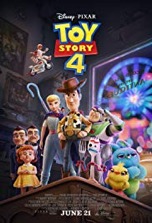
Starring: Tom Hanks
June 2019
Warning! This is NOT a movie review. This is a critique of the film. Intended to initiate a dialogue, the following analysis explores various aspects of the film and may contain spoilers. Views are my own and elaborate on comments that were originally tweeted in real time from the back row of a movie theater @BackRoweReviews. For concerns over objectionable content, please first refer to one of the many parental movie guide websites. Ratings are based on a four star system. Happy reading!
Toy Story 4 ends the long string of Disney/Pixar films that have opened with an adorable, often Academy Award-winning, animated short. Unfortunately, this sour note sets the tone even before the movie begins.
From the outset, TS4 feels like it’s desperately trying to recapture the magic of the earlier films in the series. It spends the first ten minutes recalling a rainy-night misadventure that took place nine years earlier, when Woody (Tom Hanks) was still Andy’s favorite toy. Eventually, the story brings us back to the present, when Bonnie (Madeleine McGraw) plays with Jessie (Joan Cusack), but leaves the stalwart sheriff in the closet.
In search of something to move the story along, the writers decide to take us to kindergarten orientation day. The only bright spot in Bonnie’s awkward, disappointing day is during crafts period when she cobbles together bits of trash to create Forky (Tony Hale). Serving as a type of security blanket, Forky becomes the center of Bonnie’s world, much to the dismay of the other toys, particularly increasingly irrelevant Woody.
When the story hits another lull, Bonnie’s family decides to take a road trip—one last hurrah before the school year begins. It isn’t until the family pulls over at a RV park to take a rest that some semblance of a plot finally coalesces. In rapid succession, Woody encounters an old friend and a new nemesis, and we’re off on another wild romp in the wonderful world of toys.
If that synopsis sounds paint-by-numbers, it’s because the movie’s plot is too. Though it’s sad to say, the franchise has finally experienced fatigue with this fourth film.
The story has some salience, though. Aside from showing the difficulties of a child adjusting to school (a major plot point of Inside Out), the movie has many themes including: you can’t grow by standing still, loyalty can be a crutch, friends sacrifice for each other, trash can have value and nothing is nobler for a toy than being there for a child and belonging to a child.
One element present in every Pixar film is nostalgia. Here, Woody can’t move on with his life because he’s tied to the past…the good ole days in Andy’s room. The antique store is a locus of nostalgia since it’s brimming with novelties and collectibles from bygone eras. Audience members of all ages may also experience nostalgia every time they see a Toy Story character or movie. In fact, many parents taking their kids to this movie were kids themselves back in 1995, when the first film was released.
Though most of the original characters are sidelined here—surprisingly, even Buzz Lightyear (Tim Allen)—several new characters add color and humor to the movie, including: Ducky (Keegan-Michael Key), Bunny (Jordan Peele), Gabby Gabby (Christina Hendricks), Giggle McDimples (Ally Maki) and Evel Knievel knockoff, Duke Caboom (Keanu Reeves).
In the final analysis, TS4 is a mild disappointment. Though arguably the nadir of the series, it’s still a charming tale of courage, loyalty and belonging that’s a cut above the typical animated feature. The movie boasts some frenetic and fun-filled action sequences and a handful of magical moments, like the ending scene at the carnival. Be sure to stay through the end credits to see a clever twist on the Pixar intro.
Rating: 3 out of 4
Green Book (PG-13)

Starring: Viggo Mortensen
November 2018
Warning! This is NOT a movie review. This is a critique of the film. Intended to initiate a dialogue, the following analysis explores various aspects of the film and may contain spoilers. Views are my own and elaborate on comments that were originally tweeted in real time from the back row of a movie theater @BackRoweReviews. For concerns over objectionable content, please first refer to one of the many parental movie guide websites. Ratings are based on a four star system. Happy reading!
Inspired by a true account, Green Book tells the story of an Italian driver (Viggo Mortensen) and a black piano player (Mahershala Ali), who embark on a concert tour to the Deep South in the 60s. Book is a poignant snapshot of the attitudes and mores of the period in focus. It’s also a road trip/buddy film that deals with racism in powerful, yet unexpected ways. The image of a white man driving around a black man makes many people stop and gawk; this role reversal stands out as one of the movie’s more ironic elements. Book has some magical moments, like: the chicken bone toss, lucky rock, confession in the rain and Christmas dinner scenes. The movie’s production is sensational, especially its period appropriate coifs, costumes and cars. Book also boasts tremendous acting from its two top-tier stars. Mortensen (virtually unidentifiable from his role as Aragorn in The Lord of the Rings films) and Ali (Moonlight) deliver extraordinary performances that should garner Oscar attention. Though Book is a tad idealistic, it contains a powerful central theme: namely, that reconciliation can win out over racism when people from different cultures choose to see things from the other’s perspective. Equal parts humorous and bittersweet, Book never sermonizes as it spotlights this less enlightened period of U.S. history. As a kicker, Book features one of the most heartwarming resolutions in recent film history.
Rating: 3 1/2 out of 4
Tag (R)
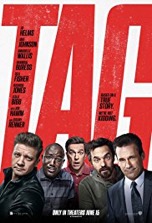
Starring: Jeremy Renner
June 2018
Warning! This is NOT a movie review. This is a critique of the film. Intended to initiate a dialogue, the following analysis explores various aspects of the film and may contain spoilers. Views are my own and elaborate on comments that were originally tweeted in real time from the back row of a movie theater @BackRoweReviews. For concerns over objectionable content, please first refer to one of the many parental movie guide websites. Ratings are based on a four star system. Happy reading!
Based on the true story (which was published in The Wall Street Journal) of how a group of grown men played a full-impact game of tag for 23 years, Tag is an unconventional comedy brought to us by virgin director, Jeff Tomsic. Each year during the month of May, five lifelong friends risk their careers, relationships, and life and limb to say “You’re it!” to a buddy...and then learn how that friend has been doing over the past year. The men use the game as a means of keeping in touch with each other, which is the only redeeming aspect of the game/movie. The story begins with Hogan “Hoagie” Malloy (Ed Helms) tagging Bob Callahan (Jon Hamm) during a business meeting. Hoagie tells Bob his plan for how to get the whole gang back together again for a special mission. The big news is that Jerry Pierce (Jeremy Renner) is getting married, which will make him a sitting duck. Jerry, who has the instincts and reflexes of James Bond (or, more appropriately, a Kingsman) has never been tagged; he always manages to dodge, trip or butt-punch the other players before making his escape through a prearranged egress. To ensure that her dream wedding won’t be disrupted by childish shenanigans, Jerry’s bride-to-be (Leslie Bibb) makes the other players sign a contract, which stipulates that they will suspend their competitive tagging until after the ceremony. But this doesn’t dissuade the players from attempting to find a loophole in the contract. Sound silly? It is. Tomsic stretches this thin premise so far you can read this review through it. After two hours of watching inane pranks and pratfalls, you’re ready to say, “Fine, just tag me already!” Aside from its Three Stooges style antics and potty humor, the movie seems to condone the destruction of property since multiple windows are broken, the roof of a car is smashed by a falling idiot (and, strangely, no alarm goes off on impact) and a golf cart is rammed into a tree. No apology is offered or restitution made for these blatant acts of vandalism. What a wonderful world to live in where there aren’t any consequences to such flagrant actions. No wonder these men have never grown up. The most reprehensible of these sequences is the free-for-all in the hospital, where injured and sick patients get caught in the middle of the rampant roughhousing. Wasn’t there a different, more appropriate, venue Tomsic could’ve chosen for the no-holds-barred finale? The sequence is disrespectful and models bad behavior for impressionable viewers…some of whom might end up being the next generation of taggers. Much of the dialog consists of inspirational quotes from dubious sources delivered with all the subtlety of a chair being thrown up against bulletproof glass. In the end, Tag is a mildly amusing buddy story that somehow manages to convey an important message—the value of friendship—amid a crass and silly story. Though not a top-tier comedy, Tag boasts a solid cast and offers a few good laughs. Will there be a Tag 2? We’ll have to wait and see how this film does first. Until then…you’re it!
Rating: 2 out of 4 stars
Ocean's 8 (PG-13)
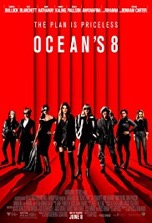
Starring: Sandra Bullock
June 2018
Warning! This is NOT a movie review. This is a critique of the film. Intended to initiate a dialogue, the following analysis explores various aspects of the film and may contain spoilers. Views are my own and elaborate on comments that were originally tweeted in real time from the back row of a movie theater @BackRoweReviews. For concerns over objectionable content, please first refer to one of the many parental movie guide websites. Ratings are based on a four star system. Happy reading!
Did you know that Ocean’s 8 is the fifth movie in the franchise? The original Ocean’s 11 (1960) starred the Rat Pack and centered on a casino heist in Vegas. George Clooney’s Ocean’s Eleven (2001) was similar to its progenitor but upped the ante by hitting multiple casinos at once. Ocean’s Twelve (2004) took place in Europe and was largely forgettable (other than the cameos by Bruce Willis and Topher Grace…as themselves). Ocean’s Thirteen (2007) was a return to form (Vegas casino heist) but proved to be one trip too many to the well. Confusingly, even though 8 is a sequel, its number would indicate that it’s a prequel. As with the new Ghostbusters (2016), 8 features an all-female cast. A female heist film? When women can pull off an elaborate crime just as well as men, it’s just another sign of our emasculated times. The movie opens with Debbie Ocean (Sandra Bullock), sister of the deceased Danny Ocean (Clooney), being released from prison. Debbie soon hooks up with gal pal Lou (Cate Blanchett) and they hatch a plan to steal the priceless Toussaint diamond necklace at NYC’s annual Met Gala. The rest of the team is comprised of a potpourri of top-tier performers including: Mindy Kaling, Sarah Paulson, Awkwafina, Rihanna and Helena Bonham Carter. Anne Hathaway plays a self-important actress who serves as the movie’s wild card. The only tether between this film and the Steven Soderbergh films is Elliott Gould, who reprises his role as Reuben Tishkoff in a brief cameo. Like a three-act play, 8 can be cut into thirds. After the initial excitement over watching Debbie do her thing (scheming and stealing), the movie takes forever to get going. The assembling of the team is flat and rote and the planning phase is belabored and overly methodical. The middle of the movie (the actual heist) is a high-stakes, fast-paced feat of cinematic chicanery—an enjoyable lark that singlehandedly redeems the movie. Most of the post-heist action is unnecessary and is tantamount to a bad magician explaining his trick…nothing is left up to the spectators to figure out on their own. This narrative inconsistency, between its three segments, is the movie’s biggest drawback. The directing by Gary Ross (The Hunger Games) is sure-handed but is surprisingly low energy at times. The cast is as dazzling as the MacGuffin necklace. In particular, Bullock and Blanchett have excellent screen chemistry. However, I never got the same sense of synergy among this cast that I did from the ensembles in the Soderbergh trilogy. In the end, 8 is a diverting film that has none of the panache, or humor, of the Clooney capers. The stellar cast suffers at the hands of a standard story that offers nominal thrills and twists and has a denouement that overstays its welcome. Still, future films seem to be in the cards. But what will the franchise do when it gets back to 11?
Rating: 2 ½ out of 4 stars
Deadpool 2 (R)
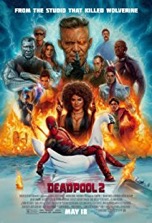
Starring: Ryan Reynolds
May 2018
Warning! This is NOT a movie review. This is a critique of the film. Intended to initiate a dialogue, the following analysis explores various aspects of the film and may contain spoilers. Views are my own and elaborate on comments that were originally tweeted in real time from the back row of a movie theater @BackRoweReviews. For concerns over objectionable content, please first refer to one of the many parental movie guide websites. Ratings are based on a four star system. Happy reading!
In Deadpool 2, the eponymous foul-mouthed superhero has returned to bring us a family film, or so he claims at the beginning of the movie. Don’t believe him. Even though writers Rhett Reese, Paul Wernick and some douche named Ryan Reynolds have toned down the violence and double entendres, the movie is still a bloody, crass, irreverent wad of inappropriateness. An early romance storyline quickly yields to a series of action sequences as the movie struggles to find its narrative footing. It isn’t until the Mystery Men (1999) style superhero tryout that the film begins to come into focus. The sequence is an absolute hoot, especially the heated exchange over whether or not luck should be considered a superpower. The debate is soon settled when Domino (Zazie Beetz) assists Deadpool in fending off some thugs…an amusing and unique action sequence which is basically Murphy’s Law in reverse. Josh Brolin, fresh off his stint as villain Thanos in Avengers: Infinity War, is the movie’s wild card and adds some much-needed heft and complexity to the film. Another pivotal character is Firefist (Julian Dennison), a young orphan who possesses powers he can’t control; which makes him equal parts innocent kid and unpredictable threat. In an obvious indictment against the Catholic Church, Firefist has been taken advantage of by the religious headmaster (Eddie Marsan) at a school for boys. Though you have to dig through the rubble to find it, this is the only real message in the film—i.e. the heinous sexual abuse of minors at many such institutions. Of course, there are plenty of humorous scenes in the film, like the fate of Wade’s new team on their first mission and when Wade grows back his legs after being ripped in half by Juggernaut. The action scenes, filmed with numerous Matrix-style slo-mo sequences, are well executed by director David Leitch. In particular, the sequence where Colossus (voiced by Stefan Kapicic) and Juggernaut slug it out reaches near epic proportions. The end credits scenes, where Wade uses a time machine to rectify the mistakes of the past (like when Reynolds first picked up the Green Lantern script) are the highlight of the film. Final analysis: D2 isn’t as crass or graphic as the first film, but isn’t as funny or clever either. Reynolds’ shtick is wearing pretty thin at this point (especially the VO narrations and frequent instances of breaking the fourth wall). The series needs to evolve; otherwise it might end up resembling its title. Not the pool part.
Rating: 2 ½ out of 4 stars
Incredibles 2 (PG)
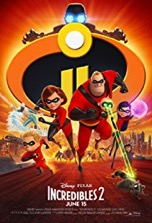
Starring: Craig T. Nelson
June 2018
Warning! This is NOT a movie review. This is a critique of the film. Intended to initiate a dialogue, the following analysis explores various aspects of the film and may contain spoilers. Views are my own and elaborate on comments that were originally tweeted in real time from the back row of a movie theater @BackRoweReviews. For concerns over objectionable content, please first refer to one of the many parental movie guide websites. Ratings are based on a four star system. Happy reading!
While waiting to watch Incredibles 2, I detected an insidious pattern in the previews. For The Lego Movie 2, Wyldstyle (Elizabeth Banks) admits that she almost singlehandedly saved the world in the first movie, but that Emmet (Chris Pratt) took all the credit. The next trailer was for Wreck-It Ralph 2. In a telling scene, Vanellope (Sarah Silverman) stumbles into a room full of Disney princesses who initially question her right to join them until they identify with her plight; people always assume that all of Vanellope’s problems will be solved as soon as a big, strong man shows up. When the feature presentation finally started, I thought for sure the anti-male bias was over—surely Pixar wouldn’t stoop to such shameless sexism, right? Wrong. It would appear that the sentiments behind the #MeToo and #TimesUp movements have now infiltrated kids’ movies…and that makes me mad. For a detailed diatribe of my stance against movies that seek to indoctrinate children with partisan political views, read my review of Happy Feet. Suffice it to say, unhealthy stereotypes of men are everywhere now, even in typically high-quality, high class Pixar pics. Case in point is Bob Parr/Mr. Incredible (Craig T. Nelson). If we thought Bob was emasculated at the beginning of first film as the deskbound, pencil pushing cube dweller, imagine how worthless he feels when his wife Helen Parr/Elastigirl (Holly Hunter) gets a crime fighting gig and he’s left at home to raise the kids Mr. Mom style. When Bob’s efforts to take care of his three kids go up in smoke (as a former accountant, he can’t even teach his son math because it’s “new math”), he reaches out to friend Frozone (Samuel L Jackson) for advice and prevails upon costume designer Edna (Brad Bird) to babysit Jack-Jack. Particularly disturbing is the cost analysis scene, which flags Mr. Incredible as an extreme insurance risk. The analytics reveal that Elastigirl (woman) completes her missions without bending a blade of grass, while Mr. Incredible (man) inflicts massive damage while attempting to defeat villains. Men are characterized as blundering buffoons who just can’t help but destroy everything in their path (much like Wreck-It Ralph or Hulk). So then, if Bob is a failure as a father and a superhero, what good is he? The last player in the NFL draft is referred to as Mr. Irrelevant. In I2, Bob Parr isn’t Mr. Incredible, he’s Mr. Irrelevant. Bob is the exemplar of the scores of men who’ve been sidelined and debased. Will it get to the point where men are nothing more than laborers and lovers in a matriarchal society, as was depicted in Gene Roddenberry’s Planet Earth (1974)? Time and societal evolution will tell, but as for now, we’re on the verge of the systematic censure, deconstruction and endangerment of the male of the species. Aside from gender roles, the movie also gets political when it deals with the integration of the Supers back into society; a topic that could relate to refugees from the Middle East, illegals pouring over the border from Mexico or even the way the LGBT community is being assimilated into the broader populace. The movie also makes thinly-veiled commentary about our growing screen obsession. Staring at one of villain Screenslaver’s hypnotic patterns can override a person’s will and make them highly susceptible to committing evil acts. Walk into any public place and you’ll see people with their faces buried in screens, in essence hypnotized by onscreen content and completely oblivious to what’s going on around them. The parallel is obvious; the solution isn’t. It’s ironic that this problem was in its initial stages when The Incredibles was released in 2004. Despite its broad spectrum of commentary, the film does have some fun, although not nearly as much as the original. Even though the scenes with Jack-Jack are the highlight of the film, the tyke is given far too many superpowers and the various applications of those powers are way overplayed, usually to generate laughs. Syndrome (Jason Lee) is a far superior antagonist to Screenslaver, whose identity is obvious from the start. There are several new characters here including: salesman Winston Deavor (Bob Odenkirk), inventor Evelyn Deavor (Catherine Keener), Voyd (Sophia Bush), Krushauer (Phil LaMarr), Reflux (Paul Eiding), Rick Dicker (Jonathan Banks) and Ambassador (Isabella Rosellini). As with the first movie, Brad Bird wrote and directed I2. So is I2 worth the wait (14 years)? It pains me to say that I2 fails to capture the first film’s unbridled creativity and off-the-wall exhilaration…and fun. Though I2 is entertaining, it certainly isn’t incredible.
Rating: 2 ½ out of 4 stars
Show Dogs (PG)
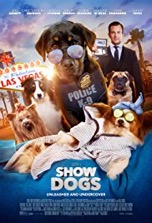
Starring: Will Arnett
May 2018
Warning! This is NOT a movie review. This is a critique of the film. Intended to initiate a dialogue, the following analysis explores various aspects of the film and may contain spoilers. Views are my own and elaborate on comments that were originally tweeted in real time from the back row of a movie theater @BackRoweReviews. For concerns over objectionable content, please first refer to one of the many parental movie guide websites. Ratings are based on a four star system. Happy reading!
The Premise:
In order to track down a gang of animal smugglers, a macho police dog must go undercover as a contestant in a prestigious dog show.
The Evaluation:
The movie opens in NYC, as police dog Max (voiced by rapper Ludacris) prepares to pounce on some animal thieves and rescue a caged panda. A FBI agent named Frank (Will Arnett), who is also working on the case, accidentally thwarts Max’ plan, which allows the criminals to escape. After the botched bust, Max and Frank get thrown together Turner & Hooch (1989) style and are tasked with tracking down the robbers and rescuing the panda. Turning rough-and-tumble Max into a well-groomed, well-mannered canine is just one of the many challenges this unlikely duo must face as they attempt to take a bite out of crime. If the plot sounds familiar, it is. Show Dogs is, at its core, a talking animal version of the Sandra Bullock vehicle, Miss Congeniality (2000). However, whereas Congeniality was a crowd-pleasing romp, Dogs is a witless dud…and that’s putting it mildly. Somewhere along the way, writers started working adult jokes into kids’ movies in order to hold the attention of the parents in the audience. Their justification for employing these guised gags is that they sail right over the heads of younger viewers. This deplorable strategy is a gross underestimation of the impressionable and increasingly savvy children in our society. The truth is, young people are assimilating these crude references whether they completely understand them or not. So here we have a litany of adult jokes shrouded in seemingly innocuous moments of levity. Though subtly delivered in most cases, the movie is filled with double entendres. The movie is also inundated with potty humor, suggestive dialog and even hints of bestiality (Frank engages in a ballroom dance with Max, who stands on his hind legs, and sleeps on the same bed with Max and a Papillon, who remarks that it’s “what nature intended.”) A whole section of the film deals with preparing Max for when the judge will inspect his private areas. As would be expected, this part of the movie generates many unnecessary comments, especially during the bikini wax sequence. And who decided to set this supposedly family film in Las Vegas? Is there a more family unfriendly location the writers could’ve chosen? One character observes that Vegas is marked by luxury and excess, which would seem to indicate how unsuitable it is as the location for a kids’ movie. As the main character, Max is a terrible role model. A fellow contestant sums up the Rottweiler perfectly by stating that Max is cynical, overbearing, can’t work in a team and doesn’t trust anyone. Max’ dialog consists of rude one-liners and inappropriate comments like: “You run like a wiener dog” and “Ah, grow some balls.” Hopefully these examples will serve as a deterrent for those considering this film for their next family night. Parents are strongly cautioned to steer their kids away from this movie and toward more wholesome entertainment. Don’t let anyone fool you…Dogs isn’t a family film.
The Breakdown:
Directing- The movie’s director, Raja Gosnell, is no stranger to the genre (or canines), having helmed Scooby-Doo, Scooby-Doo 2: Monsters Unleashed, and Beverly Hills Chihuahua. The style and lowbrow fare on display here is pretty much the same as in Gosnell’s earlier flicks.
Acting- Despite its pedestrian plot, the film has attracted an array of top-tier talent. In addition to human characters like Mattie (perfectly played by Natasha Lyonne from Orange is the New Black), the movie’s various talking animals are voiced by notables from a number of different entertainment segments, including: actors (Alan Cumming and Stanley Tucci), athletes (Shaquille O’Neal), singers (Jordin Sparks), comedians (Gabriel Iglesias) and reality TV show hosts (RuPaul).
Story- The screenplay, written by Max Botkin and Marc Hyman (not to be confused with wellness physician, Mark Hyman), is mind-numbingly inane, even by talking animal movie standards. The story is merely a loose assemblage of cheesy one-liners (“I knew I smelled bad attitude.”), hyperreal high jinks (like Max bending his way around a moving car Matrix style) and disgusting images (like the spinach, egg shells and whole raw fish smoothie) held together by a contrived plot. From one set of credits to the other, there’s no stoppage of dialog. These characters (mostly animal) just never shut up. Sadly, much of what they say is offensive and doesn’t have any substance whatsoever.
Costumes/Make-up- The NYC and Vegas costumes are appropriate to their settings. Thankfully, dancers and other Vegas performers are adequately clothed in most scenes. The animal costumes, which are difficult to tailor, are also well crafted.
Cinematography- One of the brighter spots in the film is David Mackie’s camera work. The action sequences are well filmed and the pageant scenes, though indebted to the brilliant competition scenes in Best in Show (2000), are enjoyable and lend the movie a measure of reality. Kudos to Mackie for his extensive work with the movie’s many animals, which are never easy to film.
Music- The movie doesn’t really have a score, at least not in the traditional sense—just a lot of up-tempo beats and rap music for the action sequences.
Visual FX- Mostly CGI of dogs talking, making faces and doing unrealistic feats. Nothing groundbreaking.
Production Values- For a supposed kids’ movie, the film has surprisingly high production values. The film makes good use of its locations and appears, in most respects, to be a major studio film even though it was produced by Global Road Entertainment.
Movie Magic- Unless you’re a 6-year-old, you’ll probably find this film unbearably silly.
Rating: 1 ½ out of 4 stars
Coco (PG)
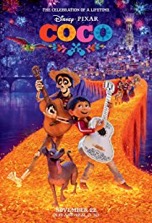
Starring: Anthony Gonzalez
November 2017
What follows is the full-length review based on comments that were originally tweeted in Real-time from the back row of a movie theater @BackRoweReviews. Though efforts were made to tease rather than ruin this movie’s memorable lines and moments, some spoilers may exist in the following evaluation. For concerns over objectionable content, please first refer to one of the many parental movie guide websites. Ratings are based on a four star system. Happy reading!
For their latest animated adventure, Disney/Pixar has selected main characters of a different kind. Instead of focusing on toys, cars, fish, robots or insects, they’ve returned to the world of people. However, not all of these people are alive. No, the animation studios haven’t gone all zombie on us (although, how cool would that be?). Focusing on the Mexican people and their Day of the Dead holiday (Nov. 1&2 annually), the studios have given us a glimpse of what life is like in the Land of the Dead. The story focuses on Miguel (Anthony Gonzalez), a young boy who wants to be an entertainer like his idol, Ernesto de la Cruz (Benjamin Bratt). Performing at the local talent show can help launch Miguel’s career, but first, he must borrow a guitar. But not just any guitar…the signature guitar that Ernesto played during his heyday, before the bell tolled and he met an early demise. Since he must ask for permission to play Ernesto’s guitar, Miguel embarks on a journey to the other side. Once Miguel has crossed the petal covered bridge that connects both worlds, he sets out to find Ernesto among the teeming masses of the macabre metropolis. As he navigates the Land of the Dead, Miguel encounters Hector (Gael Garcia Bernal), a lanky, fun-loving skeleton man who serves as both humorous sidekick and voice of reason for Miguel. Despite his seemingly silly persona, Hector holds a secret that literally busts open the story like a smashed piñata. Coco’s explosion of color rivals the visual vibrancy of the Finding films. Though certainly a marvel in its own right, Coco’s prismatic palette pales in comparison to its brilliant plot, which is chock-full of colorful characters and meaningful moments. This is the studios’ first attempt at spotlighting the customs and values of a minority culture. Director Lee Unkrich and his team of writers wisely avoided populating the story with clichéd characters and worn-out stereotypes. This is a deep dive into the hearts and minds of a people devoted to artistic expression, exuberant celebrations, fervent spirituality and, above all, the love of family. We’re treated to some traditional and modern Latin music including “Remember Me,” a top-tier, tear-jerker that should be a shoo-in for Oscar’s Best Song. Despite the fact that most of the movie works like magic, Coco has a fatal flaw—it borrows too heavily from other sources. The film mirrors Back to the Future in several key areas. Like Marty McFly (Michael J. Fox), Miguel wants to be a famous guitar player. Another point of comparison is that Marty and Miguel both travel through time (actually, the Land of the Dead probably exists outside of time, but close enough). Also, Marty and Miguel frequently reference family photos to learn clues about their family history and identity…and very existence. Ironically, the most obvious instance of plot theft in the story involves another Pixar movie. The trajectory of this film’s villain is so similar to that of Up’s Muntz, the only word that comes to mind is derivative, which I never thought I’d use to describe a Pixar movie. The film has problems with its premise too. For instance, is it really necessary to travel to the world beyond just to borrow a guitar? Admittedly, these are minor grievances in a movie that thoroughly entertains. The film subtly tempers its follow-your-dreams theme with a cautionary tale regarding the dangers of hero worship. Unkrich does a remarkable job of making morbid subject matter relatable and even, at times, humorous (e.g. the nude skeleton portrait scene). In the final analysis, Coco is rich in culture and character, sight and sound. It’s also a heartwarming tale of multigenerational connection between a young boy and his grandparents. Coco delivers an emotional wallop at the end, just to remain consistent with Pixar’s MO of leaving its audience in tears. But this time they’re tears of joy. Over a family reunion. Over fulfilled dreams. And over a young boy returning home…to the Land of the Living.
Cars 3 (G)
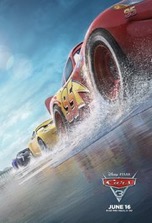
Starring: Owen Wilson
June 2017
What follows is the full-length review based on comments that were originally tweeted in Real-time from the back row of a movie theater @BackRoweReviews. Though efforts were made to tease rather than ruin this movie’s memorable lines and moments, some spoilers may exist in the following evaluation. For concerns over objectionable content, please first refer to one of the many parental movie guide websites. Ratings are based on a four star system. Happy reading!
The first Cars (2006) won over audiences with its charm, palpable nostalgia and pulse-pounding action. Cars appropriated the talking toys concept from Toy Story (1995) and built an entire world out of vehicles, including: semi trucks, helicopters, buttes that resemble vintage cars, tiny VW Bug flies and cow tractors (who could forget the “tractor tipping” scene?). The sequel, Cars 2 (2011), was an ambitious but ultimately disappointing effort that took the action overseas to Europe and featured a story that was overstuffed with the exploits of superspy Finn McMissile (Michael Caine) and an international scheme to rid the world of old or lemon cars—a subplot that was a little too on the bumper. Fortunately, the franchise is once again in pole position thanks to writer/director Brian Fee’s high octane and heartwarming story, which has returned the series to what made it such an enjoyable romp to begin with…meaningful themes couched in good old-fashioned fun. Lightning McQueen’s (Owen Wilson) career has come full circle: in the first film he was a self-centered rookie, but now the veteran racer is one loss away from forced retirement, which will doom him to pitching mud flaps for the rest of his rusty existence. When McQueen suffers a catastrophic accident, his future in the sport is placed in serious jeopardy. This tragedy recalls Doc Hudson’s (Paul Newman) similar career ending crash in the original Cars. How McQueen reacts to his situation will determine his fate: will he retire, as Doc did, or will he get back into shape and acquire the eye of the tiger? Yes, that was a Rocky reference. And yes, Cars 3 is replete with Rocky allusions, like the beach race between trainer and trainee as seen in Rocky III (1982). Also, there’s a conspicuous evocation of Rocky IV (1985) in the way upstart rookie Jackson Storm (Armie Hammer) uses the latest virtual technology to train while McQueen, under the tutelage of Doc’s former trainer Smokey (Chris Cooper), gets back to the basics by driving on dirt tracks and practicing “sneak through the window” agility tests, which require him to weave in and out of a herd of meandering cow tractors on a highway. Fortunately, this subplot is skillfully and judiciously woven into the narrative so as to avoid being a blatant rip-off of Rocky. Another carefully measured story element is McQueen’s yellow training car Cruz Ramirez (Cristela Alonzo). Even though Cruz, the only female lead (Bonnie Hunt’s Sally only appears when McQueen needs a pep talk or swift kick in the fender), isn’t introduced until about halfway through the film, she has the most compelling story arc. Insidiously, Pixar tricks us into thinking the movie’s main character is McQueen when it’s really Cruz. Did I say insidious? I meant ingenious. While most of the characters from the earlier films have bit parts here, there are a few new side characters worth mentioning, including: Nathan Fillion as duplicitous tycoon Sterling, Kerry Washington as overconfident sports commentator Natalie Certain and Lea DeLaria as terrifying, bull-like school bus Miss Fritter. Aside from all of its kid-friendly silliness, i.e., the demolition derby at the Thunder Hollow speedway, there’s also plenty here for adults, particularly for those who have entered middle age or have felt the sting of being replaced by a young, ambitious hotshot at work. On the bright side, this film is a beautiful example of how a torch passed from generation to generation (Smokey to Doc to McQueen to Cruz) can pave the way to a lasting legacy far more lustrous than a showcase full of Piston Cup trophies. It’s like the “circle of life” with cars and trucks instead of lions and warthogs. So where does the series go from here? Can one-note Mater (Larry the Cable Guy) and a doting McQueen sustain another movie? Is it time to turn things over to Cruz and a younger generation of race cars (which will inspire a whole new line of toy cars for kids to blow their allowance money on)? Regardless of whether it takes another lap or makes a permanent pit stop, the Cars series has been one wild ride.
La La Land (PG-13)
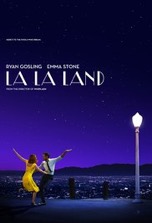
Starring: Ryan Gosling
December 2016
What follows is the full-length review based on comments that were originally tweeted in Real-time from the back row of a movie theater @BackRoweReviews. Though efforts were made to tease rather than ruin this movie’s memorable lines and moments, some spoilers may exist in the following evaluation. For concerns over objectionable content, please first refer to one of the many parental movie guide websites. Ratings are based on a four star system. Happy reading!
During the opening musical number in La La Land, appropriately staged on a L.A. freeway, I thought: “Dear God, what have I gotten myself into?” Based on that intro, I thought the remainder of the movie would be comprised of similarly elaborate musical numbers performed at regular intervals throughout the film. Much to my relief, I was wrong. The movie quickly transforms into an engaging romance/drama with only the occasional song and dance number interspersed throughout the narrative. What ensues is a follow-your-dreams tale where Sebastian (Ryan Gosling), a struggling piano player, wants to open his own jazz club and Mia (Emma Stone), a frustrated barista, wants to become a famous actress. Writer/director Damien Chazelle cannily delays the romance between Sebastian and Mia by arranging a series of anti-meet cutes, which should be a sign to the couple that their love affair is destined to be ill-fated. Casablanca (1942) is referenced a few times in the film and holds obvious significance for the star-crossed couple, particularly in how both films end. LLL seeks to tap into the brilliance of such masterpieces as Casablanca for its dramatic passages and Singin’ in the Rain (1952) for its musical routines. The film is brimming with classical Hollywood nods like the old film posters that adorn the walls of Mia’s bedroom and the Sebastian and Mia’s screening of Rebel Without a Cause (1955) at the Rialto Theater. As such, LLL is a reimagining of the Hollywood musical, a largely retired genre. Ironically, relying so heavily on Golden Age Hollywood themes and iconography has proven to be a double-edged sword for the film. On the one hand, the heavy quotation of vintage films has established the film’s look, mood and atmosphere as well as produced feelings of nostalgia in viewers enamored with such films. On the flip side, it could be argued that the film relies too heavily on early Hollywood tropes and that such an effort was done intentionally, to play on viewer’s emotions and to pander to those in the industry, particularly Academy members. Either way, LLL fails to achieve its goal since it doesn’t adhere to classical modes of storytelling. Indeed, the movie is a mélange of genres (comedy/drama/musical/romance) and is, perhaps, too ambitious for attempting to combine so many disparate story elements. One of those aspects is the jazz appreciation subplot. Whereas keeping the arts alive is an important endeavor, the obvious validation of jazz as an essential, vibrant art form is foisted on the audience and such advocacy is just one more objective the film tries to accomplish. Though many of the film’s romance scenes feel trite, Chazelle’s concluding “the life that would have been” parallel action device is brilliantly executed and infuses the film with an unexpectedly bittersweet resolution. In the end, LLL’s story is the only thing that holds it back from becoming an instant classic. The film’s directing, acting, production values, locations, cinematography and music (especially Justin Hurwitz’ “City of Stars,” which has a wistful “Moon River” quality) are all off the charts. Gosling and Stone’s (in their third movie collaboration) screen chemistry is so searing it nearly makes the film melt, something that actually happens during Sebastian and Mia’s screening of Rebel. There’s far more that works here than doesn’t, and at the end of the day, the film’s unique vision has broadened the appeal and potential for the modern musical. LLL seems to be a strong contender to win Best Picture. It just depends on what Academy voters are in the mood for this year: depressing drama (Hell or High Water, Manchester by the Sea, Moonlight), historical biopic (Hacksaw Ridge, Hidden Figures), inspiring true story (Lion), space invasion flick (Arrival), converted stage drama (Fences), or this film. We’ll find out soon enough.
Central Intelligence (PG-13)
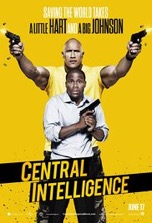
Starring: Dwayne Johnson
June 2016
The below comments (in Black) were originally tweeted in Real-time from the back row of a movie theater and appear @BackRoweReviews. Though efforts were made to tease rather than ruin this movie’s memorable lines and moments, some spoilers may exist in the following evaluation (in Red). For concerns over objectionable content, please first refer to one of the many parental movie guide websites. All ratings are based on a four star system. Happy reading!

The #GoldenJet gets upstaged by a whale.
#JunkMail Bigger is better, right?
“Black people don’t go to therapy.” Ha!
“You gained it back in muscle.” Lol
The #GoldenJet flip. #EpicFail
Nice use of printer toner in the shootout.
“You hit us!” The therapy session is hilarious. #SoulGaze
“Once a fat kid always a fat kid.” Punch him, Bob.
“The universe provides.” #GoldenJet
#SnakeGyllenhaal Ha!
“I’m the Black Badger.” Similar to “I’m Spartacus.” #Spartacus
“Bob just went commando.” Hilarious! #MicDrop
Final analysis: a humorous, though farcical, buddy movie with a positive anti-bully message.
Rating: 2 out of 4. Fans of the two stars won’t be disappointed by this oft silly story, but others...
So the latest in the long string of buddy movies is Central Intelligence, which features action star Dwayne “The Rock” Johnson and comedian Kevin Hart. Though the two become unlikely friends in high school (which we see in a prologue section), the action picks up twenty years later when “Most Likely to Succeed” Calvin Joyner (Hart) hasn’t succeeded and overweight, bully magnet Bob Stone (Johnson) is now an uber-buff CIA agent. Just go with it. Fittingly, the catalyst for the two former classmates being reunited is the occasion of their twenty year high school reunion. The plot kicks into high gear when Stone glad hands accountant Joyner into interpreting a list of offshore bank accounts in order to determine the purchaser of some secret satellite codes that, in the wrong hands, could spell doom for our planet. Clear as mud, right? Of course, most people coming to see this film aren’t expecting an Academy Award caliber screenplay; just Johnson’s patented “pec pop” (you’ll have to wait to the end credits for this) and Hart’s high-pitched, rapid-fire one-liners. Though many of the movie’s storylines and characterizations are utterly daft, there are some redeeming themes here, like: the power of friendship, the reprehensible nature of bullying and the importance of getting therapy (not the Barbershop variety). The anti-bully message has a great deal of relevance since bullying is rampant in our society, especially online and in our nation’s schools. The fact that many bullies remain unrepentant even into adulthood, as Jason Bateman’s obnoxious character illustrates, is despicable and sad. Another meaningful moment is when Stone purposely stalls the plane, forcing a bucket list confession from Joyner. It’s a decidedly ridiculous scene but it does reveal how facing our own mortality brings into sharp focus the things that matter most in life. Though I could’ve done without Stone dancing naked at the reunion, I realize that such scenes were a main draw for admirers of Johnson’s physique. The action scenes, though well choreographed, are occasionally ridiculous, like when Stone and Joyner jump out of a tall building and land on a gigantic inflatable ape…yeah right. Though addled with dunderheaded beats, the story maintains interest throughout and keeps us guessing where Stone’s loyalties lie right up until the very end. Despite the fact that this movie is a mediocre affair and an obvious rip-off of Rush Hour (1998), a sequel seems all but assured. Let’s just hope the next film has a more compelling story…this Intelligence doesn’t live up to its name.
Finding Dory (PG)
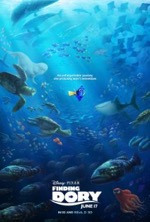
Starring: Ellen DeGeneres
June 2016
The below comments (in Black) were originally tweeted in Real-time from the back row of a movie theater and appear @BackRoweReviews. Though efforts were made to tease rather than ruin this movie’s memorable lines and moments, some spoilers may exist in the following evaluation (in Red). For concerns over objectionable content, please first refer to one of the many parental movie guide websites. All ratings are based on a four star system. Happy reading!

The animated short #Piper is equal parts cute and brilliant.
“I suffer from short term memory loss.” Admitting it is the first step.
“What if I forget you?” One minute in and I’m already tearing up.
Is that #VWBug on the ocean floor #Herbie?
#StingrayMigration Gorgeous animation. #Pixar
“Go for distance.” Hilarious!
“I’m okay with crazy.” Dory’s been there and back a few times.
“No memories no problems.” But no meaning either.
“What would Dory do?” #WWDD
“Follow the shells.” An underwater version of Follow the Yellow Brick Road.
“Your orange friends are on their way to Cleveland.” They must be #Browns.
All shells lead to home.
“You remembered.” Heartwarming scene.
“There are no walls in the ocean.” #FreeWilly moment.
“The best things happen by chance.” Dory’s guiding philosophy.
“Unforgettable.” Just like the movie.
Final analysis: just as enjoyable as the first film but for completely different reasons.
Rating: 3 out of 4. Though not as mesmerizing as the #FindingNemo, #Dory has even more heart. Superb sequel.
During the twenty-one years since Pixar released its first animated feature, Toy Story (1995), the animation studio has cranked out one hit after the next in an unparalleled feat of commercial and creative dominance. The studio’s highest grossing film (adjusted for inflation) is Finding Nemo (2003); the film was directed by Andrew Stanton and featured the voice talents of Albert Brooks and Ellen DeGeneres. That formidable team has reunited in the sequel, Finding Dory, which has been thirteen years in the making. So let’s address the nagging question in everyone’s mind: is Dory as good as Nemo? Short answer…no. In some ways such a comparison is unfair since one of the main objectives in producing the first film was to prove that underwater (the most difficult of all environments to animate) sequences could be done, and done well, with CGI. The vibrant colors, virtual encyclopedia of fish species and gorgeous photo-realistic underwater environments made for an immersive viewing experience nearly unparalleled in cinema history (Nemo stands as the finest 3D film that isn’t). Whereas, the animation in Dory is still exceptional, the palette isn’t nearly as expansive, nor does it need to be since it’s a more intimate lost-and-found tale. So where did Dory go wrong? Unfortunately, it took a page out of parent company Disney’s book and followed the formula established in last year’s Star Wars: Episode VII—The Force Awakens, a virtual rewrite of Star Wars (1977), with a dash of Empire (1980) and Jedi (1983) thrown in for good measure. Likewise, Dory is a virtual reworking of Nemo, but in reverse: clown fish Marlin (Brooks) and son Nemo (Hayden Rolence) are searching for missing Dory (DeGeneres) who, in turn, is searching for her parents Charlie (Eugene Levy) and Jenny (Diane Keaton). Many characters from Nemo appear here, like manta ray school teacher Mr. Ray (Bob Peterson) and laid back turtle Crush (Stanton), and show up in sequences that are so similar to the ones in the original film they may cause feelings of déjà vu. This sameness is this film’s Achilles’ heel and recalls the foisted, perfunctory Radiator Springs scenes in Cars 2 (2011), which, despite offering ample contextualization and that warm fuzzy feeling of nostalgia, ultimately created boredom from familiarity. Fortunately, most of Dory’s story redundancies take place early in the film. Some of the passages near the middle of the movie, like Marlin and Nemo’s various pratfalls as they make their way through the Marine Life Institute in search of Dory, are a tad pedestrian—even by animated movie standards—and just feel like filler until the movie’s two major reunions take place. But all is not lost as there are many things that recommend this film as a worthy follow-up to Nemo. Many of the new characters are welcome additions to the aquatic menagerie, particularly: Hank the curmudgeonly octopus (Ed O’Neill), Destiny the myopic whale shark (Kaitlin Olson), Bailey the concussed beluga whale (Ty Burrell) and Fluke the territorial sea lion (Idris Elba). The action-packed climax, where Dory and friends must rescue Marlin and Nemo from a Cleveland-bound semi truck is uproariously funny and recalls the frenetic action in the similarly-themed airport rescue at the end of Toy Story 2 (1999). Of course, as has become standard in Pixar movies, Dory contains plenty of hard-hitting emotional scenes, which, like the opening moments of Up (2009), will have grown men (like this one) tearing up all over the theater. Indeed, has there ever been a more pathos-inducing animated character than a tiny fish with short-term memory problems alone and lost in a gigantic ocean? The scene where tiny Dory, with her cute, quavering little voice, frets over forgetting her parents is absolutely heart-rending. The implications of this scene won’t be lost on parents of special needs children or on adults grappling with memory loss in their aging parents. However, there’s an even broader message here about the nature of memories and how vital they are in shaping our identity and reality. Deep subject matter for an animated film, but this is just proof positive that Pixar films are really made for adults, with just enough action and humor to keep the kiddies interested. In the final analysis, Nemo may be the finer film, but Dory has more heart. The sequel is truly A-Dory-ble! Here’s a thought to ponder: if the next film in the series takes another thirteen years to produce, the storyline may feature Nemo and Dory searching for Nemo’s dementia-stricken father in Finding Marlin. Poor taste since I’m writing this review on Father’s Day?
The Intern (PG-13)
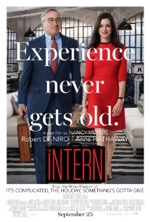
Starring: Robert De Niro
September 2015
This review was originally tweeted in Real-time from the back row of a movie theater and appears @BackRoweReviews. Though efforts were made to tease rather than ruin this movie’s memorable lines and moments, some spoilers may exist in the following evaluation. The original tweets appear in black, while follow-up comments appear in red. For concerns over objectionable content, please first refer to one of the many parental movie guide websites. All ratings are based on a four star system. Happy reading!

“A hole in my life.” Many people, young and old, have this.
Although this search for significance is universal, it’s probably more pronounced for those facing old age alone.
“I still have music in me.” Heartfelt video audition. Inspiring.
A way for friends to shop together online. Dangerous.
Just imagine friends making recommendations for each other or people pressure buying what their friends bought. Frightening. Especially with the Confessions of a Shopaholic (2009) set.
“What was your major...do you remember?” Ha!
What a backhanded, ageist, comment.
Gray is the new green.
I thought orange is the new black. I’m so confused.
The blinking scene is hilarious.
Hathaway’s character is weirded out by people who don’t blink. But what about those who blink too much?
“Sitting is the new smoking.”
Not quite as bad for you, but a point well made for those cube dwellers that’ve been forced into a sedentary lifestyle.
When did “too observant” become a bad thing?
Many people are content to believe lies about themselves and are resistant when someone comes along and tells them the truth.
The Facebook and pizza scene is special.
This is the kind of well crafted character scene that sets Meyers apart from other filmmakers in the drama/comedy hybrid genre.
The “fake alarm” scene is hilarious.
First date at a funeral. Classy.
Flipping the bird at a funeral? Classless.
Pocket squares...a secret weapon with women.
DeNiro’s explanation for how pocket squares were made with women, not men, in mind is ennobling and chivalrous…something has clearly been lost over the generations. Hathaway’s character, Jules, points this out in the bar scene when she contrasts Jack Nicholson and Harrison Ford with the three twenty-something schlubs standing in front of her.
Intern/best friend. Touching scene.
Final analysis: a touching, topical film that strikes all the right chords emotionally.
As we’ve come to expect from Meyers’ films.
De Niro and Hathaway are terrific together and director Nancy Meyers has delivered another cinematic gem.
Rating: 3 out of 4 stars. A crowd-pleasing dramedy that should appeal to the young and old alike.
Nancy Meyers has done it again! Not only has she delivered another delightful and diligent character study, she’s also given us a film that, like many of her past films, has tapped into the zeitgeist in powerful yet nearly imperceptible ways. In The Holiday (2006), Kate Winslet and Cameron Diaz—both of whom have just broken up with their loser boyfriends and just need to get away—conduct an intercontinental house swap for the Holidays. Though themes of old relationships, new adventures, accidental boob grazes (okay, you got me…it isn’t a theme, but it is an extremely funny scene) and overcoming emotional numbness all factor into the film, it’s the keen comparisons between old and new Hollywood by Eli Wallach’s character that serve as the heart and soul of the film. It’s Complicated (2009) shows the effects that a middle aged divorce has on the grownup kids in the family…and how adults can carry on like kids in the midst of a confusing love triangle. The Intern (not to be confused with Vince Vaughn and Owen Wilson’s The Internship from 2013) is Meyers’ canniest film to date. The director addresses the generation gap, career reversal (woman CEO married to Mr. Mom, who, in his state of emasculation, steps out on his wife) and the need for structure and purpose in our lives in such an organic, unassuming way that most people will miss the surfeit of social relevance dispensed here. The film incisively depicts the plight of young people desperately trying to make their mark in a down economy and how anyone over forty is considered ancient by the youth focused job force and may find it difficult to secure employment. Whereas the twenty-somethings may be doggedly focused on making their first million by thirty, some retirement aged folks, like Ben (Robert De Niro), would be happy just to have a job to help them pass the time of day. The film underscores another disconnect in today’s business world…the people with little to no experience (not knowledge, degrees or advancement due to nepotism) are making all of the decisions while individuals with decades of on-the-job training and wisdom are being relegated to the sidelines or, worse still, coffee runs for entitled bosses with superior social media and/or computer skills but who have no people skills or business acumen whatsoever (if you detect a hint of animosity it’s because I, like far too many other highly qualified individuals in our country right now, am living Ben’s reality every day). Only when both sides of this generational struggle learn how to work together, as Jules (Anne Hathaway) and Ben do in this film, can true progress be made in our nation’s business sector. The infidelity subplot has been done a trillion times before, and the one here really isn’t all that noteworthy other than the way it adds tension to the story. What is worth mentioning is the film’s underlying theme of the basic human need for purpose. For Jules it’s her job, which everything in her life is conspiring to take away from her. For Ben, it’s having structure and socialization in his life as a retired widower. The message is clear: whether just starting out in the work force or winding down after a long career, we all need some type of vocation to fill our days and give us a sense of accomplishment. The final scene also gives us a hint about how to find fulfillment and satisfaction in life...sometimes we just need to take a day off to actually enjoy the life we work so hard to maintain. Other than its clever characterizations, stellar performances, sure-handed direction, socially salient plot points and crowd-pleasing story, The Intern is just like every other dramedy out there.
Learning to Drive (R)

Starring: Patricia Clarkson
August 2015
This review was originally tweeted in Real-time from the back row of a movie theater and appears @BackRoweReviews. Though efforts were made to tease rather than ruin this movie’s memorable lines and moments, some spoilers may exist in the following evaluation. The original tweets appear in black, while follow-up comments appear in red. For concerns over objectionable content, please first refer to one of the many parental movie guide websites. All ratings are based on a four star system. Happy reading!

Or as Kingsley’s Darwan says, “Seatbelt first.”
“Driving is a freedom.” One that can be revoked for idiots.
Many people need to be reminded that driving is a privilege not a right and that a license can be revoked at any time. There, I’ve made my point. Idiots!
The #TaxicabConfessions style opener is heartbreaking.
And an accurate portrayal of what cabbies must deal with as part of their job. No thanks.
“The third itch.” Male menopause. #Manopause
Every seven years. Kinda’ like Vulcans and Pon Farr.
“Teach yourself to see everything.” No easy task.
Especially for people who suffer from ADD/ADHD.
A #SkankMachine. Amusing.
And just like the tantalizing treats in a vending machine, flings only meet an immediate need and are nothing more than empty calories for the soul.
“It’s like asking me to move out of me.” Sad.
A spiteful spouse will use anything they can to inflict emotional pain during a divorce.
“I think it’s time to discuss road rage.” Ha!
Kingsley is masterful in his portrayal of an Indian man. Of course, he’s had plenty of practice. Gandhi (1982).
“Rear entry.” Check!
Not even gonna’ touch this one. Ew!
Peligro. Right motive, wrong language.
How terrifying would it be to live in a country where you didn’t know the language, customs, etc.?
“Goodbye Wendy.” Illegal hands to the face.
A really telling scene. Clearly Darwan has feelings for Wendy, but those feelings will have to remain unexplored due to his circumstances.
“You’re my faith.” Touching moment.
Whereas it’s inadvisable to put your faith in a person, I understand and agree with Wendy’s sentiment here. An extremely bittersweet resolution.
Final analysis: a feel good drama about finding the courage to overcome the painful transitions in life.
Rating: 3 out of 4. Superb central performances & a heartwarming story make this a crowd-pleasing winner.
Let’s face it…there isn’t anything earth-shattering about this movie. The family drama meets collision-of-cultures premise has been done many times before in movie history. Elevating such a project above the morass of similarly themed films requires, among other things, stellar lead performances. This movie certainly delivers on that front with superb turns by Patricia Clarkson and Ben Kingsley, two actors you wouldn’t naturally match up as a possible love interest, but who are marvelous together here. It’s not just the A-list actors who deserve credit, though: Grace Gummer (The Newsroom), Jake Weber (Hell on Wheels) and Sarita Choudhury (Homeland) also shine in their supporting roles. A solid assist also comes from the many NYC locations, which visually festoon the film while grounding the story in a strong sense of place. Another plus here is the judicious placement of cultural (Indian) insights into the story line, which provide diversity and authenticity to the proceedings. However, what really sets this film apart from others of its ilk is its unique riffs on dramedy tropes. The first expectation shattered here, and the trailer was more than a little disingenuous on this count, is that this is a romance film. As the plot unfolds, it becomes evident that Wendy (Clarkson) and Darwan (Kingsley), who meet via a chance encounter and develop an unlikely friendship, have feelings for each other. Those feelings, however, remain unrequited due to timing and propriety: Clarkson is in the throes of a divorce while Kingsley is just jumping (literally, since he ties the knot one day after meeting his bride) into a marriage—arranged, of course, as per cultural dictates. The wistful yearning the characters have for each other is palpable and the chemistry between them is undeniable. The fact that this slice-of-life story doesn’t degenerate into romantic drivel is really what recommends it the most. Another story element that eschews the typical cutesy or lazy storytelling often found in this brand of light drama is when Clarkson’s daughter, Tasha (played by Meryl Streep’s daughter, Gummer), asks if she can live at home with mom after experiencing a painful breakup with her boyfriend at college. Recently separated Wendy is in need of companionship, so this plan seems like a natural, mutual resolution to the felt-needs of both mother and daughter. However, Clarkson turns down her daughter’s request and affirms that returning to college, where Tasha will soon develop new friendships and romantic interests, is really the best thing for her. It’s a great moment that flies in the face of convention and is 100% schmaltz free. The final narrative changeup is when Wendy says her faith rests in Darwan, which precludes any kind of relationship with him since he’s married. Again, the writers don’t resort to pat or contrived solutions, so kudos to them for taking the narrative high road. While the sentimental set will surely grow frustrated by these less-than-ideal plot choices, those who prefer realistic stories with genuine emotions should thoroughly enjoy this honest, straightforward portrait of individuals who are attempting to embrace new beginnings while coping with life-altering challenges. Or to put it a different way, the movie is really just about learning how to suck it up and drive on.
Inside Out (PG)
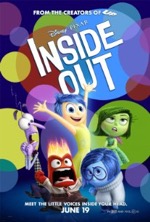
Starring: Amy Poehler
June 2015
This review was originally tweeted in Real-time from the back row of a movie theater and appears @BackRoweReviews. Though efforts were made to tease rather than ruin this movie’s memorable lines and moments, some spoilers may exist in the following evaluation. The original tweets appear in black, while follow-up comments appear in red. For concerns over objectionable content, please first refer to one of the many parental movie guide websites. All ratings are based on a four star system. Happy reading!

A high bar, to be sure, but this is certainly among the very best.
“I Lava You.” A sweet animated short. #Lava
At first I was dubious as to where this cartoon was going, because of the singsong nature of its narrative, but in the end this is a memorable, heartwarming short.
Joy meets Sadness. Don’t see them becoming friends.
Sometimes I’m just dead wrong.
“Family Island is amazing!” #CoreMemories
This concept is utterly fascinating and illustrates the importance of the major events and experiences in our lives and how they can shape who we are…positively and negatively.
“I’m starting to envy the dead mouse.” #NewDigs
It’s always difficult to start over in a new area, especially if it’s radically different from what you’re used to. The movie ably captures the feelings of uncertainty, loneliness and loss that can occur during these times of transition.
“Congratulations, San Francisco, you’ve ruined pizza!” #BroccoliTopping
A really funny scene, made even funnier by Anger’s brusqueness.
#MindManuals #LightReading
Train of Thought. Clever!
Even though it’s a little tongue-in-cheek, this is a fun concept.
“Can I say the curse word now?” Ha!
Ironic that anger is often the movie’s primary source of comic relief.
Dad’s #BrainOnHockey scene is frighteningly accurate.
And utterly hilarious! Zoning out while watching sports is an innate ability possessed by most men. Some men have even perfected it into an art.
“We’re deconstructing!” Brilliant visuals.
A very clever scene with some mind-blowing animation.
“There’s Déjà Vu. There’s Critical Thinking. There’s Déjà Vu.”
I think they just wanted to see if the audience was paying attention. Paying attention.
“Take her to the moon for me.” Bing Bong’s sacrifice is moving beyond words.
Grab the tissue box…this is a rough scene.
“For Riley!” Hilarious.
Sadness saves the day!
You just knew it would happen this way. A predictable, yet satisfying, ending all at the same time. Hooray for the underdogs!
What’s poo-berty?
Final analysis: an absolutely brilliant premise that’s executed to near perfection.
In fact, I honestly feel this is the most ingenious concept Pixar’s ever devised…and that’s really saying something.
Rating: 3 1/2 out of 4 stars. A thought-provoking, tender years tale that hits all of the right emotional notes.
Ever looked at someone and wondered, “What’s going through their mind right now?” The creative minds at Pixar Studios took that thought and turned it into an animated feature called Inside Out. The movie focuses on a young girl named Riley and her emotional and mental processes as she deals with a cross-country move from Minnesota to San Francisco. Instead of merely showing us Riley’s emotional struggles externally, director Pete Docter (Up) gives us a glimpse into the girl’s mind in order to observe, firsthand, the full spectrum of feelings she experiences. Riley’s individual emotions are personified by Joy, Sadness, Anger and others. Each of the emotions has a matching personality, i.e.: Joy is infectiously ebullient; Anger is violently explosive, etc. It’s been noted by some leading doctors and psychiatrists that the brain is the executive control center of the entire body. Pixar artists have cannily appropriated that factoid for their story by creating a central control panel inside Riley’s brain…the main operations center where the assorted emotions call the shots for Riley’s every thought, mood and behavior. But Riley isn’t merely an automaton, or a marionette whose strings are pulled by the tiny characters inside her brain. What’s really fascinating about the story is that Riley has volition apart from her own emotions, which is true-to-life since cogitations and cold hard logic can occasionally win out over emotions. The fact that Riley’s choices can override what’s going on inside her brain infuses the story with a great deal of anxiety and mystery since we, along with Riley’s emotions, often have no idea of what’s coming next. In these instances, Riley’s emotions must react to an unforeseen event, like when a life experience creates a core memory. The reverse also holds true as Riley is often deeply affected by her emotions and seems utterly powerless to regulate them. Some of the best twists in the movie occur when our young heroine is overcome by a particular emotion, like when Sadness does a number on Riley during her first day at the new school. This story device, where the action intercuts between Riley’s brain and what’s happening in the real world, generates tension throughout the film and effectively illustrates the disconnect between thoughts and feelings that we each must learn to reconcile. The world Pixar creates to represent the inside of Riley’s brain is truly astounding. The architecture of the mind is based on real science but is organized and visualized in a manner that reflects the thought process of an 11-year-old girl. The different sections of Riley’s personality, as well as the way memories are created, stored and discarded are brilliantly conceived and flawlessly executed. But not everything in the film is based on real world science. Some story elements, like the Train of Thought, are just there for fun. This film, which reveals a great deal about the human condition by examining the thoughts and feelings of an angst-ridden preteen girl, will go down as one of Pixar’s finest…which is no small claim when considering the studio’s back catalog of superlative animated films. Inside delivers an emotional wallop that’s rivaled only by the end of WALL-E (2008) and the beginning of Up (2009). The abounding movie magic contained within its narrative, along with its clever conceit, touching story and universal appeal, has insured that Inside will be enjoyed for generations to come. This 15th Pixar film has it all and is a shoo-in for Best Animated Feature and, perhaps, even for Oscar’s top prize. For a movie that’s all about the brain, Inside Out has a tremendous amount of heart.
Danny Collins (R)
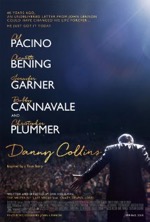
Starring: Al Pacino
April 2015
This review was originally tweeted in Real-time from the back row of a movie theater and appears @BackRoweReviews. Though efforts were made to tease rather than ruin this movie’s memorable lines and moments, some spoilers may exist in the following evaluation. The original tweets appear in black, while follow-up comments appear in red. For concerns over objectionable content, please first refer to one of the many parental movie guide websites. All ratings are based on a four star system. Happy reading!

Kinda based on a true story. Love the honesty.
Most “true story” films try to bamboozle us into thinking we’re watching an “actual account.” In many instances, what we’re really seeing is only the morsel of an authentic happening that’s been embellished into some egregiously sensationalized plot that bears little resemblance to the real event.
Opening concert: #MindiAbair on sax.
For those who’ve never seen Mindi in concert, you’re missing out…she’s an amazing performer. Mindi’s on a short list of female smooth jazz A-Listers (and when it comes to the saxophone, it’s her, Jessy J and Candy Dulfer).
Collins still has fans. “Three of them. Each one older than the last.”
Self-deprecating humor is one of Collins’ most endearing qualities, a trait that instantly wins over the audience.
“John Lennon wrote you a letter.” #BestBirthdayGiftEver
Unless it was delivered 30 years late.
“Busy Work” crawls out from under the bed. #Busted!
He definitely lives up to his name.
“Currently or in general?” Hilarious! #GoodPatter
This is the first scene with Pacino and Bening and the sparks start flying from the outset.
Danny’s attempts at matchmaking are humorous.
“You can’t buy redemption.”
You can’t buy love either. The Beatles made sure we knew that.
“I don’t know how I allowed it to go so long.” Touching scene.
At some point, it probably became easy just to put it off indefinitely.
#DinnerTease. Ha!
Bening sure knows how to play hard-to-get. Hats off to Warren Beatty.
Shattered picture frame, shattered relationships.
Symbolism? A definite possibility.
Danny loses his nerve and loses his dinner. #OneBadDecision
Good thing he doesn’t lose his lunch. That would just be too much.
“It’s a good thing when he calls you Tom.” Good father/son moment.
This is a genuinely moving scene and sets up a memorable final scene/shot.
Final analysis: a surprisingly moving washed up rocker tale with lots of heart and laughs.
Rating: 3 out of 4. Pacino is superb & has amazing chemistry with Bening. A heartwarming tale of redemption.
I have to admit, I was pleasantly surprised by this film. The trailer, which focuses mainly on the decades-old letter from Lennon, Collins’ life of excess and faux concert clips, didn’t do the movie justice. In some ways, this film reminds me of the similarly themed Music and Lyrics (2007). In that film, Hugh Grant plays a has-been 80s rock star holding on to the last vestiges of a music career by performing at smalltime clubs and state fairs. As the script would demand, Drew Barrymore enters his life and is a catalyst of change for Grant’s character, both personally and professionally. In this film, Collins befriends Bening who serves as confidant and muse to the derailed celebrity as he tries to put his life and career back on track. Fortunately, Collins doesn’t dedicate and play his new hit song for Bening during a live concert at movie’s end, as Grant does for Barrymore. This conscious effort to avoid schmaltz is one of the movie’s greatest assets, aside from its stellar performances. Pacino is predictably strong, and although this isn’t one of his finest performances, he’s thoroughly convincing not only in his portrayal of the larger-than-life singer, but also in his grungy, wrinkly and well-tanned appearance. Pacino is uber-charming in the film and plays the part of an old smoothie to the hilt. His screen chemistry with Bening is palpable and lends the film a fair amount of good-natured fun. The way Pacino infuses pathos into his character, in order to extract the optimal degree of sympathy from the audience, is absolutely brilliant. Indeed, we can’t help but cheer Collins on as he attempts to rectify past mistakes by inserting himself into the life of his adult son (Bobby Cannavale, in a pitch perfect performance)—whom he’s never met. The series of father/son vignettes, especially the movie’s final scene, serve to hoist the movie above the droves of middle-aged angst dramas that have graced the silver screen in recent years. Collins isn’t wildly original or overly inspirational, but it’s a highly effective, deeply affecting character piece that deftly sprinkles in some laughs and heartwarming moments amid the struggles of its title character; a fading celebrity, whose desperate attempts at remaining relevant and doing right by his family are strangely ennobling. All in all, Collins is a compelling slice-of-life tale and a friendly reminder that it’s never too late to make positive changes in our lives.
Home (PG)

Starring: Jim Parsons
March 2015
This review was originally tweeted in Real-time from the back row of a movie theater and appears @BackRoweReviews. Though efforts were made to tease rather than ruin this movie’s memorable lines and moments, some spoilers may exist in the following evaluation. The original tweets appear in black, while follow-up comments appear in red. For concerns over objectionable content, please first refer to one of the many parental movie guide websites. All ratings are based on a four star system. Happy reading!

The best species at running away. The Boov will move.
And their new home world looks a lot like Earth.
Welcome to Happy Humantown. A nice place if you’re into relocation.
For some reason the word “forced” was erased before I hit the Tweet button. I meant to say “forced relocation,” i.e., a human reservation.
Send vs Send All button. #BadDesign
Isn’t it nice to know that it’s not just us humans who hate this potentially catastrophic email option?
Antarctica...the only place on Earth with no Boovs.
Probably has something to do with their skimpy outfits.
Love the Slushious machine.
Nice mash-up of the words slushy and luscious.
“We are definitely not doomed.” Uh, yeah you are.
Politicians, who put on a brave face so as to not create a panic among the populace, often say the exact opposite of the truth. I guess exposing kids to this reality right off the bat is a wise move.
The party evite is humorous. #ThirdRockFromTheSun
The line in the movie is “third planet from the sun,” but it seemed appropriate to throw out a hashtag for John Lithgow’s TV comedy of an alien family conducting cultural observation on our planet. #SimilarTheme
Boov turns car into a slush-mobile. A thousand bubbles per pint.
For some reason this modified vehicle, though radically different in body style and technological capabilities, reminds me of the flying car concept in The Absent Minded Professor (1961).
“Every time you lie you turn green.” That’s what happens when you drink too much #BustaLime.
A Boov tell. Maybe we can win the planet back with a well played hand of poker.
Boov rhymes with groove.
And with all of those appendages, Oh proves to be a natural at cutting a rug.
Sad-mad. “Humans are more complicated than it said in the pamphlet.”
Don’t worry, Oh, we human males can’t figure out the females of our species either.
Nine mistakes and you’re out. Oh has made 62 mistakes. He’s the #JarJar of the Boov.
This character trait—error-prone—is a bit too telegraphed in the story and is a clear rip off of Star Wars’ JarJar Binks.
Oh cancels his evite just in the nick of time.
And with the crisis averted, the movie ends right here. Not quite.
“Curse you and your tippy toe tallness.”
Though not quite Yoda-esque, the Boov’s assimilation of English has some curious, linguistic aberrations.
Bubble car chase is a lot of fun.
This sequence is the visual zenith of the movie. It’s a frenetic, fun-filled chase scene that’s right up there with the best efforts of Lucas and Spielberg.
The only thing that can halt the Gorg advance is a #BurritoTorpedo.
I think I ordered that at Taco Bell once. Didn’t agree with me.
“He runs toward the danger?” Oh learned that from a humans person.
Must’ve been a soldier or fire fighter.
Captain Oh is given the Shusher. The Boov celebrate their new leader.
Now shush so I can think!
The mother/daughter reunion scene is special. Anyone have a tissue?
“You were scared? I almost made a Number Three!” Hilarious!
The funniest line in the movie, tentacles down.
The real identity of the Gorg is a nice twist. A riff on #StarTrek’s #Balok.
From the original Star Trek series’ episode “The Corbomite Maneuver,” for all you diehard Trekkers out there. Yes, I am part of the body. Additionally, the subplot involving the Gorg (similar in sound to Gorn, right?) being the last of its kind is similar to the creatures in “The Man Trap” and “The Devil in the Dark.” Also, the repository of Gorg offspring inside the rock is similar to the chamber of silicon nodules in “The Devil in the Dark.” Queen to queen’s level three?
“Every day is best day ever!”
Unless you’re having a bad day.
Final analysis: an alien invasion story with some good laughs and a heartwarming finale.
Rating: 2 1/2 out of 4 stars. Fairly pedestrian at times but rallies for a resolution that’s straight from the heart.
The alien invasion premise has been done ad nauseam in films (Invasion of the Body Snatchers, Alien Nation) and TV (V, Earth: Final Conflict) over the years and has become an unofficial sci-fi sub-genre. Unfortunately, the variation on the theme featured in Home isn’t groundbreaking in either its conception or execution. On the run from the dreaded Gorg, the Boov invade Earth and relocate the entire human population to a carnival style reservation area, and no one protests their captivity since they now have an amusement park existence—go with it, it’s a kid’s movie. A young girl, Gratuity “Tip” Tucci (Rihanna), hiding out inside Boov inhabited territory encounters Oh (Jim Parsons), a mistake prone purple skinned alien whose bad decisions and clumsy pratfalls drives the plot. Whereas the standard issue story is the film’s greatest detriment, the unlikely friendship that blooms between Oh and Tip is what makes the film fly. Also, the finale, though certainly not original, is a genuine tear-jerker that should leave most adults in the audience feeling satisfied with the end result; kids will probably love this movie no matter what, thanks to its explosion of colors, sleek technology and fast paced plot. That model—entertaining the kids while servicing the adults with meaningful storylines—was pioneered by Disney and perfected by Pixar. Indeed, for the better part of two decades now, Pixar has been the undisputed leader in producing animated films that succeed at captivating the young minds in the audience while simultaneously engaging adult viewers on a deep emotional level (reference WALL-E and Up). Up until the last few years, most animated films were only able to achieve the former, but now the other major animation houses have begun to adopt Pixar’s adult-centric formula…with great success. Home is certainly an exemplar of that strategy, especially during its surprisingly powerful resolution. In some key ways the ending here reminds me of the one in Disney’s Mars Needs Moms (2011), another animated film that stages a tearful reunion between mother and child during the movie’s climactic passage. In the end, Home isn’t Earth-shattering, but it is a heartwarming tale of courage, compassion and companionship. Above all, the film shows us, in stark contrast to Boov mores and mannerisms, what it really means to be human. They say that home is where the heart is. If true, it shouldn’t be too hard to find room in your heart for Home.
The Second Best Exotic Marigold Hotel (PG)
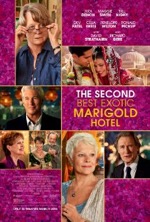
Starring: Judi Dench
March 2015
This review was originally tweeted in Real-time from the back row of a movie theater and appears @BackRoweReviews. Though efforts were made to tease rather than ruin this movie’s memorable lines and moments, some spoilers may exist in the following evaluation. The original tweets appear in black, while follow-up comments appear in red. For concerns over objectionable content, please first refer to one of the many parental movie guide websites. All ratings are based on a four star system. Happy reading!

#MaggieSmith most definitely isn’t getting her kicks on Route 66.
It’s abundantly clear that this scene was written only to generate a laugh. Since the meeting is in San Diego, why didn’t Patel and Smith just fly into the city’s airport rather than driving a convertible across the scorching hot desert?
“Get her some boiling water.” A humorous scene on the proper way to make a cup of tea.
“Why die here...when I can die there?” Quite a sales pitch.
Smith tells Patel to shut up and let her do all the talking during the meeting with David Strathairn. Patel exercises restraint for about 14.3 seconds.
Taxicab Confessions: India Edition.
Or, as the plot soon reveals, Strangers on a Taxi.
Sagai= Engagement Party. Let the drama begin.
“I went with low expectations and came back disappointed.” The eternal pessimist.
Maggie Smith’s line actually sounds like it could’ve been delivered by one of the two old coot critics in The Muppet Show.
“The fastest fox in the forest.” Or, the fastest talker in India.
“There’s just so much bloody potential” in life. And so many frustrating limitations.
Sometimes having too many options is worse than just choosing among a handful of opportunities. Having seemingly unlimited potential might also lead to a kind of ennui that prevents the person from getting anything done in life...the “Jack of All Trades, Master of None” syndrome.
#DevPatel asks his mom to take one for the team. Humorous.
Most women wouldn’t resist such an offer. I mean...we’re talking about Richard Gere here.
The wants and fears monologue is poignant.
One day after watching the movie I don’t really remember what was said here, but I’ll trust my earlier self that this was a great scene.
#DevPatel should’ve learned the choreography. He looks like a doofus on the dance floor.
Actually, that’s still better than what I could do in his place. #TwoLeftFeet.
“Shall we write the next chapter?” That’s when you know you’ve spun a good yarn.
“How much time do you have?” Way to go for the jugular.
A question you should never ask someone over 65.
Death by cow. Amusing.
Of course, there’s cultural relevance here since the train’s passengers would all be placed in harm’s way in order to save a cow…a sacred animal in Indian society.
I don’t do advice...I do opinions.
But if you offer your opinion on how something should be done, isn’t that kinda’ like offering advice, right?
The roots and wings wedding speech is touching.
Especially the script change portion at the end.
“There’s no present like the time.”
A nice play on words, but also a poignant nugget of wisdom. This phrase reminds me of Gandalf’s instruction to Frodo in The Lord of the Rings: The Fellowship of the Ring (2001): “All we have to decide is what to do with the time that is given to us.”
Final analysis: a natural extension of the first film with some new adventures and characters.
Although I miss Tom Wilkinson from the first film, the addition of Richard Gere, Tamsin Greig and David Strathairn were good casting choices that paid off huge dividends in the film.
Rating: 2 1/2 out of 4. A cultural and relational journey that was worth the return trip.
The Best Exotic Marigold Hotel (2011) was a crowd-pleasing, life affirming dramedy based on Deborah Moggach’s book of the same name. Most of the principal actors have returned in the sequel (Tom Wilkinson is out, while Richard Gere and David Strathairn are in), and the setting, tone and theme (i.e., making the most of the Golden Years) is fairly consistent with that of its predecessor. So why a sequel? Well, the first film was a modest hit, especially among the AARP set, so there was certainly financial justification for green lighting a sequel. Tapping the scintillating cast (which includes: Judi Dench, Maggie Smith, Bill Nighy, Penelope Wilton, etc) for one more go-round also must’ve seemed like a surefire way to win at the box office. Ultimately, having a built-in audience is the kind of safety net studios, like Fox Searchlight, are greatly desirous of, provided that the majority of that audience is still around to enjoy the sequel (after all, it’s been four years since the release of the first movie). Life imitates art in the follow-up film: just as the title has been established as a recognizable, bankable brand for the film franchise, it’s also inspired a franchise of hotels “stretching across India and beyond” in the world of the story. Sprinkling additional curry into the savory story are subplots involving: engagement/wedding parties (with plenty of Bollywood-style pomp and dancing), a surprise visit by a hotel inspector and a handful of percolating romances, all of which bloom into relationships by movie’s end…just in case we never get another chance to advance the story with this gracefully aging cast. What ailed the first film, i.e., shallow characterizations, uncomplicated plots and a heaping helping of sentimentality, also afflicts the sequel. Conversely, the elements that worked well in the original movie—gorgeous Indian locales, a dazzling cast, a positive, inspirational, meaningful story line—work like a charm here as well. The generation reconciliation between Patel and Smith’s characters, who are co-partners in the hotel franchising venture, is a clever way of keeping young and old viewers engaged throughout the movie. Also, when not preoccupied with sophomoric subplots, the movie effectively presents us with a sometimes humorous, sometimes profound look at what it means to grow old. The straightforward plot is the perfect compliment to the film’s feel good exuberance, and is the antithesis of the typical, dreary old age film like the uber-depressing Amour (2012). When all is said and done, this Second film is tons of fun and has a lot of dignity to go along with its levity. So, will there be a Third film in the series? And will Maggie Smith’s character return? Time will tell. But to be on the safe side, the studio should start production sooner rather than later. With a cast this seasoned, time is of the essence.
Kingsman: The Secret Service (R)

Starring: Colin Firth
February 2015
This review was originally tweeted in Real-time from the back row of a movie theater and appears @BackRoweReviews. Though efforts were made to tease rather than ruin this movie’s memorable lines and moments, some spoilers may exist in the following evaluation. The original tweets appear in black, while follow-up comments appear in red. For concerns over objectionable content, please first refer to one of the many parental movie guide websites. All ratings are based on a four star system. Happy reading!

Firth won the Academy Award for Best Actor for The King’s Speech (2010). What does that have to do with this film? Nothing, other than the fact that they both have “King” in the title.
A surprise cameo from a galaxy far, far away.
He’s an over-the-pond professor who did his doctoral thesis on “The Multiplicative Capabilities of Interconnected Moisture Vaporators.” It was released in book form by Tosche Press.
#SamuelLJackson with a lisp is a hoot.
I know it’s mean-spirited to laugh at a person with a lisp, but Jackson’s delivery makes it impossible to keep a straight face.
Holo-glasses...a nifty invention.
“Manners maketh the man.” Firth teaches some thugs a lesson. An exciting fight scene.
And more than a little unbelievable. But it’s also a lot of fun, which is all that matters, I suppose. Correction: “Manners maketh man.”
Amnesia darts would come in handy.
Sometimes a self-inflicted amnesia dart would be helpful.
“Like in My Fair Lady.” Hilarious!
This is the scene where I knew we had a runaway romp on our hands. Flawless comedic timing.
This elevator ride reminds me of the Haunted House ride at #Disneyland.
Without the silly vertical wall paintings.
The body bag initiation puts things into perspective.
There’s no name for the Chinese “thecret thervice.” I’m dying!
Easily one of the funniest scenes in the movie.
Choose a dog...but choose wisely.
At least he didn’t select a Chihuahua.
The skydiving scene is as pulse-pounding as they come.
This was an extremely well executed action sequence that makes you feel like you’re free-falling right along with the rest of the characters.
“Give me a far fetched theatrical plot any day.” Here, here.
Movies with overblown, hyper real action scenes and melodramatic villains have their own unique charm.
Jackson and Firth share a “happy” meal.
Wonder who got to keep the toy.
Fitting Room 3. Bond’s Q would be envious.
Actually, he’s probably the one who invented all of these weapons and devices.
The three J.B.s scene is amusing.
No, one of them isn’t James Brown. Or Josh Brolin. Or Justin Bieber. Gag!
Brutal, protracted fight scene in a Kentucky church.
In truth, it was too long and too bloody for my taste. And how many bullets does Firth’s gun carry anyway…50?
“This ain’t that kind of movie.” Clearly not, from what happens next.
Remember this line. It comes back around to bite Jackson in the ath.
Reconnecting the satellite link. I’m literally biting my fingernails.
OMG! The head exploding sequence is probably the funniest macabre scene I’ve ever seen.
Sometimes, when something strikes my funny bone just right, I just start laughing uncontrollably. This sequence had that effect on me; like I’d inhaled a deep lungful of laughing gas.
Final analysis: the best un-Bond movie ever, with incredible action scenes and humor to spare.
Rating: 3 out of 4 stars. I haven’t laughed this hard in the theater in quite some time.
I must admit that this film took me by surprise. I knew it was going to be an action packed spy flick (based on the comic book “The Secret Service”), but I had no idea it would have laugh-a-minute hilarity to go along with its thrill-a-minute intensity. Though belonging to an altogether different narrative universe, this film reminds me of last year’s Guardians of the Galaxy, which was a very effective mixture of humor and action. That formula works like magic here on a story that boasts a truly unique spin on the by-now hackneyed sub-genre of spy thriller. This might look like a spy movie spoof, but looks can be deceiving—like the dressing rooms inside a particular London tailor shop. This film is actually more like an alternate reality version of a MI6 mission—it’s what a Bond movie would look like if it were directed by Robert Rodriguez. As would be expected, Colin Firth, Michael Caine, Samuel L. Jackson and Mark Strong are all superb in their roles, but it’s really youngster, Taron Egerton, who steals the show as Firth’s protégée and Kingsman initiate, Eggsy (no, it’s not a typo). Egerton plays Eggsy with a chip on his shoulder, but also infuses him with just enough good-natured irreverence and boyish charm to make him appealing to the audience. Kudos goes to director Matthew Vaughn (X-Men: First Class) for prohibiting his action sequences (with the exception of the church debacle) from running away with the movie. The character development is fairly shallow here, and yet we’re still fully invested in what happens to them, which is somewhat of an anomaly for a contemporary action film. The real star of the movie is the screenplay, written by Vaughn and Jane Goldman. The dialog is razor sharp and witty beyond compare. The story skillfully pokes fun at the spy genre without outright lampooning it. It’s also a well crafted yarn that includes several gobsmacking plot twists. The only caveat here is that the film might be offensive to some viewers (e.g., the pervasive foul language, inappropriate sexual references and mass killings inside a church). The parenthetical items notwithstanding (and lest we forget, this is a Rated R film), this is the most hilarious thrill ride that’s graced the silver screen in quite some time. So has this movie done enough to garner a sequel…or a franchise? In a word, yeth.
Birdman (R)

Starring: Michael Keaton
November 2014
This review was originally tweeted in Real-time from the back row of a movie theater and appears @BackRoweReviews. Though efforts were made to tease rather than ruin this movie’s memorable lines and moments, some spoilers may exist in the following evaluation. The original tweets appear in black, while follow-up comments appear in red. For concerns over objectionable content, please first refer to one of the many parental movie guide websites. All ratings are based on a four star system. Happy reading!

Subtitle: The Unexpected Virtue of Ignorance.
Little did I know when I tweeted this phrase that it would appear as a headline later in the movie.
@MichaelKeaton levitating in his underwear is an unexpected first scene. Really sets the tone.
Don’t worry this isn’t the last time you’ll see Keaton in his underwear in the movie.
@ProstateWhispers. Hilarious!
Funny thing is, when I typed it in, some guy had already created that Twitter account. Life imitating art?
“I didn’t even know the man” scene is amusing and beautifully acted.
This is like an entire acting workshop in a five minute exchange. Superb choices by two exceptional actors.
@EdwardNorton brings the cupboard down, but not the house.
Not in the truest sense of the phrase, anyway. His actions do produce hysteria in the audience, but not for being genuinely funny.
“You’re not important. Get used to it.” #EmmaStone delivers one powerhouse monologue.
Stone’s monologue ends up being a direct address to the camera and the intensity in her gaze threatens to burn holes in the screen…and the audience by extension. One thing’s for sure, I’d never want to make her angry.
Truth or dare scene is fun...and revealing.
“I can pretend too.” Ha!
Another phenomenal exchange between Keaton and Norton.
The toilet paper philosophy scene is profound in an offbeat way.
And humorous when Keaton wipes out humanity by absentminded dabbing his face with the double ply square.
Sometimes you have to stop and smell the lilacs.
Or non-smell them in this case. But they still look nice, and it’s the thought that counts.
All that gauze and tape around his nose makes him look like his alter ego.
You can bet this visual symbolism wasn’t just a happy accident.
Final analysis: a meaningful, yet bizarre effort with a behind the scenes, A Prairie Home Companion vibe.
Rating: 3 out of 4 stars. An ambitious project with top tier performances and a one-of-a-kind story.
I doubt anyone who’s seen this film would disagree that it’s a true original. Whether or not it’s enjoyable is a matter of opinion. The story itself, which centers on middle-aged Riggan’s (Michael Keaton) attempt at recapturing some of the glories of his early acting career, should be universally understood and appreciated by most folks in the audience. However, the film runs the risk of loosing its audience over whimsical visual elements, i.e., Riggan levitating in his underwear or soaring above the NYC skyline as if he possesses the abilities of the fictitious, titular superhero. The blurred edges of fantasy and reality are painted with fine brushwork by director Alejandro G. Inarritu (Biutiful), but such intermittent departures from reality will undoubtedly prove inspiring for some spectators and irritating for others. There’s an enormous amount of art in the film, which should keep the die-hard cinephiles drooling: there’s also a very Broadway-centric narrative here, which should fill the theater set with elation. To whit, the majority of the movie is filmed inside the expansive area behind the stage, where labyrinthine hallways lend access to the prop, dressing and dining rooms where most of the drama takes place. The action randomly meanders between the various rooms, setting up juicy character vignettes in a similar manner to what Robert Altman achieved in A Prairie Home Companion (2006). Some of the film’s most meaningful moments include: Keaton’s heated exchanges with Emma Stone, his screen daughter; Stone and Edward Norton’s witty banter on the patio; Keaton and Norton as they vie for star status on the show and Keaton’s acerbic conversation with a jaded theater critic (Lindsay Duncan) in a bar. This last scene underscores the antagonistic relationship that often exists between actors and critics—it’s a clash of ideologies with vitriol to spare. Also worth mentioning is the film’s thinly veiled thesis on theater’s ostensible artistic preeminence over commercial films (and TV, etc). The inference here, and it’s been borne out many times by typecast actors, is that an actor who achieves commercial (cinematic) success early in his career might find it difficult to secure serious work in later years. There have been notable exceptions to this notion, like Robert Downey, Jr., who was an established thespian long before he was tapped to play Iron Man (at age 43). A fading public image has vexed many an actor over the decades, and Inarritu takes that mental angst to a fantastical extreme by showing us several glimpses of Riggan’s alter ego—the actual Birdman—who haunts and taunts the aging star’s private musings. Indeed, the often antagonistic or nihilistic voiceover thoughts, which struggle for supremacy over Riggan’s conscious cogitations, are an extremely effective take on the Jekyll/Hyde story device. These dark imaginings pose an intriguing question: Is this whole movie transpiring inside Riggan’s head? If so, is he actually an asylum inmate (as is supposed of Leonardo DiCaprio’s character at the end of Shutter Island) with the movie’s many flights of fancy simply representing the mental mechanizations of a certifiably insane individual? Besides the finely honed characterizations and stylish production, it’s really the multivalent nature of the psychologically complex plot that has ensconced this film in its own creative universe. The story is definitely open to interpretation, as is its appeal.
Big Hero 6 (PG)

Starring: Ryan Potter
November 2014
This review was originally tweeted in Real-time from the back row of a movie theater and appears @BackRoweReviews. Though efforts were made to tease rather than ruin this movie’s memorable lines and moments, some spoilers may exist in the following evaluation. The original tweets appear in black, while follow-up comments appear in red. For concerns over objectionable content, please first refer to one of the many parental movie guide websites. All ratings are based on a four star system. Happy reading!

#Feast is a truly moving animated short.
Just the latest evidence that Disney is rapidly approaching Pixar’s level of quality. Of course, executive producer John Lasseter, who oversees projects for both animation houses, has much to do with this parity.
David vs. Goliath style RC bot battle. Don’t judge a bot by its appearance, though.
Yeah, I wouldn’t dare pick a fight with R2.
“Welcome to the Nerd Lab.”
One suspects that this vibe is similar to the one you’d get in an animation studio, so these scenes are a bit self-reflexive.
Micro-bot exhibition is quite impressive. So long Lego bricks.
It’s amazing how innocent a new technology starts out…and just how quickly its altruistic vision can be perverted.
“Diagnosis: puberty.” Someone should pitch that to #abcfamily.
Fist bump scene is humorous.
This gag pays off dividends throughout the movie.
“There are no red lights in a car chase.” Ha!
This is a thinly veiled reference to Tom Hanks’ oft-quoted remark (“There’s no crying in baseball!”) in A League of Their Own (1992).
The inclusion of #StanLee in the family portrait is clever.
The first successful Marvel integration into a Disney movie. This Easter egg isn’t here by accident…but you’ll have to stick around through the end credits to learn its significance.
The flight scene is exhilarating but recalls similar ones in the #HowToTrainYourDragon movies.
Project Silent Sparrow looks an awful lot like #StargateSG1.
Besides the extra gate, the master shot looks like it was lifted right out of an episode of this long running sci-fi series.
Cool watercolor universe.
Or is it tie-dye? Or is it lava lamp? No I’m not tripping, but the animators sure were.
Nice title reveal in the last scene of the movie.
Final analysis: a high spirited, heartwarming tale of a cuddly robot, a young inventor and a group of nerds.
These nerds fulfill a vital role in the film as comic relief, especially Fred (T.J. Miller), and solid support for the hero.
Rating: 3 out of 4 stars. A sequel seems all but assured. Be sure to stay through the end credits.
Based on the comic book series (from Marvel, of course) of the same name created by Steven T. Seagle and Duncan Rouleau, BH6 tells a very human tale in the midst of a protracted struggle to control a powerful new technology. The movie sets up in a similar manner to Meet the Robinsons (2007), also a Disney animated effort, in the way a science fair/expo experiment is stolen and used to devastating effect by a misguided villain. The exploited technology in this case is millions of tiny microbots, which, when controlled by a person’s thoughts via a headband (similar to the Bowler Hat Guy’s high-tech headgear in Robinsons), can construct a myriad objects, shapes, weapons, etc. Though quite a bit larger, these microbots remind me of the insidiously relentless nanites in Star Trek: The Next Generation. The way the villain uses the microbots as a mobile dais is the kind of spine-tingling image you’d expect to see in a live action superhero film intended for a much older audience. Even though the movie’s main character is young tech geek Hiro (Ryan Potter), the focal point of the film is undeniably the rotund robot, Baymax (voiced with absolutely perfect inflections by 30 Rock’s Scott Adsit). The love child of the Michelin Man and EVE from WALL-E (2008), Baymax (this is one silly name…it sounds like Betamax, a technology that didn’t fare too well) is a lovable sidekick with a central processor of gold and a unique skill set…he provides portable medical services. Upon hearing that universal sound of distress, “Ouch!,” Baymax inflates, initiates its programming and launches into triage mode (this brand of activation reminds me of the way the holographic doctor appeared when summoned in Star Trek: Voyager, “Please state the nature of the medical emergency.”). Though Baymax’ skills and enhancements are impressive, as well as a whole lot of fun to watch in action, it’s his compassion and empathy that make his character so appealing. Hiro’s journey is an emotional one and Baymax’ ministrations (mostly psychological) are a salve for the young boy’s tragic loss early in the film. The loss of loved ones lies at the heart of the film and, ironically, provides motivation for the protagonist and antagonist. Even though the film deals with some fairly heavy issues, it is, after all, a Disney movie, and that means the story must have a happy ending. To whit, the hero comes to terms with his loss and the villain is redeemed, to an extent, and they all live... In the end, the story is moving and exhilarating, and you can bet that a sequel will soon be in the works. This is definitely a movie where you feel better walking out than when you walked into the theater. So now the only question that remains is, “Are you satisfied with your care?”
Hector and the Search for Happiness (R)
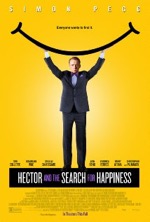
Starring: Simon Pegg
September 2014
This review was originally tweeted in Real-time from the back row of a movie theater and appears @BackRoweReviews. Though efforts were made to tease rather than ruin this movie’s memorable lines and moments, some spoilers may exist in the following evaluation. The original tweets appear in black, while follow-up comments appear in red. For concerns over objectionable content, please first refer to one of the many parental movie guide websites. All ratings are based on a four star system. Happy reading!

Dogs don’t fly, Simon.
Don’t worry...the dog wasn’t hurt in the process of filming.
Two movies with Rosamund Pike in as many days.
As you can tell from my previous blog entry, I had just seen Gone Girl the night before watching this film.
“Cut the rope, Tintin.” Pegg goes off on a patient.
The Tintin reference reveals Hector’s status as a grown-up boy (a psychic patient of Hector’s actually sees him as a boy), but also prefigures his globetrotting adventures later in the movie.
Bumped up to business class. Down or memory foam?
I was bumped up to first class once on a very long flight overseas. There’s really nothing like it.
The mirror image inkblot for #4 is humorous.
This definitely reveals the id of the male gender. It’s the classic “Why have one when you can have two?” mentality.
Hector looses the scent of happiness atop a serene mountain.
Other than the arctic air, I definitely think I could be happy there for a while…jaw-dropping vistas.
#8 is vital...answer your calling.
Fulfillment is all about finding purpose in life. Actually, the quote at the top of The Equalizer (see my review) ties in rather nicely with this sentiment.
Must admit, I’ve never been successful at implementing #13.
I derive fun from watching movies and very short list of other activities. I know…I need to make an appointment to see Hector stat.
“Listening is loving.” A powerful principle and an emotionally impactful scene.
The sequence on the plane is the heart of the film, and is also the answer to the perplexing question Hector has pursued throughout the movie.
“Mothering with an S.” Ha!
“Emotionally squeamish.” Ouch!
Those who know us best can hurt us the most.
Final analysis: a journey of personal discovery marked by humorous and meaningful moments.
Rating: 2 1/2 out of 4. Not the comedy portrayed in the trailer but a feel-good flick.
Bored with the sameness of life, Hector (Pegg) embarks on a globetrotting journey to find that most elusive of emotions…Ah-penis (easily the funniest scene in the movie). As a respected psychiatrist dating a fetching woman (Rosamund Pike), Hector really has it all…and yet, his life is devoid of the titular element. Those who don’t have an attractive partner or a high paying job may find it hard to sympathize with Hector’s ennui, while others in a similar stage/station of life will readily identify with his plight. In many respects, Hector follows the same general trajectory and itinerary that Julia Roberts’ character did in Eat Pray Love (2010). This movie also mirrors last year’s The Secret Life of Walter Mitty, which starred Ben Stiller. Mitty and Hector both feature characters mired in the doldrums of existence and in desperate need of relief from the daily routine. Both men are entering middle age, both keep fairly rigid schedules and both find fulfillment and inspiration only after leaving their familiar surroundings and embarking on a transcontinental adventure. In Mitty, the goal is to find a missing photograph, while this movie’s objective is the apprehension of happiness. The end result of both movies is that the central male characters discover who they really are by escaping from their lives for a short season. If that premise sounds somewhat familiar, and formulaic, it is. Unfortunately, this film adds insult to injury with its predictable plot (the narrative has little character complexity and is told in a straightforward manner) and contrived subplots (Hector does a favor for a tyrant, played by Jean Reno, which pays off dividends later in the film, and the utterly inane brain mapping storyline that even Christopher Plummer’s fine cameo can’t salvage). The biggest drawback here is that the movie was billed as a comedy and is sure to disappoint those jonesing for a light-hearted romp with resident funny-man Pegg. That’s not to say the film doesn’t try its hand at levity; the above double entendre stands out as a chief example. However, Hector, who we’re supposed to take seriously, is portrayed as a klutz, bumping into and breaking everything that isn’t nailed down in feats of physical comedy that would make The Three Stooges envious. After the third or fourth occurrence, however, these pratfalls just aren’t funny anymore. This film is amusing and heartwarming, but not necessarily exciting. In the end, Hector finds happiness in the film, but will the audience?
Magic in the Moonlight (PG-13)

Starring: Colin Firth
August 2014
This review was originally tweeted in Real-time from the back row of a movie theater and appears @BackRoweReviews. Though efforts were made to tease rather than ruin this movie’s memorable lines and moments, some spoilers may exist in the following evaluation. The original tweets appear in black, while follow-up comments appear in red. For concerns over objectionable content, please first refer to one of the many parental movie guide websites. All ratings are based on a four star system. Happy reading!

Watch very closely.
Asian Firth makes an elephant disappear. It’s all part of the show.
Big deal, I once saw David Copperfield vanish a car right in front of me in Vegas.
The great debunker accepts the challenge of exposing a spiritist as a fraud.
Firth meets “a visionary and a vision.”
Hamish Linklater’s (The Crazy Ones) character, who is under the profoundly misguided delusion that he’s actually won Stone’s heart, is so corny you just have to pity him.
Firth’s description of ectoplasm is hilarious.
And completely inaccurate if we’re to believe the science in Ghostbusters. Which, of course, is the authority on the supernatural substance in question, right?
A séance followed by some “hot music.” An average evening.
If you’re the Addams family.
The “agreeable features” exchange is hilarious.
Firth channels Mr. Darcy’s smugness in this scene. With all due respect to Sir Laurence Olivier, nobody played Darcy better than Firth.
Press conference...Firth puts his reputation on the line.
You can guess what happens next.
We’re all part of a greater design. Firth’s prayer is heartfelt...for a moment.
The long take conversation between Firth and his aunt over Firth’s prospects is absolutely brilliant.
This scene is 101 for how to beat around the bush and avoid true feelings. It’s also 101 for great acting and directing.
“Sophie, will you marry me?” One tap for yes.
The first time I saw this “One tap yes, two taps no” system was in the original Star Trek two-parter “The Menagerie,” when crippled Captain Pike used a similar system of flashing lights to communicate to Mr. Spock and company. Obviously this movie is a world away from the final frontier, but this brand of non-verbal communication jogged a memory. No extra charge.
Final analysis: a beautifully filmed period piece with superb performances and a witty script.
The gorgeous location work in France is a tremendous boon to the film…along with period appropriate clothing, cars, observatories, etc.
A clever take on the age-old debate over science versus faith.
And if you know anything about Allen’s beliefs, you’ll know exactly which side of the argument he lands on in the end.
Rating: 3 out of 4. Though predictable and uncomplicated, there’s definitely some movie magic here.
This is the 50th film (according to IMDB and including TV films) directed by Woody Allen. Although he doesn’t appear in this movie, Allen wrote the screenplay (of course) and his signature witty, snappy dialog reigns supreme throughout this tale of unconventional romance, devious motives, shifting convictions, misdirecting mysticism and preternatural prestidigitation. Other than some new stars, Colin Firth and Emma Stone, and the 1920s milieu, the movie is business as usual for Allen. That assertion certainly isn’t a disparagement of the film; if anything, it’s a testament to the consistent quality of Allen’s projects over the years. Other than the production aspects I praised above, my only observation of the movie is how its love story parallels the one in My Fair Lady (1964). Consider: older, refined man paired up with an uneducated ingénue. The man constantly belittles the woman, but is secretly in love with her. The man learns what he’s been missing in life while being drawn deeper into the wonderful mysteries of the woman’s world. The final scenes in both movies are staged exactly the same, and although the reaction of the two men is quite a bit different, the end result is favorable in both cases. This contrivance, along with the criticisms listed after my rating, are the only real drawbacks here. In the end, this is another superlative work by one of the finest auteurs of our time. This film lives up to the charm and enchantment evoked by its title. Although its characters may engage in acts of legerdemain, the story itself has nothing up its sleeve.
Begin Again (R)
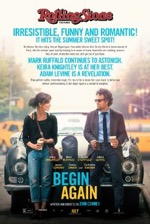
Starring: Keira Knightley
July 2014
This review was originally tweeted in Real-time from the back row of a movie theater and appears @BackRoweReviews. Though efforts were made to tease rather than ruin this movie’s memorable lines and moments, some spoilers may exist in the following evaluation. The original tweets appear in black, while follow-up comments appear in red. For concerns over objectionable content, please first refer to one of the many parental movie guide websites. All ratings are based on a four star system. Happy reading!

Vision, not gimmicks. The opposite of most entertainment these days.
Especially big budget blockbusters.
The imaginary arrangement that’s constructed around Knightley’s acoustic song is brilliant.
I envy people with such musical mutant powers.
The new song garners a slap from the mind reader.
Never underestimate the power of women’s intuition.
Record every song at a different location. A unique concept.
And a logistical nightmare. Probably the reason why no one’s ever done it before.
“Hold on” section with the kids is a nice moment.
Well worth the $5 per kid for their services.
Listening to Knightley’s playlist via a special splitter. Recreating a magical moment.
This musical montage is the highlight of the film. The sequence is the audio/visual equivalent of a warm embrace.
The kazoo solo is hilarious.
I used to play one as a kid, but I’m out of practice. I need to get my chops up.
A buck for a book is a risky proposition. An amusing coda.
I love it when we get additional story during the end credits and not just silly outtakes.
Final analysis: like Once, this is a song-centric film with strong character beats and fine performances.
The songs Knightley’s character sings have a Norah Jones or Colbie Caillat quality to them and should prove listenable, and perhaps even enjoyable, for most viewers.
Like the music it features, the film is a stripped-down drama that reminds us of what pure artistry really is.
Rating: 3 out of 4. A charming turn by Knightley & a new career watermark for Ruffalo. Plus some catchy tunes.
From director John Carney, who brought us the similarly themed and structured Once (2007), comes Begin Again, a dramatic and romantic movie that can’t really be classified as either. Nor can it be called a musical, despite the fact that it has just as many full songs as most musicals. Genre quandaries aside, what’s readily apparent is the movie’s easy manner and affable characters (and the picturesque location footage shot in NYC doesn’t hurt either). Besides its toe-tapping melodies, the film’s greatest asset is its deftness at avoiding standard rom-com clichés. For starters, there really isn’t a romance in the film since Knightley breaks up with her singer boyfriend, Dave (Adam Levine) and, thankfully, never hooks up with Ruffalo (eww!). The movie also does a good job of avoiding mawkish episodes: a scene near the end sets up the opportunity for an emotionally gratifying (and gratuitous) moment when Dave invites Knightley to the stage during a concert (the same exact scenario occurs when Hugh Grant coaxes Drew Barrymore to the stage in the 2007 film Music and Lyrics). Against our expectations, Knightley listens in the wing for a few minutes and then leaves. That’s just one example of how Carney (who serves as sole writer) diligently worked to keep his story free of contrivance. So then, no matter which genre Begin belongs to, file it in the feel-good music movie section, and those who stumble upon this indie winner will be completely satisfied.
Rio 2 (G)

Starring: Jesse Eisenberg
April 2014
This review was originally tweeted in Real-time from the back row of a movie theater and appears @BackRoweReviews. Though efforts were made to tease rather than ruin this movie’s memorable lines and moments, some spoilers may exist in the following evaluation. The original tweets appear in black, while follow-up comments appear in red. For concerns over objectionable content, please first refer to one of the many parental movie guide websites. All ratings are based on a four star system. Happy reading!

Nice tropical sounds added to the 20th Century Fox fanfare.
The percussive rhythms of Carnival.
A blue feather is found in the Amazon.
Right next to the nest of raptor eggs.
Nice tour of Brazil in a storybook montage.
The bird’s-eye vantages of the major cities really help to capture the flavor of this diverse country.
Kristin Chenoweth voices the poisonous frog. Call it a significant career change.
Just further proof that there isn’t anything she can’t do in the biz.
The blue community’s celebration song is brilliantly animated and choreographed.
A visual treat that recalls other such elaborately produced numbers in the first film.
The jungle talent auditions are hilarious.
The male black panther singing high soprano is particularly humorous.
Blue insults the Red leader. This means war.
Insulted Red Leader? Who does he think he is, Luke Skywalker? Correction: Blu.
Fanny Pack single-wingdedly looses the war.
Final analysis: a respectable sequel with some new characters and challenges thrown into the mix.
While some original characters, like George Lopez’ Rafael, are sidelined for much of the movie.
Rating: 2 1/2 out of 4 stars. So will the sequel be called Rio 3 or Amazon 2? I’m so confused.
Such confusion stems from the fact that the majority of the film takes place in the Amazon—only about the first fifteen minutes of the story transpires in the birds’ native haunts in Rio. Whereas it was the right decision to move some of the action away from the familiar settings established in the first film, the sequel spends too much time away from the titular city and should’ve returned there if only for a closing number to provide an adequate bookend for the film. Indeed, one of the subplots (the proposed talent show) would’ve been a natural, logical way to close out the film…but that plot thread is left dangling in the tropical breeze. The familial aspects work really well here, but the writers work overtime at turning Blu into an avian version of Ben Stiller’s character in the Meet the Parents movies. Seeing the blue bird bumble and stumble through every situation grows tedious after a while and the way his one heroic act at the end rectifies all the damage he’s done all movie long is extremely contrived. And speaking of Blu’s defining moment of valor, does anyone else see the connective tissue between clumsy Jar-Jar leading the Gungan attack against the Battle Droid army in Star Wars-Episode I: The Phantom Menace and Blu leading the charge against the humans and their bulldozers here? This heavy-handed means of vilifying humans is old hat. Though conducted on a much smaller scale, this nature-revolts-against-humans finale is virtually identical to the one in FernGully…The Last Rainforest (1992). Whereas I’m certainly not a supporter of deforestation or any other means by which humanity destroys nature, I’m even less sanguine when Hollywood indoctrinates impressionable minds with its diatribes of evil humans and their careless stewardship over the planet (see my review of “Happy Feet” for a rant on the subject). This “humans bad, nature good” final conflict was the only sour note in an otherwise mellifluous animated romp in the jungle. So the question remains: how much of Rio will we get to see in Rio 3?
The Lego Movie (PG)

Starring: Will Arnett
February 2014
This review was originally tweeted in Real-time from the back row of a movie theater and appears @BackRoweReviews. Though efforts were made to tease rather than ruin this movie’s memorable lines and moments, some spoilers may exist in the following evaluation. The original tweets appear in black, while follow-up comments appear in red. For concerns over objectionable content, please first refer to one of the many parental movie guide websites. All ratings are based on a four star system. Happy reading!

Everything is already done for you…which some would say is the downfall of movies.
LOTR style opening. A wizard recounts a prophecy...in rhyme.
Everything is awesome...until Emmett tries following a woman into a construction site.
Many men have rushed headlong into destruction while pursuing a woman, so it’s not just a Lego thing. Correction: Emmet.
Wild Style and The Special land in the Old West.
Nope, there’s no time for them to say howdy to Rango. Correction: Wyldstyle.
The meeting of master builders is attended by many familiar figures, including the wizard Double Door.
A really funny play on words. The assembly is chockfull of familiar faces from many different franchises.
The double-decker couch actually serves a purpose.
Batman hitches a ride on the Millennium Falcon. Funny scene.
In what other movie can you find such a scene? The “They’re all guys” bit is a hoot.
The Bat pun is humorous.
The deadpan delivery by Will Arnett, who actually does a respectable job of voicing the Caped Crusader, is absolutely perfect.
Will Farrell meets his alter ego. Results in a touching scene.
Final analysis: some funny moments along with the pedestrian ones. A nice emotional payoff at the end.
Rating: 2 1/2 out of 4 stars. Not hard to see this becoming a franchise with the myriad sets to choose from.
The animated films that tend to endure are those that work on two levels: cute and funny for the kids, witty and emotionally complex for adults. Pixar has long been the exemplar for how to simultaneously cater to kids and adults in the same movie, but other animation studios have gradually found their own way in achieving this multidimensional storytelling method. The Lego Movie does an excellent job of servicing the different generations in the audience with whip smart humor and pulse-pounding action sequences. Many of the “adult” jokes, some of which contain biting political commentary, will fly right over the heads of younger viewers. That’s okay, because there’s plenty for the youngsters to enjoy here, not the least of which is seeing many of their favorite heroes hanging out together on the big screen. Characters from the Batman, Star Wars, Lord of the Rings and Harry Potter franchises all peacefully coexist in this mash-up mayhem, but a pair of original characters, Emmet (Chris Pratt) and Wyldstyle (Elizabeth Banks), drive the story’s action. And then there’s schizoid Good Cop/Bad Cop (Liam Neeson), who steals the show with his mercurial moods and vacillating voices. The voice cast is beyond stellar, including Morgan Freeman, Will Ferrell, Jonah Hill, Channing Tatum and Cobie Smulders, to name just a few. It’s an added treat to hear actors voicing their original characters like Billy Dee Williams as Lando and Anthony Daniels as C-3PO. The final ten minutes close out the movie with a heartwarming resolution, which, for this adult, tied things up with satisfactory emotional closure. There are myriad creative avenues for the writers to explore in the inevitable sequel. We’ll just have to wait and see what new adventure they come up with…or, if we don’t want to wait that long, we can create our own sequel with the Legos we have hidden in the shoebox in the corner of the closet. I won’t tell if you won’t.
Chef (R)
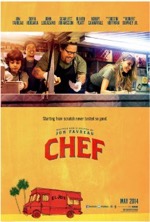
Starring: Jon Favreau
May 2014
This review was originally tweeted in Real-time from the back row of a movie theater and appears @BackRoweReviews. Though efforts were made to tease rather than ruin this movie’s memorable lines and moments, some spoilers may exist in the following evaluation. The original tweets appear in black, while follow-up comments appear in red. For concerns over objectionable content, please first refer to one of the many parental movie guide websites. All ratings are based on a four star system. Happy reading!

The whole hog for review day.
A piece of fruit versus kettle corn. Guess which one wins.
One look at Favreau should answer that question. He almost had me sold on the fruit, though.
Favreau tells Hoffman his restaurant is in a “creative rut.”
Hoffman tells Favreau to cook his favorite hits. Favreau tells Hoffman to take his job and shove it…which was a hit in 1977 by Johnny Paycheck.
Favreau’s son helps him create a #Twitter account. Welcome to social media.
Favreau sends his first tweet. Love the bird animation and tweet sound effect.
Favreau gets a crash course on the public nature of #Twitter.
It’s not like texting, folks. I’m always happy when Twitter gains exposure in movies since I use it in conveying my reviews, but are people really this ignorant over the medium in question? Sometimes I think it’s a little overdetermined like in Draft Day when Costner’s mom (Ellen Burstyn) uses Twitter and he doesn’t. And “dummys” on the subject always call it “twittering.”
Review redux. Showdown creates a media firestorm.
TMZ would have a field day over such a demonstrative meltdown.
New job: be a nanny in Miami.
Wish I can take credit for the rhyme, but it’s in the dialog.
Iron Man gives Favreau a taco truck.
How to make a Cubano sandwich. A delectable scene.
Lady and the Tramp photo op with cop is hilarious.
Cornstarch on ware wolves. Sidesplittingly funny.
Correction: werewolves. This scene is a bit crass but it’s extremely hilarious, especially if you’re a fan of random gags.
Austin Midnight sandwich for $7. Looks delicious.
Actually, as tasty as that sandwich appears, I’d gladly pay $20 for one.
One second video is a special moment.
It’s amazing what kids can do with technology these days. Oops, just dated myself.
Final analysis: a delicious repast of father/son, road trip and follow your dreams tropes served with flair.
Rating: 3 out of 4 stars. A feel good film with plenty of laughs and heartwarming moments. Worth a watch.
Favreau has spent the better part of the last decade behind the camera, so it’s nice to see him acting again, and what’s more, in a leading role that he can really sink his teeth into. As the title would suggest, this movie is all about food, so viewers are strongly cautioned not to enter the theater on an empty stomach…otherwise you might find that you’re one limb short when you leave. As for me, I was stuffed to the gills when I saw the film and I was still salivating throughout the movie. There’s not much more I can add to my above analysis, and I don’t want to ruin any of the movie’s many memorable moments. This is a highly pleasurable film where the plot has just as much meat as the dishes it serves. Chef is a rare treat that’s not to be missed. Order up!
Frozen (PG)

Starring: Kristen Bell
November 2013
This review was originally tweeted in Real-time from the back row of a movie theater and appears @BackRoweReviews. Though efforts were made to tease rather than ruin this movie’s memorable lines and moments, some spoilers may exist in the following evaluation. The original tweets appear in black, while follow-up comments appear in red. For concerns over objectionable content, please first refer to one of the many parental movie guide websites. All ratings are based on a four star system. Happy reading!

Love the part writing on the opening choral number.
Gorgeous animation on the ice breaking scene.
This sequence harkens back to diminutive laborers swinging pickaxes in a diamond mine in Snow White and the Seven Dwarves (1937)…but without all the “Heigh-Hos.”
The king seeks aid from rolling rocks.
There’s a really good rock ‘n’ roll joke in there somewhere, but chances are it’ll end in a groan. And neither of us wants that.
“Do you want to build a snowman?” Wow, what an emotionally charged back story.
This heart-rending sequence approaches the master level storytelling exhibited in the opening montage of Up (2009). Boy does it hit the mark.
Water fountain ice sculpture and walk across the lake are brilliant.
There’s some superb animation in this section of the film.
My God, the “frozen fractals” CGI is utterly jaw-dropping.
Ditto to the previous remark times a million.
Olaf dreams of summer. Funny how we always long for what we can never have or will lead to our destruction.
Just human, or snowman, nature I suppose.
The duet by the sisters reminds me of the “Defying Gravity” song in Wicked.
Fitting since one of the singers in that song also lends her voice here, Idina Menzel.
Ice queen gives her sister a snow lock like Simon in #TheDragonboneChair.
This book, the first in a trilogy written by Tad Williams, should be essential reading for fantasy lovers.
“My own personal flurry.” Hilarious!
Unlike many of the cutesy sidekicks in the 90s and 00s Disney movies, Olaf doesn’t work too hard to be funny…he just is. He’s also charming, which is more than I can say for many of the “comic relief” characters from the period in question.
Final analysis: a beautifully rendered animated film that features some funny and touching moments.
This film is the perfect marriage between classical Disney magic and Pixar’s storytelling brilliance.
If Disney wants to regain its dominance in the industry, this film should serve as a template.
Rating: 3 1/2 out of 4 stars. Pure animation excellence and well deserving of its Oscars.
Of course, it’s easy to gush in retrospect, but this film certainly deserved the Oscars it won back in March, including the coveted Best Animated Feature Film. Thanks in large part to the creative guidance of John Lasseter, the gap between Disney and Pixar animated films has significantly narrowed. More homogeneity exists between both animation houses at present than ever before and it just makes sense that Disney/Pixar films should possess the same level of quality and creative consistency across the brand…the results have been largely lopsided until now. Besides the eye-popping CGI, there are also plenty of other things to celebrate in the film, not the least of which is co-director Jennifer Lee’s screenplay based upon Hans Christian Andersen’s “The Snow Queen.” There are many classical Disney flourishes in the film along with some fresh elements too, like the clever twist on the hackneyed story device where a character can only be reanimated by “true love’s kiss.” The movie boasts the finest musical numbers in any Disney movie since Beauty and the Beast (1991). There isn’t a wasted word or note in any of the songs and “Let It Go,” performed by Menzel, justly deserved the Oscar win for Best Original Song. As incredulous as it seems, this is the first Best Animated Film Oscar bestowed upon the Mouse House: since its inception in 2002, the category has been dominated by Pixar. In truth, I’m much more of a Pixar fan than a Disney fan, but I must admit to being completely won over by the film’s charm, heart and visual grandeur. There can be no doubt that Frozen is a giant step in the right direction for Disney. Hopefully, like iron sharpening iron, the two studios will push each other to greater artistic and dramatic achievements in the future. A little sibling (studio) rivalry never hurt anything, right?
Muppets Most Wanted (PG)

Starring: Ricky Gervais
March 2014
This review was originally tweeted in Real-time from the back row of a movie theater and appears @BackRoweReviews. Though efforts were made to tease rather than ruin this movie’s memorable lines and moments, some spoilers may exist in the following evaluation. The original tweets appear in black, while follow-up comments appear in red. For concerns over objectionable content, please first refer to one of the many parental movie guide websites. All ratings are based on a four star system. Happy reading!

Guess I should show more respect for the little green guy. After all, he has a star on the Hollywood Walk of Fame. I know ‘cause I’ve seen it.
Really amusing Monsters University short.
Clever opening number about sequels. Did anyone catch The Seventh Seal reference?
One of the lines suggests that this is the seventh film since the original movie. My higher math tells me that there are now eight films in the Muppets series. Certainly a respectable franchise, although it has a long way to go to catch up to James Bond.
Badguy proposes a world tour. What could possibly go wrong?
“Drum solo!” Animal is a crackup.
Don’t worry; he eventually gets his solo…which lasts two hours. Thank God for editing.
Christophe Waltz dances the waltz. Doesn’t get any more tongue-in-cheek than that.
Correction: No “e” in Christoph.
Kermit receives a spork crown at the gulag.
Some people wait their whole lives for such an honor.
Liotta and Trejo doing dance moves is a bigger gas than Chris Cooper doing rap in the last film.
Kermit must direct a prison review or be stuck to “the wall.”
The prison ballet scene is just plain wrong.
These Cabbage Patch Muppets are creepy looking.
They look like Chucky’s illegitimate children.
Piggy sees double at her wedding.
The doppelgänger subplot is older than dirt, but keeps finding its way into movies.
Final analysis: just what you’d expect from a Muppets movie...lots of gags, pratfalls and inside jokes.
With puns and one-liners to spare.
Rating: 2 1/2 out of 4 stars. Not as heartfelt as the previous film, but just as entertaining.
The previous film in the series, The Muppets (2011), was a valentine to the fans and franchise. The movie was delivered with undeniable reverence and passion by co-star/co-writer Jason Segel (TVs How I Met Your Mother), who is a lifelong Muppet lover. The new Muppet introduced in that movie, Walter, was clearly envisioned as a Muppet version of Segel’s younger fan boy self. Though Walter also appears in this film, his involvement is in more of an ancillary capacity. Even though it’s just as amusing, this movie isn’t as from-the-heart as its predecessor. But that isn’t to say it’s without entertainment value. Fey, Gervais, Ty Burrell and a slew of high caliber performers in cameos infuse the movie with sufficient star power and the laughs keep coming at a steady clip throughout the movie. The Spartacus inspired scene near the end of the movie, where all of the Muppets offer themselves up for imprisonment so that they won’t be separated from Kermit, is definitely an emotional high point. All in all, this movie is diverting, family friendly fare that should fill the bill if this is the kind of entertainment you’re in the mood for. In the end, Muppets Most Wanted is exactly what you’d expect it to be. And in this instance, that’s not such a bad thing.
The Grand Budapest Hotel (R)

Starring: Ralph Fiennes
March 2014
This review was originally tweeted in Real-time from the back row of a movie theater and appears @BackRoweReviews. Though efforts were made to tease rather than ruin this movie’s memorable lines and moments, some spoilers may exist in the following evaluation. The original tweets appear in black, while follow-up comments appear in red. For concerns over objectionable content, please first refer to one of the many parental movie guide websites. All ratings are based on a four star system. Happy reading!

The opening matte paintings have a Mr. Rogers charm.
Something about the way the little tram moves up the model reminds me of the cheesy miniature sets seen on Mister Rogers’ Neighborhood on PBS.
Law dines with Abraham, who regales the story of the early days of the hotel.
Which, along with some minor crosscutting back to the present, constitutes the bulk of the film.
The reading of the will and a round of punches. A lot of fuss over “Boy With Apple.”
The Green Goblin lands the final blow…of course.
Elaborate breakout sequence is amusing.
I don’t think it’s possible to devise a more indirect route for escaping a prison. And once free, everyone would stand around and talk for a few minutes, right? Hilarious!
A second copy of the second will...quite the confession.
Old style filming on the ski chase is hilarious.
The increased film speed has a silent era feel akin to the Keystone Cops movies.
Final analysis: not as endearing as Moonrise Kingdom, but a fine effort in its own right.
Rating: 3 out of 4 stars. A zany tale with a fine lead performance by Fiennes.
Enjoyably outlandish, this movie is vintage Anderson. It has all of the hallmarks that have come to define the auteur’s style: quirky characters, decorated ensemble, ornate dialog, stylish camerawork, lavish locations and high production values. Though a million miles apart thematically, this film actually boasts a narrative structure similar to the one employed in Christopher Nolan’s Inception (2010). Just as Nolan’s preeminent mind-trip featured a plot with multiple layers, this movie also follows different sets of characters (real and fictitious) through different periods of time. The film’s denouement seamlessly progresses forward through the levels until we’re back in the present, which is where the film began. It’s a clever framing device, brilliantly conceived and executed by Anderson and co-writer Hugo Guinness. Bottom line, if you’re in the mood for something outside the box, this film should do rather nicely.
The Wolf of Wall Street (R)
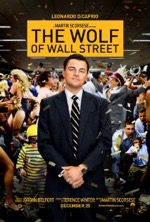
Starring: Leonardo DiCaprio
December 2013
This review was originally tweeted in Real-time from the back row of a movie theater and appears @BackRoweReviews. Though efforts were made to tease rather than ruin this movie’s memorable lines and moments, some spoilers may exist in the following evaluation. The original tweets appear in black, while follow-up comments appear in red. For concerns over objectionable content, please first refer to one of the many parental movie guide websites. All ratings are based on a four star system. Happy reading!

DiCaprio’s internal monologue becomes a direct address to the camera. Interesting narration method.
American Hustle, a concurrent release, also features an unusual mode of narration.
McConaughey’s chest thumping is truly bizarre.
And his protruding buck teeth only add to the strangeness of the scene.
DiCaprio gives a clinic on how to sell stocks.
Jaws go slack all over the call center.
Hill’s “present” sets DiCaprio on a bad course.
New company with a new script.
Wages increase while inhibitions decrease.
Robin Leach’s extravagant description of the yacht is amusing.
“Pick up the phone and start dialing.” DiCaprio’s rousing speech verges on the manic.
No verge about it…he falls over the cliff.
DiCaprio and Kyle Chandler’s amiable showdown on the yacht is amusing.
The Cerebral Palsy Phase. Funny stuff.
DiCaprio decides not to be sold to and creates an army of chest-thumpers.
Not to worry, they’ll all be making cameos in the next Planet of the Apes Movie.
Somehow the story just morphed from Wall Street into The Perfect Storm.
A very bizarre narrative left turn.
Chandler delivers a yellow “go to jail” card.
Final analysis: an overlong tale of greed, sex and drugs with an unrelenting blitzkrieg of F bombs.
Slick direction by Scorsese and fabulous acting all around.
Owes a debt to Wall Street and The Boiler Room, but pushes the boundaries of excess to the extreme.
Rating: 2 1/2 out of 4 stars for being derivative & excessive. Now I need Benihana & a mind cleanse.
There’s a great divorce in my evaluation of this film—a giant chasm which makes reconciling both sides a quandary of epic proportions. On one side is Scorcese’s sumptuous direction, DiCaprio’s utterly captivating performance and top-notch work in every phase of the production. On the other side is the ostensibly hyper-real lifestyle of the characters which comes complete with lewd behaviors of every kind imaginable and pervasive drug use all being done at work, out in the open for everyone to see, enjoy and clap and cheer for. If you’re still under the assumption or misguided, idealistic hope that some things are still sacred in the world, give this film a watch and it will shatter any such notions. I think the disconnect for me is a matter of identification…the lifestyle placed on display in the film isn’t even remotely appealing to me so it’s hard for me to sympathize with any of the characters. As such, this get rich, live large philosophy holds no fascination for me. Despite its stellar production values, I just can’t endorse this film because its excesses detract from its entertainment value. In the final analysis, Scorcese’s wonderfully woven Wolf is merely a celebration of corruption and debauchery. Morally reprehensible from one set of credits to the other, this film is gratuitous to its own peril.
Anchorman 2 (R)
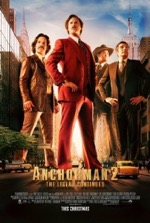
Starring: Will Ferrell
December 2013
This review was originally tweeted in Real-time from the back row of a movie theater and appears @BackRoweReviews. Though efforts were made to tease rather than ruin this movie’s memorable lines and moments, some spoilers may exist in the following evaluation. The original tweets appear in black, while follow-up comments appear in red. For concerns over objectionable content, please first refer to one of the many parental movie guide websites. All ratings are based on a four star system. Happy reading!

“Me or the job.” Easy decision as we soon see.
The “chicken of the cave” scene is hilarious.
One of the only genuinely funny scenes in the movie.
One superhero that should never see the light of day...Lace-Man.
However, he might be an appropriate sidekick for Ballerina-Man, who made quite an impression on the judges at a superhero tryout in Mystery Men (1999).
First live car chase is a smash.
But seems passé in retrospect.
Ron’s Doby lullaby is utterly ludicrous.
Multi-network melee in Central Park is daft beyond description.
But it’s loaded with A-list stars.
Final analysis: a profound disappointment. The vast majority of the film isn’t even remotely funny.
Rating: 1 out of 4 stars. Dumb from the word go, this sequel is anything but classy.
The first film was crass and idiotic, but was also charming and, on occasion, heartwarming. This one is just crass and idiotic. As Forrest Gump would say, “That’s all I have to say about that.”
The Secret Life of Walter Mitty (PG)
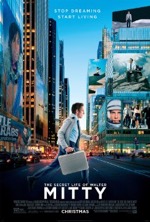
Starring: Ben Stiller
December 2013
This review was originally tweeted in Real-time from the back row of a movie theater and appears @BackRoweReviews. Though efforts were made to tease rather than ruin this movie’s memorable lines and moments, some spoilers may exist in the following evaluation. The original tweets appear in black, while follow-up comments appear in red. For concerns over objectionable content, please first refer to one of the many parental movie guide websites. All ratings are based on a four star system. Happy reading!

Walter’s wink is rejected. The joys of online dating.
And has product placement in a movie ever been as front and center as eHarmony is here?
Lots of Ally McBeal like flights of fancy, one of which features a poetry falcon.
The last LIFE, a missing photo and a meet cute.
Don’t touch Mitty’s Stretch Armstrong.
I punctured mine as a kid and got the green monster guy as a replacement. Those toys were supposed to be puncture proof…leave it to me.
Am I way off base here or should Mitty check the wallet for the missing negative?
Refer to Jeff Goldblum’s line in Jurassic Park after the T-Rex smashes through the fence.
The Benjamin Button fantasy is humorous.
Mitty finds a thumb in Greenland.
Does that mean he has a green thumb?
Does Iceland really have a Papa John’s?
Another shameless, and dubious, product placement.
Searching for ghost cats in the Himalayas.
BTW, did Mitty ever submit a vacation request at work?
Mitty’s mom saves his wallet and his LIFE.
Mom = Shirley MacLaine. Her “Oh, by the way…” meeting with Penn is contrived beyond belief.
Final analysis: a sweet film that appeals to the daydreamer in all of us.
This life-affirming film reminds us that we’re all extraordinary & that life is an adventure.
Rating: 2 1/2 out of 4 stars. Directed by Stiller, the film is inspirational but predictable.
A feel good film based on James Thurber’s classic and the original 1947 movie starring Danny Kaye, the new Mitty is endearing and ennobling but is also exceedingly overly simplistic in the script department. There’s no character complexity and no narrative nuance here. Everything is buttoned up just as you’d expect it to be. Though painfully two-dimensional at times, Stiller’s Mitty is a revealing character study of a man trapped inside his own mental prison, however elaborate a prison it is. Mitty’s attempts at breaking out of self-imposed strictures, routines and modes of behavior is half the fun of the movie, and in our increasingly isolated society, I’m sure many audience members can identify with Stiller’s portrayal of a highly intelligent and creative individual who’s constrained by social inadequacies, whether real or imagined. The other half of what makes the movie fun is the globetrotting to Iceland, Afghanistan and the Himalayas, all of which were filmed on location in Iceland. So if an uncomplicated, warm fuzzy fest is on today’s movie menu, order up the Mitty with a side of popcorn and you’ll be completely satisfied.
Saving Mr. Banks (PG-13)
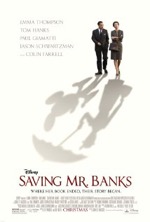
Starring: Emma Thompson
December 2013
This review was originally tweeted in Real-time from the back row of a movie theater and appears @BackRoweReviews. Though efforts were made to tease rather than ruin this movie’s memorable lines and moments, some spoilers may exist in the following evaluation. The original tweets appear in black, while follow-up comments appear in red. For concerns over objectionable content, please first refer to one of the many parental movie guide websites. All ratings are based on a four star system. Happy reading!

In case anyone cares for this brand of trivia, this is the second film Hanks has starred in with “saving” as the first word in the title.
Chlorine and sweat...an apt description of L.A.
Actually, chlorine is probably one of the city’s nicer smells.
I feel the same way about pears.
Eating sandpaper would have about the same effect.
An audience with Walt. The first/last name preferences are hilarious.
Some great dialog and performances by Hanks and Emma Thompson here.
No red in the picture. The demands keep coming.
The music goes up on the word down...ironic.
And ingenious.
Farrell’s speech is incredibly uncomfortable.
In fact, it’s squirm-in-your-seat awful.
“Get on the horse, Pamela.”
The penguin’s out of the bag...animation.
Walt’s story about delivering newspapers in the snow features some astounding acting.
Even by Hanks’ lofty standards.
Escorted to the premier by Mickey himself.
Be sure to sit through the end credits for an amusing extra.
Final analysis: an amazing production with stellar acting from a dazzling and diverse cast.
Especially Colin Farrell, Paul Giamatti and Jason Schwartzman…who can actually sing. His rendition of “Feed the Birds” is one of the film’s emotional high points.
A great deal of magic and heart here along with some bittersweet revelations of the past.
Rating: 3 1/2 out of 4 stars. Walt would be proud of this genuinely moving biopic.
When you think Disney, you think magic. Whether someone casting a spell in an animated feature or a woman pulling sundry items out of a bag in a movie like Mary Poppins (1964), the Disney classic which this movie is framed around, magic is a word very closely associated with the Mouse House and its numerous and diverse productions. If you’re doing a movie about Walt, it’d better be magical, and fortunately, there’s nothing to worry about here. Additionally, you’d better cast someone amazing to play Mr. Disney. Again, no problem since the namesake studio nabbed Hanks for the title role. For those who love classic Disney films, and Mary Poppins in particular, this movie will fill you with a rare form of elation that derives from deep admiration and fond memories. Some would define that special kind of feeling as…magic.
Machete Kills (R)

Starring: Danny Trejo
October 2013
This review was originally tweeted in Real-time from the back row of a movie theater and appears @BackRoweReviews. Though efforts were made to tease rather than ruin this movie’s memorable lines and moments, some spoilers may exist in the following evaluation. The original tweets appear in black, while follow-up comments appear in red. For concerns over objectionable content, please first refer to one of the many parental movie guide websites. All ratings are based on a four star system. Happy reading!

Spilled is probably a better usage of the word.
70s style “prevue” is a hoot.
Three different armies in as many minutes. The bloodbath begins.
This initial bloodletting, which comes even before the first evidences of a plot have coalesced, clues us into the fact that everything else in the movie will take a back seat to the action sequences.
Mr. Machete Goes to Washington.
“Machete don’t smoke.” Ha!
Machete don’t tweet either. Fortunately I do.
However, these “Machete don’t ____” gags are getting tired at this point.
Helicopter homicide is disgusting.
And utterly unrealistic.
Mexican standoff in a Mexican restaurant ends with a bang.
OMG! Vergara’s body part weapons are...words fail.
Molecule blaster is gross, but humorous.
The Star Wars and Star Trek allusions are becoming intolerable.
The ending gets extremely gimmicky and borrows heavily from a plethora of genre movies.
Final analysis: bloodier and more outlandish than the original, if possible.
Rating: 2 1/2 out of 4 stars. Will this film earn enough money to justify the promised sequel? Voz knows.
This movie is a profound disappointment. The first film was also a bloodbath, but it was amusing and had more than its share of heartfelt chuckles. Here, the laughs are strained and far too many of them are accompanied by eye rolls. Rodriguez’ first Machete (2010) allowed us to experience the lighter side of a splatter-fest; the slayings were so elaborate, so frequent and so graphic that they bordered on the comedic. In this sequel, far too many of the action scenes are gross or gratuitous and lack the degree of levity that made the first film such a guilty pleasure. As for the supporting players, Sofia Vergara is way over-the-top and Mel Gibson’s villainous Voz is just strange—even by Mel’s standards. Hopefully Rodriguez will right the ship for Machete Kills Again.
Kick-Ass 2 (R)

Starring: Aaron Taylor-Johnson
August 2013
This review was originally tweeted in Real-time from the back row of a movie theater and appears @BackRoweReviews. Though efforts were made to tease rather than ruin this movie’s memorable lines and moments, some spoilers may exist in the following evaluation. The original tweets appear in black, while follow-up comments appear in red. For concerns over objectionable content, please first refer to one of the many parental movie guide websites. All ratings are based on a four star system. Happy reading!

Shooting her friend in the back. With friends like her...
Absent for her perfect attendance award.
Dr. Gravity to the rescue.
This is one funny sequence. You just never know when some random vigilante will appear to save your butt in this comic book world. Apparently there’s no such thing as deus ex machina in this world either.
“You’re gonna need a bigger jar.” NK. Especially with her potty mouth.
These wanna-be superheroes remind me of the misfits in Mystery Men.
The 1999 comedy is highly recommended for those who, like me, have a warped sense of humor.
Fight moves at dance team tryouts is a really nice sequence.
Or maybe it was cheerleader tryouts…I don’t remember. Don’t care either.
Will the “date ditch” impel Hit Girl into taking up her mantle again?
Starting to turn into Mean Girls. The puke taser is gross.
No description required.
Battle royale. Great protracted battle between Hit Girl and Mother Russia.
Final analysis: as brutal and crass as the first film, but still quite entertaining.
I still miss Nicolas Cage’s Big Daddy, though. Probably my all-time favorite role of his…which still isn’t saying much.
Rating: 2 1/2 out of 4 stars. Some good messages sandwiched between action scenes.
Compared to the first, controversial film, the sequel seems somewhat tame by comparison. With no origin story to give it context and structure, the sequel focuses on Mintz-Plasse’s 2.0 version villain and a gaggle of B and C tier “Superheroes/Super villains.” Not as clever or incisive as its forebear, this follow-up film makes a valiant attempt at superseding the first film, but in the end gets its butt kicked by the original.
The World's End (R)
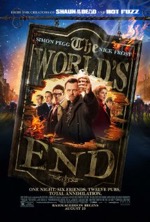
Starring: Simon Pegg
August 2013
This review was originally tweeted in Real-time from the back row of a movie theater and appears @BackRoweReviews. Though efforts were made to tease rather than ruin this movie’s memorable lines and moments, some spoilers may exist in the following evaluation. The original tweets appear in black, while follow-up comments appear in red. For concerns over objectionable content, please first refer to one of the many parental movie guide websites. All ratings are based on a four star system. Happy reading!

Hopefully this will be less offensive than the other recent apocalyptic film, This Is the End.
Though both movies share a similar title, this effort is more creative and less offensive than Rogan’s raunch-fest.
Pegg’s opening narration ends in an unexpected location.
Reunion of pals and a road trip in the Beast.
This wouldn’t officially be a buddy movie without a road trip.
Pegg’s rapid-fire speech to the motel attendant is hilarious.
Wonder how many takes it took.
First stop on the golden mile. A toast to kids wherever they may be.
Mum calling...oops.
Busted!
Fisticuffs in the bathroom. A whole new meaning to blue bloods.
Live on stage: The Marmalade Sandwich.
Truly a snicker worthy band name.
Scars and memories...the things that make us human.
In Cars 2 it was dents. Same dif.
Giant modern art statue is reminiscent of Gort.
The plaque must read: “Klaatu Barada Nikto.”
Final analysis: borrows liberally from The Day the Earth Stood Still and Invasion of the Body Snatchers.
Not nearly as good as Hot Fuzz or Shaun of the Dead. Also, what a strange ending.
Rating: 2 1/2 out of 4 stars. The slow start and strange finish detract from this marginally amusing tale.
Although the movie coaxes occasional chortles from its audience, classifying it as a comedy would be a bit of a stretch. The whole affair feels low budget and the otherworldly twists in these Pegg penned movies are becoming predictable and pedantic…and pedestrian. The simple premise makes for an uncomplicated movie but also a largely unconvincing one. Still the movie is just interesting enough to divert its audience for a couple hours. But maybe that kind of mindless diversion is all part of their master plan.
The Way Way Back (PG-13)
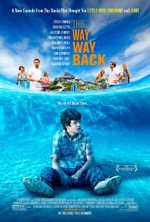
Starring: Steve Carell
July 2013
This review was originally tweeted in Real-time from the back row of a movie theater and appears @BackRoweReviews. Though efforts were made to tease rather than ruin this movie’s memorable lines and moments, some spoilers may exist in the following evaluation. The original tweets appear in black, while follow-up comments appear in red. For concerns over objectionable content, please first refer to one of the many parental movie guide websites. All ratings are based on a four star system. Happy reading!

Poor Duncan...gets a 3 out of 10 rating from Carell and gets dumped on by everyone else.
Pathos is immediately generated for Liam James’ character. From the outset, it’s obvious where our sympathies are intended to reside…a tad telegraphed by co-directors/writers Nat Faxon and Jim Rash.
Did Twisted Sister have an alternate track called “Carry a Laser?” Amanda Peet’s character thinks so.
Correction: Mr. Mister not Twisted Sister. My lack of knowledge regarding 80s music has been exposed.
Rockwell’s humor goes right over Duncan’s head...even his “best stuff.”
This is Rockwell’s most charming role to date.
A smooch before S’mores.
Wanting s’more is precisely what’s getting Carell into trouble.
Duncan’s first day working at the Water Wizz.
Terrible name for a water park. I mean, isn’t the idea to keep the wiz out of the water?
How to unclog a water tube? First, find a hero.
Rockwell’s PA gag is hilarious.
The funniest scene in the film…worth the price of admission.
Commentary on ghost crabs and a failed kiss attempt.
Final analysis: not quite what I expected, but a decent film. Carell’s most unsympathetic role.
I applaud Carell for attempting a different kind of role, but straying too far from his comedic wheelhouse could endanger his career.
Rating: 2 1/2 out of 4. Though not overly funny at least it wasn’t overly long.
Not as feel good as one would expect from the amazing cast and amusing trailer, the film is a decent indie with solid performances, a sweet teen angst/teen falling in love story and gorgeous on location filming in Massachusetts. There isn’t anything sensational here, just a pleasant slice-of-life, summer vacation yarn.
Blue Jasmine (PG-13)
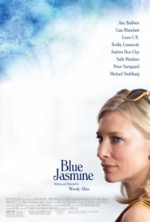
Starring: Cate Blanchett
August 2013
This review was originally tweeted in Real-time from the back row of a movie theater and appears @BackRoweReviews. Though efforts were made to tease rather than ruin this movie’s memorable lines and moments, some spoilers may exist in the following evaluation. The original tweets appear in black, while follow-up comments appear in red. For concerns over objectionable content, please first refer to one of the many parental movie guide websites. All ratings are based on a four star system. Happy reading!

I intended to say “the cast of millions.” An exaggeration of how Allen typically stuffs his films with a raft of A-list talent.
Ah, the comforting, standard Woody Allen opener. Some things never change.
Andrew Dice Clay...now that’s a casting coup.
And a surprisingly multilayered performance by the 80’s star.
Bad clams and a bad blind date.
Maybe Jasmine can commiserate with Indiana Jones…he almost had a bad date once.
Ali from #TheBachelorette. I’d recognize her anywhere.
A drink with the dentist.
That yellow purse doesn’t match her sister’s outfit.
In fact, it sticks out like a sore thumb…and I’m pretty sure that’s the point. You gotta’ love how people will try to force their one expensive accessory into a variety of outfits just for the perceived prestige it gives them.
Babysitting her sister’s boys...bad idea. Especially the “Edison’s medicine” part.
Final analysis: not top-tier Allen, to be sure, but entertaining and more accessible than To Rome With Love.
Not nearly as humorous as Allen’s usual fare. The dialog isn’t as whip-smart and witty either.
However, Blanchett’s tour de force character study of mental unraveling should garner Oscar attention.
Rating: 3 out of 4 stars. Allen’s tale of two sisters is amusing if not moving.
It’s very difficult to manufacture feelings of disappointment over a Woody Allen film, but this outing, barring Blanchett’s Oscar-worthy turn, is B-tier Allen. However, B-tier Allen is still better than 99.9% of the films Hollywood churns out these days. Although the writing suffers a bit in this film, the performances, from top to bottom, are superb. Though taken to the extreme, Blanchett’s Jasmine embodies the collective loss and bitterness our generation feels over having had it all and lost it all during the economic downturn. Most have hunkered down and moved on but some, like Jasmine, are still under the illusion that they can maintain their pre-global recession lifestyle in the present day. It’s a powerful delusion, brilliantly realized by one of the finest female actors of our time.
R.I.P.D. (PG-13)
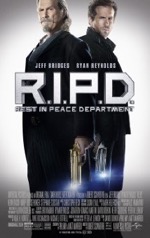
Starring: Ryan Reynolds
July 2013
This review was originally tweeted in Real-time from the back row of a movie theater and appears @BackRoweReviews. Though efforts were made to tease rather than ruin this movie’s memorable lines and moments, some spoilers may exist in the following evaluation. The original tweets appear in black, while follow-up comments appear in red. For concerns over objectionable content, please first refer to one of the many parental movie guide websites. All ratings are based on a four star system. Happy reading!

Reynolds is double-crossed by his A-list partner.
Mary Louise Parker as St. Peter? She’s in two new releases this week...impressive.
Parker also appears in Red 2.
Indian food sure does bring out the monster in some people.
Reynolds’ old partner can traverse realities? Color me interested.
Eternal affairs...clever.
A singularity forming over a city...didn’t we see this in last summer’s The Avengers?
“She billygoated me.” Eww!
Final analysis: a unique concept that isn’t exploited to maximum effect.
In fact, the premise is dumbed down for maximum commercial appeal.
Thematically and conceptually similar to the Men in Black films.
Bridges steals the show as the Custer-esque, chaw-mouthed veteran who shows Reynolds the ropes. A truly unique role.
The way he sits sidesaddle in the patrol car is a nice character touch.
Rating: 2 1/2 out of 4 stars. A sequel is almost certainly assured.
I remember laughing out loud when seeing the trailer for this film, thinking “now here’s a clever conceit.” The germ of that conceit—the premise—is the only part of the film that works. As with most Hollywood productions today, it’s poor execution and cursory character development that render this movie a pale reflection of what it could’ve been in more skillful and creative hands. And, also like too many Hollywood films today, R.I.P.D. is far too vulgar and vapid for its own good. Though Universal Studios will work hard to find a way to resurrect this sad effort into a sequel, this DOA plot should be left six feet under. RIP R.I.P.D.
Red 2 (PG-13)
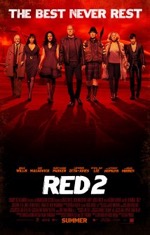
Starring: Bruce Willis
July 2013
This review was originally tweeted in Real-time from the back row of a movie theater and appears @BackRoweReviews. Though efforts were made to tease rather than ruin this movie’s memorable lines and moments, some spoilers may exist in the following evaluation. The original tweets appear in black, while follow-up comments appear in red. For concerns over objectionable content, please first refer to one of the many parental movie guide websites. All ratings are based on a four star system. Happy reading!

Is Malcovich playing possum...again?
Beware Pringles in a shoot out.
Death by origami...not pretty.
Don’t look the Frog in the eye.
Especially if it’s a hypnotoad.
The un-torture scene is uproariously funny.
“I knew she’d play him like a banjo at an Ozark hoedown.” Ha!
I didn’t find Malcovich’s character all that funny in the first film, but virtually every line he delivers in the sequel is side-splitter.
It goes without saying, but Hopkins is fantastic.
The scene where he stages his own breakout is nothing short of brilliant.
Red mercury...is that the predecessor to Trek’s red matter?
Final analysis: a rip-roaring good time. At least as good as the first, perhaps a bit better.
Rating: 2 1/2 out of 4 stars. Great action with plenty of laughs. Not a bad way to spend two hours.
Just seeing all of these A-list stars hamming it up together on the big screen is worth the price of admission, but the movie also boasts a serviceable plot populated with snappy dialog and some heart-stopping action sequences. Here’s hoping Red 3 advances the spy spoof series with the same degree of wild and witty action showcased in the first two Red films.
Despicable Me 2 (PG)
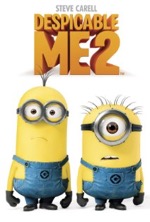
Starring: Steve Carell
July 2013
This review was originally tweeted in Real-time from the back row of a movie theater and appears @BackRoweReviews. Though efforts were made to tease rather than ruin this movie’s memorable lines and moments, some spoilers may exist in the following evaluation. The original tweets appear in black, while follow-up comments appear in red. For concerns over objectionable content, please first refer to one of the many parental movie guide websites. All ratings are based on a four star system. Happy reading!

Horseshoe-shaped super magnet appears in the Arctic. A slick sci-fi teaser.
In a jam, Gru considers a new profession.
But before he can make that decision, he lands in a sticky situation. C’mon, that’s better than half the lines in the movie.
The last thing I wanted to see in this family film was a minion in the buff. Eww.
Bad date leads to a better prospect.
Chip hat...fashionable and delectable.
But how often do you need to purchase a new one?
Shouldn’t the mutant minions be able to chew through the cages?
A bit of a spoiler, but a question that exposes this contrived plot point.
Minion mock music videos are exceedingly silly.
But it made the kids laugh, so mission accomplished I suppose.
Final analysis: too many pratfalls by minions and too shallow a plot to be fully enjoyed.
All of the best scenes were spoiled in the trailer.
Too much time was spent in the mall, which is a hackneyed locus for action.
Rating: 2 out of 4 stars. Unremarkable sequel lacks the heart of the original. A Gru-some experience.
With the runaway success of the first film, it was a foregone conclusion that a Despicable sequel would ensue. That effort ended up being pretty safe by trying to turn former super villain Gru into a nice guy (which is far less compelling), adding a possible love interest for Gru (contrived and mushy for a kiddy pic) and amping up the minion mischief (a gimmick to garner more laughs from the target audience). Those preteen spectators won’t notice the decline in story quality, but everyone else in the audience will chalk this one up as mildly disappointing. And annoying: bee-doh, bee-doh, bee-doh…
This is the End (R)
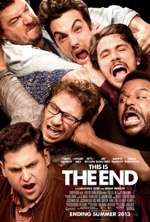
Starring: James Franco
June 2013
This review was originally tweeted in Real-time from the back row of a movie theater and appears @BackRoweReviews. Though efforts were made to tease rather than ruin this movie’s memorable lines and moments, some spoilers may exist in the following evaluation. The original tweets appear in black, while follow-up comments appear in red. For concerns over objectionable content, please first refer to one of the many parental movie guide websites. All ratings are based on a four star system. Happy reading!

Boy was I wrong.
All of the stars as themselves is a curious conceit.
And takes some getting used to…kinda’ odd at first.
A crazy earthquake or a mass beam up?
A passage from Revelation is recited. Apocalypse now?
“Rapey vibe” scene is amusing.
Danny wastes water and is voted off the island.
Jonah’s narcissistic request of God has no prayer of being answered.
Confessions followed by an exorcism.
Two radically different spiritual functions of the Catholic Church.
I thought Gandalf slew the Balrog?
Hollywood’s version of heaven...oh my!
The notion that reprobates who commit one selfless act will be admitted into heaven is absolutely absurd…like most of the movie.
Final analysis: not without moments of humor, but an extremely crass and gross film.
There was a time when jokes about sex organs were considered taboo. And then, at some point, such jokes became acceptable in films. Now we have “humor” based on the fluids that emit from sex organs in comedies like this one. Where will it end? Hopefully this is the end.
Rating: 1 1/2 out of 4 stars for incessant offensiveness and a vapid plot. Expected much more.
Afterthought: despite its transparent “message,” the movie itself has very little that’s redeemable...ironic.
A friend of mine urged me to see this movie because of its heavy dose of the book of Revelation from the Bible. There is indeed a strong eschatological (end times) theme here, but theological accuracy is a whole other matter. Bottom line is that any nods to the Good Book are merely self-serving attempts at providing some semblance of a religious framework to hold together the incessant stream of sewage that pours forth from the characters’ mouths. I repent of my decision to watch this film.
The Kings of Summer (R)
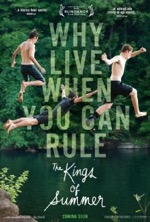
Starring: Nick Robinson
August 2013
This review was originally tweeted in Real-time from the back row of a movie theater and appears @BackRoweReviews. Though efforts were made to tease rather than ruin this movie’s memorable lines and moments, some spoilers may exist in the following evaluation. The original tweets appear in black, while follow-up comments appear in red. For concerns over objectionable content, please first refer to one of the many parental movie guide websites. All ratings are based on a four star system. Happy reading!

Looks like the kind of birdhouse I’d build. My carpenter brother would be mortified.
Game night. Avocado meat?
Goes well with spam pâté.
A montage of horsing around and a man-ifesto.
Ah, to be able to return to such simple times…when life felt limitless and summers seemed to last for years.
Every movie should have a Biaggio. He’s a hoot.
Caught red-handed with Boston Market.
A blatant violation of the Bro Code…not Barney’s.
Proving once again that Monopoly is the most divisive board game ever devised.
Back to civilization. Joe keeps the ‘stache.
The first sign of manhood?
One parting shot of the ramshackle kingdom. Dreams of independence and anonymity can’t last forever.
Stay after the credits for more Biaggio high jinks.
Final analysis: a heart-warming, if quirky, coming of age tale.
Rating: 2 1/2 out of 4 stars. Unique enough to find its way into the pantheon of runaway teen movies.
Pacing is definitely an issue here as is the plot, which generates very little tension throughout the movie…even the gimmicky snake scene doesn’t provide much jeopardy. In fact, the film doesn’t even have an antagonist. It does have quite the wild card though in the form of funny man Biaggio (Moises Arias); an unforgettable character that, due to the movie’s indie status, will be enjoyed by far too few people.
The Internship (PG-13)
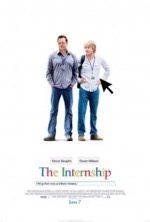
Starring: Vince Vaughn
June 2013
This review was originally tweeted in Real-time from the back row of a movie theater and appears @BackRoweReviews. Though efforts were made to tease rather than ruin this movie’s memorable lines and moments, some spoilers may exist in the following evaluation. The original tweets appear in black, while follow-up comments appear in red. For concerns over objectionable content, please first refer to one of the many parental movie guide websites. All ratings are based on a four star system. Happy reading!

The ode to the wristwatch?
A nice corrective to the fallacious line about the darkness before the dawn in The Dark Knight.
Will Farrell like you’ve never seen him before.
Phoenix proud...Skype interview is quite humorous.
If a bit overplayed…guys Wilson and Vaughn’s age would know that you don’t have to yell when skyping.
Nice commentary about the twelfth man on the bench.
Luke and Han cosplay...hilarious.
“On the line” is a bit overdetermined.
Again, the writers are working overtime to magnify the inherent differences between the two “old guys” and their younger competitors.
“Re-boot time” is way TMI.
Helpline mishap. What a sinking feeling.
Pitch to Sal is genuinely touching.
This is what’s missing in the business world today—personal connection. And actually caring for the customer.
Final analysis: a farce from start to finish, but heartwarming with a poignant message for those of any age.
Rating: 2 1/2 out of 4 stars. A feel good, follow your dreams flick.
This movie was far better than what I anticipated after viewing the yuk-yuk trailer. Sure it’s farfetched, but the movie has a lot of heart and a few chuckles to boot. Wilson and Vaughn are terrific together and ooze charm and confidence, respectively. A smart examination of the seemingly widening generation gap, The Internship is entertaining and inspiring.
Monsters University (G)
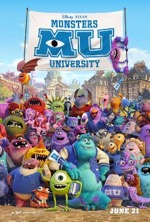
Starring: Billy Crystal
June 2013
This review was originally tweeted in Real-time from the back row of a movie theater and appears @BackRoweReviews. Though efforts were made to tease rather than ruin this movie’s memorable lines and moments, some spoilers may exist in the following evaluation. The original tweets appear in black, while follow-up comments appear in red. For concerns over objectionable content, please first refer to one of the many parental movie guide websites. All ratings are based on a four star system. Happy reading!

Starry-eyed Mike on a field trip. A monster is created.
I sense trouble with Mile’s roommate.
Correction: Mike’s roommate…who seems a bit shifty.
Mike and Sulley meet.
A meet-cute of monstrous proportions. Sorry, I couldn’t resist.
The dean is fittingly frightening.
What to do when dreams are dashed? Join OK.
Winners of the Scare Games get a Piston Cup?
The Games are the coolest part of the movie. The scene in the library is an instant classic.
Another field trip to the Big Leagues.
Don’s mustache is the Batman symbol.
A tip of the hat to the Caped Crusader by the Pixar artists?
Final analysis: doesn’t posses the unbridled creativity or emotional resonance of the original.
Nor the topical relevance of the original—the power shortages of the early 2000s.
First half is extremely gimmicky, but the plot settles in once the Games begin.
Rating: 2 1/2 out of 4 stars.
Disney’s sequelitis is beginning to infect Pixar, which is a profound tragedy.
Still, when rival DreamWorks can only muster up Turbo, Pixar is in no danger of being dethroned.
This prequel idea seemed better suited for a straight-to-DVD release rather than a theatrical one. Remember the frenetic sequence inside the factory in the first film, where rows of doors on an assembly line sail by with characters jumping on and through them? Nothing in the sequel even comes close to that level of sheer exhilaration. True, there are a few memorable and heartwarming scenes and it’s mildly entertaining seeing younger versions of Mike and Sulley, but this is a mostly mediocre movie. With Cars 2 and now Monster’s University, Pixar’s quality has clearly suffered at the hands of it’s Disney benefactors who will milk a property until the cows come home rather than producing riskier, original material…you know, the kind of stories that made Pixar great in the first place. It was bound to happen, I suppose, but it’s still sad to see.
Brave (PG)

Starring: Kelly Macdonald
June 2012
Pixar’s thirteenth film, Brave, is a bold departure from the studio’s last couple of releases, both of which were sequels and featured the exploits of toys and cars, respectively. Brave has pioneered a few firsts for the stalwart studio: somewhat surprisingly, this is the first period piece produced by the studio. The movie is set several centuries ago in the Scottish Highlands. Brave is also Pixar’s first fairy tale, told in a conspicuously classic Disney manner. Brenda Chapman is the first female director of a Pixar film. Most importantly for those who’ve been critical of the studio’s purportedly misogynistic or chauvinistic tendencies, the film features the first female title character in any Pixar film.
Some will argue that Brave is Pixar’s answer to DreamWorks’ How To Train Your Dragon (2010), but the two animated films are vastly different. For starters, there aren’t any colossal, reptilian fire-breathers in Brave. Secondly, in Dragon young lad Berk seeks approval from his father while Brave’s Merida pulls out her long, thick, red hair in defiance of her overbearing mother’s insistence on her adherence to decorum and tradition. Ultimately, Brave has more in common with early Disney animated movies than it does with DreamWorks’ foray into Medieval times, particularly any Disney classic that features an old, wart-nosed, spell-casting witch.
Less obvious is Brave’s commonality with Disney’s Brother Bear (2003), specifically in the way the spell transforms effected characters. Another element borrowed from the Disney back catalog is the archery contest first seen in Robin Hood (1973). In that movie, archers competed for a kiss from the fair Maid Marian, but in Brave, contestants are vying for Merida’s hand in marriage (until Merida pulls out her bow and shows them all how it’s done). Of course, a young lass with a bow and arrow isn’t exactly original either…Susan was a fair shot in the Narnia films and, more recently, Katniss was deadly accurate in The Hunger Games (2012). Although Merida and her mother don’t switch bodies, the way the women eventually come around to the other’s point of view definitely has shades of Freaky Friday (1976, 2003). You could also say that firelocks and the three little bears steal the show at the end, yet another allusion to a literary antecedent.
All of this to say that Brave certainly isn’t the most original of the Pixar films. However, the studio’s ability to weave these familiar story threads into an intricate tapestry of high-spirited, hilarious and heartfelt moments is really quite astounding…you might even say uncanny. And there can be no doubt that like the many early Disney animated features it emulates, Brave is brimming with that elusive quotient called movie magic.
Other than the witch’s spell, the most magical element in the movie is the tiny blue sprites called wisps. Besides looking and sounding cool, wisps are like mini spirit guides that lay out a course for the characters to follow, much like breadcrumbs in the Hansel and Gretel fairy tale. The tribute to Steve Jobs, as his wisp ascends heavenward, during the end credits is a class move by the studio who owes the departed visionary a huge debt, both creatively and financially.
Though Brave probably won’t go down as essential Pixar viewing, it succeeds on its own right and has blazed new trails for the studio. Whether or not Brave is your cauldron of brew, you’re sure to find it a significant improvement over last year’s stuck-in-neutral Cars 2. The studio is back on track.
Rating: 3
The Pirates! Band of Misfits (PG)

Starring: Hugh Grant
April 2012
If there’s an under-appreciated segment of the animated film industry it’s claymation, and when we use that word we’re talking about the undisputed masters of the form, Aardman Animations. Previous efforts have met with varied success: Chicken Run (2000) was fairly well received while Wallace & Gromit: The Curse of the Were-Rabbit (2005) was a runaway hit (judging from the movie’s overwhelming positive reception by audiences, critics and some golden guy named Oscar).
This time around, we’re taken along for a high-spirited adventure on the high seas, where the good guys are nineteenth century pirates and the bad guy is…Queen Victoria? Loosely based on the book by Gideon Defoe, Band of Misfits features the ne’er-do-well exploits of the Pirate Captain (yep, that’s his name) and his scurvy afflicted lot of loyal lads. Despite numerous entries, the Pirate Captain has never won the coveted Pirate of the Year award (much like Kevin Kline’s constantly overlooked Inspector Dreyfus in 2006s The Pink Panther). The Pirate Captain’s reckless pursuit of the prize becomes both premise and plot for the movie and, of course, we can’t make achieving his goal an easy one can we?
Having a fearsome disposition certainly helps, but ultimately the award will go to the pirate with the most booty…gold coins, not the snack. And so the Pirate Captain sets out to board every hapless vessel he encounters on the open sea, but comes up empty-handed when those vessels contain valueless cargos and equally worthless crews (comprised of plague victims, kids on a field trip, naturists and ghosts). But the plot thickens when the pirates board a vessel with an odd scientist named Charles Darwin, who takes an interest in the Pirate Captain’s plump parrot pet.
So how does Band of Misfits rank among the Aardman back catalog? The film is probably on even footing with Chicken Run, but certainly isn’t as refined or rousing as Wallace & Gromit. In Band of Misfits, the jokes don’t land with the precision of the latter and the action never quite reaches the frenetic pace of the former. Then there’s the story’s milieu; what it gains in familiarity it looses in originality.
Though these critiques may seem backhanded, the film is still a lot of fun and effectively combines clever and offbeat dialog (like when the captain avers that the best part of being a pirate is Ham Night) with outrageously creative visuals (like when dreaded Peg Leg Hastings arrives at the pirate gathering inside a whale’s mouth…the giant fish’s tongue rolls out like a red carpet).
The sheer logistics of producing one of these films is mind-boggling and it doesn’t seem quite fair that an achievement in claymation should be lumped together with traditionally drawn or computer generated animated films. Be that as it may, Band of Misfits probably won’t stand a chance against Pixar’s Brave of the raft of animated features coming out later in the year. Though Band of Misfits isn’t a top tier animated film, it’s certainly a voyage worth taking. Aye, matey!
Rating: 2 1/2
The Three Stooges (PG)
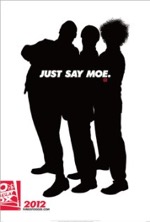
Starring: Sean Hayes
April 2012
The original Three Stooges episodes ran seventeen minutes each and many of them overstayed their welcome thanks to their exceedingly silly dialog and unrelentingly slapstick story lines. So then, how can the same brand of absurdist physical comedy, sight gags and throwaway puns maintain audience interest during the course of a full-length feature? Well, it can’t. However, The Three Stooges movie isn’t totally devoid of heart or the occasional joke that actually hits its mark (by accident in many instances).
The movie opens in a Catholic orphanage when the Stooges are young boys and immediately establishes the titular trio’s predilection for clumsiness, which is to say, innate skill at demolishing everything they see and touch. Despite putting their best foot forward, the three lads just can’t seem to entice any adopting couples to take them home—the dejected demeanors of the young actors are genuinely moving in these scenes and are a much needed change from the predictable pratfalls that dominate most of their screen time. Besides setting the tone for the movie, the orphan subplot serves as an origin story and a heartwarming denouement and is really the only element that prevents this film from being reduced to an outright bomb.
“Real” characters like Stephen Collins’ Mr. Harter, Sofia Vergara’s Lydia and Jane Lynch’s Mother Superior help to ground the film, if possible, but after five minutes spent with the adult Moe, Larry and Curly, it’s clear that these characters won’t be anything more than caricatures for the duration (though you certainly can’t fault the fully committed performances by Chris Diamantopoulos, Sean Hayes and Will Sasso, respectively). The Stooges’ dunderheaded attempt at raising money for the struggling orphanage comprises the bulk of the film and is simply a litany of lunacy. Let’s just say that if the original Stooges annoy the stuffing out of you, helping the theater staff clean toilets might be a better fate than subjecting yourself to an hour and a half of this brand of inanity.
When all is said and done, this Farrelly Brothers film is exactly what you’d expect it to be…daft and just plumb dumb. Having said that, the film does make me envious of all the youngsters I heard laughing riotously in the theater I attended. Ah, to be able to return to a time when this sort of zany nonsense actually entertained me. What do I know? Judging by the positive reaction from the movie’s target audience, this is an Oscar-worthy film.
Rating: 1 1/2
Jeff Who Lives at Home (R)
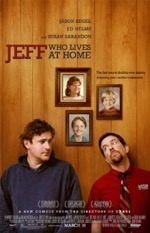
Starring: Jason Segel
March 2012
Jeff Who Lives at Home is a quirky, slice-of-life dramedy that’s carried on the capable shoulders of its stellar cast: Jason Segel, Ed Helms and Susan Sarandon portray the film’s central, dysfunctional family.
Sharon (Sarandon) is a cubicle-bound, middle-aged woman seeking some adventure amid the doldrums of her daily routine. Pat (Helms) is a hardworking stiff who misguidedly thinks that buying a new Porsche will somehow resurrect his floundering marriage. Jeff (Segel) is a superstitious homebody stricken with a lack of ambition and has a bought of agoraphobia. Yes, this is the Jeff referenced in the title, and though his brother and mother figure prominently into the plot, the central through line is Jeff’s meandering journey of self-discovery, which features a character arch that begins with Jeff near-catatonic on a couch and ends with Jeff as a bona fide hero.
The film has a heavy quotation of M. Night Shyamalan’s Signs (2002), which Jeff references on a consistent basis and has based the broad strokes of his life’s philosophy upon. Like in Signs, randomness versus design is an underlying theme in the film; however, more often than not, the movie skews toward the existential. Sometimes the existential drifts toward the improbable, like when Jeff, Pat and Sharon—all in separate vehicles—end up on the same bridge where traffic has halted due to an accident. The improbable sometimes gives way to the nonsensical, like when Jeff helps Pat spy on his cheating wife (Judy Greer) only to see Pat’s new Porsche towed away mid-stakeout.
All in all, Jeff Who Lives at Home is an entertaining indie, whose coincidence-laden, real-time narrative makes it a refreshing zero-to-hero yarn. So here’s to all the Jeff’s in our lives…though they may not contribute anything significant to society, they just might end up becoming the saviors of the world someday.
Rating: 2 1/2
21 Jump Street (R)
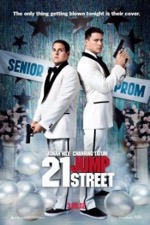
Starring: Jonah Hill
March 2012
Based on the 80s TV series of the same name starring a pre-Captain Jack Sparrow Johnny Depp, the new film version of 21 Jump Street revisits the “undercover cops go back to school to catch a bad guy” premise for the umpteenth time in film history. In the age of remakes, it was just a matter of time before this marginally successful TV property was exploited to its most ridiculous extents on the big screen. Just as nature abhors a vacuum, Hollywood hates leaving any potential revenue stream untapped.
The movie features Jonah Hill and Channing Tatum as two rookie detectives who’ve drawn the short straw and must go back to school; but hey, it actually beats their former assignment—security guards at a public park. The fish-out-of-water role reversal, where Tatum is now a bigot and bully and Hill is the life of the party, is amusing for about five minutes, but this plot device is severely belabored. Other than brief cameos by Depp and his partner, Dustin Nguyen (which is amusing for fans of the original show and confusing for those not familiar with the show), all we’re left with here is a new type of drug that’s running rampant through an inner-city high school and non-stop crass language and sexual (particularly homo-) references to fill out the story.
From the first bawdy joke over two dogs humping in the park to the climactic scene where a handcuffed man tries to retrieve his blown off phallus with his mouth, the movie is an unrelenting deluge of obscenities and indecencies of every variety imaginable…and plenty that were unimaginable before viewing this tawdry affair. The movie frequently crosses the line of bad taste and, as a default, settles for cheap laughs deriving from dunghill humor. But most of the laughing I heard in the theater was of the nervous variety as if those in the audience were looking at each other for approval…a silent “is it okay to laugh at this?” passing between them.
The real loss here is that this could’ve been a decent film had Hill and the other writers chosen a different tack. Hill and Tatum are skilled enough at both comedy and drama that some appropriate blend of the two genres could’ve made for an engaging story with occasional moments of humor punctuating episodes of hard-hitting drama. Just as the actor’s talents were wasted, so was my time and money. And I only paid two bucks…I feel sorry for the saps who paid full price for this morally reprehensible, wholly irredeemable affair.
I could go into more detail concerning the plot, what little of it there is, but I’d just be wasting your time with a potpourri of profanities and inanities. There have only been a handful of movies where, due to the subject matter or inappropriate dialog, I’ve felt like taking a shower after leaving the theater and this was definitely one of them. Clean up your act, Hollywood. Nobody’s laughing.
Rating: 1 1/2
Salmon Fishing in the Yemen (PG-13)
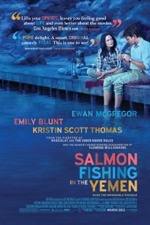
Starring: Ewan McGregor
March 2012
It’s fitting that one of the most unique movie titles in modern cinema also belongs to one of the more refreshingly original films released in recent years. That movie, based on the novel by Paul Torday, is Salmon Fishing in the Yemen. Yes, you read right…fresh water fishing in the middle of a desert. The premise seems utterly outlandish (a fact not lost on Ewan McGregor’s Dr. Alfred Jones, who initially refers to the proposed project as a “bloody joke”), but the story never takes itself too seriously and delivers a charming denouement that’s sure to please the “fairy tale ending” set.
Director Lasse Hallstrom (The Cider House Rules) uses his locations to great effect and appropriately blends traditional shots with stylistic ones (like the extreme high angle vantage of the serpentine reception desk in the office where Emily Blunt’s character works) in order to create the overall impression of a commercial film with mild indie influences. Though the film will be mostly relegated to art house theaters, Salmon Fishing certainly has commercial appeal since its style never upstages the story with excessive or ostentatious artfulness and due to the draw of its big-name stars.
The performances, as would be expected from this cast, are tremendous. Though Kristin Scott Thomas is relegated to a rather small part, she gets some of the best lines/laughs in the movie. McGregor’s seldom been as likable as he is here and the blooming Blunt is disarmingly charming. The fact that McGregor can overcome any moral objections to his character’s extramarital romance with Blunt, to the extent that spectators actually yearn for the couple to get together, is a testament to the acting acumen he now possesses (a padawan he is no longer).
One of the running themes in the film is the case of faith vs. science or random chance. Though it shouldn’t be ironic, the fact that the Arab man preaches faith to the pragmatic Caucasian man is a bit of a twist. If anything, this ancillary storyline exposes the increasingly agnostic worldview being adopted in the West. It also forwards the notion that devotion to a religion need not include the kind of fanaticism that leads adherents to crash jets into skyscrapers. The sheik in the film (Amr Waked) is a genuinely nice guy, and his portrayal goes a long way toward shattering the unhealthy stereotypes that have endured for ages, but were exacerbated by 9/11.
The “love story” here is sweet but is fairly contrived, like the through lines in all romance movies. The chemistry between principle actors is undeniable and there are several sublime moments in the film, like when McGregor names a handcrafted fly (for fishing) after Blunt’s character. However, the “wife and lover meet” passage near the end of the movie degenerates the plot into a glorified soap opera. Fortunately, minimal screen time is dedicated to this love triangle subplot and stasis is soon regained, but not until tragedy befalls the project and hope rises from the ashes…all true love must first be tested in the fiery cauldron of trial and opposition, I suppose.
Salmon Fishing probably won’t set the world (or box office) ablaze, but it’s a nice change of pace film with vivid scenery, sure-footed performances and a one-of-a-kind premise. Unlike the scores of uninspired, unbelievable dramedies being released these days, this is one film you can buy into…hook, line and sinker.
Rating: 3
This Means War (PG-13)
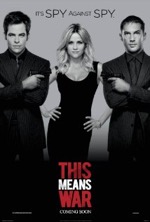
Starring: Reese Witherspoon
February 2012
The love triangle is one of the oldest narrative devices employed in romance movies. Here we have a Mr. and Mrs. Smith (2005) style spy movie where two of the top male operatives at a secret intelligence agency are in love with the same woman. The film’s relational equilateral is composed of some of today’s top talent: Chris Pine, Tom Hardy and Reece Witherspoon.
Once Pine and Hardy discover they’re in love with the same woman, the two men become instant enemies and resort to all manner of covert, underhanded or just plain infantile tactics in order to secure Reece’s affections. For the first ten minutes Pine and Hardy’s often extreme measures to sabotage each other’s chances with Reece are mildly amusing, but at the hour mark, peeling off your fingernails might seem a less painful alternative to enduring even one more minute of the pronounced and protracted silliness that runs rampant throughout the latter stages of the film. In the end, two-timing Reece must choose between her two smooth suitors. Unfortunately, her decision is predictable and stereotypical…somewhere Gloria Steinem is having a conniption.
Beyond all of the well-meaning shenanigans, some of the messages posited by the movie are utterly abhorrent—like everything that spews out of Chelsea Handler’s mouth. Besides setting the feminist movement back a couple decades (Reece is getting older, so she just has to have a man in order to find fulfillment), Reece’s character is so indecisive and so co-dependent that she goes through with Handler’s advice to sleep with both men as a tiebreaker. How in the world can Reece consider this to be good advice? I guess the main criteria for a person’s suitability as a spouse is how well they perform in the sack. Worse yet, one of the men grows a conscience and fails to consummate Reece’s experiment, thereby establishing himself as the more honorable of the two men. So naturally, Reece selects the lothario who seduced her to be her soul mate. We’re way past mild indiscretion at this point…we’re at the serious therapy stage. And the script just passes this off as normal behavior.
Reprehensible actions aside, the supposed twist ending is so contrived it might actually, and ironically, be the funniest part of the film. Though one of the characters is redeemed by way of this gimmicky ending, the denouement is far from satisfactory.
The label “run-of-the-mill rom-com” doesn’t even begin to describe the film, but for all of its inherent idiocy (and inappropriateness), the film is the kind of breezy, bawdy confection that appeals to today’s mass audience. That seems like a perfect impetus to launch into a diatribe about societal ills or ethics in media, but I think I’ll abstain. I wouldn’t want to start a war.
Rating: 2 1/2
Journey 2: The Mysterious Island (PG)
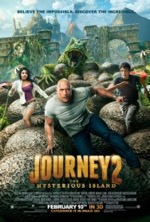
Starring: Josh Hutcherson
February 2012
The follow-up to Brendan Fraser’s Journey to the Center of the Earth (2008), Journey 2: The Mysterious Island extends the franchise which delves into the mythology, creatures and worlds of wonder created by early sci-fi writer Jules Verne. This time around, however, Fraser is out and Dwayne “The Rock” Johnson is in. Josh Hutcherson returns as young adventurer Sean Anderson. Sean’s friction with step-dad Johnson comprises most of the film’s character moments along with the handful of scenes Sean shares with his long-lost grandfather (Michael Caine), his new crush (Vanessa Hudgens) and her father, the skittish pilot (Luis Guzman). Rounding out the cast is Kristin Davis in an itty-bitty bit part as Sean’s mother.
From the title you would assume that the film would be based on Verne’s book of the same name, but you would only be 1/3 accurate. The movie’s narrative is ostensibly based on three literary classics: Verne’s Mysterious Island, Jonathan Swift’s Gulliver’s Travels and Robert Louis Stevenson’s Treasure Island. The common denominator of each tale (besides rip-roaring, old-tyme adventure) is the prominent showcasing of an island as the central locale. Averring that the island in each of these classics is one and the same is a clever and bold conceit, one that keeps the plot wheels steadily churning along through muddy musings and soft-core familial strife in the movie’s early goings.
However, the mash-up premise is quickly jettisoned just about the time Guzman steers his wing-and-a-prayer chopper into, not away from, a violently swirling waterspout. In all fairness, we do get to see a miniature pachyderm a la the Lilliputians as well as Captain Nemo’s Nautilus, but where does the movie borrow from Treasure Island…a gold-spewing volcano? More to the point, what if screenwriters Brian and Mark Gunn (no relation to Ben I’m sure) had capitalized on the original premise by weaving a tapestry rife with allusions and events from the three books instead of merely teasing the concept?
As a quote unquote family film, the movie tries to make object lessons out of wrong choices made by the characters, particularly Guzman’s greedy, gold-luster—he’s drawn to the mountain of gold like a giant bird to a giant bee (oops, one paragraph too early to use that analogy). The story also makes occasional, most often feeble, attempts at foregrounding modern parenting. Guzman wants to send his daughter to college so he goes in search of a bolder-sized gold nugget…with the way inflation is escalating, he might need two. Johnson desperately tires to connect with Hutcherson, but the best advice he can offer the teen is to woo young hotties with Johnson’s patented “pec pop.” Consider this scene the film’s nadir.
The zenith of the film, despite its utter absurdity, is the rapturous flight of the bumblebee’s sequence. The story really takes flight when the adventurers ride giant bees like airborne steeds, and the action kicks into high gear when the bees are stalked by even bigger birds of prey. Honorable mention goes to the sequences involving the sleek (but too small?) Nautilus, although restarting the engines with the charge from an electric eel is a bit farfetched even by this movie’s whimsical standards.
Where the acting is concerned, a more eclectic cast you’re not likely to find and they all turn in serviceable, if not award-winning, performances. Even though all of Johnson’s roles aren’t exactly the same he plays them all as such. On some future film the director will figure out that it’s more cost effective to replace Johnson with a cardboard standup of the actor with looped lines…the result would be no different than his performance here or in any of his other films.
Although the inestimable Caine never misfires, his character, as written, isn’t as enjoyable as would be expected. In fact, it’s hard to remember a Caine character that’s this unlikeable…he needlessly bickers with Johnson’s character and the constant cavalcade of condescension is off-putting. I certainly don’t fault the actor; I fault the Gunn’s for failing to give his character any redeeming characteristics.
In the end, though no better or worse than its predecessor, Journey 2 squandered a golden opportunity to creatively integrate exciting elements from the three literary classics it references into its yarn. Instead, the story defaults to simply serving up a reheated version of last summer’s action flick. Maybe for the next film, the writers can emphasize a solid plot with fleshed-out characters over SFX and action sequences…in other words, the polar opposite of this Journey.
Rating: 2 1/2
The Big Year (PG)

Starring: Owen Wilson
October 2011
TAKING AIM:
The comedic dream team of Owen Wilson, Jack Black and Steve Martin star in an offbeat dramedy that manages to be all about birds without being for the birds.
TARGET PRACTICE:
Filmic Antecedent: Twister (1996) gave us a glimpse into the lives of extreme hobbyists known as storm chasers (there’s even a reality TV series based on this thrill seeking subculture). While the enthusiasts in The Big Year don’t face the same kinds of imminent dangers while engaging in their hobby, their furor, devotion and blatant disregard for anyone who doesn’t share the same passion is just as intense as those tornado tailgaters in Twister. The fanatics in this film are called “birders,” not bird watchers, which anyone can be by looking out their window. Birders travel far and wide to find rare and exotic birds and some can identify a bird by its chirp or warble (others can even approximate such sounds with their vocal cords and throat…weird).
Martin is Masterful: This isn’t the first time Steve Martin has teamed up with two other film funny-men (Chevy Chase and Martin Short in 1986’s ¡Three Amigos!, for instance), but his compadres in this film (Wilson and Black) are significantly younger than him. Even though Black’s character narrates the movie and Wilson serves as a pseudo-antagonist, it’s Martin who emotionally anchors the film. We feel pathos for Martin’s character when he tosses his cookies on a boat or when he misses a plane that costs him a trip to Attu, Alaska—a hotspot for birding in May. We can’t help but chuckle when Martin initiates his patented victory jig. But most of all, we can only try to fight back tears when Martin whispers his first words to his newborn grandson. It’s moments like this that ground the movie and prevent it from degenerating into an off-kilter buddy movie centered on a fringe pastime.
Winners and Losers: Of course, Wilson and Black aren’t chopped liver. Black is charming as the unlucky-at-love everyman with daddy issues and Wilson is the most disarmingly likable antagonist to come along in recent film history. One of the prevalent themes in the film is sacrifice—what are these characters willing to give up in the pursuit of their goals/hobbies/dreams? By the end of the movie, each of the main characters looses in one area of his life but also wins in another; such tradeoffs are an accurate depiction of real life. It’s a credit to Howard Franklin’s screen adaptation of Mark Obmascik’s book that the resolution holds some surprises for the viewer: who wins and who looses what might not be exactly what you’d expect.
Semiotics Playground: Part of the enjoyment in watching buddy films, especially if some type of journey is involved, is tracking the progress of the characters throughout the course of the film. Here, checkpoints of different stages of the characters’ “big year” are demarcated with a variety of graphics and other visual cues. In film studies, semiotics is a theory that deals with signs and symbols in movies. In many instances a film’s deeper meaning can be gleaned from its patterns/textures, lighting/shading, camera position/angle/movement and, indeed, physical signs. Here, geographical maps of various stops on their journey are superimposed over live action shots of the characters, a la the Indiana Jones series. A similar effect shows handwritten text over the Alaskan countryside, designating the exact spot where a particular bird has been spotted. Text markers appear at random intervals in the movie and represent specific locations or points in time. Most visually innovative is the film’s use of overhead counters to indicate the current number of birds each character has spotted—the graphic is especially effective when all three characters spot the same bird at the same time.
PARTING SHOTS:
In the final analysis, those expecting to see these A-list comedians in an all-out goof fest are sure to be disappointed with The Big Year, which breaks down at roughly 90% drama and 10% comedy. Still, this is one of the most original movies to have come along in quite some time, and so much the better since it offers an educational component to its often single-minded, straightforward narrative. The film definitely isn’t earth-shattering, but it offers a few humorous and touching moments that make it a worthwhile entertainment. Sometimes it’s just nice to see something fresh, however unusual. The Big Year is both…highly recommended.
Rating: 3
Cars 2 (G)
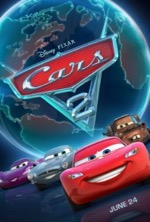
Starring: Owen Wilson
June 2011
Celebrating 25 years of animation excellence, Pixar Studios has never released a dud—a truly astounding achievement. In fact, the closest they’ve ever come to producing a flop was the commercially successful but critically tepid Cars (2005). So then, why would the studio green-light a sequel to the worst received film in its catalog rather than its most successful—you know, the one with the clown fish?
The easy answer is marketing—Cars merchandise is everywhere…on clothing and pillow cases, on cracker boxes and soup labels and especially on shelves in the toy aisle. Cars paraphernalia is ubiquitous and the drop in sales since the first film exited theaters is negligible to the point of imperceptibility. Sad to say, but as long as the marketing machine is at full throttle, even mediocre box office returns from any future sequels will still be considered a success.
So with nothing to loose and bank to make, Lasseter and Co. have reunited us with Lightning McQueen (Owen Wilson) and Mater (Larry the Cable Guy) and a host of new and returning characters (all of which, you can bet, will have at least one toy car manufactured in their likeness) in Cars 2. Leaving behind the cozy confines of Radiator Springs, the story soon takes us on a globetrotting adventure that’s part racing film and part Bond-esque spy thriller where Mater is mistaken for an undercover agent (huh?). The action kicks into high gear when the characters are whisked away on a foreign tour for the World Grand Prix.
The film’s premise seems like a sure-fire winner, but large sections of the film just feel off—like the timing of a car in desperate need of a tune-up. One key contributor to this cinematic vapor lock is the inner-cutting between the race and espionage subplot. The actual race is upstaged and overshadowed by the international intrigue for most of the film, making it difficult to actually enjoy or even care about the race itself, which becomes ancillary to the spy action sequences. This narrative tug o’ war is tiring and jarring. Further, McQueen plays second horn to Mater for most of the movie (notice that Larry has top billing over Owen in the end credits).
The espionage plot itself is intended as a nod to the James Bond and Mission: Impossible franchises, but unwittingly degenerates into a derivative spoof. Michael Caine is predictably masterful as mega-spy Finn McMissile and probably should’ve had his own film. In the same way that the spy plot dominates the racing plot, McMissile is more of a hero in the film than McQueen. Has the “Mc” mantle been passed on for the next, inevitable sequel?
The movie’s commentary on oil vs. a fuel alternative (Allinol) is by turns heavy-handed and OPEC, I mean opaque, and ultimately fails to say anything meaningful on the subject. Monsters Inc. subtly addressed the energy crisis of the early 2000s while WALL-E harrowingly forecasted the dangers of consumerism run amok. By contrast, Cars 2 breaches the topic of our dependency on fossil fuels and then quickly abandons it, hit-and-run style.
Equally irritating is the film’s vacillation with respect to lemon cars—one minute we’re supposed to pity them, like Mater’s rust bucket fan, Otis, and the next we’re supposed to despise them, like the nefarious henchmen who “kill” cars because they’re rich and famous. Even when confronted with the error of their ways, the Lemon Mafia refuses to change, much to their demise. Unrepentant evil is pretty rare in Pixar movies (Syndrome is one notable exception), and sets a poor example and precedent, especially since the plight of lemon cars could’ve set up a heartfelt moral—you know, the kind Pixar normally capitalizes on for maximum emotional effect. The only meaningful moment here is the analogy between dents and momentous events of the past, a very understated theme that Lasseter should’ve gotten more dramatic mileage out of.
So, has Cars 2 broken Pixar’s perfect track record? Opinions will vary, but there can be no doubt that if fails to measure up to the studio’s stellar back catalog. The movie mishandles nearly every narrative turn and takes the original conceit of talking cars (and now ships, jets, trains, etc) to absurd extents. As such, the film has effectively scrapped credibility while abandoning the heartwarming character moments that aided in our suspension of disbelief during the first outing.
In one of the movie’s rare racing scenes, McQueen moves outside and allows chief rival Francesco Bernoulli to take the inside track to victory. In the same way, Cars 2 has pulled over onto the shoulder, allowing any other decent animated film the chance to play spoiler in this year’s race for the Best Animated Feature Oscar. There’s always the Piston Cup as a consolation prize, I suppose. As painful as it is to admit, Pixar has fallen off the pace.
Rating: 2
Kung Fu Panda 2 (PG)

Starring: Jack Black
May 2011
TAKING AIM:
Black is back as panda Po, but does the sequel have the same disarming charm or killer action sequences as the original?
TARGET PRACTICE:
All-Star Cast: Voice talents abound in the Panda sequel. Notable returning characters are: Po (Jack Black), Tigress (Angelina Jolie), Shifu (Dustin Hoffman), Monkey (Jackie Chan), Mantis (Seth Rogen), Viper (Lucy Liu), Crane (David Cross) and Mr. Ping (James Hong). New characters include: Shen (Gary Oldman), Soothsayer (Michelle Yeoh), Wolf Boss (Danny McBride), Master Ox (Dennis Haysbert), Master Croc (Jean-Claude Van Damme) and Master Rhino (Victor Garber).
Family Matters: The narrated prologue sets up one of the movie’s major plots…the mystery surrounding the fate of Po’s parents. Midway through the film, Po confesses to Tigress his surprise over discovering that his father, a goose, isn’t his “real” father. The hilarity of the scene soon turns to a serious, heart-rending plea to know “Who am I?” Po gradually learns the answer to his question during intermittent flashbacks throughout the movie and during the climactic confrontation with the new villain.
Artful Art: Speaking of the flashback sequences, the use of various animation styles makes for a very effective means of storytelling. The opening sequence, which tells the back story of how peacock Shen turns bad, is a superbly crafted teaser that’s animated in the style of a Chinese shadow puppet show. That style is repeated later in the film, but most of the remaining flashback scenes employ traditional animation and one flashback is rendered in CGI.
Irrational Fears: One of the movie’s plot elements involves the impending demise of kung fu at the hands of a new mystery weapon. We’ve seen this scenario played out many, many times in cinema history, ranging from the emergence of the Gatling gun threatening to put gunfighters out of business in John Wayne’s The War Wagon (1967) to the very same weapon making swords, guns and martial arts obsolete in Shanghai Knights (2003) and putting samurai warriors out of business in The Last Samurai (2003). What makes this fear an irrational one, and therefore a flawed plot device, is that kung fu, as a mode of hand-to-hand combat, serves an entirely different function than that of a weapon of mass destruction. In other words, someone with no fighting skills can wreak havoc by pulling a trigger, but that same person would get his butt kicked by someone trained in physical combat. Therefore, a WMD threatening a form of martial arts is a wholly fallacious premise.
Inner Peace: Po, who tends to be uncoordinated, unfocused and undisciplined, is given a new challenge this outing, finding inner peace amid the swirling maelstrom of random thoughts and nagging questions in his mind. Master Shifu, the series’ version of Yoda or Miyagi, appears just long enough to give Po his assignment but, disappointingly, doesn’t really factor into the story except for a deus ex machina appearance during the climactic melee. Though this theme is a bit force-fed, inner peace ties in nicely with Po’s struggle to learn his true identity and is also critical in Po’s efforts to turn the tide against the advancing evil at movie’s end.
PARTING SHOTS:
So is the sequel as good as the original? Not quite. The Panda sequel only possesses half the charm and half the heart as the original. Other than panda protagonist and peacock antagonist, none of the other critters get much character development, if any at all. Oh, and speaking of the villain…a peacock? Really? Wouldn’t it have made more sense to make the one-eyed wolf the villain? Just saying. The action sequences are well-executed, but offer little innovation from the dynamic fight scenes featured in the first film. Still, some things do work well in the sequel, like the humorous “stealth mode” and “dragon costume” sequences, the heart-warming scenes between Po and his adopted father and Po’s refusal to allow his painful past to dictate his present and future. So, will we see Po and co. again in the near future? The movie’s clever coda should leave no doubt.
Rating: 2 1/2
Rango (PG)
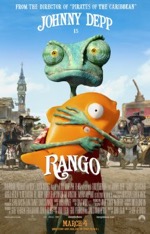
Starring: Johnny Depp
March 2011
With the creative vision of director Gore Verbinski (The Pirates of the Caribbean: The Curse of the Black Pearl) and the hard-hitting prose of screenwriter John Logan (Gladiator), you’d expect a stylish, edgy and pulse-pounding adventure for Nickelodeon’s new animated foray into the Old West, Rango. As is the case with many movies these days, what looks good on paper doesn’t always translate successfully onscreen. Even though Rango is far from being a bomb it doesn’t exactly hit the target either. It’s diverting without necessarily being inspiring or entertaining.
Everything is going swimmingly for the titular chameleon (voiced by Johnny Depp), who’s enjoying some RNR in the back of his owner’s car. As fate would have it, Rango’s glass habitat slips though a car window and he soon finds himself alone and lost in the middle of a desert. As a pampered house pet, Rango must now learn how to survive in the wild with very few life skills to draw upon.
This setup is similar to the opening act of Pixar’s Cars, when hotshot race car Lightning McQueen (Owen Wilson) wakes up in the middle of the desert and stumbles into sleepy burg, Radiator Springs. Here, Rango ends up in the Wild West town of Dirt, and it just so happens that the citizens are looking for a new sheriff. Hesitant at first, Rango eventually accedes to the demands of the townsfolk when the chance to be a hero becomes too great an enticement to resist.
Although Rango is a pastiche of many different films, it has a heavy quotation of Chinatown, which becomes blatantly obvious from the midway point on through to movie’s contrived resolution. At the very least, Logan should’ve selected some other element than water to have a shortage of since H2O was such a central commodity in Roman Polanski’s landmark film. In addition to being a Chinatown retread, the movie also features characters from other movies, like the off kilter cameo of a rugged figure called the Spirit of the West (voiced by Timothy Olyphant), a clear-cut analog of Clint Eastwood’s “Man With No Name” from the Sergio Leone’s spaghetti western trilogy. The spirit of Eastwood gives the chameleon hero some words of advice while sweeping the desert floor with a metal detector. It’s a strange flourish that one would expect to see in a movie helmed by Depp’s other director friend, Tim Burton.
Despite it’s best efforts at being topical, by tapping into recession fears, Rango falls short of being relevant due to the story’s pervasive silliness. Still, there are some mildly amusing scenes and a few creative embellishments, like the rattlesnake with a semi-automatic gun in its tail, that make the movie a worthwhile entertainment. The movie’s underlying message, that anyone can be a hero if they try hard enough, is a bit overdetermined, but is heartwarming just the same. After all, don’t we all secretly wish we could be a hero?
Rating: 2 1/2
Marley & Me (PG)

Starring: Owen Wilson
December 2008
“Heartwarming, Tear-jerking Dramedy is a Doggone Good Time”
John Grogan (Owen Wilson) is wading through the deep stuff. His wife, Jenny (Jennifer Aniston) wants to have a baby. John turns to his friend, Sebastian (Eric Dane), for advice and is told that the best way to slow down Jenny's biological clock is to sidetrack her with a puppy.
For her birthday, John buys Jenny a puppy...the cheapest of the litter, which should automatically raise a caution flag in one's mind. Of course, as the story would require, the little mutt grows at an alarming rate and soon takes to ransacking the Grogan house and generally making its owners’ lives a living nightmare. And of course, it's not too long before Jenny gets pregnant, leaving John to wonder where his well-calculated plan went so awry.
Marley & Me, based on the experiences of the real-life Grogan family, is fairly believable, but there are a few moments of hyper-reality. Thankfully, these requisite mishaps involving the calamitous canine don't degenerate into the kind of improbable silliness that reigned supreme in the Beethoven movies. Such paint-spilling, car-denting, villain-foiling antics would have killed this movie as sure as rabies killed Old Yeller.
There can be no doubt that the star of the movie is the dog; however, the human performances aren't anything to howl at, especially the leads. It's no secret that Jennifer Aniston is a capable actress; since her days on Friends, Aniston has made a respectable career out of mostly comedic, sometimes-dramatic movies as the leading lady in mostly successful films. The big shocker here is Owen Wilson's multi-faceted performance...perhaps the first for the towheaded funny-man. I think it's safe to say that Wilson has graduated before our very eyes, playing a man who's desperately trying to balance the rigors of family life with his career, all while maintaining a good sense of humor and positive outlook on life. Wilson probably won't be hefting an Oscar any time soon, but he actually shows some range here, which is a refreshing change from his patented, daffy shtick. Apparently he can be serious. Who knew?
Alan Arkin, in yet another Oscar-worthy supporting performance, mesmerizes as John's unflappable, unemotional editor. Much like Tommy Lee Jones' Marshal Gerard in The Fugitive (1993), Arkin feigns an uncaring attitude, but is deeply concerned with the lives of those around him. If ever discovered to have a heart, Arkin’s editor would surely echo Gerard’s image-preserving request at the end of The Fugitive, "Don't tell anybody, OK?"
It's contestable whether or not Marley & Me is a family film. Certain situations and some language would probably be enough for concerned parents to keep their kids away from seeing the film. Then there's the ending. Some—anticipating a happy ending—will be broadsided by the movie's tragic climax. If your children bawled for a week after viewing Old Yeller (1957), you might consider leaving the kids home and reserving Marley & Me for a date night. Truth be told, it’s more of a date movie than a family film anyway, so word to the wise.
Though shamelessly sentimental in spots, Marley & Me is as heartwarming as they come…a popcorn movie in the truest sense. With ticket prices skyrocketing, it’s satisfying when you actually get your money’s worth at the Cineplex and the Wilson/Aniston vehicle is worth every penny. Cute, cuddly and crowd-pleasing, Marley & Me is an early Christmas present that will give you all the warm fuzzies of actually owning a dog without having to clean up the mess!
Rating: 3
The Ugly Truth (R)

Starring: Katherine Heigl
July 2009
“There is Some Truth in This Rote Rom-Com”
Warning: I feel compelled to steer those who might be offended by this film in a different direction. In the guise of a harmless romantic comedy, this film contains brief nudity, pervasive expletives and an abundance of graphic sexual references. You’ve been sufficiently forewarned.
Some time ago, probably with the release of Steve Carell’s 40-Year-Old Virgin (2005), romantic comedies took a sharp turn and started becoming, if not more sophisticated, more adult in their content. Many of these edgier relational comedies have, appropriately, receiving R ratings and have largely replaced their tamer PG and PG-13 counterparts released before the millennial mark. Although just as coarse as many of its forebears, The Ugly Truth, starring Katherine Heigl and Gerard Butler, has refined the nascent sub-genre of mature rom-coms into brutally honest, relationally challenging fare.
The story begins with a disgruntled news producer, Abby (Heigl), calling into Mike Chadwick’s (Butler) no-holds-barred local access show, which shares its name with the movie’s title. After a spirited debate over Stairmasters and masturbation, Mike drops Abby’s call. As fate would have it, the network hires Mike to add some spice to Abby’s flagging morning newscast…a Hail Mary to boost ratings enough to stay on the air. Abby is forced to work with Mike and, despite the adversarial energy they bring to the set, the ratings immediately skyrocket…proving yet again that sex sells. It’s a foregone conclusion that Abby and Mike will fall in love, but not before the required series of hilarious mishaps and cagey catfights, which comprise the bulk of the story, have had a chance to unfold in the most obvious and pedantic manner imaginable.
As was alluded to in my introductory warning, the subject matter and sexual references in The Ugly Truth are extremely crude and graphic, to the extent that they might even make a sex therapist blush. A cross between Howard Stern and Jim Cramer, Mike’s show gives garden-variety crassness a bad name…and yet, beyond the outrageously salacious remarks, there is some veracity in what he’s saying, both regarding the eternal battle of sexes and how both genders view the physical, psychological and emotional aspects of sex. This educational component is the saving grace of a film that otherwise would’ve ended up as this year’s 27 Dresses.
Despite its hokey romance (the dialog during the hot air balloon sequence is particularly hackneyed), the movie, by design or happy accident, has tapped into a universal quandary by attempting to answer questions regarding that most mysterious and pleasurable of human experiences. Couching such a serious subject in a seemingly innocuous rom-com allowed the writers (three of them…all female) to broach this touchy topic in a way that’s charming and disarming rather than embarrassing or off-putting. Also, by relegating the bulk of the movie’s graphic sex talk to Mike’s cable show or news segment, a buffer is added between the explicit subject and the real audience, which should make it even easier to open a dialog on the subject in hand…er, at hand.
However, for all of its in-your-face sex education, when the movie ends none of us are any closer to understanding the vagaries and exigencies of human sexuality than when the film began (except for those two teenagers making out in the back row of the theater—hand check!), but I guess that’s really the point. No one, not even Dr. Ruth or Dr. Kinsey, has fully plumbed the depths of the sexual experience. Despite what’s claimed in books or boasted about in high school locker rooms, no one has mastered the art of sex. In fact, those who brag most about their exploits in the bedroom are usually the ones who have absolutely no idea what they’re doing. And that’s the ugly truth!
Rating: 3
The Proposal (PG-13)

Starring: Sandra Bullock
June 2009
“Jilts Its Audience with Standard Rom-com Shtick”
The Proposal, starring Sandra Bullock and Ryan Reynolds, is about two people who despise each other but eventually fall madly in love. We’ve seen this scenario a kajillion times before and have suffered through each permutation of the threadbare rom-com yarn with low interest and high anxiety to exit the theater as quickly as possible.
Director Anne Fletcher must’ve thought she’d struck gold in this new take on the ages-old form, if only because of the story’s exotic locale…Alaska. But, whereas location is everything in real estate, it can only take a movie so far, especially if it’s accompanied by a mediocre narrative. Sadly, we don’t get to see much of the Alaskan countryside in the film and when we do it’s either shoddily projected onto a green screen behind Reynolds or unimaginatively framed by Fletcher and her cinematographer. A few eagles factor into the story, but that’s the extent of the wildlife displayed in the movie—no bears and no moose…just Betty White in native Alaskan garb, dancing around a fire and chanting a string of vowels while worshiping Mother Earth. Guess that explains why there aren’t any animals in the movie.
The movie’s premise revolves around Bullock’s bulldog book editor Margaret Tate, who’s facing deportation to her home country, Canada…eh! In an act of desperation, Margaret grabs her assistant, Andrew Paxton (Reynolds), and convinces her boss and an immigration agent that she and Andrew are engaged—much to Andrew’s utter shock and revulsion. Andrew refuses to go along with the elaborate charade until Margaret promises him a promotion. The rest of the movie plays out like Meet the Parents in Alaska, with only a quarter of the silly mishaps and less than half the charm.
Bullock tries her hardest to invoke Meryl Streep’s Miranda Priestly from The Devil Wears Prada, but fails miserably, despite being called “it” or “witch” by her tweeting employees. However, though brusque and business minded, Margaret doesn’t resemble the harsh image painted by her skittish underlings. From a narrative perspective, it’s important that Margaret not be portrayed as too harsh because she has to be likable enough for audiences to cheer her on later in the story.
Andrew is a talented writer with aspirations of becoming editor, but he doesn’t know how to stand up for himself or stand up to Margaret and her frequently unreasonable demands. Andrew, on rare occasions, shows some chutzpah, but is ridiculously compliant for most of the movie. Ironically, as hard as it is for Andrew to say no to Margaret, he has no problem rejecting his father’s (Craig T. Nelson) continued pleas to come home and take over the family business. A puzzling inconsistency.
The film is buttressed by some decent supporting acting by Andrew’s parents (Nelson and Mary Steenburgen) and grandmother (White), but there’s nothing Oscar-worthy here. Ramone (Oscar Nunez), the town’s jack-of-all-trades—he’s a porter, grocer, adult entertainer and minister—provides some comic relief, but is actually more creepy than funny (the Chippendales striptease scene is one of the most disturbing sequences I’ve seen in a recent film and will surely be a turnoff for men and women of all persuasions). Ramone has several of the more amusing lines in the movie, but, like a cheap watch, his timing is always just a little off. The feeble chuckles generated during the faux outtakes at movie’s end are like the courtesy laughs you’d pay one of your grandfather’s corny jokes.
Though I must admit that The Proposal doesn’t have as many goofy gags as the typical comedy film, coaxed laughter is still the movie’s MO. Standard comedic gags, i.e., something tragic happens to a pet (here, an eagle carries off the family dog), a man accidentally knocks a woman overboard and one character schemes to get feuding lovers back together again (in this case White’s meddling grandmother fakes a heart attack so that the emergency helicopter can take them to the airport before Margaret flies back to the “Lower 48”), permeate the film. The promising premise laid out in the early stages of the film quickly devolves into a series of rom-com conventions, most significantly the “two people who weren’t meant to fall in love that miraculously do” plot device.
Besides the woefully underachieving story, the casting of the leads is the most ironic aspect of the movie. Bullock and Reynolds have very little chemistry as a romantic couple, which actually works well when they bicker and backstab their way through their fabricated relationship. When they finally realize that they really do love each other (something we’ve known all along), their lack of chemistry makes the contrived ending that much more improbable.
The series of ending “twists” are so predictable as to be embarrassing, and writer Pete Chiarelli consistently defaults to convenient solutions instead of more complex or, dare I say, realistic resolutions. Though I applaud the movie for largely eschewing the screwball moments that epitomize the vast majority of modern movies in this genre, The Proposal isn’t nearly as funny as you’d expect, making it an affair to forget. If someone invites you to see The Proposal, my advice would be the same as if they were offering you an illegal substance…just say no!
Rating: 2
Night at the Museum: Battle of the Smithsonian (PG)

Starring: Ben Stiller
May 2009
“Silly Sequel to Amusing Original Fails to Take Flight”
In the original series Star Trek episode “A Piece of the Action,” the natural evolution of a race is tampered with when a space vessel crash lands on a planet where the imitative populace bases their society on a book they find in the wreckage. By the end of the episode, Captain Kirk and crew set the alien civilization back on a healthy course, but Dr. McCoy accidentally leaves behind his communicator, which will be pulled apart by the inquisitive species and will most likely produce a premature technological leap…and thus the cultural contamination is further perpetuated.
A strange way to start a review of the second Night at the Museum movie, entitled Battle for the Smithsonian, right? Not at all. An ancillary subplot in the film involves the former museum security guard and now ostensibly successful inventor, Larry Daley (Ben Stiller) accidentally leaving his cell phone in a ticker tape, Times Square celebration post-WWII, via a living picture, which serves as a portal to the past. Unfortunately, this minor, yet significant, plot element is never resolved by movie’s end. What were the writers hoping to accomplish with this dangling plot thread? A sequel perhaps? Like the mechanical arm left behind in Terminator II which just begged another, though long delayed, film? Regrettably, the most interesting and promising aspect of the Museum sequel is this misplaced cell phone and not the many artifacts, antiquities, animals and historical figures that come to life after dark in the New York Museum of Natural History and now the Smithsonian Institution.
As for the museum denizens, many of the side characters have returned from the first film, including: Owen Wilson’s Jedediah, Robin William’s Teddy Roosevelt, Steve Coogan’s Octavius and Mizuo Peck’s Sacajawea. Some notorious or nefarious characters have joined the museum mishmash, including: evil Pharaoh Kahmunrah (Hank Azaria), Napoleon Bonaparte (Alain Chabat), Ivan the Terrible (Christopher Guest) and Al Capone (Jon Bernthal). The finest new addition to the cast is Amy Adams as Amelia Earhart. Her pluck, charm and tenacity in the face of danger are infectious; Adam’s portrayal of this icon of American aviation is the only element that lifts the leaden plot off the tarmac. And the formfitting flight pants certainly don’t detract from her character’s overall appeal.
The movie’s MacGuffin that everyone wants to get their hands on is the Tablet of Ahkmenrah, a powerful artifact that allows the museum’s exhibits to come to life after-hours. Kahmunrah and his minions vie with Alexander and Ivan for possession of the tablet, but before long a new group is added to the mix…mobsters from the early 20th century (in one of the movie’s only clever moves, Capone and his cronies appear in black and white). The climactic confrontation takes place in the aviation wing of the museum and you just know Earhart’s piloting abilities will be called upon to save the day. A plot device doesn’t come any more telegraphed than this.
As with the first film, the rampant and widespread destruction of the museum must be resolved and rectified by dawn’s early light so that staff and patrons will have no idea that such calamitous events have transpired inside the exhibits overnight. It’s a similar plot device to the one used in Pixar’s Toy Story films where the animated toys can have all manner of adventures while people aren’t looking, but must return to their previous spots and act dead when humans come into the room. It sure eradicates a lot of the suspense when the audience knows that no matter what happens—even if a bomb is dropped on the museum!—everything will be back to normal in the morning. In that sense, nothing ever really happens in these Museum movies since the majority of the plot and all of the action is wiped out by a narrative reset button. Sure, the audience remembers what happened, but is any of it really worth remembering?
So, will there be a third film or will Museum become an extinct franchise? Who knows, just like Back to the Future II had its Café 80s, maybe someday in the distant future we’ll have a Night at the Museum museum.
Rating: 1 1/2
The Tale of Despereaux (G)

Starring: Matthew Broderick
December 2008
“Non-Pixar Animated Flick Has Lots of Heart but Little Magic”
If they had extreme sports for mice, giant-eared Despereaux would own every record. Despereaux leaps through the air and steals a piece of cheese from a mouse trap without even breaking a sweat. His friends watch in amazement. None of them would ever attempt such a circus act…not even for fresh cheese.
Despereaux fails to cower when his teacher shows him a picture of a cat. To make matters worse, he doesn’t recoil when he’s shown a picture of a needle. Filled with amazement, Despereaux reverently asks, “Is that a sword?” Despereaux’s teacher calls an emergency conference with his parents; something has to be done about the misfit mouse. Like many of us, Despereaux just isn’t quite normal.
Based on the Newbery Award-winning children’s book of the same name by Kate DiCamillo, The Tale of Despereaux, judging from its marketing campaign, seemed poised to be the family film of the holiday season. Armed with a built-in audience, one of the most adorable animated creatures to grace the big screen in years and a fairytale story brimming with adventure and romance, it’s inconceivable that such a sure-fire crowd-pleaser could be a disappointment. And yet it is.
So what went wrong with Despereaux? Was it the selection of vocal talent? Definitely not! The movie boasts an impressive array of A-list luminaries, all of whom perfectly match the character they’re voicing. If you want to make great soup you need the right ingredients and any producer would kill to have names like Matthew Broderick, Dustin Hoffman, Emma Watson, Tracey Ullman, Kevin Klein, William H. Macy, Stanley Tucci, Ciaran Hinds, Robbie Coltrane, Frank Langella, Christopher Lloyd and Sigourney Weaver stirred into their story stock.
Was it the animation? Doubtful. Although the film’s palette and aesthetic is measurably more earth-tone and moderate than most animated forays these days, Despereaux is beautifully drawn; one of the movie’s greatest advantages is that it doesn’t try to emulate Pixar’s plush look. My only gripes with the animation are that the humans look like they’ve had their heads pinched in a vise and that the underground scenes are far too drab, especially for the impressionable kiddies in the audience.
Was it the story? Most likely. Will McRobb’s adaptation of DiCamillo’s story, though ambitious, resembles a ball of yarn that’s been pawed at and kicked around the room all day; you can discern the story’s overall core, but many plot strings lay strewn over the surface of the patchwork plot. The first major problem with the story is its perpetual POV shift between Despereaux (Broderick), rat-looking mouse Roscuro (Hoffman), Princess Pea (Watson) and the plump maid, Miggery Sow (Ullman). As the story bounces back and forth, it’s easy to loose the through line and difficult to discern an overarching theme or moral. Even though all of the plot threads eventually join to form a taut braid by the end, the main story—the tale of Dexperaux—is often subordinated by the movie’s riveting (Roscuro’s desperate attempts to break away from a hoard of nefarious rats), terrifying (the princess is kidnapped by the same rodent throng) and heartwarming (Miggery and her long-lost father are reunited) subplots.
The biggest narrative failing is the persistent, heavy-handed narration that not only spells out everything in the story, but also tells us how we should feel about it. Sigourney Weaver’s melodious intonations fit well with the movie’s storybook mood, but the narrated segments impede the flow of the story; serving, in essence, as filmic speed bumps. The movie’s slow pacing is directly attributable to its excessive exposition, which comes from the desire to be as faithful to the source material as possible; an honorable intention yet detrimental inhibition where the plot is concerned.
In the final analysis, the movie’s mixed results simply may be due to the fact that it wasn’t made by Pixar. However unfair that statement may be, The Tale of Despereaux is still an above average animated tale; and at the end of the day, most kids won’t discriminate too much over which studio produced it. The movie deals with many themes such as standing up to evil, breaking the chains of hurt and extending forgiveness to others, but it doesn’t possess that one crystal-clear concept that drives home a movie’s message. Such streamlined storytelling catapulted each of the Pixar films into the A tier of animated films. Despereaux will have to settle for B tier status, but there are much worse fates…it might not be WALL-E, but at least it isn’t Fly Me to the Moon.
Rating: 2 1/2
Mamma Mia! (PG-13)
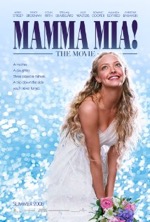
Starring: Meryl Streep
July 2008
“Thank You for the Music, But What About the Story?”
Having never seen the theatrical version of Mama Mia! I didn’t know what to expect from the new film version, other than I was going to see a musical. And a musical it is; songs permeate and dominate all but about fifteen minutes of the film, so if you’re not a person who enjoys musical movies this definitely isn’t for you. As an unrepentant Chick Flick and an uninhibited musical, the film is clearly marketed toward the female set, so most men (those dragged kicking and screaming into the theater by their female companions) will have a hard time swallowing or following the movie’s song-a-minute storyline.
The movie’s slogan is: “A Mother. A Daughter. Three Possible Fathers.” Believe it or not, that’s about all there is to the plot. The vast majority of the story is told via nineteen songs from ABBA’s catalog—some bouncy, some groovy—which are sung by the stars along with a host of extras performing over-the-top choreography and wearing Juicy Fruit smiles. Of course, after about the fourth or fifth musical number all of the songs start sounding like a broken record…er 8-track, and while I applaud the film’s use of the actors’ actual singing voices, some of the solo work is flower-wilting bad. Besides the movie’s overabundance of musical numbers, the biggest disappointment is the utter absence of character moments. However, the acting, directing, music, choreography and technical elements make up for any lack in the story department, and the on location filming on an idyllic Grecian island is a significant factor in the film’s overall mood and aesthetic.
The movie’s casting was spot-on and veterans Meryl Streep, Pierce Brosnan, Colin Firth, Stellan Skarsgard and Christine Baranski, along with newcomer Amanda Seyfried, deliver delightful performances. Streep is her usual stellar self as mamma-with-a-past Donna, but it’s Seyfried as Donna’s debutante daughter, Sophie, who steals the show with her zest for life and inextinguishable desire to discover her dad. In a strange case of role reversal, Sophie provides maturity, responsibility and just good common sense to balance out her flighty, wild and emotionally needy mother. Though the movie stays on the periphery of meaningful issues like empty-nest syndrome, regret over lost love and paternal responsibility, it wastes much of its efforts on bawdy jokes and obscene gestures; most of them perpetrated by Donna and her lusty gal-pals.
Mamma Mia! is a light, breezy jukebox musical that fulfills its promise to be a two hour dance party and is the feel-good movie of the summer. It’s a story about young love and rekindled love; in fact, it’s all about love. How fitting that, despite its vacant narrative, Mamma Mia! is a movie you can’t help but love.
Rating: 2 1/2
Get Smart (PG-13)
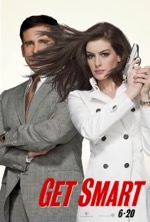
Starring: Steve Carell
June 2008
“Slapstick Comedy Missed It by That Much”
Based on the 60’s TV series, which portrayed the Cold War in a humorous light, Get Smart stars Steve Carell (who else?) as Agent 86, aka Maxwell Smart. Though not nearly as inept as The Pink Panther’s Jacques Clouseau, Smart is still a far cry from James Bond—his last name remains a bit of an oxymoron.
Agent 13 (Bill Murray) is a lonely, middle-aged man who stands watch inside a hollowed-out tree all day. Agent 23, a cocky ladies man, is played to the hilt by Dwayne “The Rock” Johnson. Agent 99 (a glacial Anne Hathaway) figures into the movie more prominently than the lower numbered agents as the no-nonsense, by-the-book veteran assigned to work side-by-side with the newly commissioned Agent 86. (Agent 99 has seniority over Agent 86, so apparently the numbering is arbitrary.)
The delightfully witty repartee between Agents 86 and 99 is one of the film’s most enjoyable aspects. Despite Agent 99’s stolid fussiness, she and Max are strangely compatible, something he readily admits and she flatly denies. The friction is palpable, and as we all know, friction causes heat.
Excellent supporting performances are turned in by several screen veterans, including: Terence Stamp, who plays the coldblooded Russian heavy, Alan Arkin, as the leader of the good guy spies and James Caan, who plays the US President.
Earlier I referenced the disparity between Clouseau and Bond and that Smart lands somewhere in between the two European spies on the competency scale. My greatest struggle with the film is that Smart lives up to his name is some areas and proves his overwhelming stupidity in others. My advice: either be competent (Bond) or incompetent (Clouseau), but not hit-or-miss. Otherwise, it’s just downright annoying.
Maxwell Smart was undeniably the right (anti-)hero for the Cold War period, but we’re in a new millennium. Iron Man has proven to be the right hero for our terror-ridden times. Placing these heroes side by side makes Smart seem embarrassingly passé.
Get Smart is exactly what you’d expect it to be, and I guess that’s what’s most infuriating about the film. Had the movie attempted to modernize Smart and company, the results might have been more cutting edge. Instead, it’s just a silly retread of the silly TV show. Like so many other recent TV-to-theater flicks, Get Smart is hedging on brand recognition and nostalgia to sell tickets. Playing it safe seldom produces innovation, so I guess we’ll settle for medium-well box office and a mediocre storyline.
Even still, Get Smart is one of the better TV-to-big screen adaptations to come along in recent years, which really isn’t saying much. It would be wonderful if the inevitable sequel would take its own advice…Get Smarter!
Rating: 2 1/2
Made of Honor (R)

Starring: Patrick Dempsey
May 2008
“McDreamy Vehicle is Run-of-the-Mill Rom-com”
Everything that’s old will be new again. Eighteen years ago: Peter (Tom Selleck) grapples with how and when to profess his love to Sylvia (Nancy Travis) in Three Men and a Little Lady. Sylvia, an actress, returns from an overseas shoot with a rock on her finger, much to Peter’s chagrin. And yet, he just can’t summon enough gumption to express his true feelings to Sylvia. Sylvia’s fiancé, an effete, affluent British chap, is actually a decent guy…just not the right one for her. Peter tries pulling Sylvia away to talk to her, but there never seems to be a good time. On the day of the wedding, Peter frantically drives a motorcycle cross-country, crashes (literally) the wedding and professes his love for Sylvia. Sylvia, who’s simply been waiting for Peter to commit, leaves her fiancé at the altar and marries Peter instead…and they live happily ever after.
Now: In Made of Honor, playboy Tom (Patrick Dempsey) finally decides to settle down with longtime friend Hannah (Michelle Monaghan), but she returns from a six-week trip to Scotland with a ring on her finger and a man at her side. Her fiancé can sing, hunt and play the bagpipe…he also happens to be a wildly wealthy duke. He’s the perfect guy, just not the perfect man for her. Tom tries to tell Hannah how he feels, but one wedding crisis or another prevents him from doing so. On the day of the wedding, a frantic Tom rides a horse through the countryside and is tossed off, landing in the back of the chapel. Tom professes his love for Hannah, they kiss…and you can guess the rest.
Are you detecting a pattern here? Granted, there’s nothing new under the sun and love stories are often the hardest to write and execute because everything’s been done before, but the similarities between these two films are impossible to ignore. Sure there’s an unconventional twist—Hannah asks Tom to be her maid of honor—but it makes for an infeasible premise to hang an entire plot on.
Released a few months ago, a rom-com named 27 Dresses focused on Katherine Heigl’s “always a bridesmaid, never a bride” plight. With forced smiles and clenched fists, she agrees to be maid of honor for her best friend…who’s engaged to the man of her dreams. As much of a pushover as Heigl is in her movie, Tom is ten times more of a patsy in this movie because he simply doesn’t have the cojones to tell Hannah what she’s been dying for him to say. His agreeing to be Hannah’s maid of honor reveals just how mentally wan and emotionally weak Tom really is.
There are some fine supporting performances, like Tom’s six-marriage dad played by veteran director Sydney Pollack, but it’s all wasted effort on a contrived, implausible story. Made of Honor is an average romance held back by its run-of-the-mill storyline.
Rating: 2 1/2
Leatherheads (PG-13)
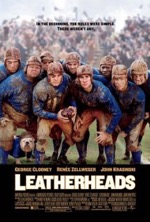
Starring: George Clooney
April 2008
“Screwball Football Farce Reveals Clooney’s Looney Side”
George Clooney’s budding romance with period pieces has blossomed into a love affair in Leatherheads, a comedic look at the early days of professional football, circa 1925. Before rules and regulations “ruined” the game, the players were much more colorful and simply played for love of the game. The money and crowds were as insubstantial as their padding and helmets, but the price was well worth the sacrifice, especially when the alternative was working in the factory, field or mine.
Moving up to the pros was also an outlet for college standouts that refused to hang up their pads after graduation. Such is the case for dashing Princeton running back, Carter “The Bullet” Rutheford (John Krasinski), who’s conscripted by charismatic Dodge Connolly (Clooney) to play for his Duluth Bulldogs. Carter, a war hero of Sergeant York proportions, appears on billboards and stadium advertisements throughout the country. Dodge hopes that such celebrity and visibility will help reinvigorate his failing sport.
On his quest to legitimize pro football, Dodge meets Lexie Littleton (Renee Zellweger), a spitfire news reporter for the Tribune who’s following a lead that will expose Carter’s heroic war story as a hoax. The ensuing love/hate relationship between Dodge and Lexie features some of the finest rapid-fire dialogue to grace a film in recent years. There are numerous scenes where the couple’s spirited bickering takes center stage and almost makes us forget we’re watching a football movie—especially during the passionate argument in Lexie’s cabin, a throwback to Cary Grant and Eva Marie Saint’s tryst on a train in Hitchcock’s classic North By Northwest. Though the movie’s middle chapters are addled by slow pacing, there are several amusing subplots that help keep the film on track: a love triangle forms between Dodge, Lexie and Carter, Dodge and Lexie evade a Keystone Cop-like police pursuit and Dodge and Carter engage in a gentleman’s fistfight where each man itemizes injured areas for the other to avoid.
The climactic game pits dotting Dodge against former teammate Carter on a muddy field in Chicago. The new commissioner’s edict that the contest be played without Dodge’s usual on-field antics forces the aging player to use all of his ingenuity in drawing up a game-winning play. Taking a cue from Carter’s grossly exaggerated war record, Dodge dubs the play the “Sergeant York.” The unconventional, yet not entirely illegal, play caps a slobber-knocker contest and a wildly entertaining film.
Leatherheads is classic comedy told on a timeless canvas, bolstered by directorial panache and acting acumen. Above all, it’s good old-fashioned filmmaking that pays fitting tribute to Hollywood’s Golden Age.
Rating: 3
Horton Hears a Who! (G)
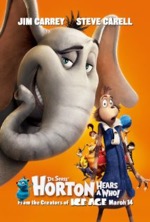
Starring: Jim Carrey
March 2008
“Horton Hears a Heavy-handed Whovie”
Somewhere along the way we stopped requiring movie stars to play characters and simply allowed them to play themselves. Here we have two comedy czars, Jim Carrey and Steve Carell, voicing characters that are so distinctly them; they’ve given typecasting a bad name. The detrimental drawback to this star-centric model is that it prevents the audience from discovering the characters on their own. Here we have Horton the elephant (Carrey), who finds a speck containing a diminutive civilization of Whos, and the mayor (Carell) of that tiny village known as Whoville (not to be confused with the other Whoville in How the Grinch Stole Christmas). Despite the fact that we never see the actors’ faces, Dr. Seuss’ Horton Hears a Who! is nothing more than The Carrey and Carell Show—very little originality gets past their blockade of manic antics and slapstick silliness.
The story is well-known from Seuss’ children’s book and the 1970 animated TV special narrated by Hans Conried. With its homily on the dangers of intolerance, personified by a rigid, rule-enforcing kangaroo (voiced with great effect by Carol Burnett), the story is more timely and relevant than ever. It’s also more politically charged than ever thanks to growing unrest and increasing polarization in our country. But should politics be mentioned in the same breath as an animated kids flick?
In the movie, the citizens of Whoville undergo radical climate shifts as Horton transports them to their new home; a secluded cave atop a nearby mountain. There, the Whos will be safe for all time…or at least until the bear returns for hibernation. There’s a thinly veiled reference to global warming (now known as “climate change” since the Earth is currently experiencing a cooling trend) in reverse when morning frost on the speck turns Whoville into an arctic waste. It’s profoundly unfortunate that this feel-good family film was ruined by insidious agendas from environmental alarmists and social nannyists. Granted, there’s a positive message in the movie’s most memorable mantra, “A person’s a person, no matter how small,” but it’s just so much stilted sermonizing made all the more unpalatable by force-fed moralizing and in-your-face patronizing.
The CGI is startlingly photo-realistic and the overall aesthetic is vintage Seuss, but the movie’s creative elements are overshadowed by its heavy-handed plot in much the same way that the story is held hostage by its larger-than-life stars. In the end, this isn’t a terrible film, but it isn’t the royal treatment that Seuss’ timeless tale deserves. But kids will love it, and when all is said and done that’s all that really matters.
Rating: 2 1/2
Definitely, Maybe (PG-13)
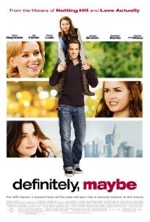
Starring: Ryan Reynolds
February 2008
“You Must Choose, But Choose Wisely!”
Premise:
A father tells his inquisitive daughter the story of how he met her mother.
Synopsis:
When the usual bedtime story fails to captivate precocious preteen, Mya (Abigail Breslin), she coerces her father, Will (Ryan Reynolds), into regaling the story of how he fell in love with her mother. The movie unspools in a series of flashback vignettes which introduce us to three of Will’s old flames: Emily (Elizabeth Banks), April (Isla Fisher) and Summer (Rachel Weisz). Will renames the women to make his story more of a mystery, but Mya, obviously, knows who her mother is. However, one of the movie’s inherent thrills is that we in the audience are kept guessing who mommy is until the very end, and even then, there’s a significant twist before the movie fades to black.
Creative Contributions:
Looking at the film from a production standpoint, the first thing that stands out is the remarkable cast. Breslin is her normal, adorable self, but it’s Reynolds who steals the show with his disarming sarcasm and charming brand of helplessness. Will’s three, pitch-perfect paramours are simply smoking, especially Weisz, who’s come a long way from the geeky librarian in The Mummy. Honorable mention (and Oscar consideration) goes to Kevin Kline for his colorful portrayal of book-writing boozer, Hampton Roth. Hampton’s torrid love affair with his student, Summer, takes a strange twist when she falls in love with Will; the ensuing love triangle further muddies the waters with respect to Will’s ultimate choice for a mate. Besides relational matters, the movie’s political commentary is also engaging. Overly idealistic and highly opinionated Will starts off as a lackey at Bill Clinton’s campaign headquarters and eventually works his way up to a power position by the president’s second term. Will’s progression from ambitious upstart to disillusioned sideliner makes for a fascinating character study.
Evaluation:
My initial reaction to the trailer for Definitely, Maybe was “Maybe, If I Must.” However, the film is a superior love story because it doesn’t constrain itself to the standard conventions of the genre: faux pas, awkward moments, startling revelations, relational gags, etc. The performances are all outstanding and writer/director Adam Brooks’ first-rate script is wildly entertaining and highly provocative—think of Definitely, Maybe as the perfect marriage between a chick flick and a Woody Allen dramedy. The end result here is far superior to other recent romance films and is definitely worth seeing.
Rating: 3
Fool's Gold (PG-13)
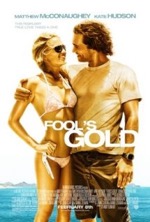
Starring: Matthew McConaughey
February 2008
“How to Lose an Audience in Ten Minutes”
The movie’s opening is quite clever: the wind sweeps up a piece of paper inside the main cabin of a yacht and fatefully carries it to the rear of the boat where it sets the sheet down on top of a struggling generator. Sparks from the generator set the paper on fire and soon the boat is ablaze. When the fire reaches a propane tank, the entire ship goes up in a fulminating inferno.
Ben “Finn” Finnegan (Matthew McConaughey) and his Ukranian sidekick, Alfonz, (Ewen Bremner) are searching for treasure on the ocean floor when pieces of the boat begin “raining down” on them. The ensuing underwater argument is amusing, and even though the story seems as shallow as the water Finn and his partner are swimming in, the scene actually marks the movie’s highpoint: like the sunken ship that descends to its watery grave, it’s all downhill from here.
After eight years of following her zealous husband around on one treasure hunt after the next, Tess (Kate Hudson) has decided to pull the plug on their marriage. When Finn arrives late to the divorce proceedings, he forfeits all of his possessions to Tess, including the boat that he just sent plummeting to the bottom of the sea. However, the boat’s sinking is serendipitous in a way; the ship’s impact on the ocean floor dredges up part of an ancient plate, which is the first clue to a nearby treasure.
You don’t need to be a fortuneteller to see where the story goes from here. Finding a fabled treasure, reconciling a failed marriage, staying one step ahead of competing treasure seekers (led by Moe, Finn’s former partner, played by Ray Winstone)…as they say, it’s all in the script. A simple and simpleminded script, the story spends far too much time on the expository history lesson, too much effort on the frenetic, freewheeling climax and not enough energy on fleshing out its characters.
McConaughey and Hudson, who were charming together in How to Loose a Guy in 10 Days, surprisingly have an utter lack of screen chemistry here…their relationship seems forced and unnatural. It’s almost like they’re trying too hard. The finest performance in the movie belongs to Donald Sutherland, who plays the wealthy boat owner that ferries the leads around on their treasure quest, most likely because he needs a diversion from dealing with his spoiled brat granddaughter, Gemma (Alexis Dziena).
Fool’s Gold is an unremarkable film that banks on its star power to please its audience. In the end, this rom-com/adventure movie more than lives up to its name: those who view it will find iron pyrite instead of pure gold. Don’t be fooled!
Rating: 2
27 Dresses (PG-13)
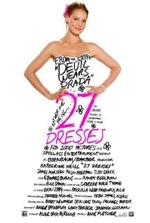
Starring: Katherine Heigl
January 2008
“Adorable Heigl Anchors Standard Rom-com”
Premise:
A woman who’s been a bridesmaid for twenty-seven friends longs for her own special day.
Synopsis:
People pleasing Jane Nichols (Kathryn Heigl) denies her own happiness even to the extent that she plans her sister’s wedding to the man she’s madly in love with.
Creative Contributions:
As would be expected, there are a lot of dresses in the movie. As such, the costuming is hard to ignore when evaluating the movie’s production virtues. Additionally, there are some nice locations and a few interesting sets, apart from the movie’s many wedding/reception venues. However, there’s little else to talk about below the line. As the movie’s central figure, Jane is an interesting character study in what it’s like to be a human welcome mat, and Heigl’s pitch-perfect performance anchors the movie in charming and meaningful ways. The movie’s perfect man, Kevin (James Marsden), is, ironically, a jaded newspaper columnist who would rather be thrown from a plane without a parachute than get hitched (he refers to marriage as “the last legal form of slavery”). Of course we all know he’s eventually going to come around and that Jane will be the catalyst to opening his eyes to new horizons of love, but the process of how Kevin succumbs to one of Cupid’s arrows is half the fun of the movie. It’s a difficult role that easily could have been knocked off course by a tidal wave of smarminess or insincerity, but Marsden pulls it off in surprising fashion…surprising when you place this turn next to his groan-inducing performances in the X-Men movies. They say you can’t catch lightning in the same bottle twice. You would’ve expected that tapping the writer of box-office smash and critical darling The Devil Wears Prada, Aline Brosh McKenna, would have guaranteed a surefire hit here. Unfortunately, the sum of its parts doesn’t even come close to capturing the same movie magic that Prada had in spades.
Evaluation:
27 Dresses is the old expression “Always a bridesmaid, never the bride” on speed. It’s a diverting, if overstated, look at how a cynical man and weak willed woman can fall in love and live happily ever after, and is, therefore, a modern fairy tale. Even though it’s as predictable as every other romantic comedy out there, 27 Dresses does feature a unique take on love and marriage and also has some engaging performances. In short, you should take in 27 Dresses.
Rating: 2 1/2
The Bucket List (PG-13)
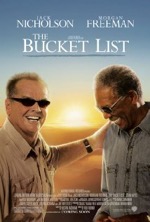
Starring: Jack Nicholson
January 2008
“Kickin’ It with Nicholson and Freeman”
Car mechanic, Carter Chambers (Morgan Freeman), is laid up in a hospital. He has cancer. The fussy old crank in the bed next to Carter is also a cancer victim and just happens to be the owner of the hospital, Edward Cole (Jack Nicholson). Edward makes incessant demands of nurses and his personal assistant Thomas (Sean Hayes). He also has gourmet feasts prepared for him and frequently turns up his nose at some portion of the meal. Carter should be so lucky…his feast is bland hospital food.
Faced with a similar demise, Edward and Carter band together against their mutual enemy like two soldiers in a foxhole. Such commonality provides the basis for a budding friendship which comes full bloom in time, but not before Edward finds a crumpled up piece of paper on the floor that contains Carter’s bucket list. Simply put, the bucket list is an itemization of all the things an individual hopes to accomplish before he kicks the bucket.
At first, Edward is amused by the quaint concept but then buys into the idea wholesale when his doctor delivers the devastating news…Edward and Carter both have six months to live. After being released from the hospital, the geriatric gents set out on a journey of reckless abandon and personal discovery…all financed by Edward’s billions.
The first item on the list: hold a big gun on a safari. Next up: skydiving! Other items: race a car, get a tattoo and go to India. The more items they check off the list, the more Edward and Carter realize that gallivanting around the globe is only prolonging the inevitable; both must return home to make restitution with estranged family members.
Justin Zackham’s excellent script gives the story wings, but it’s the superlative performances that make it fly. Nicholson and Freeman, an unlikely pairing, bring out the best in each other like iron sharpening iron. Impressive filmographies and multiple Oscars aside, the big screen veterans infuse their roles with dignity in the face of finality.
One wonders how much actual direction veteran auteur Rob Reiner gave his legendary leads. Was he hands-on or did he just wind up his two stars and turn them loose to do what they do best…sell tickets and entertain audiences? Either way, Reiner’s well-honed craft is manifest in every frame, especially in the intimate character vignettes.
Some will judge The Bucket List as an overly sentimental debacle, whose stilted carpe diem homily shamelessly tugs at the heartstrings. Whereas I acknowledge the validity of that viewpoint, I see the film as an uplifting, life-affirming guide on how to go out with a bang. And really, is there any harm done in being reminded to take stock of one’s life or to make the most of every moment? Seize the day before you seize up!
Rating: 3
Juno (PG-13)
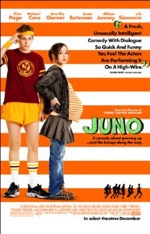
Starring: Ellen Page
December 2007
“Well-written Script Makes For a Well-rounded Drama”
Young Juno McGuff (Ellen Page) nervously paces back and forth in her living room as her expectant parents wait with bated breath for Juno’s announcement—they think she’s been expelled from school. Expulsion, a word Juno employs as if she learned it on a flashcard in the womb, is the least of her parents’ worries. As tension builds, Juno summons enough courage to exhale those two words that every parent of a teenage daughter fears to hear, “I’m pregnant.” Shell-shocked, her parents launch into a series of contingency plans—prenatal vitamins, etc.—and then wryly ask themselves why it couldn’t have been something simpler…like drugs.
Thus begins the indie dramedy of precocious teens and world-weary adults. The movie has many subtle messages woven into its seemingly innocuous narrative. Issues like teenage pregnancy—and by extension abortion vs. adoption—and marital (in)fidelity are all handled with relative ease by screenwriting newcomer, Diablo Cody, a former exotic dancer. My only criticism of Cody’s work is that the dialogue she puts in Juno’s mouth—laced with SAT words, modern expressions and enough societal references to fill a dictionary of cultural literacy—seems a little too advanced for a sixteen-year old girl. That’s not to say that teens like Juno don’t exist, but exactly what percentile are we talking about? Still, it’s nice to see a movie that exemplifies a young person who is intelligent and well-adjusted…imagine a society in which Juno was an average teenager!
Besides the groundbreaking performance by Page, some wonderful supporting performances are turned in by the eclectic ensemble. Allison Janney and J.K. Simmons play disappointed but supportive parents who handle Juno’s indiscretion with a surprising degree of equanimity. Simmons, in particular, brings charm, humor and sagacity to his part. There’s a great father/daughter scene, where Simmons’ character tries giving Juno advice, that’s amusing in its awkwardness and touching in its genuineness.
Jason Bateman and Jennifer Garner play the young couple who desperately want to adopt Juno’s baby; they discover the knocked up teen’s ad in the Penny Saver paper. Bateman and Garner are pitch-perfect in the film’s most complex roles; Garner is delightfully understated and Bateman is a portrait of ambivalence in a marriage riddled with relational subtext.
Director Jason Reitman (Ivan’s son), equipped with a superlative script and excellent performances, has helmed an effort that’s shifted the paradigm for teen angst pictures. You can bet this original storyline, masterfully executed and promulgated by Reitman, Cody and Paige, will be emulated without success for years to come, ad nauseam. But for now, enjoy the blissfully sweet beginnings of a new movement in film.
Rating: 3
Enchanted (PG)

Starring: Amy Adams
November 2007
“Melodious and Magical, Enchanted is Spellbinding”
Everything is perfect in Andalasia, an animated fairytale land where helpful animals assist with chores, a prince can meet and marry his princess in the same afternoon and where, to quote Etta James’ At Last, “life is like a song.” But lest we forget, every Eden has its serpent and in Andalasia that serpent is the evil queen (Susan Sarandon), whose stepson, Prince Edward (James Marsden), is to marry peasant girl Giselle (Amy Adams). The queen won’t stand for this as she’ll lose the throne, and we all know how controlling villainesses hate to relinquish their authority in Disney movies.
Posing as an old woman (who looks like a witch, which would naturally set off alarms in one’s head), the queen pushes Giselle into a bottomless well. When Giselle comes to, she finds herself in our world—specifically Times Square—and the movie switches to live action. Lost and disoriented, Giselle seeks admittance back into the magical kingdom by pounding on the palace doors emblazoned on a billboard. Robert (Patrick Dempsey) heroically rescues Giselle and puts her up in his flat for the night.
The story’s fish-out-of-water element, where Giselle is introduced to the often cold and harsh realities of our world, is a large part of the film’s success. The other major contributor is the memorable musical numbers composed by Alan Menken and Stephen Schwartz. Catchy show tunes pop up all over the film—like the “Happy Working Song,” where small animals under the spell of Giselle’s melodious voice assist her in cleaning up Robert’s apartment. Besides their entertainment value, the songs are also a lot of fun and respectfully poke fun at Disney’s bright and cheery song catalog.
The leads are fabulous…Adams is an ebullient delight as Giselle and Marsden is an absolute hoot as melodramatic Prince Edward—Marsden steals the show with his dramatic flourishes and storybook simplicity. Dempsey is a bit muted in his portrayal of the divorce attorney, but plays the perfect counterpoint to the ever-cheerful Giselle. “It’s like you escaped from a Hallmark card,” he tells her.
I enjoyed Pip, the loyal chipmunk, and the handful of scenes that blended animated characters with live action ones, a la Roger Rabbit. I even liked the ménage trios, which skillfully keeps the audience guessing which beau Giselle will choose until the very end. What I couldn’t abide was the cheesy dragon, which shows up at movie’s end. As strange as it sounds, the scaly beast took me out of the reality of the movie.
Enchanted is a solid effort that satirizes many of the conventions employed in earlier Disney fairytales. It’s all in good fun though, and actually, that’s probably the most accurate word one could use to describe Enchanted, fun. As a sequel seems all but assured, let’s hope it contains the same magic that enchants this film.
Rating: 2 1/2
Mr. Magorium’s Wonder Emporium (G)
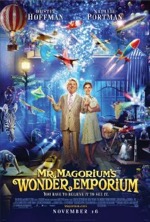
Starring: Dustin Hoffman
November 2007
“Forced Smiles with Foisted Fun for All”
Mr. Magorium’s Wonder Emporium, written and directed by Zach Helm, is the story of a magical toy store and its peculiar, titular owner. The store, squeezed between two tall buildings, looks exactly as it should—Elizabethan façade painted in gaudy colors on the outside, with a Wonka-esque toy store on the inside. The store houses a wide array of unique treasures, including: live fish mobiles, rollicking balsa wood T-Rex’ and bouncing balls that try to escape the store by jumping into customers’ shopping bags.
In preparation for retirement, Magorium (Dustin Hoffman) hires accountant Henry Weston (Jason Bateman) to set his affairs in order before handing over the store to his protégé, Molly (Natalie Portman). I always worry about revealing too much in a synopsis, but in this case, spilling the beans is unavoidable. I’ve already divulged the entire plot…sorry. With its paper-thin premise, saccharine sentimentality and an utter lack of conflict, the film offers very little else to discuss.
That’s not to say that Magorium doesn’t have its fair share of heart-warming moments. An adorable little boy named Eric (Zach Mills, who also serves as the movie’s narrator) brings whimsy and wide-eyed amazement to the film and is, sadly, and ironically in Magorium’s case, the only character to do so. There’s an amusing little scene where Eric tries making friends with Henry; Eric writes notes on a dry erase board and lifts it up to the window separating the two. “Want to play checkers when you stop working?” Henry replies with a handwritten message on a legal pad: “I never stop working.” Eric responds with a frowny-face. There’s also a cute little stuffed monkey that reaches out to hug Henry, but the harried accountant hurriedly and heedlessly walks by, producing an “aww” of sympathy from the audience. It’s a moment.
Hoffman’s performance falls woefully short of what it should have been, especially when considering the actor’s immeasurable range. Hoffman was brilliant as the bumbling Mumbles in Dick Tracy (1990), but here the veteran actor tries too hard to be likable and ends up making Magorium an eccentric busybody, complete with Lyle Lovett coiffure and a faux lisp so annoying it would make fingernails-on-a-chalkboard sound like the Hallelujah Chorus. Why would such a decorated actor select such a pedestrian role with such little charm and imagination? Portman tries her hardest to make Molly a complex character, but save for the subplot involving Molly’s ambivalence over wanting to be a concert pianist and feeling honor bound to take over the toy store, there’s very little for her to do…besides stew over Magorium’s departure or believe in a mystical block of wood that holds the secret to the store’s magic.
And speaking of magic; it’s one of the movie’s buzzwords. As such, it’s utterly ironic that a movie so preoccupied with magic should have so little movie magic. Any amazement the movie provides is foisted upon the spectator like a Jedi knight waving his hand and mentally suggesting, “You will gasp in astonishment at this scene. You will think this movie is magical.” It’s a shame that the creative minds behind the movie felt they had to assert the store’s magical qualities instead of simply showing them.
Mr. Magorium’s Wonder Emporium will surely captivate pre-teens with its semblance of magic, but anyone else, especially today’s savvy teens, will see right through the movie’s veneer of colorful sets and props and realize that more fun could be had at the local arcade than in Magorium’s gimmicky emporium. This Wonka wannabe might be full of wonder, but it certainly isn’t wonderful.
Rating: 2
Martian Child (PG)

Starring: John Cusack
November 2007
“Boys to Men…Martian Style”
Martian Child is the story of a troubled young boy, Dennis (Bobby Coleman), who believes he’s from another planet and the sci-fi novelist, David (John Cusack), who adopts him. Pale-skinned Dennis (who has an aversion to sunrays) is socially maladjusted, has bouts of kleptomania and only eats Lucky Charms. On balance, Dennis is exceptionally bright, has an insatiable curiosity about science and boasts extraordinary abilities—he claims that he can taste colors. Dennis’ mission, purportedly assigned by leaders on his home world, is to learn what it’s like to be part of a human family.
David doesn’t know the first thing about parenting and Dennis proves to be much more difficult to manage than the average 6-year-old kid. Their unusual, familial dynamic, which creates a variety of situations ranging from the comedic to the dramatic, forms the foundation of the story written by Seth Bass and Jonathan Tolins, based on the novel by Star Trek scribe, David Gerrold.
When Dennis says something bizarre—like when he calls the family dog a flomar, which means “warm, furry friend” in Martian—David exasperatedly replies, “I deserve you.” The beauty of the story is that David and Dennis both deserve, and need, each other. David is mourning the recent loss of his wife and Dennis is angry and confused about being abandoned by his parents at birth: both must learn to rely on the other in order to move forward in life.
Coleman is simply adorable in the film: the precocious actor imbues Dennis with the perfect blend of angst and child-like innocence. Cusack anchors the movie with his exceptional performance; he infuses David with the appropriate amount of humanity and vulnerability in a role that properly showcases his expansive range. In a serendipitous bit of casting, Cusack’s real life sister, Joan, plays his onscreen sister. Other key, supporting performances are turned in by Amanda Peet as David’s longtime friend, Oliver Platt as David’s off-kilter publicist, Anjelica Huston as a high-powered editor, Sophie Okonedo as an adoption agent and Richard Schiff as the child services watchdog.
If Martian Child feels familiar somehow, it’s because the movie shares story elements with such films as Powder (1995) and K-PAX (2001). However, despite its derivative storyline, Martian Child is a heart-warming exploration of the human condition as seen through the eyes of a misfit child. The film is also a clinical examination of our deep-seeded need for love, acceptance and security, and as Dennis establishes in the film, these are basic, human needs…even on Mars.
Rating: 2 1/2
Dan in Real Life (PG-13)
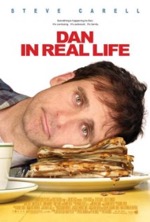
Starring: Steve Carell
October 2007
“Unexpectedly Poignant Dramedy from the King of Camp”
The family reunion movie has been done a thousand times before, but thankfully number one thousand and one saw the green light of day, because Dan in Real Life is a genuine gem filled with adult angst, familial strife and guffaws aplenty.
Dan Burns (Steve Carell), a well-known parenting expert who has his own radio program, whisks his three daughters off to his parent’s house in Rhode Island for a get-together. If Meet the Parents was set around a family reunion and only had a quarter of its clumsy mishaps, you’d have a pretty close approximation of Dan in Real Life. Whereas Ben Stiller’s Greg Focker was the very personification of Murphy’s Law, Dan merely has brushes with misfortune, like the occasional run-in with the same cop.
At the heart of the story is a painful-to-watch love triangle. Dan, who’s been a widower for four years, is just starting to work up enough courage to start dating again. Dan meets Marie (Juliette Binoche) in a bookstore and makes an instant connection with her. Hope is rekindled in his heart…a hope that’s quickly dashed when Dan learns that his new crush is actually his brother’s (Dane Cook) girlfriend. What a cruel world!
Dan spends the rest of the movie trying to stay out of Marie’s way while desperately trying to keep her out of his head; he manages to accomplish neither. Every time Dan sees Mitch and Marie’s public displays of affection, he mentally retches. Mitch and Marie are as mismatched as two people possibly can be; on the other hand, Dan and Marie are an eminently better suited couple…something everyone sees but no one voices. As Dan’s feelings for Marie intensify his behaviors become more extreme, and in the end Dan manages to alienate his family, loose the respect of his daughters and sabotage his best chance at rediscovering true love. Again, what a cruel world!
Despite instances of his patented, comedic shtick, this is Carell’s most serious role to date and he’s very effective at engendering sympathy from the audience as the black sheep of the family—Dan’s parents put him up in the laundry room and assign him to dish detail. Carell plays the pariah to the hilt; Dan is so hapless you just can’t help but feel sorry for him. Two must-see moments are the shower and burnt pancake scenes.
The movie’s synopsis is as basic as they come and its plot is unpretentious and uncomplicated, and yet the story contains some truly fine character studies and familial discoveries—the movie’s most effective attribute is its complexity amid streamlined simplicity. A family film that’s comical and inspirational, Dan in Real Life is one of the finest dramedies that’s come along in recent years. Highly recommended!
Rating: 3 1/2
Mr. Bean’s Holiday (PG)
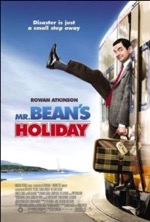
Starring: Rowan Atkinson
August 2007
“That’s One Big Step for Stupid-kind”
Like an ill wind, Bean is back! Rowan Atkinson’s quirky alter ego has returned to the big screen in Mr. Bean’s Holiday, director Steve Bendelack’s opus for the inane.
Winning a trip to France in a raffle, Bean is off on a journey of random events and slapstick silliness. Apart from the traditional points of interest in Paris, Bean’s main objective is to visit the world-famous beach at Cannes. As the plot unfolds, however, circumstances go from bad to worse, effectively maneuvering Bean farther and farther from his goal. Along the way, Bean looses all of his personal effects, save for his prized camcorder which contains a visual travelogue of his many misadventures—shot in a predictably haphazard style.
After nearly an hour of brain-shrinking idiocy, the movie stumbles into something that resembles a plot. Having been subjected to every one of Murphy’s Laws, Bean is forced to walk back to Paris on foot. Things heat up when Bean happens onto a movie set and ends up in the background as an extra. The Nazi-themed short is being helmed by Carson Clay (Willem Dafoe) an intense visionary who epitomizes art film directors; boundless energy and creativity with enough of a capricious streak to keep everyone on set on edge. After a long day of acting, Bean hitches a ride from an attractive young woman who is conveniently en route to Cannes; the film festival, not the beach, much to Bean’s disappointment. Bean’s luck finally takes an upswing when he preempts Carson’s self-aggrandizing indie film with his camcorder video and unwittingly becomes the highlight of the festival. But the overwhelming praise for his work, which has inspired a new movement in film, is lost upon a man who simply wants to get to the beach.
The movie is essentially a series of sight gags with some physical comedy sprinkled in, all of it done in Atkinson’s patented style which was made famous in his BBC TV show, Mr. Bean. This is the second Bean film released in the US, and although it’s charming, the tenuous screenplay relegates the film to a level of mediocrity that would leave the typically speechless Bean cursing a blue string.
Mr. Bean’s Holiday is about as silly as they come, but it accomplishes its purpose and showcases some truly breathtaking snapshots of the French countryside. This isn’t cinematic high art…it’s a popcorn flick, and as such, is a great way to escape into a mind-numbing delirium for two hours. There are worse ways to waste time. Whether or not this movie warrants another installment in the slapstick series, one thing’s for sure…Bean is a dip!
Rating: 2
No Reservations (PG)

Starring: Catherine Zeta-Jones
July 2007
“Bittersweet Treat with a Dash of Romantic Tension”
I once knew a guy who possessed an almost unnatural insight into cooking: as if reciting an Emeril show, he instructed me on what steps and which ingredients needed to go when and where to produce a savory meal…which he had just conjured up in his head and instinctually created right before my very eyes. A similar, if more professional, display of culinary genius is showcased in No Reservations, a dramedy centered on a 5-star eating establishment in NYC.
Catherine Zeta-Jones plays Kate, a workaholic chef whose ineptitude at raising children is magnified to frightening new levels when her niece, Zoe (Abigail Breslin), comes to live with her. Kate, who knows nothing about making meals for kids, serves Zoe duck for lunch and a fish (with head and tail still attached) for dinner.
Kate’s rival at work is insouciant sous chef, Nick (Aaron Eckhart). Nick’s unpredictability and fun-loving manner comes off as irreverence to Kate, especially when Nick shows up to work in his pajamas and conducts an opera with soup ladles. Kate’s problems surmount when Zoe takes a shinning to Nick and her intensifying feelings for Nick boil over, setting up some amusing interplay between the principle characters.
There’s nothing flashy about No Reservations, and that’s probably what makes it charming rather than cloyingly sentimental. The performances are sincere and bring balance to a story that easily could have digressed into a mawkish tear-fest were it not for sure-handed direction by Scott Hicks and a solid screenplay by writers Carol Fuchs and Sandra Nettelbeck. Zeta-Jones plays high-strung and lovelorn Kate to perfection and Eckhart imbues Nick with the perfect blend of boyish charm and rugged refinement. Breslin (Little Miss Sunshine) shows her serious side in her portrayal of a grieving pre-teen trying to accept the death of a loved one while adjusting to new house rules.
Though the film is a tad heavy-handed in the “tug-on-your-heartstrings” department, it’s a feel-good love story that’s sure to be a crowd-pleaser. Effectively balancing light-hearted moments with mature themes, No Reservations has all the right ingredients. As such, I have no reservations about recommending the film. Soup’s on!
Rating: 3
Hairspray (PG)

Starring: John Travolta
July 2007
“A Musical Comedy That Really Takes Hold”
Based on the earlier film (1988) and Tony Award-winning Broadway musical (2002) of the same name, Hairspray’s filmic second coming is a delightful, toe-tapping romp. Boasting a luminous cast, including: John Travolta, Michelle Pfeiffer, Christopher Walken, James Marsden, Amanda Bynes, Brittany Snow, Zac Efron, Allison Janney and Queen Latifah, the film also introduces exuberant newcomer, Nikki Blonsky, who plays “pleasantly plump” Tracy Turnblad…the big girl with big dreams of being a dance star.
Tracy faces stiff competition (from significantly slimmer women) when auditioning for the American Bandstand clone, the Corny Collins show—the highest rated program in its time slot on the local access channel in Baltimore, MD, circa 1962. Tracy’s father Wilbur (Walken), a struggling novelty store owner, is supportive of Tracy’s dream, whereas her mother, Edna (Travolta in drag), a stay-at-home laundress, attempts to quash Tracy’s dreams to protect her daughter from the pain of rejection.
Why Hairspray’s brain trust saw fit to cast Travolta as Tracy’s mom is anyone’s guess, but the Grease vet is surprisingly convincing in the role and shines in the “Timeless to Me” number; Walken, drawing upon his musical theater background, is also delightful in the scene. Pfeiffer, another Grease alumna, is delicious as the arrogant TV producer, and Marsden, as the cheesy dance show host, has never looked or sounded better onscreen—maybe he should quit his day job. As for Blonsky, she was working at Cold Stone Creamery in her hometown of Great Neck, New York when she was selected to play the ebullient youth. Blonsky was the natural choice to play persecuted Tracy; while growing up, the actress had endured similar teasing from her perfectly proportioned classmates. It’s nice to see a good girl finish first, especially one with genuine talent.
The movie’s musical numbers are first-rate, especially the dance floor jigs for the Corny Collins Show and the Hairspray Pageant. Serving as commas to the brilliantly choreographed dance songs are some surprisingly meaningful character moments and poignant social issues, such as: marital fidelity, interracial relationships, prejudice over race or weight and the battle for social progress. Amazingly, the story is just as relevant today as it was in ’88 when John Waters penned the original script; proof positive that the more things change, the more they stay the same.
They say hairspray is bad for the environment, but this Hairspray is a can of good, clean fun. While many will find the film entertaining, if even a few come away with a better understanding of the dangers of marginalization, so much the better. Spray away!
Rating: 2 1/2
License to Wed (PG-13)
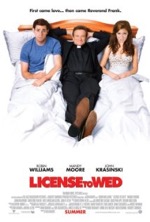
Starring: Robin Williams
July 2007
“License and Rolaids Please”
Premise:
To prove their compatibility as marriage partners, a young couple must endure the intensive, invasive and unorthodox marriage counseling methods of a radical minister.
Synopsis:
Sadie (Mandy Moore) insists on being married in the church her grandfather built, much to her fiancé, Ben’s (John Krasinski), persistent protestations. However, Reverend Frank’s (Robin Williams) calendar is so packed that he can only marry Sadie and Ben in three weeks…or sometime next year. Opting for the quicker course, Sadie and Ben are subjected to Rev. Frank’s extreme marriage prerequisite course which includes a variety of bizarre exercises. Rev. Frank’s lesson in communication sees Sadie driving blindfolded while Ben gives directions from the back seat. Rev. Frank bugs Sadie and Ben’s apartments to safeguard the couple against consummating their relationship before the honeymoon. Ben must contend with creepy robot baby twins which secrete all manner of fluids at random times in order to prepare him for fatherhood. These challenges drive Sadie and Ben further apart, which is, of course, all part of Rev. Frank’s plan. The couple breaks up, but will true love bring them back together in time to take the final exam?
Creative Contributions:
The film’s most obvious deficit is the anemic script. The premise is flimsy and the story isn’t substantial enough to hold up under its own preposterous notions. Ken Kwapis’ TV sitcom sensibilities shackle the story and William’s stale shtick kills any chance the movie has of being a charming, lighthearted look at prenuptial stress and strife. The Seed of Chucky demon-babies are downright disturbing as is Frank’s consistently deplorable behavior (just how many of Williams’ recent performances have involved eavesdropping, spying, voyeurism, etc.?)
Evaluation:
With unmistakable shades of Meet the Parents, License to Wed is a mindless rom-com that had the opportunity to explore the complexity of relationships in a mature and respectable manner, but settled for the cheap laugh instead. The formidable line-up of stars, along with solid assists from veterans like Peter Strauss and Wanda Sykes still couldn’t right the severely listing ship. Williams is regrettably hackneyed and is becoming more irrelevant with each successive role. Mandy Moore, bless her heart, has had terrible luck with her comedies at the box office this year. Better luck next year!
Rating: 1 1/2
Ratatouille (G)

Starring: Patton Oswalt
June 2007
“Anyone Can Cook…An Average Meal”
I’m a hypocrite! That’s the only possible explanation for my tepid reaction to Disney/Pixar’s new animated repast, Ratatouille. Even with rats overrunning the kitchen, the feast served up by director Brad Bird and his team of digital sorcerers has all the right ingredients, and yet, there’s one fundamental story element that stands out like a fly doing the backstroke in a bowl of soup.
The previous Pixar film, Cars, anthropomorphized automobiles in a way that was charming and disarming, even for someone like me—a guy so ignorant about cars I once paid a mechanic to change my air filter. How talking autos became so popular and endearing is anyone’s guess, but no one can deny that Cars has memorable characters, hysterical and heartwarming scenes and what every feature hopes to capture like lightning in a bottle…movie magic.
So why am I a hypocrite? I can suspend my disbelief for conversing cars, but I just can’t bring myself to believe in a gifted rat who teaches a numbskull human how to create gourmet meals that can make even the most jaded food critic gush forth praises like a Parisian fountain. If this were merely a throwaway subplot, I could have abided the preposterous story element for the sake of an otherwise delightful tale of friendship, teamwork and dogged persistence in pursuing a dream. Unfortunately, the relationship between rodent Remy (Patton Oswalt) and clumsy trash boy turned overnight cooking sensation, Linguini (Lou Romano), is the cornerstone of the movie. If, like me, you just can’t buy into the trans-species partnership, it won’t take long for you to detect this tenuous plot device, which continues crumbling throughout the movie like bleu cheese over a tossed salad.
However, there are some great sequences in the movie, such as; rifle-packing granny making Swiss cheese out of her house while trying to blast the vermin in her attic, the montage of shots that show Remy teaching Linguini how to cook by tugging on tufts of the boy’s red hair and the climactic scene when Remy enlists a legion of his friends to help save the day…and Linguini’s reputation. What’s refreshing here is that just beneath all the frenetic fun and frivolity, discerning viewers will find additional layers of meaning and salience. Themes such as confronting fear, leaving home, falling in love, overcoming prejudice and forging an unlikely friendship all find poignant expression in the film and are handled with the skill and artistry of a world-renowned chef.
It almost goes without saying that the film’s CG animation is amazing—each new Pixar film raises the standard for the rest of the animation industry. The first Pixar film to feature mice and men, Ratatouille has a unique palette which perfectly captures the mood and styles of Paris—the night skyline, complete with the majestic Eiffel Tower, is so sweeping and breathtaking it makes you want to rush right out and book a flight to France.
The animation is undeniably the movie’s piece de résistance, but the stellar vocal talents serve as the perfect garnish to this savory dish. Oswalt endues Remy with just the right mixture of wit, angst and pluck. Romano deftly performs hapless, clueless Linguini, but it’s Peter O’Toole, as cantankerous food critic Anton Ego, who steals the show with his rich, refined and resonant baritone. Other voices are provided by Brian Dennehey as Remy’s father, Janeane Garofalo as Linguini’s crush, Collette, Ian Holm as Skinner and Brad Garrett as Remy’s idol and mentor, Gusteau.
The more I reflect upon Ratatouille, the more I realize my judgments will seem too harsh, but, for the reasons stated above, I can’t give the movie the glowing recommendation it clearly deserves. Ratatouille has the same heart as the other Pixar animated releases, but doesn’t have the same magic. However, the movie still exemplifies quality, family entertainment and, undoubtedly, will find universal appeal and acceptance from critics and audiences alike. This is the first Pixar movie that failed to meet my expectations…but at the end of the day, an average movie from Pixar is still better than the finest work from any other animation studio. I’d gladly pass up their filet mignon for a bowl of Pixar’s peasant soup any day!
Rating: 2 1/2
Evan Almighty (PG)
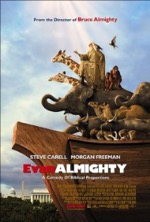
Starring: Steve Carell
June 2007
“A Flood of Levity with a Sprinkle of Morality”
The follow-up to the divine comedy Bruce Almighty (2003), which starred Jim Carrey and Morgan Freeman, Evan Almighty features Steve Carrell as a modern-day Noah who’s been instructed to build an ark by God—once again personified by Freeman.
Evan Baxter (Carrell) was a curious choice for lead character since he was Bruce’s rival in the earlier film. The transition from antagonist to protagonist (and anchorman to congressman) might be too much of a stretch for some viewers; such an obvious contrivance challenges the movie’s credibility right out of the gate. Carrell’s usual antics are toned down here a bit, but the role consistently defaults to the comedic rather than the dramatic and crosses the border of silliness on a fairly regular basis; like when Evan tries to keep up with his rapidly growing beard or when a veritable zoo follows him around town and even accompanies him to congressional meetings.
Among the notable cast members are: John Goodman as a shady politician, Lauren Graham as Evan’s exasperated wife and Wanda Sykes as Evan’s quick-witted secretary. Save for Carrell and Freeman, the movie’s performances are as wooden as the ark but this is mindless comedy, not Shakespeare (thank goodness; Carrell is a far cry from Olivier).
Joel Cohen’s script is considerably tamer than the brazenly irreverent Bruce Almighty and, for better or worse, the movie will be classified as a family film. From a moral or religious standpoint, there’s absolutely nothing objectionable in the film and some of the inside gags—Evan’s alarm clock rouses him at exactly 6:14 and his new license plates read GEN 6:14, the Bible verse that commanded Noah to “Make thee an ark of gopher wood”—are quite amusing. Even though the plot is flaccid in spots, credit Cohen for taking the movie in a different, if less interesting, direction than the first film.
Evan Almighty is good, clean fun that features a diverting premise and a positive moral: you can change the world “one act of random kindness at a time.” It’s an oversimplified maxim that’s made palatable only because Freeman delivers it—after all, he, not Bruce or Evan, is the Almighty.
Rating: 2 1/2
Shrek the Third (PG)
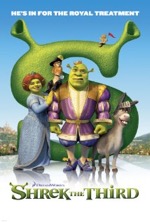
Starring: Mike Myers
May 2007
“The Ogre Who Wouldn’t Be King”
There’s a scene toward the beginning of Shrek the Third where the not-so-jolly green ogre grabs a wine bottle and tosses it against the stern of a departing ship; to honor the long-standing, sea-faring tradition of christening a ship on its maiden voyage. The force of his throw, however, shatters a section the wooden hull and water immediately begins flooding the lower decks of the ship. In a matter of seconds the vessel is completely submerged, leaving nothing but bubble streams rising to the surface and stunned expressions on the faces of those gathered to see the ship off.
The scene is a microcosm of the perils facing this movie in particular and the series in general. With the arrival of the third Shrek film, it has become painfully obvious that the ship is sinking…rapidly.
All of the familiar voices are back: Mike Myers as Shrek, Cameron Diaz as Fiona, Eddie Murphy as Donkey, Antonio Banderas as Puss in Boots, Rupert Everett as Prince Charming, John Cleese as King Harold and Julie Andrews as Queen Lillian. The latest legendary figure to be added to Shrek’s mythical mélange is King Arthur (are you ready for this…Justin Timberlake), who’s painted here as an ungainly, wussy-boy named Artie. Artie is reticent to assume the title and responsibilities of being king, a role that is being forcefully foisted upon him by the true heir to the throne, Shrek.
Does anyone else find this kind of revisionist history hard to swallow, or outright offensive? Riddled by other such discrepancies and inanities, the movie’s plot would make a nursery rhyme read like Shakespeare. Besides the aimless storyline, recycled gags, Dick and Jane dialogue and snail-like pacing, the movie fails to entertain because the once-charming premise of fairy tale potpourri has grown so tired that Rumpelstiltskin would be considered an insomniac by comparison.
It’s clear that Shrek’s producers are content to milk the cash cow for as long as they can—in other words, for as long as we keep feeding it the green. So I say, let’s boycott future Shrek films (number four is already in the works), until the powers that be bring back the fun-filled frivolity that first made us fall in love with the magical, whimsical land Far, Far Away and its colorful characters. That may seem a bit extreme, but the alternative is to sit back and hope that Shrek the Fourth is better than Shrek the Third; a brand of wishful thinking that borders on the naive.
Some have defined insanity as doing the same thing over and over again while expecting a different result. If that statement is anywhere close to being true, the Shrek series is already well on its way to the funny farm.
Rating: 1 1/2
Meet the Robinsons (G)
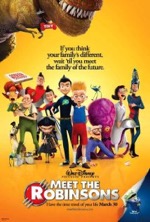
Starring: Daniel Hansen
March 2007
“Light-years Ahead of Other Animated Family Films”
The latest animated offering from Walt Disney Studios, Meet the Robinsons, presents a story of friendship, courage and the importance of family. Directed and co-written by Stephen J. Anderson (who also provides three voices in the movie), this time travel tale, based on William Joyce’s children’s book, A Day with Wilbur Robinson, features the vocal talents of Angela Bassett, Adam West and Tom Selleck.
As an infant, Lewis was abandoned by his mother on the doorstep of an orphanage…now a precocious twelve-year-old, Lewis just wants to know what it’s like to have a family. A science geek by nature, Lewis makes a memory scanner out of a toaster, a safari hat, rubber bands and anything else he can get his hands on—MacGyver should be so lucky!
Unfortunately, it’s Lewis’ inventions that have sabotaged all 124 of his adoption interviews. Seizing the opportunity to display his work to prospective parents, Lewis proudly shows off his contraptions…which always seem to malfunction in spectacular fashion, sending everyone in the room ducking for cover and leaving Lewis feeling unworthy and unwanted. Lewis’ adoption agent tries to pep him up, pointing out his brilliant future as an inventor. Disheartened by constant rejection, Lewis replies, “I have no future. Even my mom didn’t want me.” Just when Lewis abandons all hope of being adopted, he makes the acquaintance of Wilbur Robinson—a self-professed “time cop”—at his school’s science fair. Wilbur shoves Lewis into his invisible time car and the two boys soon embark on an amazing journey into the future, where Lewis meets Wilbur’s eccentric, freethinking family and encounters the evil Bowler Hat Guy.
Though the first half is slow to develop, there’s just enough action in the movie—like the savage T-Rex attack—to keep most kids actively engaged. However, evaluating the movie from a kid’s perspective reveals a few potential areas of concern for parents. The evil Bowler Hat Guy is pretty silly throughout the movie, but without warning and at random times, he transforms into a darker, more sinister figure. The lanky antagonist often speaks of crushing Lewis’ dreams and ruining his life, but the biggest red flag comes when the villain admonishes Lewis’ roommate to let his anger fester and to “let hate be your ally.” Though the statement is later redeemed, the nuance of the scene may be lost on many younger viewers, some of whom might take the statement as permission to act upon what they’ve heard. There’s also an alternate future which paints dark images of a world overrun by electronic hats with spider-like appendages; an adolescent rendering of The Terminator’s Skylab, the scene may be too frightening for younger kids.
On balance, the movie reinforces such virtues as working hard and pursuing a dream, and contains more than just a few heartwarming moments. Many of the Robinson’s mannerisms seem strange to Lewis, but he finds their kindness, encouragement and non-judgmental approach to life to be a welcomed change to his rigidly regulated existence at the orphanage. When another of Lewis’ inventions goes haywire in the future, the entire Robinson family celebrates his blunder; “From failing, you learn!” they excitedly exclaim. Such unconditional acceptance prompts Lewis’ statement, “If I had a family I would want them to be just like you.”
Despite a few minor defects, Meet the Robinsons is a valiant attempt at restoring Disney animation to its former glory while ushering in a bold, new era of high-quality CGI films. The movie concludes with an inspirational quote from Uncle Walt himself, “Keep moving forward!” There have been some flops over the years, but I’m sure Walt would agree that Meet the Robinsons is a step in the right direction.
Rating: 3
Wild Hogs (PG-13)
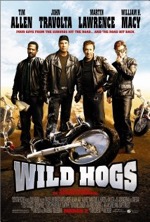
Starring: Tim Allen
March 2007
“Sits in Idle Waiting for a Story to Show Up”
Something happens to a man when he wakes up one day and realizes his face is starting to show wrinkles, his hair is beginning to turn gray or loose and gravity is doing a number on his belly, transforming the once glamorous six-pack into a keg. It suddenly dawns on him that there are fewer days ahead than behind and that there’s a long list of things he still wants to accomplish in his lifetime. Invariably, one item on the list is a cross-country trip on a Harley.
And so we have Wild Hogs; a comedy (and I use that word loosely) about four middle-aged men seeking thrills and excitement outside their ordinary lives and dead-end jobs. Doug (Tim Allen), Woody (John Travolta), Dudley (William H. Macy) and Bobby (Martin Lawrence) don motorcycle gear, throw away their cell phones and set off on a journey of self-discovery and male bonding. The road trip starts off rather aimless, but quickly gains focus and immediacy when the four amigos stop off at a bar infested with members of a notorious biker gang known as the Del Fuegos. The balance of the movie focuses on the Wild Hogs’ cowardly attempts at evading the Del Fuegos, but at the appointed time the Hogs develop a collective backbone and stand up to the antagonizing gang, thus satisfying their jones for adventure and fulfilling the story’s promise that the four men will be revitalized as a result of their two-wheel trek.
Wild Hogs was made-to-order for Allen, but Travolta’s participation, and to a greater extent, Macy’s, is a bit of a head-scratcher. The leads are appropriately automatic, if excessively melodramatic, and there are some solid supporting performances turned in by Ray Liotta, Marisa Tomei and Peter Fonda. Liotta’s portrayal of the spitting-mad leader of the Del Fuegos is the standout performance in the film, which is pretty sad when you think about it.
Wild Hogs is an abhorrent film with a paper-thin plot and over-the-top performances that squander the talents of the high profile cast. The movie is neither humorous nor insightful and is an egregious waste of time. Written by Brad Copeland, the story consistently defaults to the silly and absurd, which is a shame since the topic of a mid-life crisis could have retained elements of comedy while offering more depth and meaning in the script department.
Anyone who’s frustrated when art films languish while mediocre fluff wins big at the box office will be driven to the brink of insanity by Wild Hogs. The movie is essentially The Wild One or Easy Rider written by a middle school student.
Rating: 1 1/2
Music and Lyrics (PG-13)
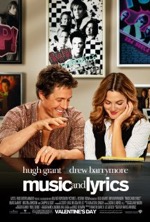
Starring: Hugh Grant
February 2007
“Romantic Melody with Dramatic Harmony”
Prosody. It’s a word music producers toss around that refers to the perfect marriage between lyrics and music. The characters in writer/director Marc Lawrence’s new film, Music and Lyrics, desperately search for prosody, both musically and relationally, and find a rare blend of artistry and intimacy over and under the piano.
Alex Fletcher (Hugh Grant), the former lead singer of the mullet-coifed 80’s group, Pop, has been commissioned to write a song for Cora (Haley Bennett), the newest sensation in pop music (think Britney but more seductive…if that’s possible). Cora gives Alex the hook line and tells him to deliver the song by Friday; Alex clears his schedule, gladly canceling a guest spot on the TV series, “Battle of the 80’s Has-beens.” Alex, who has no skill at writing lyrics, calls upon one of the industry’s finest lyricists to bail him out; but when it becomes painfully obvious that the partnership isn’t working, Alex turns to the substitute plant lady, Sophie (Drew Barrymore), who absentmindedly raps off some lines that perfectly fit the song while watering the petunias.
Alex and Sophie immediately hit it off and even though you can divine early on where the story is headed, credit Lawrence with making Alex and Sophie’s lovelorn journey a bumpy and unconventional one. In fact, the most enjoyable aspect of the movie is that the romantic interludes take a backseat to the compelling drama, which skillfully steers the plot. Case in point: there’s an excellent scene where Sophie tells Alex her back story over breakfast in a quaint bakery—it’s one of those magical moments which, unfortunately, are seldom given the chance to develop in most modern movies where special effects, not character development, rule the day.
As joined at the hip as the music and motion picture industries are, it’s refreshing to see a movie portray the music business honestly and unapologetically. Alex’ commentary at Cora’s pre-recording party—where he bursts Sophie’s idealistic bubble—is harsh but accurate, “In the end it’s all just business.” The thinly veiled caricature of Cora as a Britney/Christina/Shakira clone is perhaps a bit exaggerated but reveals the selfish tendencies and shallow propensities of many spoiled rotten pop stars who seem to make headlines (often negative) every day. Cora’s sensual, Indian-flavored songs were clearly written as tongue-in-cheek parodies of modern hits, but how similar are they to the vast majority of uninspired, cookie-cutter tunes that dominate today’s pop charts? It’s in these brilliantly insidious scenes where the screenplay is most instructive and effective. Unfortunately, the movie’s solid setup gives way to a standard happy ending that’s sure to make women sigh in ecstasy and men groan in agony.
Barrymore is in familiar territory here, and though she’s convincing, isn’t she getting just a bit typecast with these one-size-fits-all chick flicks? Could it be that there’s more in her than lighthearted dramedies? As for Grant, he simply steals the show with his charisma, charm and quick wit; his comedic timing is impeccable and his dramatic range is also impressive. The film is also augmented by its superb supporting talent: Brad Garrett takes on the role of Alex’ overprotective agent and Kristen Johnston plays Sophie’s sister, a lifelong Pop fan who absolutely worships Alex…especially when he’s in his tight black leather pants.
Music and Lyrics is a slightly better-than-average romantic comedy that strikes all the right notes with great performances and incisive dialogue. Whether or not the movie has achieved prosody, however, is a matter of opinion—after all, art, and especially music, is anything if not subjective.
Rating: 2 1/2
Because I Said So (PG-13)
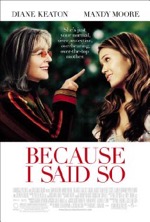
Starring: Diane Keaton
February 2007
“‘Because I Said So’ is Not Sufficient Reason to See it”
Boasting a decorated cast and an estrogen-infused screenplay, Because I Said So tells the story of a meddling mother and her three beautiful daughters; one married and two in desperate need of mom’s services as self-appointed matchmaker.
Daphne Wilder (Diane Keaton), an overbearing, overprotective divorcee, feels it incumbent upon her to find a husband for her listless and lovelorn daughter, Milly (Mandy Moore). Daphne takes a cue from MTV’s Date My Mom by interviewing prospective mates for Milly; young men who are responding to an online profile Daphne filled out for her daughter. The hapless suitors, expecting to meet Milly at an exclusive restaurant for lunch, unwittingly fall into Daphne’s web of control and are grilled about their respective careers, interests, political/ religious views, etc. As usually happens in these instances, Daphne selects someone she loves, Milly is unsure about and the audience absolutely loathes.
Lauren Graham and Piper Perabo are solid in their supporting roles as Milly’s sisters and Stephen Collins is functional as Daphne’s new beau, Joe. The acting can’t be faulted, nor can Michael Lehmann’s direction. The movie’s failure falls squarely on the shoulders of writers Karen Leigh Hopkins and Jessie Nelson, who’ve churned out one inconsequential piece of tripe here…the story is as shallow as the characters it features. When the dialogue isn’t inane, it’s filled with crude remarks and potty humor. References to reproductive organs or anything pertaining to human reproduction flow as easily from the female characters in the movie as a conversation would in a men’s locker room. Such is the movie’s degrading sense of humor, which relies on peer pressure to produce laughs because very few people would naturally chuckle at punch lines so crass and depraved. In fact, any laughter that does occur during the movie, judging from the audience I sat in, is reserved, forced or halfhearted.
Other than Milly’s wedding at the end, there’s an utter lack of progression in the film, and it’s obvious that Daphne’s supposed reformation will be short-lived. As for Keaton, her shelf-life as a leading lady may have just expired. Besides the fact that she’s starting to show her age, the normally stellar starlet steps beyond the boundaries of believability with a one-dimensional performance marked by emotional extremes in over-the-top scenes. Keaton can’t be blamed for the obnoxious character she portrays, be she can be faulted for selecting the role in the first place. If Daphne has any redeeming characteristics, they’re harder to find than a mate for Milly; especially when one considers the scenes where Daphne tails Milly on a date, views porn at home or holds up Milly’s wedding because she’s doing the horizontal mambo with Joe.
If Moore ever hopes to be taken seriously as an actress, she must resist the impulse to take the easy path and accept roles like the one she effortlessly slips into here. Of course, changing the course of her career at this point could be tantamount to steering the Titanic around an iceberg. And we all know how that ended. If she’s not extra careful, she could end up typecast…if she isn’t already?
Because I Said So is the kind of movie that gives chick flicks a bad name; it’s crude, simplistic and unsophisticated. Daphne’s erratic behavior and controlling nature are finally explained when she confesses to Milly, “I just wanted to protect you from becoming me.” I’ll protect you by issuing this warning: avoid this movie at all costs. Why? Because I said so!
Rating: 1 1/2
Night at the Museum (PG)

Starring: Ben Stiller
December 2006
“One of Our T-Rex’ is Missing”
All too frequently these days, movies are ruined by comprehensive trailers. Serving as a visual Cliff Notes version of the film, said trailers spell out the plot and leave little to the imagination…and little reason to shell out a ten spot to see the picture. Of the recent movie-spoiling trailers, the Ben Stiller vehicle, Night at the Museum, is the worst offender of all, revealing nearly every major plot point in the preview. As egregious as that is, it’s an even greater tragedy that the movie fails to build on what, at first glance, appeared to be a highly entertaining, crowd-pleasing comedy/adventure.
The movie’s premise is elementary, much like the plot: Divorced dad, Larry (Stiller), keeps moving laterally from one dead-end job to another and has more money-making schemes than Ralph Kramden. Despite his best efforts to be a hero to his preteen son, Nikki (Jake Cherry) he always comes off looking like a schmuck. Desperate for employment, Larry takes a night security position at the Museum of Natural History in NYC to appease his landlord and ex-wife (24’s Kim Raver). In an unpopular move made by management, Larry is replacing three dotting guards: Cecil (Dick Van Dyke), Gus (Mickey Rooney), and Reginald (Bill Cobbs). Before cleaning out his locker, Cecil gives Larry this piece of advice, “Don’t let anything in or out!”
Larry’s first night on the job is uneventful until he notices the vacated T-Rex dais. A tour around the labyrinthine hallways confirms his worst fears…everything in the museum is alive! The chaos that ensues is tantamount to Jumanji in a museum. I mention Jumanji here because of its thematic and structural similarities to Night at the Museum and because its star, Robin Williams, appears here as Theodore Roosevelt, the person Larry turns to for wisdom and assistance when all Valhalla breaks loose.
After five minutes of mischievous monkeys, aggressive lions, defiant pygmies, talking sculptures and belligerent Huns, I had climaxed on the menagerie mayhem conceit and was ready to see something, anything else. Unfortunately, the rest of the movie, save one twist near the end, focuses solely on the enchanted museum and the anarchy that exists from midnight to dawn…at which time everything in the museum magically “resets.”
Character development is exceedingly tenuous and the story written by Ben Garant and Thomas Lennon (based on the book by Milan Trenc), is so pedestrian that it sabotages any possibility for enjoyment. Stiller’s shtick is growing more tedious by the movie and Williams fails to salvage the film with his heartfelt turn as Roosevelt; perhaps because the erstwhile prez makes too many sermonizing speeches and has voyeuristic tendencies where Sacajawea (Mizuo Peck) is concerned.
As the movie closes, Larry supervises a wild party in the main lobby; the museum denizens have finally learned how to peacefully co-exist. Such movie-ending revelry worked like a charm in Shrek, but here the celebration seems contrived and more than just a little bizarre. It’s a shame that the word bizarre has to be applied to a movie that seemed primed to become the newest sensation to sweep the comedy genre. Guess it just goes to show that you can’t judge a book by its cover…or a movie by its trailer.
At one point, while dealing with escaped animals and blood-thirsty natives, Larry remarks, “This is so not worth $11.50 an hour.” Neither is forking out $9.50 for two hours of this!
Rating: 2
Charlotte’s Web (G)
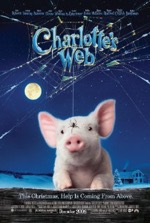
Starring: Dakota Fanning
December 2006
“Delightful Tale Affirms the Miracle of Friendship”
According to Greek mythology, King Midas could transform anything into gold simply by touching it. Precocious twelve-year old actress, Dakota Fanning can do the same with movies. Don’t believe it? Name one Fanning film that was a flop. It certainly isn’t her latest project, the wistfully dreamy live-action version of E.B. White’s classic children’s book, Charlotte’s Web.
In the movie Fanning plays Fern, a prepubescent powerhouse whose deep personal convictions drives her to defend a runty pig from being slaughtered. Raising the pig on her own, Fern names the undersized porker Wilbur (voiced with the perfect degree of childlike innocence by Minority Report’s Dominic Scott Kay). Fern and Wilbur are inseparable during the long, lazy summer months, but with the onset of fall, Fern is forced to sell the pig to the neighbors after an ill-fated attempt to conceal the pig in her school desk lands her in trouble with teacher and parents.
The neighbor’s barn is filled with talking animals whose personalities are as diverse and colorful as a rainbow. Separated from Fern, Wilbur tries making friends with his stall mates; the leader of three aimless sheep (John Cleese), two quarreling geese (Oprah Winfrey and Cedric the Entertainer), a pair of gossipy cows (Kathy Bates and Reba McEntire), two cowardly crows (Thomas Hayden Church and Andre Benjamin, who provide intermittent comic relief a la Skrit in Ice Age), a skittish horse (Robert Redford) and a selfish, hoarding rat named Templeton (Steve Buscemi), but none of the animals seem overly eager to make Wilbur’s acquaintance. In the throes of loneliness, Wilbur finally finds a friend; gracefully descending from a silken thread, the wise and compassionate arachnid, Charlotte, introduces herself to the pig. When the other animals taunt Wilbur, calling him a “future football,” Charlotte promises the innocent spring pig that he’ll live long enough to see winter’s first snow. How Charlotte and the other animals accomplish that feat is, as Paul Harvey would say, the rest of the story.
I’m ashamed to admit that I never read Charlotte’s Web as a youth and only remember snippets of the animated film released in 1973. Expecting something far more pedestrian, I was pleasantly surprised by a genuinely human story that reinforces the immutable virtues of friendship, courage and selflessness.
Fanning’s contribution to the film cannot be overstated, but equally vital are the pitch-perfect vocal deliveries by the entire cast, with highlights provided by Kay, Buscemi and Roberts. Roberts brings elegance and compassion to, arguably, the most loathed creature on the planet; Charlotte’s appeal is further enhanced by the CGI artists who make Charlotte’s face appear more sympathetic and less sinister than a real-world spider. Though Wilbur is the central character, the story is called Charlotte’s Web, and a large part of the movie’s success is due to Roberts’ affectionately soothing vocal performance that puts the spot in spot-on.
Charlotte’s Web is some movie; a delightful escape to a younger, simpler age, when summers were eternal and having adventures in a nearby wood was a full-time job. Director Gary Winick has paid faithful tribute to E.B. White’s book, while also delivering one fine piece of cinema. From the casting to the acting and from the talent in front of the camera to the wizards frantically working behind the scenes (especially on the breathtaking web-weaving sequences), every element of Charlotte’s Web is painstakingly and lovingly crafted...passion for the project and reverence for the source material is evident in every frame. This is one humble pig that deserves to take a bow.
Rating: 3
The Holiday (PG-13)

Starring: Kate Winslet
December 2006
“Emotionally Satisfying Rom-Com Delivers Seasonal Cheer”
Iris (Kate Winslet), a columnist living in England, gives her ex-boyfriend Jasper (Rufus Sewell) a present but he fails to reciprocate, barely acknowledging her existence at an office Christmas party. Though recently engaged to another woman, Jasper still professes his love for Iris. For obvious reasons, Jasper wants to keep Iris on the hook. Though she despises his philandering ways, Iris is utterly blind to her emotional dependence upon Jasper and holds on to a desperate hope of getting back together with him. Exasperated, Iris comes to the conclusion that she needs a break from her life.
Amanda (Cameron Diaz) is a self-assured movie trailer editor, who lives in L.A. After breaking up with her pigheaded boyfriend (Edward Burns), Amanda just wants to leave her troubles behind for a while. While searching for vacation destinations online, Amanda discovers a house swap option that gets her wheels turning. After an extensive IM conversation, Amanda and Iris agree to swap houses for the holidays.
If that oversimplified plot outline didn’t grab you, I urge you to disregard my Jack and Jill synopsis and give The Holiday a chance to warm your heart with its sincere performances, emotionally complex story and astounding direction by Nancy Meyers (The Parent Trap). Meyers is a master at gradually layering characters’ emotions which yield intense payoffs later in the film. She can even achieve such satisfying results with shallow characterizations such as Sewell’s unrepentant boor. Despite the occasional schmaltzy scene or line of dialog, the film is deeply moving in ways more subtle than obvious.
You would naturally and justifiably expect a lot out of a cast including Diaz, Winslet, Jack Black and Jude Law, and they all live up to their billing, especially Black, who turns in his most endearing performance as a movie composer…very few actors could’ve pulled off the “accidental boob graze” scene with as much charm. Additionally, the scene where Miles (Black) serenades Iris in a video store is an instant classic (keep an eye out for a Hollywood mega-star, who gets one of the biggest laughs in the film).
What puts it over the top for me is a subplot focusing on Iris’ serendipitous friendship with a retired motion picture screenwriter named Arthur Abbott (Eli Wallach). Abbott’s commentary on the current state of Hollywood, in light of its glorious past, is a fascinating aside that Meyers didn’t have to include, as it has very little bearing on the overall story. The fact that Meyers took the time to develop this storyline, along with all of the leading characters, is what differentiates this project from the run-of-the-mill rom-coms that seem to pop up like weeds at the Cineplex these days. Meyers’ screenplay has some meat, some meaning, along with healthy doses of comedy and romance.
Words sometimes fail when attempting to describe The Holiday because it’s a movie that has to be experienced, not merely discussed. There’s a lot of movie magic here, which hopefully will translate into generous box office. With instant name recognition and A-list headliners, here’s hoping The Holiday will be cherished as a seasonal favorite for many years to come. For those who appreciate intuitive direction, believable performances and organic writing, Christmas has come early this year.
Rating: 3 1/2
Deck the Halls (PG)

Starring: Matthew Broderick
November 2006
“Fa, la, la, la, la…ha, ha, ha, ha!”
Holiday movies focusing on feuding families/neighbors are a dime a dozen and are generally worth about the same amount. These films usually fall into one of two categories: 1. Neighbors attempt to outdo each other in decorating their houses, or 2. Visiting relatives disrupt the status quo, putting family members at each other’s throats until someone shouts above the din and reminds everyone about the true meaning of Christmas. Although Deck the Halls, starring Danny DeVito and Matthew Broderick, has elements of both scenarios, the movie contains just enough originality to break free from the cookie-cutter rigidity of such Holiday rejects as Jingle All the Way and the Home Alone sequels.
Steve Finch (Broderick), a mild-mannered optometrist, is the Winter Fest coordinator and is known about town as “Mr. Christmas.” His title and reputation are immediately challenged when Buddy Hall (DeVito) makes a late night move into the house across the street (“Who moves in the middle of the night,” Steve asks his barely conscious wife, “a meth lab?”). Buddy, a struggling car salesman who rapidly looses interest in any new experience, has fallen into the pattern of moving from place to place, job to job and obsession to obsession. Despite Buddy’s repeated attempts at finding a lasting happiness, fulfillment in life continues to elude him. Buddy confesses to his wife that he’s always wanted to “do something big…something monumental.” Buddy’s impetus comes when his two Barbie doll daughters introduce him to a computer program that can pinpoint every house on the planet from space…every house, of course, except for theirs. Buddy’s new ambition is to make his house bright enough to be seen from outer space.
Threatened by Buddy’s instant popularity (people are coming from miles around to see Buddy’s extravagant light show), Steve does everything in his power to prevent Buddy from seeing his dream come to fruition, including sabotaging Buddy’s display by throwing a snowball at the exterior circuit panel. However, Steve fails to account for Buddy’s backup generator, which kicks in a short time later and brings the thousands of scintillating light bulbs back to life. When Buddy discovers Steve’s perfectly placed snowball and when Steve discovers that Buddy has been stealing power from his house, the gloves come off and both men engage in a war of subversion and chicanery. Fed up with Steve and Buddy’s petty rivalry, Steve’s wife Kelly (Kristin Davis) and Buddy’s wife Tia (Kristin Chenoweth) both pack up and head for a hotel. Faced with a life-altering decision, Steve and Buddy must either choose to sober up and make amends or continue with their childish quarreling and risk loosing everything they hold dear.
A cursory character study reveals Steve as a tradition-bound stiff who just wants peace and quiet, and Buddy as a conniving, obnoxious glory-hog who just wants to be noticed. Together, the characters, and the actors who portray them, create a unique brand of contentiousness that recalls, but certainly doesn’t supersede, Matthau and Lemmon’s incisive bickering in such movies as Grumpy Old Men. The leads have excellent chemistry together; DeVito is his usual zany self, but Broderick’s dead-pan delivery is sidesplittingly hilarious. Both Kristin’s do excellent work as the disgruntled wives, and I’m gratified that director, John Whitesell, put Chenoweth’s considerable vocal talents to good use on “Oh, Holy Night.”
Though it’s not as humorous as A Christmas Story or as heart-warming as Miracle on 34th Street, Deck the Halls is a diverting popcorn flick and is a worthy entry into the vast catalog of feel-good Holiday treats. With this, yet another film that was named after a Christmas song, one wonders when we’ll see the movie version of “Grandma Got Run Over by a Reindeer.”
Rating: 2
Happy Feet (PG)
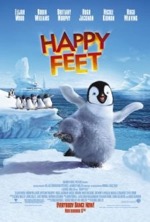
Starring: Elijah Wood
November 2006
“Heavy-Handed Politics Leaves ‘Feet’ Flatfooted”
The last time I saw an animated movie this political was FernGully: The Last Rainforest (1992). An indoctrination session for the New Age movement, the movie extols the mystical energies that govern the “circle of life,” while vilifying the humans responsible for deforestation and upsetting nature’s delicate balance. On the face of it, Happy Feet is a seemingly innocent, completely innocuous animated film, whose only apparent pretension is that it comes too soon on the heels of 2005’s surprise hit documentary, March of the Penguins—but as we all know, appearances can be deceiving. For anyone who’s seen March of the Penguins, the opening chapter of Happy Feet will feel like a prolonged bought of déjà vu, complete with plagiarized narrations and scenes that look like they were lifted right out of the documentary.
Early on, the movie focuses on Mumble’s (Elijah Wood) desperate attempts to fit in with his peers; Mumble can tap-dance like Fred Astaire, but his singing resembles a blaring foghorn. One adult penguin, who looks down on the misfit youth, charges, “A penguin without a heart song is no penguin at all.” Excluded from many normal activities—much like that famous reindeer we’ve all sung about—Mumble often steals away to a nearby glacier and tap-dances by himself, away from disapproving eyes.
Somewhere along the way, the movie’s depiction of an outsider with abnormal development becomes a thinly veiled reference to homosexuality. The scene where this becomes painfully obvious is when Mumble teaches his peers how to tap-dance; the old guard vehemently opposes the new form of artistry, viewing it as an uprising, an aberration and a pagan display. When Mumble’s father implores his son to desist with his peculiar dancing, Mumble replies, “Don’t ask me to change, pa’, because I can’t.” With that, Mumble is banished from the penguin community.
A short time later, mumble is befriended by a quintet of diminutive, Latin-speaking penguins; awed by Mumble’s skillful dancing they welcome him into their group with open flippers. (As a pertinent aside, George Lucas was widely criticized for creating aliens with Asian accents in Star Wars: Episode I, but in Happy Feet, where ethnic speech stands out like Mumble’s blue eyes, no one, especially the liberal left—to whom the film heavily panders, has said a word about the obvious racial stereotyping.) Mumble and the Latin penguin entourage team up with Lovelace (Robin Williams), a kind of charismatic prophet who wears a plastic six-pack holder as a necklace.
As the ragtag group goes in search of “aliens”—the mysterious beings who gave Lovelace his necklace—they soon discover huge warehouses, docks, heavy equipment and colossal fishing boats. It’s at this point when humans are revealed as not only the aliens, but also as the villains of the movie; apparently humans have been stealing scores of fish from local waters and leaving the penguins with empty stomachs. Captured and imprisoned in an arctic exhibit, Mumble makes repeated attempts at communicating with his human captors, but his animal vocalizations fall on uncomprehending ears, “Why are you taking our fish? You’re kind of killing us out there!”
In order to keep from going crazy, Mumble learns to entertain spectators with his fancy footwork, which immediately draws the attention of the scientific community. Mumble is implanted with a tracking device and released from captivity: A film crew follows Mumble back to his home and captures footage of the penguins dancing in Mumble’s soulful style. Once assembled and released, the documentary creates a political and public outcry which leads to a moratorium being placed on fishing in the waters near Mumble’s glacier. The movie’s final shot tracks a penguin feather as it’s carried along by the wind in a gliding, meandering course, much like Robert Zemeckis’ free-flowing feather at the conclusion of Forrest Gump. Coincidence? I don’t think so!
Where Forrest Gump is existential, Happy Feet is environmental. In fact, the movie’s political slant is so transparent and so in-your-face, it’s almost nauseating. How cowardly of leftist Hollywood and environmentalist wackos to use an animated film to espouse, disseminate and otherwise foist their alarmist and fear-mongering doctrine upon audiences; offending many adults and unduly influencing the minds of future generations with a “green” theology.
The localized and oversimplified climax is utterly laughable…one dancing penguin can save the planet? One colony of dancing penguins can change international policy? I’m sure even older children can discern that they’re being sold a load of penguin droppings. And it’s really children who are loosing out the most here; for their sake, why can’t Hollywood check its politics at the door and let kids make up their own minds about where they stand on environmental issues…when they’re old enough to do so?
The real tragedy with Happy Feet is that, politics aside, the film is a visual marvel—the next evolutionary leap in CGI. The leopard seal chase is an exhilarating thrill ride of evasive maneuvers and narrow escapes and the killer whale sequences are absolutely breathtaking. Also, the movie’s vocal talents are stellar, though it seems as if every other character is voiced by Robin Williams, and that gets a tad tedious.
Happy Feet would’ve been so much better had it simply concentrated on being an animated kid’s film and not on being a stilted soapbox lecture on global correctness; the heavy-handed sermonizing severely detracts from what otherwise would have been a highly entertaining family film. So, as Mumble would say, I appeal to Hollywood’s better nature and officially request that they refrain from producing films, especially animated ones, which are nothing more than a political platform for some special interest group to use in propagating their misguided message to a mass audience. Just as there’s a separation of church and state, I propose a separation of politics and media. It probably would never work, but what the heck, we might just get objective news out of the deal.
Rating: 2
The Santa Clause 3: The Escape Clause (G)

Starring: Tim Allen
November 2006
“Third Time Isn’t the Charm for This Freezer Burned Sequel”
I didn’t much care for The Santa Clause, starring Tim Allen, and skipped the sequel on purpose. I was willing to give this new film, entitled The Santa Clause 3: The Escape Clause, a fair shake, mostly because of Martin Short’s inclusion in the cast. Going in with a reasonably open mind, I was sorely disappointed in a comedy that not only lacked humor, but also featured an insufferably childish storyline.
As the movie opens, we learn that Scott Calvin/Santa’s (Allen) wife, Carol Calvin/Mrs. Clause (Elizabeth Mitchell), is pregnant. Carol wants her family by her side during the delivery, but the Clause’s can’t exactly reveal their true identities or the secret location of the North Pole. Someone (probably that chunky Spencer Breslin kid who seems to find his way into every Tim Allen movie these days) comes up with the idea of passing off the North Pole as a Canadian village simply by changing the signage and closing off top-secret areas. The Sandman (Michael Dorn) puts Santa’s in-laws, Bud (Alan Arkin) and Sylvia (Ann-Margret), to sleep and Santa ferries them to “Canada” in his renowned sleigh.
Meanwhile, Jack Frost (Short) is brought before the Council of Legendary Figures and is sentenced to manual labor in Santa’s workshop for his crimes (not legendary for their wisdom, it would seem): predictably, Frost wastes no time in sabotaging the factory. Frost’s end game is to steal Santa’s special snow globe and trick him into saying, “I wish I wasn’t Santa,” which is the extent of the Escape Clause. After accomplishing his task, Frost grabs Santa’s coat and becomes the new Santa. Before you can say “Blitzen” Frost converts the North Pole into a Vegas-style resort where myriad vacationers swarm to shops, shows and restaurants, fighting over merchandise and steamrolling anyone who gets in their way. Scott, the deposed Santa, must beat Frost at his own game to retain the mantle of Santa and restore Christmas to its former glory.
This was the point in the film where I actually felt like it had the potential to go somewhere, but almost before the problem is presented, it’s elegantly resolved by a plan the audience can see coming a mile away: Scott’s telegraphed solution is packaged, wrapped and tied up with a pretty little bow. How convenient. How contrived.
As poor as the script is, the movie’s biggest tragedy is how such a decorated cast could be relegated to acting in such pedestrian fare. However, if there’s one aspect of the movie that shines like Rudolph’s nose, it’s the highly creative, finely-detailed set pieces that festoon the various incarnations of the North Pole. In many ways, the sets are reminiscent of those crafted for Dr. Seuss’ How the Grinch Stole Christmas, sans Seuss’ skewed visual style.
Disney forbid there should be a Santa Clause 4, but if another sequel should slide down the Hollywood chimney in the near future, one can only hope that the script shows a marked improvement over the one presented here—that would be the best gift of all.
Rating: 1 1/2
Flushed Away (PG)
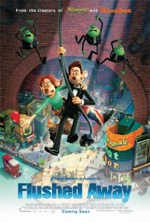
Starring: Hugh Jackman
November 2006
“Take the Plunge…It’s Tons of Fun”
From Aardman Animations (producers of Chicken Run and Wallace and Gromit in The Curse of the Were-Rabbit) and DreamWorks Studios comes Flushed Away, a high-spirited romp that transports spectators from London’s upper-crust suburbs to its slug-infested sewers. A modern twist on The Prince and the Pauper, Flushed Away features jaw-dropping animation (this is the studio’s first entirely CG film) and upholds the tradition of excellence established in Aardman’s finely crafted Claymation films.
As a well-mannered, well-cultured and well-groomed house rat, Roddy (Hugh Jackman) has it all; he can cruise around in a R.C. car with a beautiful blonde doll, play a one-sided tennis match with inanimate players and create imaginary conversations with action figures in a play set café. As a pampered pet in an uptown flat, Roddy has the freedom to do whatever he wants, but his existence is a shallow one because there’s no one with whom he can share his staged and synthetic adventures. Capping off another hollow day, Roddy tucks himself into a dollhouse bed and wonders what it would be like to have a real family and friends. As loneliness consumes him, Roddy hears a noise down the hall and gets up to investigate; he discovers Sid (Shane Richie), an obese, ill-mannered sewer rat who makes himself at home in Roddy’s immaculate penthouse apartment. Roddy’s attempt at tricking street-smart Sid into returning to the sewer backfires when Sid shoves Roddy into the “jacuzzi” and pulls the lever.
When Roddy hits the bottom, he discovers a whole new world, but it’s nothing like the one Jasmine sings about in Aladdin; prim and proper Roddy gets a taste of how the other half live when he enters a sludge-filled sewer. Roddy soon stumbles into a subterranean city, dubbed Ratropolice, which is managed and inhabited entirely by sewer rats. As he embarks on a homeward journey, Roddy encounters Rita (Kate Winslet), captain of the scavenger vessel Jammy Dodger and the rat-loathing villain named The Toad (Sir Ian McKellen). Before he can return to the comfortable, sanitary, yet lonely environs of his owner’s mansion, Roddy must survive hair-raising pursuits through sewer passageways, evade Le Frog (Jean Reno), the French assassin and his ninja frog cronies, and foil The Toad’s plans to turn Ratropolice into a giant deep freeze.
Each of these Aardman movies has a “pandemonium sequence” (PS), which usually kicks in toward the end when forces collide and the action is ratcheted up to breakneck pace. In Chicken Run, the PS comes when the collective fowl desperately try to lift-off in their makeshift plane, and in Wallace and Gromit, the PS occurs when the true identity of the Were-Rabbit is revealed and everyone tries to capture him/it. Though Roddy and Rita’s climactic showdown with The Toad and his two rodent lackeys (Bill Nighy and Andy Serkis, who deliver pitch-perfect vocal performances) is exciting, the action never quite approaches the heights of frantic insanity achieved during the pandemonium sequences in those other two Aardman films.
Despite the tepid climax, there are some great moments in the movie, like Roddy’s introduction to Rita’s Brady-Bunch-on-speed family at their shifty, wave-tossed house or the high-speed chase where French frogs pursue the Dodger on cake mixers, or the intermittent comic relief provided by the show-stealing, serenading sewer slugs? Though it tells a touching tale about the necessity of friendship, the movie is noticeably more remedial than Aardman’s previous efforts; however, since the movie’s target audience is kids, that’s not such a bad thing and there are plenty of elements in the film that adults will enjoy as well. In the end, the movie is heartwarming and highly entertaining, but not necessarily award winning. Some may smell a rat here, but I still maintain that Flushed Away is a family friendly, fun-filled caper that should give us all a newfound respect for sewer workers.
Rating: 2 1/2
Click (PG-13)
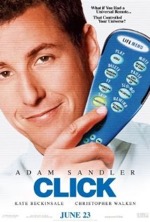
Starring: Adam Sandler
June 2006
“Not Even Remotely Entertaining”
The word tripe, as defined by Merriam Webster, is: something poor, worthless, or offensive. This definition more than adequately describes Adam Sandler’s Click. Finding even one redeeming quality in the movie would make hunting for a needle in a haystack an enjoyable pastime. Many of the movie’s themes and gags are abhorrent (i.e., the family dog repeatedly humping a large stuffed duck), and potty humor runs rampant throughout this severely modernized and significantly dumbed-down variation on Charles Dickens’ classic A Christmas Carol. Click, much to its detriment, suffers from the same brand of lowbrow idiocy that seems to plague the majority of Sandler’s films.
The story focuses on one man’s struggle to juggle the various aspects of his life; family, work, recreation, hobbies, etc. Michael Newman (Sandler) just can’t seem to get it right; the more he tries to organize his life, the more he falls behind and the angrier he becomes. But everything changes the day he falls asleep on a demo bed in a Bed, Bath & Beyond store. Waking up, Michael sees a door marked “Way Beyond.” Opening the door, Michael enters a gigantic warehouse filled with crates, a la Raiders of the Lost Ark, and meets eccentric scientist, Morty (Christopher Walken). Morty has the solution to Michael’s chronic busyness; a remote control that can control Michael’s life…remotely.
At first, Michael has so much fun with the remote control—he pauses a conversation with his boss (David Hasselhoff) and gives the man a migraine by slapping him silly, adjusts the color to make himself look like the Hulk and fast-forwards through whole arguments with his wife—that he fails to see its detriments. As time continues flying by and the remote’s preference mode skips ahead to major events in his life, Michael realizes he’s missing out on meaningful moments with those he holds most dear.
Though I can appreciate the film’s carpe diem sentiment, I just can’t abide Michael’s selfish preoccupation and obnoxious behavior; both character flaws are off-putting and significantly undermine Michael’s status as protagonist. While the movie’s moral is universally relevant, the story’s execution is ill-conceived and overly pedestrian. Still, the greatest narrative crime committed in the remedial screenplay, written by Steve Koren and Mark O’Keefe, is the utilization of the notorious “it was only a dream” twist…we can forgive Dickens for using it, but no such grace can be extended here.
Click passes up on a prime opportunity to tell a truly poignant tale and also squanders quality supporting performances by Kate Beckinsale, Sean Astin and Henry Winkler. Some will consider Click quality entertainment, but for me, I’d rather change the channel.
Rating: 1 1/2
A Prairie Home Companion (PG-13)
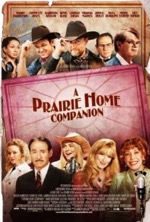
Starring: Lily Tomlin
June 2006
“Fitting Tribute to Keillor’s Off-Kilter Variety Show”
My first exposure to Garrison Keillor was in the early 80s when I watched his “A Prairie Home Companion” variety show every Saturday night on the Disney Channel. As a teen I thought GK (as Keillor is frequently referred to in the movie) was dry and boring, and yet I found myself frequently chuckling at the exploits of the down-home folk of fabled Lake Wobegon, MN, where “the women are strong, the men are good-looking and all the children are above average.”
Much like the actual show, Robert Altman’s A Prairie Home Companion is a bizarre effort. The movie centers on the program’s final show, which is broadcast over the radio and also performed in front of a live audience at the F. Scott Fitzgerald Theater in downtown St. Paul, MN. The film’s synergistic appeal is due largely to the variegated acts that take place on stage as well as the wonderful character moments behind stage and in the dressing rooms, all of which unfurl in real-time.
Take security man Guy Noir (Kevin Cline) for instance; all of his bits are fittingly shot in a film noir style as if he’s a kind of backstage detective. And then there are the Johnson sisters, Yolanda (Meryl Streep) and Rhonda (Lily Tomlin), who very nearly steal the show with their witty, fast-paced dialogue and amusing anecdotes. Yolanda’s daughter, Lola (Lindsay Lohan), has a few scenes, but doesn’t really factor into the story in any significant sense. Two singing cowboys, Dusty (Woody Harrelson) and Lefty (John C. Reilly) bring the house down with their naughty, bawdy, rip-roaring song, “Bad Jokes.” The Academy will officially put the T in travesty if “Bad Jokes” isn’t nominated for an Oscar—the song is the undisputed highlight of the film.
Tommy Lee Jones plays Axeman, the stiff suit sent to shut down the show after its final performance. Axeman is the closest thing the movie has to an antagonist, but other than providing occasional reminders about the show’s demise, the character doesn’t add much to the film. The most avant-garde element in the movie is the mysterious appearance of The Dangerous Woman, played by the lovely Virginia Madsen. Living up to her name, the blonde, white-gowned beauty is a major departure from the traditionally-drawn grim reaper with dark robe and scythe. The Dangerous Woman will claim someone’s life by the end of the night, a dreadful realization that creates ample tension while raising the question: Which character will become her unwitting victim?
Altman (Nashville) was a natural choice to helm this project; few directors can rival his attention to detail and character or approach his genius at taking everyday situations and presenting them as new, unique or quirky reflections of reality. A Prairie Home Companion, like many of Altman’s films, is a cinematic odd bird, but it’s also charming and inspiring in subtle ways. Due to the movie’s singular focus, limiting locale and real-time narrative, some spectators might get antsy toward the middle of the film. Though most of the vignettes are entertaining, the movie has an accumulative resonance, the full impact of which can only be experienced when reflecting on the film as a whole.
A Prairie Home Companion succeeds at honoring Keillor’s variety show while wistfully whisking us back to the mythical and magical days of early Americana; where neighbors were neighborly, deals were made with a handshake and families sat around a box to be entertained at night: Radio, not TV. Keillor’s eclectic program will forever be remembered as a conduit to an earlier, simpler time when folks lived, loved and died...somewhere out on the prairie.
Rating: 3
Cars (G)
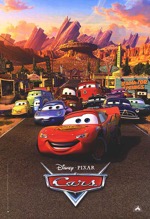
Starring: Owen Wilson
June 2006
“High-Octane Joyride Leaves Other Animated Films in the Dust”
I have to admit it…I’m one of those rare guys who just isn’t into cars. I know how to change an air filter, but that’s the extent of my automotive prowess. My windshield wipers need to be replaced, but I keep procrastinating; putting it off for a rainy day. The NASCAR gene skipped me and went to my older brother, Mike. Growing up, I remember particular Sundays when Mike would sit on the couch all afternoon and watch an entire three hour motor-fest (more times than not, he’d drift off to sleep midway through the race). It fascinated me to no end that a person could be perpetually entertained by different colored cars going in circles for hours on end; then again, I’ve been known to spend the same amount of time watching twenty-two players fighting over an elliptical leather ball.
The newest animated foray by Pixar is simply titled Cars. Celebrating twenty years of excellence in animated entertainment, Pixar knows how to appeal to a mass audience. Their last outing, The Incredibles, was right up my alley, but many people aren’t into the whole superhero thing. Even so, they still turned out in droves to see the only Pixar presentation to date that features humans. I firmly believe that Pixar can take any topic or genre and find a way to make it appealing to a demographic wider than Elastigirl’s reach. And with Cars, you don’t have to know the difference between a lug nut and a corn nut to appreciate the amazing animation, colorful characters and exhilarating story.
The movie begins with a high-octane race known as the Piston Cup, which results in an unprecedented three-way tie between retiring veteran, The King (voiced by race legend, Richard Petty), aggressive upstart Chick Hicks (Michael Keaton, fresh off his turn in car-centric Herbie: Full Throttle) and hot-shot rookie, Lightning McQueen (Owen Wilson). In one week, the three cars will go head-to-head in a tie-breaker in L.A. to determine, once and for all, the Piston Cup champion.
McQueen, a self-professed “one man show,” fires his pit chief and refuses to give up a lead in order to change tires. A bona fide prima Donna, McQueen hogs the camera every chance he gets, but is chagrined each time he does an advertisement for his small-fry sponsor, Rust-eze. McQueen’s dream is to be endorsed by mega-sponsor, Dinoco, but his repeated attempts to woo the company are to no avail.
On the way to the big race, McQueen falls asleep at the wheel and wakes up in the middle of the desert. The cherry-red race car soon drifts into Radiator Springs, the quintessential town that time forgot. An eccentric burg stuck in neutral by small-town mentality, Radiator Springs is chock-full of dented fenders, rusted frames and faded neon signs. As McQueen desperately attempts to escape “hillbilly hell” and get to California in time for the big race, he gradually begins to understand the townsfolk and their struggle to matter in a world that’s passed them by.
Though it takes a while to rev up its narrative engine (the first half of the movie doesn’t have near the same horsepower as Pixar’s previous outings), the film is a rollicking good time once it gets up to speed. The movie is brimming with memorable characters like Doc Hudson (a.k.a. The Hudson Hornet, three time Piston Cup winner), voiced by screen giant Paul Newman, McQueen’s romantic interest, Sally, voiced by Bonnie Hunt, and the dumb-as-a-post rust-bucket named Tow Mater, brought to life by Larry the Cable Guy. Mater, who claims to be the world’s best backward driver, steals the show with his dim-witted antics. The scene where Mater shows McQueen the finer points of Tractor Tipping (“Tractors is so dumb,” he informs McQueen), is one of the most memorable moments in the movie. Mater’s life-long wish is to take a helicopter ride, and when his dream comes true at movie’s end, his line, “I’m happier than a tornado in a trailer park,” is the funniest I’ve heard this year.
Beyond all the flashy cars, inside gags, creative flourishes and eye-popping CGI, there are several wonderfully tender and powerfully poignant messages in the movie, one of which finds expression in James Taylor’s wistful song “Our Town.” Themes such as learning to rely on others, the fear of becoming obsolete and the need to slow down and enjoy life are all subtly woven into a tale that would have broken down after a few laps had it solely focused on spark plugs and fan belts. No Mater what, Pixar is still the undisputed king of genuine human storytelling with anthropomorphized characters.
Rating: 3
Over the Hedge (PG)

Starring: Bruce Willis
May 2006
“Great Characters/Plot Put ‘Hedge’ Over the Top”
RJ (Bruce Willis) is a self-assured raccoon who makes the costly mistake of lifting food from the cave of a hibernating bear. When the bear is awakened by the racket it accosts the jittery raccoon and RJ accidentally nudges the brimming shopping cart over the side of the mountain. The cart crashes onto a highway where traffic makes short work of the food, scattering it all over the road. Vincent the bear (Nick Nolte) threatens to do bodily harm to RJ if the raccoon is unable to replace all of the stolen food within one week’s time.
And thus begins the lighthearted tale of RJ and the community of animals that befriend him—and unwittingly aid him in settling his debt with the bear. When the animals come out of hibernation, they’re startled by the formidable presence of a gigantic green wall which has sprung to life while they were sleeping. The adorable little squirrel, Hammy (Steve Carell), calls the green barrier “Steve” for lack of a better appellation. All of the animals, including the skunk couple, Lou (Eugene Levy) and Stella (Wanda Sykes), father and daughter possums, Ozzie (William Shatner) and Heather (Avril Lavigne), and the reticent half shell leader, Vern (Garry Shandling), stand in awe of the massive hedge. It’s not long before one of the animals ventures through the thicket and emerges into a strange new world known as suburbia.
RJ has already been over the hedge and serves as tour guide to his dumbstruck companions; RJ’s commentary on the oddities of human behavior is simultaneously amusing and indicting. Observing the animals as they interact with our world is the engine that makes the movie run…along with the laugh-a-minute gags and memorable one-liners.
Each member of the star-studded cast does a superb job, but the decision to utilize Shatner’s over-the-top delivery for the demonstrative possum was a stroke of genius. The tip of the hat to Citizen Kane—Ozzie dramatically delivers the word “Rosebud” before passing out onto the blacktop—is a priceless moment. Instructing his daughter in the way of the possum, Ozzie later tells Heather, “We die…so that we can live!”
The old adage, “Everything that’s old will be new again” is especially true of Stella’s transformation from skunk to cat, which pays fitting homage to Warner Bros. classic Pepe Le Pew shorts. After undergoing some cursory cosmetic surgery, Stella is dispatched to a rich woman’s backyard to distract the family cat, while the rest of the animals sneak inside and raid the kitchen.
My pick for funniest scene is where Hammy chugs a sugary soda and charges across the woman’s lawn; freely moving through a motionless world in a Matrix-style slow-motion run. Though the young skunks are clearly patterned after the Madagascar penguins, the scene where they work together to drive the SUV is also uproariously funny.
Over the Hedge is a crowd-pleasing, family promoting film that employs colorful characters in a heartwarming story. In an era where animated movies have oversaturated the market, Over the Hedge stands out as an above-average effort that is certainly worthy of Oscar consideration for Best Animated Feature Film of the Year.
Rating: 3
Just My Luck (PG-13)
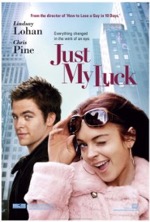
Starring: Lindsay Lohan
May 2006
“Polar Opposites Attract in Lucky Lohan’s Love Story”
Years ago I had a roommate who was unbelievably lucky; if it wasn’t for the fact that he was such a genuine, charismatic, decent, all-around good guy who deserved every gift that was ever lavished upon him, I probably would have gone stark raving nuts. Were it anyone else, I would have been nauseous every time the woman behind the bakery counter gave him an extra cookie for free, or when a generous stranger sold him a car for a dollar after learning he was without transportation (the honest to goodness truth). But, I can’t begrudge my ex-roommate any of this; he’s a quality person, someone who can walk right up to anybody and become their best friend within five minutes. The funny thing is…his ability to seem helpless, and thereby receive countless acts of charity, was completely lost upon him until I pointed it out to him. He eventually came to the realization that his was truly a charmed life. Perhaps you know someone like this.
When it comes to luck, Ashley Albright (Lindsay Lohan), reminds me of my ex-roommate. A spirited and overly-optimistic debutante, Ashley has everything going for her; beauty, talent, wealth and most of all, luck…the second she steps outside into a downpour, the rain, as if sensing her presence, ceases to fall. Ashley’s never known a loosing lottery ticket and when she hails a taxi, every cab in the vicinity converges upon her position. Her polar opposite, Jake Hardin (Chris Pine), is a walking calamity; Jake’s an affable, well-intentioned young man who just has terrible luck…when it’s not raining on him, pigeons are pooping on him. And, just when it looks as if his fortunes might change (Jake finds a five dollar bill in the trash can), he discovers that fate has played a nasty trick on him (he picks up the bill and gets warm, mushy poodle poop all over his hand).
Ashley and Jake eventually meet at a masquerade party. Jake ushers Ashley onto the dance floor, and in a fateful moment of passion, they engage in a lingering kiss that reverses their luck. Ashley becomes a hapless klutz and gets a taste of how folks live on the other side of the luck spectrum…she’s fired from her job and thrown in jail for unwittingly setting up her boss (Missi Pyle) with a male escort. Jake’s fortunes immediately change for the better; he saves the life of a big shot record producer and secures a contract for the band he’s been promoting, McFly (an obvious homage to Back to the Future). McFly is poised for their big break, but when Ashley kisses Jake to get her good luck back, things come crashing down upon Jake and the band. Ashley’s conscience forces her to make a terrible (by chick flick standards) choice: In order to get the man of her dreams, she must give up her life of ease and forever be unlucky.
Lohan has come a long way from her Parent Trap days, but it’s as if she’s got one wing outside the cocoon and is just waiting for the right role to come along to free her from her teeny-bopper chrysalis and establish her as a full-fledged movie star. Lohan is superstitious in real life, which perfectly plays into her part and the story in general; but we’ve seen the whole “role reversal” gimmick before in some of her other movies, most notably, Freaky Friday. It’s high time for Lohan to turn over a new (tea) leaf, and play a part that has some depth and believability.
Pine is a breath of fresh air in the movie, and if the film is successful in any way, it’s due in large part to his skilled portrayal of a young man plagued by Murphy’s Law. We can identify with his character more than Lohan’s because he’s a guy who’s making his way in the world while just trying to make it through the day…Lohan’s debutante is a spoiled brat who deserves her comeuppance when she looses her luck.
Director Donald Petrie (Miss Congeniality) has served us up a reheated version of Danny Glover and Martin Short’s Pure Luck. In that film, unlucky Short is hired to find the missing daughter of a wealthy businessman. In the end, the theory that one unlucky soul will find another is proven true in the highly amusing tale. Whereas, Pure Luck is a comedy; Just My Luck is a chick flick replete with silly scenes like the sudsy explosion in Jake’s laundry room or the sequence where Ashley kisses twenty guys in an attempt to find the man who stole her luck. The movie tells us that “the wheel always spins back.” Maybe the wheel can give me back my two hours…that would be lucky!
Rating: 2
Ice Age: The Meltdown (PG)
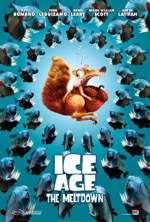
Starring: Ray Romano
March 2006
“Frigid Sequel Lacks the Warmth of the Original”
As if Al Gore’s treatise on global warming, An Inconvenient Truth, wasn’t sufficient enough, the much publicized, highly controversial topic is now the centerpiece of an animated film; namely the sequel to Ice Age, subtitled The Meltdown. The movie, presumably, takes place a short time after the events of the first film and furthers the misadventures of Sid the Sloth (John Leguizamo), Manny the mammoth (Ray Romano) and Diego the saber tooth tiger (Denis Leary). Oh, and of course we can’t forget Skrit or his eternal quest to possess that one elusive acorn in the ever amusing series of silly sidebars.
As the title would suggest, the first movie dealt with prehistoric animals migrating at the onset of the ice age. This time around the ecological calamity is a melting glacier, which floods the ice plain and drives the creatures from their homes. While doomsayers sway susceptible dinos with apocalyptic warnings that the end of the world is at hand, hucksters like Fast Tony (Jay Leno) use such alarmist propaganda as a means of turning a profit; as one of the more interesting new characters, it’s too bad we didn’t see more of Fast Tony in the movie.
In a feeble attempt at expanding our knowledge of the prehistoric trio, the writers have introduced new challenges for each of the main characters to overcome. For Sid, the issue is his need for respect. Sid never receives any respect from his companions but he finally finds some when he encounters a tribe of mini-sloths, who abduct Sid and reverently dub him “Fire King.” Sid basks in their adulation until they attempt to sacrifice him over a pit of molten lava. No respect there! Sid must be the distant ancestor of Rodney Dangerfield.
Diego faces his greatest fear when the glacier starts melting; swallowing up the last patches of dry land, the encroaching water makes Diego’s passage to the other side of the valley a hair-raising one. In jest, Sid gives Diego this tip, “Land safe, water not safe.”
Manny’s plight is the most desperate; all evidence points to Manny being the last living mammoth. Manny is crestfallen over that grim reality until the company encounters Ellie (Queen Latifah), a female mammoth who hangs with two dimwitted, thrill seeking possum sidekicks, Eddie (Josh Peck) and Crash (Seann William Scott). Headstrong Ellie refuses to accept that she’s a mammoth (having been raised by possums, Ellie believes she is one), and challenges Manny’s asserted leadership at every turn. This might explain why mammoths are extinct.
The real trouble here, besides the contrived, gift-wrapped resolution, is that the movie has no antagonist. To be sure, there are several internal struggles which sustain viewer interest for a time, but the convenient climax effectively lifts the pressure cooker lid and releases any steam the movie’s been building. Other than the titular thaw, the only story element that ratchets up the tension is the intermittent danger presented by two deepwater creatures (the alligator-like reptiles may be a little too frightening for younger children).
The CG animation, which shows a vast improvement in quality over the first film, is the only element that’s superior in this appropriately dubbed sequel. The characters aren’t as fun or funny here, and even Skrit’s gags seem recycled. With the series already growing tired, one can only hope that 20th Century Fox will deep freeze the series until the studio can commission a script that will better service the characters and the audience. The last thing we need is for the once charming Ice Age to devolve into The Land Before Time.
Rating: 2
She’s the Man (PG-13)

Starring: Amanda Bynes
March 2006
“Gender-bender with a Twist of Teeny Bop”
Viola (Amanda Bynes) is an incurable teenage tomboy who would rather be playing beach volleyball than helping out in the kitchen, much to her mother’s eternal chagrin and disapproval. Viola is also an excellent soccer player, the best on the team in fact; but Viola’s dream of carrying her team to a championship is abruptly shattered when she learns that the women’s soccer team at her high school has suffered sudden death.
Viola’s mother isn’t very sympathetic when she receives the “bad news;” with soccer cancelled, Viola’s mom strongly encourages the youth become involved with woman’s socials to learn the finer points of being a woman. When Viola stubbornly refuses, her exasperated mom replies, “Sometimes you’re just like your brother.” In that instant, a plan coalesces in Viola’s mind; her twin brother, Sebastian (James Kirk), will soon be taking an extended trip to Europe, leaving an open roster spot on the men’s soccer team at the upper-crust academy he attends.
Yep, you can guess what happens from here. Gender confusion creates most of the problems, and humorous situations, in the movie, i.e.: Viola falls in love with her hunky roommate, Duke (Channing Tatum), while the hottest, most popular girl in school, Olivia (Laura Ramsey), falls for Viola…disguised as Sebastian. There’s an amusing scene at a carnival where Viola, as herself, anticipates a rapturous lip-lock with Duke, who’s manning a kissing booth. As fate would have it, Duke is rotated out one girl before Viola. Dejected, Viola changes back into her Sebastian disguise, but then her mom shows up and she has to quickly change back; the scene recalls Robin Williams’ cross-dressing high jinx in Mrs. Doubtfire. The nerve-wracking complexities of leading a double life are painfully multiplied when Sebastian arrives home a day early and inadvertently ruins all of Viola’s well-laid plans.
Bynes does an amazing job of approximating male speech and mannerisms; the movie’s success is largely due to her role-reversing performance. Her comedic timing is dead-on, especially in the scene where Duke’s friend discovers her stash of tampons and she has to quickly improvise her way out of the jam—funny stuff!
Though She’s the Man is little more than a teenybopper movie, which is loosely based on Shakespeare’s Twelfth Night, the excellent lead performance in tandem with a surprisingly respectable plot renders the movie enjoyable instead of merely tolerable. I commend the film for steering clear of any uncomfortable or controversial issues: there is gender-bending without breaking in a storyline that could’ve crossed lines, but didn’t.
She’s the Man is a bona fide crowd-pleaser, a popcorn movie in the truest sense and a message-free examination of the life of one teenage girl. Uh, boy. Uh, girl.
Rating: 2 1/2
The Shaggy Dog (PG)

Starring: Tim Allen
March 2006
“Sophomoric Silliness Abounds in Canine Resurrection”
If ever there was an ill-advised remake, The Shaggy Dog is it—actually the story has been rehashed so many times now, they need to put the poor old dog to rest once and for all. The original, released in 1959 and starring Fred MacMurray, Tommy Kirk and Annette Funicello, was a light, whimsical tale of a boy who could transform into a sheepdog by chanting an ancient spell. It was campy and had Disney’s family-friendly cheese slathered all over it, but the comedy fit the period and the story worked as an endearing testament to bravery and self-discovery.
Today’s audience, however, is much more sophisticated than that of decades past, and the new film, though star-studded (Tim Allen, Kristin Davis and Robert Downey, Jr.), lacks the insouciant charm of the original. In this version, Deputy D.A. Dave Douglas (Allen), is bitten by a 300 year old dog and transforms into a canine at Pavlovian intervals. As a dog, Dave gains a different perspective on himself (specifically his selfish and neglectful tendencies), his family and the world around him. Dave begins exhibiting strange behaviors, such as lapping up his cereal and growling in the courtroom. As silly as those moments are the parent/teacher scene, where Dave runs outside to tree a cat, and the scene where he steamrolls an old lady while pursuing another cat, are the height (or, more appropriately, depth) of inanity.
Davis (Sex and the City) is mere set-dressing in the movie. She just seems to stand around and scratch her head at her husband’s bizarre transformations; an egregious waste for such a skilled actress. Downey, Jr. plays a mad scientist who seeks to discover and patent the fountain of youth; capturing the ancient dog gives him the means to accomplish this lofty goal, but what could have been a meaty turn as a nefarious antagonist is reduced to a series of courtroom antics tantamount to Allen’s high jinks. Danny Glover and Jane Curtain are also among the cast—the D.A. and judge, respectively—but their considerable talents are wasted by director Brian Robbins and the wafer-thin screenplay which was, ironically, churned out by a team of eight writers.
Allen’s performance here has redefined the word “stereotypical.” This is the same old shtick he’s been getting by with for years, and if anything, it’s more obnoxious and less enjoyable than before. In the movie, Dave has a heightened sense of smell and the ability to converse with animals; too bad the actor playing him wasn’t perceptive enough to recognize an embarrassing role replete with remedial gags and cheap laughs.
The end result of The Shaggy Dog is similar to taking a poodle in for grooming—you don’t leave with very much. If the movie has a saving grace, it’s that it doesn’t overstay its welcome; kids will love it, but most adults will be glad when it’s Rover.
Rating: 1 1/2
Failure to Launch (PG-13)

Starring: Matthew McConaughey
March 2006
“Aptly Named Rom-com Never Gets Off the Ground”
From a marketing standpoint, someone should’ve pointed out the dangers of using such a negative word in the title: failure. Besides the negative connotation the word conjures up, the potential for a self-fulfilled prophesy should have prompted studio executives to demand—in no uncertain terms—a name change. As things stand, the titular condition is the perfect diagnosis for the movie’s halfhearted performances and a story that, despite its best efforts to take flight, never achieves liftoff.
Finding anything redeeming here, much less entertaining, is nearly impossible. For starters, Matthew McConaughey and Sarah Jessica Parker have absolutely no chemistry whatsoever, which makes buying into the romance subplot extremely difficult. Also, Tripp’s (McConaughey) overprotective parents—meddling mom, Kathy Bates and daft dad, Terry Bradshaw—are one breakdown shy of the loony bin. This, of course, begs the question of why an adult would choose to live with such certifiable progenitors. One can only put up with so much in exchange for free room and board. I mean, if my father insisted on walking around the house in the buff as Tripp’s dad does (for several excruciating, eye averting minutes of onscreen time) I’d pack my things and take up residence on a friend’s couch before you could say nudist.
Tripp’s buddies play the usual well-meaning, advice-giving friends, but are one-dimensional stock characters whose sole purpose in the movie is to provide comic relief. The only peripheral cast member who actually offers some depth of character is Paula’s (Parker) sister, Kit (Zooey Deschanel). Kit is a lonely young woman with real emotions and real needs. A movie centered on her character’s plights would have been eminently more satisfying.
The movie has a modicum of clinical psychology and a ton of hyper-real situations that are designed to keep the audience rolling in laughter for two hours so that they don’t realize that they’ve been duped into enjoying a movie that has no plot. Failure to Launch is a prime example of what ails modern comedy films: it delivers the sizzle when audiences paid for a steak.
In all fairness, there are a few scenes that divert attention away from the insipid love story and the dysfunctional arrangement on the home front, but these moments are few and far between. Though the paintball skirmish and rock climbing wall excursion add some much needed energy to the stuck-in-neutral narrative, both sequences rely too heavily on standard comedy gimmicks and only garner cheap laughs which make them instantly forgettable. Sad to say, but either of these “action” scenes could be dropped into any other modern rom-com and they would work just as well. As such, Failure to Launch is just another “template” story (see my review for Eight Below).
In the end, Failure to Launch desperately tries to be clever but fails miserably with its anemic screenplay and characters that annoy more than they interest. Even the movie’s considerable star power couldn’t deliver enough thrust to get the leaden plot payload off the ground. Hollywood, we have a problem…we need a better script!
Here’s a scary thought: with the earth’s increasing population and the diversity of styles and tastes that pervade our culture, Failure to Launch is bound to be someone’s favorite film. Be very afraid!
Rating: 1 1/2
The Pink Panther (PG-13)
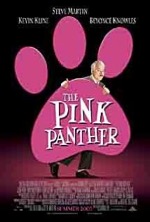
Starring: Steve Martin
February 2006
“Martin is Most Amusing When He Doesn’t Have a Clue”
Inspector Jacques Clouseau has been on quite a sabbatical. Last seen in 1993’s Son of the Pink Panther, it had been nearly twenty years before that when the brilliant Peter Sellers had finally hung up his detective’s hat after successfully playing the clumsy Clouseau in all four of the original Pink Panther movies.
This Pink Panther caper opens at a World Cup finals match between China and France in Paris. When the revered French coach is murdered by a poison dart at the conclusion of the contest and the famous Pink Panther diamond turns up missing, French police immediately launch an investigation. Chief Inspector Dreyfus (Kevin Klein) hatches a plan to catch the killer, an accomplishment that will solidify his claim on the elusive Medal of Honor—Dreyfus has been passed up for the coveted prize seven times. Dreyfus’ plan is to commission an incompetent cop to distract and divert the killer while he and the finest team of investigators in all of France nab the miscreant. The “perfect man” for the job is Jacque Clouseau (Steve Martin), a bumbling idiot and walking calamity, who mistakenly thinks his promotion to the rank of inspector is based on merit. What ensues is a witless investigation brimming with gags, double entendres and abject lunacy. Half the time I rolled my eyes, the rest of the time I was rolling on the floor at Martin’s unrelenting antics—he was the perfect choice to play dunderheaded Clouseau.
The movie’s storyline is essentially one catastrophe after the next. Some of my favorite moments are Clouseau’s alternate good cop/bad cop routine, Clouseau’s conversation with the Asian woman and the scene where Clouseau and his deputy sneak into Dreyfus’ ball in disguise. The movie’s creative highlight is when Clouseau crosses paths with 006—besides being uproariously funny, the scene features a nice bit of surprise casting.
And speaking of casting, the supporting characters add wonderful color and texture to the film, especially Ponton (Jean Reno), Clouseau’s vigilant deputy, Nicole (Emily Mortimer), Clouseau’s love interest, Xania the singer (Beyonce Knowles) and Yuri the trainer who trains (Henry Czerny). Martin and Klein are brilliant together, as are Martin and Reno; the scenes where Clouseau initiates random attacks on the deputy are idiotic and yet I still laughed. Perhaps that’s the film’s secret weapon; even when you don’t want to laugh, you end up doing it anyway…the movie is insidious that way.
Though The Pink Panther is replete with slapstick silliness, it’s also one hundred percent entertaining. Whether or not box office returns warrant a sequel, Martin’s Clouseau tickled me pink!
Rating: 2 1/2
Curious George (G)

Starring: Will Ferrell
February 2006
“Curiosity Killed the Cat…But Not This Silly Simian”
First introduced in the 1941 illustrated children’s book by authors H.A. and Margaret Rey, Curious George is a simple character in a simple story from a simpler period of American history—a throwback to a more innocent age. What’s refreshing about George is that he doesn’t speak (unlike Disney’s vociferous menagerie); conveying emotions through gestures and facial expressions, he’s a more realistic and captivating alternative to the cutesy animated animals we’ve been subjected to in recent years. The movie remains faithful to the books, though some modifications have been made; the most notable change is that The Man in the Yellow Hat has been given a name...Ted.
Ted (Will Ferrell) works at a museum owned by Mr. Bloomsberry (Dick Van Dyke), a doting curator who favors Ted over his real son, Jr. (David Cross). With the museum in financial trouble and in desperate need of a new exhibition, Ted volunteers to join an expedition to retrieve the mythical idol at the Lost Shrine of Zagawa in Africa. Ted first encounters George when the monkey grabs his yellow hat, mistaking it for a banana. After Ted finds the idol and returns to the ship, George stows away and follows Ted all the way back to his NYC apartment. George immediately complicates Ted’s life by hand painting a neighbor’s flat, which results in man and monkey being evicted from the building. Matters go from bad to worse when Ted arrives at the museum to find a massive platform that’s been custom-built for the reportedly giant-sized idol (the actual idol fits firmly inside the palm of his hand). As restless patrons clamor to see the opening of the exhibit, Ted must enlist the help of an eccentric scientist, Clovis (Eugene Levy), and an attractive teacher, Maggie Dunlop (Drew Barrymore), to fend off Jr.’s efforts to discredit him, discover the “real” idol and somehow prevent George from destroying everything in sight before the museum is forced to close for good.
An element that really stands out in the movie (other than Jack Johnson’s cookie-cutter songs) is the vibrancy of the pastel palette employed by the artists and the ethereal rays that bathe the characters wherever sunlight is present. This warm glow, in tandem with the minimalist animation style, produces a serene mood that works in perfect harmony with the lithe and blithe storyline.
Though clearly geared toward pre-teens, there’s plenty here for adults to enjoy as well: take the jaded cabbie, for instance, who takes a cue from Tom Hanks in A League of Their Own when he yells, “There’s no screaming in cabs!” The shifty clerks who sell Ted a yellow outfit are also amusing; needing to clear out their inventory they claim that “yellow is the new khaki.” Though the blissful balloon rescue is a highlight in the movie, it’s really the trouble-making monkey’s boyish innocence that makes the movie soar.
Rating: 2 1/2
Last Holiday (PG-13)
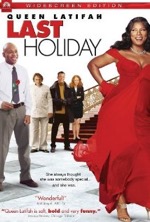
Starring: Queen Latifah
January 2006
“Delightful and Inspirational Carpe Diem Comedy”
“There are always possibilities,” or so the saying goes. Retail worker for Kragen department stores, Georgia Byrd (Queen Latifah), has an album full of dreams, labeled Book of Possibilities. In it are favorite recipes of foods she can’t eat, brochures to vacation spots she can never afford to visit and cut and paste fantasy wedding pictures of her and her hunky co-worker, Sean Matthews (LL Cool J). Georgia takes a picture of the meal she just created while watching her idol, Emeril Lagasse, on TV, pastes it in the album and wistfully dreams of all the things she could experience, if only…
One day at work, while trying to impress Sean, Georgia accidentally bumps her head and is taken to a nearby clinic. A CAT scan reveals that Georgia has multiple brain tumors…she’s given three weeks to live. After leading her congregation in a rousing, impromptu gospel song entitled “Why me, Lord?,” Georgia cashes in her bonds, heads for the Czech Republic and stays at Hotel Pupp (pronounced like the stuff dogs leave on lawns). While checking in, Georgia overhears that a big business meeting will take place at the hotel between corporation owner, Matthew Kragen (Timothy Hutton), his paramour, Ms. Burns (Alicia Witt), a congressman and the senator of Louisiana. At dinner, Georgia breezes into the hotel restaurant wearing a dazzling European dress and commands the attention of every waiter when she orders all four specials, which further elicits the attention of world-renowned Chef Didier (Gerard Depardieu), who immediately takes a liking to Georgia and later allows her to create meals in his kitchen. Assuming Georgia comes from money, the business party befriends Georgia and includes her in such activities as skiing, base jumping and gambling; Kragen tries competing with Georgia and ends up looking like a fool in each instance. While Georgia continues spending money, enjoying life and making new friends, Kragen, pays off a housekeeper to discover the secret to Georgia’s real identity.
A remake of Alec Guinness’ 1950 movie of the same name, Last Holiday features memorable performances from an assemblage of journeyman actors (and cameos by Emeril and Smokey Robinson) and a heart-warming story that analyzes the brevity of life without waxing preachy. In the history of cinema, there have been plenty of three-weeks-to-live plots, but none have been delivered with this much insouciant charm. Queen Latifah’s performance is remarkable as Georgia Byrd, a woman you just can’t help but admire for her spunk and new-found lust for life; emboldened by her terminal illness, Georgia tells another character, “I wasted too much of my life being quiet.” There’s a wonderful scene where Georgia looks into the mirror and tells herself that the next time “we will laugh more, love more, see the world…we just won’t be so afraid.”
From the colorful characters to the inspirational story to the on location footage shot in a cozy European village, there isn’t a single misstep in director Wayne Wang’s (Because of Winn-Dixie) feel-good flick. Last Holiday is an amusing tale wrapped around a subtle reminder to make the most of every moment. And to always get a second opinion!
Rating: 3
The Producers (PG-13)
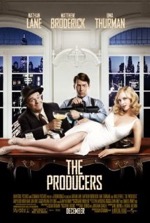
Starring: Nathan Lane
December 2005
“Brooks’ Brilliant Broadway Musical Has Filmic Second Coming”
In any work of art there are always intangibles; sometimes planted purposely, other times reaped inadvertently, these random variables can either garnish or tarnish a piece…and the stakes don’t get any higher than in the motion picture biz. This, the second movie adaptation of Mel Brooks’ wildly successful theater presentation, The Producers, has such a serendipitous quality, an ace-in-the-hole procured by Brooks and the casting department. Here, the magical element is called chemistry, and Nathan Lane and Matthew Broderick have it in spades; their mastery of the lead roles is astounding.
The story takes place in New York City in 1959, and opens with has-been Broadway director Max Bialystock (Lane) interviewing uptight number cruncher, Leo Bloom (Broderick) to be his accountant. The men immediately hit it off and soon hatch a seemingly foolproof plan to make a fortune—they’ll produce the worst show in town. In theory, Leo explains, producers could make more money with a flop than a hit; all you’d have to do is find the worst script, hire the worst actors, raise two million dollars, close the show after it tanks and head to Rio with the extra dough. Max, desperate to make a buck by any means, falls in love with the idea; and thus begins the outrageous, but utterly hilarious, story of The Producers.
There are plenty of catchy numbers in the movie, such as “We Can Do It,” “Unhappy,” and “I Wanna Be a Producer” (all of them excellently choreographed), but, arguably, the funniest song is Franz Liebkind’s (Will Ferrell) “Der Guten Tag Hop Clop,” which is essentially a Neo-Nazi hoedown. Liebkind, author of the musical “Springtime for Hitler,” will only allow Max and Leo to use his play if they take the Siegfried Oath, which declares undying allegiance to the Fuhrer. The oath also requires Max and Leo to give the Nazi salute, which they quickly convert to the bird every time Liebkind’s head is turned.
Their search for a lead actor takes a shocking twist when the producers meet Roger DeBris (Gary Beach), a gay thespian—the song, “Keep it Gay,” is an eye-opener for Max and Leo, and will be for a good portion of the movie’s audience, no doubt. In Roger, the producers have found their man—if ever there was a show killing protagonist, a gay Hitler would certainly be it. And yet the outrageous caricature of the Nazi leader, dancing onstage and singing the title song, strikes the audience’s funny bone, and before they know it, Max and Leo have a runaway hit on their hands.
There can be no question that Lane and Broderick steal the show, but the movie’s supporting players are equally good: the previously mentioned Ferrell (whose distinct brand of buffoonery actually works here) and Beach, along with Roger’s flaming partner, Carmen (Roger Bart), Leo’s demanding boss, Mr. Marks (Jon Lovitz) and the head-spinning blonde bombshell, Ulla (Uma Thurman) are all superb. As would be expected, Ulla, Max and Leo’s assistant, is the object of one innuendo after the next, but they’re all lost upon the Swedish assistant, who unwittingly stumbles into a love triangle with her bosses.
The Producers is an outrageously irreverent romp that’s sure to offend its audience while simultaneously making them roll in the aisles. It’s simply the best movie ever made that’s based on a play that features the worst play ever made.
Rating: 3
The Family Stone (PG-13)

Starring: Dermot Mulroney
December 2005
“Diamonds Are Forever…Dysfunctional Dramedies Aren’t”
If Meet the Parents was recast and rewritten as a drama, the result would be The Family Stone, director Thomas Bezucha’s bittersweet Yuletide portrait of the pun intended Stone family. Though the gags here aren’t nearly as plentiful or outlandish as those seen in Meet the Parents, there are some humorous lines and situations sprinkled in among the hard-hitting, issue-driven narrative.
The entire plot hinges on the relationship between Meredith Morton (Sarah Jessica Parker) and Everett Stone (Dermot Mulroney). Meredith is on the stiff and stuffy side, whereas Everett and his entire family, consisting of dad, Kelly (Craig T. Nelson), mom, Sybil (Diane Keaton), sister, Amy (Rachel McAdams) and brother, Ben (Luke Wilson) are on the spontaneous, accepting and fun-loving side of the spectrum. So when the Stone’s find it difficult to accept Meredith, there’s big trouble for Meredith and Everett’s relationship, a problem that continues to intensify with each additional faux pa (like when Meredith shows her true, perfectionist colors during a game of charades), misunderstanding or ideological difference.
The crux of the movie, as one would gather from the title, is the Stone family wedding ring which has been passed down as an heirloom for generations. Cybil is reticent to hand over the ring because she isn’t convinced that Meredith is “the one” for her son. Everett comes to the same conclusion when Meredith insists on sleeping in a separate room from him and when he later develops feelings for Meredith’s sister, Julie (Claire Danes). Cupid throws another relational curveball when Ben gets Meredith drunk at a bar and the couple is discovered in bed together the next morning.
Further spiking the eggnog is an incendiary subplot involving the Stone’s adopted son, Thad (Tyrone Giordano), who, in addition to being deaf, is also gay. At the dinner table, Meredith recklessly walks into a lion’s den when she asks Cybil if she ever wished her son wasn’t gay…to spare him any psychological discomfort or social stigma. Meredith, oblivious to the growing hostility around her, persists in pushing her values on the Stones until red-faced Kelly explodes in anger and storms away from the table. The scene seems utterly unnecessary and is too politically-charged for i7ts own good; but I suppose the writers felt it necessary to add this incident to the ever-growing list of grievances the Stone’s hold against Meredith.
Therein lies the movie’s greatest miscalculation; as a main character, the audience is inclined to like Meredith, but the script requires her to be at constant odds with the Stones. Since the film has no antagonist (its most glaring deficiency) Meredith, with her air of superiority and annoying throat-clearing tick, is made villain by default.
I have no qualms with the acting, directing or other production values in the movie, but the story’s pacing is nearly catatonic at times, even when compared to other dramedies of this kind. To its detriment, The Family Stone focuses too much of its attention on issues and not nearly enough of its time on the peripheral characters. Whether The Family Stone becomes the next Christmas classic remains to be seen, but its status as a run-of-the-mill drama is secure.
Rating: 2 1/2
Yours, Mine and Ours (PG-13)
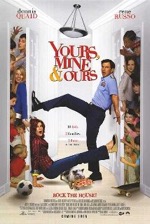
Starring: Dennis Quaid
November 2005
“Underachieving Retread of ‘Opposites Attract’ Classic”
As a rule, remakes never live up to the original: that axiom certainly holds true with the new Yours, Mine & Ours. The original movie, based on the real-life experiences of Helen Eileen Beardsley, was released in 1968 and starred Lucille Ball and Henry Fonda. Touted as one of the best family films of the 60s, the original far surpasses this flaccid update—we can thank a snake-bitten Hollywood (still reeling from the ’05 box-office bust) for playing it safe and green-lighting such a mediocre affair.
The percussive opening is one of the only highlights in the movie, but, unfortunately, the rest of the score is standard fare. As the story unfolds, we are introduced to starched and pressed Admiral Frank Beardsley (Dennis Quaid) and his eight kids and free-spirit purse designer, Helen North (Rene Russo) and her ten kids (six were adopted, but who’s counting?). Frank and Helen run into each other at a restaurant and the old flame is rekindled (they were high school sweethearts). While catching up on old times, Frank and Helen learn that they’ve both been widowed, and anyone who hasn’t fallen asleep at this point can figure out where the plot is headed. Frank and Helen are married a short time later and then the real fun begins…integrating the two households. Frank’s rank and file kids immediately clash with Helen’s spontaneous children, who are used to free expression. The blended family moves into an old lighthouse and must work together to refurbish it, while adhering to a rigid bathroom schedule and the admiral’s “house rules.” The Beardsley’s and the North’s bicker, fight and prank each other until they wise up and unite against a greater enemy—their parents.
What could have been witty and charming is witless and alarming in the hands of director Raja Gosnell (Mrs. Doubtfire). A tried and true story was in place and two A-list leads were on tap, but Gosnell clumsily mismanaged everything at his disposal…the end result is a movie that desperately tries, yet utterly fails, to entertain.
Quaid has become the consummate bipolar thespian…we’ve seen him in far meatier roles (Far From Heaven), but here he’s simply hitting his marks and collecting a paycheck—his entire performance is delivered on cruise control. Besides sibling rivalry, the one thing that does work in the movie is the chemistry between the leads—Quaid and Russo have some great scenes together where they grapple with their extreme personalities: Helen calls Frank a military robot, and Frank refers to Helen as a “free to be you and me flake.” What Helen calls decorations, Frank calls vandalism. Helen tells Frank, “A house if for free expression not for good impressions,” a philosophy that flies in the face of everything he believes in. These scenes had the potential for some meaningful character interplay, but the script dumbs down the drama and settles for the quick laugh/fix instead of anything that remotely resembles genuine human emotion.
What ails the film is familiarity...we’ve seen all of this before in such TV series as The Brady Bunch and Eight is Enough. There’s very little originality here and the tenuous plot is predictable at every turn. Yours, Mine & Ours, familial anarchy presented in a series of pedestrian gags, is far from shipshape and is one movie you must not watch. That’s an order!
Rating: 2
Zathura (PG)
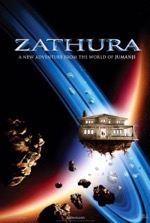
Starring: Josh Hutcherson
November 2005
“A Galaxy of Fun Awaits Those Who Can Pronounce It”
The name is Zathura…not Zanthura (as was incorrectly pronounced by blonde bombshell Jennifer M. on Apprentice 4). Based on the children’s book of the same name by author Chris Van Allsburg (Jumanji), Zathura is a lot better than it looks at first glance (the trailer doesn’t do the movie justice by a light year). Once you throw the laws of physics out the airlock—like director Jon Favreau does with great dispatch early on in the film—Zathura is a fun-filled romp through outer space and a meaningful tale of reconciliation between two quarreling brothers.
Zathura’s plot is virtually identical to Jumanji’s…kids are left home alone and they stumble upon an old board game; curiosity gets the best of them and they start playing, learning very quickly that their hasty decision might lead to their demise. Both books/movies focus on a series of turns—which become more disastrous with each successive round—where the players desperately attempt to set things back to normal while evading destructive forces or aggressive enemies that seem to materialize out of thin air. Where Jumanji featured jungle animals (including a heard of rhinos, which wreaked havoc while charging down the middle of town), Zathura offers up a universe of hazards, most notably a rogue robot that needs to be reprogrammed and the croc-like Zorgons (not to be confused with the Vorlons from Babylon 5 or the Vogons from The Hitchhiker’s Guide to the Galaxy). Each turn raises the stakes and when things look like they couldn’t possibly get any worse, the game ends and the pieces reset, but not before lives are changed and lessons are learned.
Though Tim Robbins’ presence—as a beleaguered father and sport car designer, recently separated from his wife—is barely felt in the movie, he turns in his normal, polished performance (it would have been nice to see him again at the end, however). Of Robbins’ three screen kids, teen daughter, Lisa (Kristen Stewart), is the most oblivious and superfluous character in the movie…she’s really only here for comic relief (Lisa is cryogenically frozen in her bathroom) and as an object for teenage boys to ogle at.
The two boy leads, Danny (Jonah Bobo) and Walter (Josh Hutcherson), anchor the movie, especially Danny, whose wide-eyed amazement at the wonders of the universe is the movie’s most-endearing feature. The visual of the house drifting in space is memorable, and the twist involving the astronaut is finely executed.
Zathura is much more than a glorified sci-fi role-playing game; it’s a charming and clever story that dispenses a good moral about sibling rivalry and is a fun way to get lost in space for two hours.
Rating: 2 1/2
Elizabethtown (PG-13)

Starring: Orlando Bloom
October 2005
“Interminable Dramedy Is Nothing to Crowe About”
Every once in a while, a movie comes along that you really want to like, but you just can’t. The acting, directing, etc. is fine, but the sum of the movie’s parts leaves you dubious, disappointed or downright confused.
Speaking of confusion, the “Huh?” factor is ubiquitous in the latest five-course banquet served up by writer/director Cameron Crowe (Jerry Maguire). Dubbed Elizabethtown—a sprawling, writhing piece of dramatic/romantic yarn that tells an involved tale with little lasting value—the movie features some amusing vignettes, but ultimately neglects to provide an overarching theme.
Sneaker designer, Drew Baylor (Orlando Bloom), has created a new, cutting-edge tennis shoe that’s been rejected, en masse, by the shoe-buying public, causing the company he works for to eat a million dollars. Drew is in the process of attempting suicide when his frantic sister calls—Drew’s father has died. Volunteered by his immediate family to make the funeral arrangements, Drew catches a red eye flight to Lexington. An ebullient stewardess, Claire (Kirsten Dunst), befriends (virtually stalks) Drew, tries out some pop psychology on him and gives him a map of Kentucky and her phone number as he debarks the plane.
Drew experiences severe culture shock when he arrives in Elizabethtown: his entire extended family envelops him, each relative brimming with colorful stories about his deceased father whom he hardly knew. Drew is soon drawn into the middle of a heated debate regarding his father’s upcoming funeral: should his father be buried or cremated? Amid the craziness, Claire pops up again, but only to string Drew along some more until she finally deals with her commitment issues and allows the bud of her romantic feelings for Drew come into full bloom.
After two hours (which feels like two days), the movie, at last, brings us to the long-awaited and unconventional funeral, which features a swooping, flaming boar and a head-scratching tap dance by Drew’s mother, played by Susan Sarandon (I nearly checked out here). Most of the funeral belongs in a slap-stick comedy and feels incongruous with the rest of the movie.
When the funeral finally, mercifully concludes (my friend turned to me in the theater and whispered, “As far as I’m concerned, it’s not over.” He was right. The movie drags on for another half hour), Drew undertakes a journey of self-discovery and emotional healing—which is what the movie should have been about from the very beginning. As Drew drives across the central U.S., following clues that Claire has placed for him in advance, he works things out with his dad; talking, laughing and yelling at the ash-filled urn sitting in the passenger seat. This sojourn is the most enjoyable part of the movie, but, unfortunately, it can’t bail out the previous two hours, which are filled with exhausting character development of shallow lives and events both random (Chuck and Cindy’s wedding) and commonplace, all of which brings the viewer to a mental state similar to Drew’s before his sister calls.
Elizabethtown is an insipid comedy, a dense drama, a frequently aimless character study and a plodding quagmire of subplots all rolled into one—there’s no clear sense of place or purpose until the very end. Crowe’s direction is ponderous and the overall effect of the film is like a shot of Novocain in the brain—the numbness eventually wears off, and in a few hours, the spectator has no recollection of the movie whatsoever.
Bloom is fairly convincing and Dunst does her giggles and dimples best, but their solid performances fail to elevate the superfluous storyline and leaden dialogue, which is an amalgamation of the worst B-movie lines ever written. The most distracting element in the movie (besides Dunst’s atrocious Southern accent) is the voluminous soundtrack; a veritable Time Life collection of pop tunes that can be heard at regular intervals (generally every two to five minutes) throughout the film, the music feels less like a score and more like a juke box with a broken record.
In short, Elizabethtown is an utterly meaningless film that’s entirely too long (like this review). But, hey, it could be worse…the first cut of the film was eighteen minutes longer.
Rating: 2
Wallace and Gromit: The Cruse of the Were-Rabbit (G)

Starring: Peter Sallis
October 2005
“An Overripe, yet Nutrient-Rich, Veggie Tale”
From Nick Park and Steve Box, the visionary directors who brought us Chicken Run, comes the first feature-length film based on their signature characters—Wallace and Gromit. Based on a series of Claymation shorts of the same name, Wallace and Gromit: The Curse of the Were-Rabbit is a raucous romp that wholly entertains and presents a few unexpected turns along the way.
Inventor Wallace (who certainly must be the distant cousin of Inspector Gadget) and his mute dog, Gromit, own a critter control company called Antipesto and are esteemed as local heroes by all who have required their services. The annual vegetable growing contest brings with it a heightened need for pest protection and Antipesto is up to the challenge, or so they think. One fateful night, Wallace, who moonlights as a mad scientist, experiments on a rabbit, mutating the poor little fur ball into an abominable creature. Soon, there are too many calls for Antipesto to keep up with, and so many gardens ravaged that the contest is in danger of being cancelled. As the raids increase, Wallace begins exhibiting strange behaviors, leading Gromit to wonder if the real threat is somewhere closer to home.
If The Curse of the Were-Rabbit could be summed up in one word it would be “witty” (what else would you expect from the unrelenting barrage of British humor?). The jokes and gags are both obvious and hidden (the radio buttons in Wallace’s vehicle spell M-U-T-T), but it’s really the twist near the mid-point that gives the movie some much-needed dramatic focus, which nicely counterbalances the film’s wanton whimsy.
Peter Sallis is spot-on as Wallace, as is Ralph Fiennes as the braggadocios hunter, Vincent Quartermaine—both characters become involved in a ménage trios with affluent horticulturist, Lady Campanula (Helena Bonham Carter), which is quite an amusing sidebar, especially when Quartermaine is sucked up into Wallace’s bunny extractor.
Though a bit on the pedestrian side, the movie is nothing if not clever; the were-rabbit’s fall from lofty heights is clearly a tip of the hat to King Kong (who will be brought back to the big screen by Peter Jackson in December). The transformation scene is a bit of a reach, but it’s all in good fun (like the rest of the movie) and decisively proves that Wallace and Gromit live in some very bizarre alternate reality.
In the final analysis, The Curse of the Were-Rabbit is every bit as good as Chicken Run and perhaps a hare better…it’s a hopping good time that will delight kids and engage adults. The only downer here is that the warehouse containing much of the work for this and earlier W&G projects burnt down a short time after the movie’s release.
Rating: 2 1/2
Just Like Heaven (PG-13)

Starring: Reese Witherspoon
September 2005
“Metaphysical Love Story is Comely if Not Heavenly”
Elizabeth Masterson (Reese Witherspoon) has it all. She’s a young, beautiful, successful doctor, who is widely admired and resides in a quaint bay view apartment in San Francisco. The only thing she doesn’t have is the one thing she wants the most—a great guy she can settle down and start a life with; everything would be heavenly then. On one rainy night, Elizabeth, in a hurry to get home and change for a blind date, crashes into the side of a semi-truck.
Enter David Abbott (Mark Ruffalo), an architect who is searching for a new dive when a flyer advertising Elizabeth’s place blows right into his face. Taking that as a sign, David moves in and makes himself at home (spilling chips and soda on the sofa), much to Elizabeth’s dismay and disapproval. Inevitably, the two tenants meet and the sparks immediately start flying. After a vehement argument, David eventually proves to Elizabeth that she’s dead—he can see her, but nobody else can.
David begrudgingly assists Elizabeth in tracking down clues about her life—it’s a journey of discovery for the pair as they strike up an uneasy friendship that deepens as they continue picking up loose threads together. There are plenty of “crazy man talking to someone who’s not there” scenes (the bit where David gives a choking man first aid with instructions from Elizabeth is extremely funny), but ultimately they end up at the hospital where Elizabeth had previously worked. While David grills a nurse who worked with Elizabeth, the spectral Elizabeth passes through a wall and discovers the movie’s first major twist—she sees herself on a hospital bed lying motionless in a coma.
David later learns from his best friend that Elizabeth was the one he was supposed to meet on the blind date that fateful night—somehow, even though they never met, there’s a spiritual connection between David and Elizabeth, which you would never guess from the way they constantly toss acidic barbs at each other.
The last major twist, which gives the trolling plot a much-needed jolt of urgency, comes when Elizabeth’s sister, Abby (Dina Waters), reluctantly decides to sign the papers authorizing the hospital staff to pull the plug. Now it’s a race against time as David, translating Elizabeth’s words from beyond (a la John Edward), tries to convince Abby that Elizabeth is still alive.
Based on the book If Only It Were True by Marc Levy, Just Like Heaven has undeniable shades of Ghost and Heaven Can Wait, and though often derivative, the movie is carried by strong performances and an accessible story that packs an unexpected, emotional punch. The movie’s director, Mark Waters (Mean Girls), has crafted the quintessential dromedy, which should appeal to a wide audience with its wit, pathos and uplifting fifth act.
If you can deal with the metaphysical quagmires in the story, Just Like Heaven is a heart-warming tale that exemplifies the unquenchable human spirit and is easily one of the finest examples of its genre ever crafted. Just Like Heaven? Not quite. But for earthly entertainment it’s a sweet and charming repast.
Rating: 3
The Brothers Grimm (PG-13)

Starring: Matt Damon
August 2005
“Aptly Named Creature Feature Tells Grim Tale”
In a world where a great movie is solely determined by great special effects, The Brothers Grimm would be considered one of the finest films of the year. Unfortunately for director Terry Gilliam and scribe Ehren Kruger, we don’t live in such a world.
The Brothers Grimm is a strange conglomeration of classic fairy tales, and while this arrangement worked like a charm for Shrek, it’s a confusing and contrived wreck here—the movie isn’t entertaining nor is it funny despite it’s valiant attempts. In many ways, The Brothers Grimm is this year’s Van Helsing (as if we really needed another one of those) and comes complete with macabre trappings and the requisite werewolf.
Set in Germany against the backdrop of the French occupation of 1796, Jake (Heath Ledger) and Will (Matt Damon) Grimm are renowned witch hunters and demon slayers who are coerced—by their French captors—into entering a haunted forest and tracking down the person or creature who has kidnapped a number young girls (Gretel and Red Riding Hood among them). Their quest leads them to a gigantic tree located in the heart of the forest, which houses a glass fortress at the top. A cursed man who can transform into a werewolf has placed the kidnapped girls inside caskets encircling the base of the tree. The skeletal remains of Queen Mirror (Monica Bellucci) will be reanimated and the wolf-man’s curse will be broken if he can find one final girl. The Grimm brothers thwart the queen’s plans, of course, but not before a rousing and frenetic climax.
I have to admit that The Brothers Grimm didn’t hold my interest much past the opening credits. The plot is frequently aimless and ultimately pointless, the dialogue is as stale as one of Gretle’s breadcrumbs and I didn’t give a flip about any of the characters. Ledger and Damon have turned in mediocre performances that perfectly match the uninspired production.
There’s been a recent regression in motion picture special effects—not in quality but in believability—and the movie’s werewolf is a perfect example: there’s no arguing that the wolf is flawless in its CG rendering, but the problem is…it’s too perfect. The fur is perfectly placed, the eyes are too clear, without the slightest degree of glazing or reddening, and the creature’s movements are too fast and jerky so as to mask the its artifice. The one effect that does work well is when Queen Mirror—as an ambulatory, two-dimensional, fractured mirror—attacks the Grimm brothers…her death scene, where the shard of her talking mouth is crushed, is absolutely brilliant.
The Brothers Grimm has an abundance of on-screen magic, but has little movie magic; it’s a visual smorgasbord of empty calories that leaves you craving a meatier plot.
Rating: 2
Charlie and the Chocolate Factory (PG-13)

Starring: Johnny Depp
July 2005
“Depp’s Wonka Will Give You the Willies”
As everyone on the planet knows by now, this movie is a remake of the 70’s classic, Willy Wonka and the Chocolate Factory. Narratively, the story strays little from the original, but creatively, a whole new world bursts forth thanks to updated special effects (a catchphrase used too often for remakes) and Tim Burton’s skewed sensibilities.
The film’s opening is an instant masterpiece—Charlie Bucket’s (Freddie Highmore) colorful family, including dirt-poor parents and feisty grandparents (both sets sleep on either end of the same bed), really strikes the right chord of likeability and pathos with witty banter, amusing anecdotes and familial harmony amid abject poverty. Charlie’s Grandpa Joe (David Kelly) is a hoot—besides Charlie, he’s the most enjoyable character to watch, especially when he does his little jig after Charlie brings home the magical Golden Ticket from the ultra-rare Wonka Bar.
When the five children and their adult escorts enter the factory, two changes occur simultaneously: 1. creativity and color increase, and 2. intimacy and warmth decrease. Most of the gags inside the factory are virtually identical to the ones in the original, i.e. fatso getting sucked up into a tube and bratty bubble gum champ turning into a giant blueberry (the TV room scene is also here, with updated special effects, of course). Though amusing and well choreographed, I could have done with one less Oompa Loompa (Deep Roy) number (we get the point, already!). However, Roy’s cut and paste performance is truly remarkable.
The dénouement is a departure from the original, but isn’t necessarily unwelcome—Wonka makes amends with his estranged, molar-retentive father (Christopher Lee), and Charlie’s relatives become a surrogate family for the eccentric inventor of all things sweet—Wonka has selected Charlie to be his protégé and eventual heir apparent.
The movie owes its success to Burton’s singular vision and Highmore’s accessible, sometimes-good-guys-do-finish-first performance. However, it’s the cinematic irony of the new millennium that this Johnny Depp vehicle picture was almost sabotaged by Depp himself. To be sure, Depp always turns in quirky, multi-layered performances, and his version of Wonka is no different. Here, however, the character he’s been given to portray is downright creepy—the way Wonka is drawn, wearing silk gloves and face covered in ashen make-up, might be considered poor taste in the wake of the Michael Jackson trial. Besides the obvious Jackson caricature, the character has none of the charm Gene Wilder imbued his Wonka with, and the way Depp condescends the children (especially the “mumbler”) is utterly distasteful. The film succeeds despite Depp’s effeminate Wonka, but how much more enjoyable would the movie have been if Wonka was actually likeable?
Charlie and the Chocolate Factory is a visual delight—during the early stages of the movie, Burton films buildings and people at wildly slanted angles and the Bucket home—complete with a depressed chimney that sags like a greasy French fry—looks like something right out of Dr. Seuss. There’s no doubt that movie magic resides here, perhaps to an even greater degree than the original, and yet, this take on Roald Dahl’s timeless children’s book is tainted by Depp’s quirky protagonist. In the movie’s climax, the glass elevator crashes through the factory roof and seems poised to sail clear up into space…what brings it, and the movie, back down to earth is a Wonka that we merely tolerate for Charlie’s sake.
Rating: 3
Bewitched (PG-13)

Starring: Nicole Kidman
June 2005
“Adds Modern Ingredients to the Old Witch’s Brew”
Instead of simply upgrading the 60’s sitcom to the big screen, this new, improved Bewitched takes the viewer inside the casting process and tedious production of a new TV series and the drama that swirls around the re-telling of a classic show. Sound confusing? It’s not; in fact, the entire movie is dull and overly simplistic—it doesn’t take a crystal ball or tea leaves to figure out the paint-by-numbers plot, and the one area of the movie where magic should have fulminated like a fireworks finale—the relationship between Jack Wyatt (Will Ferrell) and Isabel Bigelow (Nicole Kidman)—is pedantic and predictable.
To be sure, Ferrell and Kidman are fine actors, but their chemistry here is scanty—like the amount of onscreen time actually dedicated to the romantic subplot—and their relationship is asserted not shown. Very little character development is conjured up in the movie, save for Isabel’s struggle against her insatiable desire to get whatever she wants by using magic...she’s a reformed witch. Her antagonizing father (Michael Caine) pops up from time to time (as the Gorton’s Fisherman or Jolly Green Giant in the freezer aisle—the most creative visuals in the film), and heckles her over the futility of eschewing her magical powers. Though hard-fought and heart-felt, Isabel’s internal battle with her own nature is a loosing effort; she abandons the kenosis and is soon back to her old lobe-wiggling tricks.
The scene where Jack meets Isabel in a café—Jack observes Isabel’s natural ability to do the “nose twitch” and convinces her to audition for the new Bewitched show, Isabel agrees because she mistakenly thinks Jack is the perfect man—is utterly doltish...in fact, most of the scenes on the TV set are downright silly. Shirley MacLaine’s character, an undercover witch, is really more of a nuisance than a supporting player. Uncle Arthur’s (Steve Carell) random appearance serves as a voice of reason for Jack, who clearly needs to catch a clue about Isabel’s attraction to him, but the scenes are so teeth-grindingly annoying that after Carell’s character exits the screen, you have to scratch your head and wonder what the heck it was you just saw. There are only two standout scenes in the movie: 1. On the set, red-faced Isabel tells Jack he’s a jerk, and 2. Jack fails to realize Isabel is a “real” witch until she pulls out her broom and takes flight.
Though Bewitched casts a weak spell, it somehow works as mindless entertainment. As bad as the movie is, it would have been even worse if the producers had taken the easy route and simply made Bewitched a retread of the original series. Either way, Bewitched suffers from remake-itis…there’s little magic here.
Rating: 2 1/2
The Perfect Man (PG)
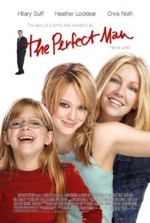
Starring: Hilary Duff
June 2005
“Average Love Tale is Anything But Perfect”
The normal response to a breakup is a desperate rebound or a period of profound depression. An extreme or dysfunctional reaction to a severed relationship is when you pack up your troubles and move to a new town. Such is the repeated and unhealthy pattern of Jean Hamilton’s (Heather Locklear) tumultuous love life. After the latest in a long line of failed relationships, Jean uproots her family, again, and moves them to Brooklyn. Jean’s teenage daughter, Holly (Hillary Duff), has a personal website that lampoons her family—on it she grouses about her transitory life and her mom’s predilection for botching relationships and, indeed, choosing losers in the first place.
It’s not long before Jean attracts a well-leavened doughboy at the bakery where she works—a needy, heart-on-the-sleeve type named Lenny (Mike O’Malley), who employs such lines as, “Where did you buy those pants…Hottie.com?” Eventually, Lenny wears Jean down and takes her to a Styx concert—he cries nostalgic tears through the entire performance and uses her sleeve as a handkerchief. Jean is so desperate for the perfect man—or any man, for that matter—that she looks past Lenny’s neurotic behaviors and seriously considers saying yes when he serenades her from the fire escape and proffers her an engagement ring.
Holly detests Lenny and goes into emergency split up mode, especially when she meets her new girlfriend’s uncle Ben (no pun intended, I’m sure). In Holly’s mind, Ben (Chris Noth) is the perfect man, but if her mom ever meets him, she’ll find a way to sabotage the relationship—as she always does—and Holly and her younger sister will be forced to move again. Holly begins sending letters and emails to her mom as Ben and begs Adam (Ben Feldman), her high school crush, to call her mom posing as Ben. Jean admits that Ben sounds like the perfect man, but Holly’s plan backfires when Jean wants to meet him. “Ben is a beautiful idea, but you can grow old with an idea,” Jean reasons.
Though Holly consistently displays more common sense than her mother in the movie, the writers involve her in some silly matchmaking scenes like the orchid delivery or the mishap at the restaurant where she sets off the fire suppression system to prevent her mom from encountering Ben—these sequences attempt to generate peril and move the slogging plot along, but to no avail. As the script would demand, Jean and Ben finally meet at the movie’s gloaming, but the casual manner in which they speak to each other tells us what we’ve known all along…there’s no guess work here, no mystique, no panache, only a foregone conclusion.
The movie’s entire premise is a sick one—an abnormal scenario that should repulse most viewers. The Perfect Man is contrived, formulaic and predictable at every turn, with a hurried and unsatisfactory ending and performances that match the mediocre script. It’s never explained why Jean keeps relocating her family every time a relationship ends; did her father abandon her when she was young? Did Jean’s mother also run away every time her heart was broken? A much better story would have been: Jean and Ben hook-up earlier in the movie but Jean panics the first time their relationship hits a speed bump and falls back into the old pattern of wanting to run away. Ben confronts Jean and opens her eyes to her insecurities; they work through her issues and then they live happily ever after. Though such a dramatic tangent would dull some of the chick-flick edge, at least it would lend the movie some semblance of a plot.
Romance movies are among the hardest to pull off on the big screen and The Perfect Man is the perfect example; the movie plummets even with the two cuties (Locklear and Duff) and debonair Noth. Just as it was kismet that Jean and Ben would meet at the end, it was also destiny that the film would fail to meet our expectations.
Rating: 2
Mr. & Mrs. Smith (PG-13)
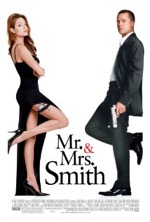
Starring: Brad Pitt
June 2005
“Smith Happens in This Paranoid Bullet-Fest”
Brad Pitt and Angelina Jolie are big-screen eye-candy—a built-in box-office draw for ogling members of both genders—but it’s too bad the script they had to work with here wasn’t as sweet. Mr. & Mrs. Smith is one paranoid affair: for five or six years, John (Pitt) and Jane (Jolie) Smith have maintained the semblance of a perfect marriage while leading double lives as assassins for two different covert agencies. Jane always has dinner ready when John gets home at seven pm, and they dispassionately discuss their days’ like two news anchors covering a human interest story—their table talk is peppered with so many generalities and pleasantries, you’d swear the pair just met for the first time. The escalation of knives sequence is amusing as is Jane’s oven armory, but these scenes soon grow tiresome because the audience is in on the joke, but the Smith’s aren’t.
At the thirty-minute mark, the first hint of a plot surfaces when John and Jane are assigned the same mission by their respective agencies. The operation is bungled and the match is a draw, but the evidence left behind leads the Smith’s to a startling discovery (one that we’ve known about since we saw the trailer)…their spouse is an enemy agent. There’s a scene—which becomes tedious after the first volley of bullets—where the Smith’s make Swiss cheese out of their house while trying to kill each other with an arsenal of guns, knives and any other weapon they can get their hands on. When attrition finally sets in and a stalemate becomes evident, the Smith’s realize all the blood, sweat and passion is a turn on and they begin making out amid the rubble; but the reunion of lovers is short-lived as another group of assassins arrive and put more holes in the walls.
Having sat through the first half of the movie in chronic boredom and utter disappointment, I found the last half to be a vast improvement: the Smith’s team up against a common enemy and finally open up and share the truth about their sordid pasts. I found their banter to be especially amusing during the car chase scene—Jane admits to having hired stand-in family members at their wedding—and the final, destructive showdown in the warehouse is an elegant death dance with Matrix-style action shots.
Vince Vaughn plays his standard wide-eyed weirdo as John’s best-friend-turned-enemy and Kerry Washington briefly pops up as one of Jane’s aides. I have no qualms about the acting, but the trouble with Mr. & Mrs. Smith, besides its skewed reality of extreme deception and destruction, is that it becomes a parody of itself. Perhaps this story would have worked better as a sci-fi film, as our disbelief would already be suspended to lofty heights. In the real world, this kind of paranoid farce only flies if you’re watching Alias at a fondue party—and you don’t have to pay ten dollars for that!
Rating: 2 1/2
Madagascar (PG)
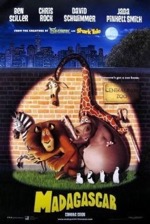
Starring: Chris Rock
May 2005
“Animated Zoo Animals on the Lame”
Star Wars has its clone wars, but Madagascar is a clone. Virtually identical to every other CG animated film that’s come along in recent years, Madagascar is just a poor excuse to thrust a handful of cute, cuddly animals into situations already experienced by toys, monsters, fish, robots, etc. in the hopes of achieving box office success. This time it’s a zebra, not a donkey, who longs for adventure and companion-ship, but the striped quadruped’s repetitive shtick, delivered by Chris Rock futilely attempting to channel Eddie Murphy, will quickly annoy any audience member older than ten.
Alex the lion (Ben Stiller), the prima donna of the Central Park Zoo, gives pal, Marty the zebra, a birthday present—a new “Alex” snow globe from the zoo’s gift shop. When Marty blows out the candles on his cake, he wishes he could take a trip into The Wild. Worrywart giraffe, Melman (David Schwimmer), coaxes Marty into revealing his wish, which proves to be bad luck when Marty disappears the next morning.
An ill-fated attempt at rescuing Marty results in the animals being captured and shipped off to a foreign zoo, but fortunately, four stowaway penguins shanghai the cargo vessel and steer it toward warmer environs. While arguing inside their cargo boxes, Alex and company fall overboard and wash up on the paradise island of Madagascar—they think they’re in San Diego. Marty is high on his new-found freedom, but Alex, accustomed to being pampered by zoo workers, instantly loathes his new home.
The most amusing scene in the movie is when Melman and hip hippo, Gloria (Jada Pinkett-Smith), defect to the “fun side” of the island, where Marty has constructed a swinging cabaña complete with saltwater drinks, leaving sourpuss, Alex, to stew in his own misery. Ultimately, Alex comes around, but not before his predatory instincts kick in and he finds his jaws around Marty’s hindquarters. Fate smiles upon the Central Park quartet—and a grateful audience—when the four penguins show up with the ship at the hour and a half mark to rescue their friends from savages, and us from acute boredom.
Madagascar hinges on the friendship between Alex and Marty, but their interactions are so similar to the ones between Shrek and Donkey, that the story never really has a chance to stretch its legs. The through line is straighter than an arrow shot by Legolas and the movie’s only twist, Alex’s primal regression, is resolved far too quickly and with little panache (save for his kaleidoscopic hallucinations of juicy steaks). The only character that’s halfway interesting is hypochondriac Melman—the scene where Alex tries freeing the giraffe from his cargo container is humorous.
Though rife with messages of friendship, freedom and the need for flexibility, Madagascar is overly simplistic and overtly formulaic—certainly not an effort worth taking pride in.
Rating: 2
Kicking & Screaming (PG)
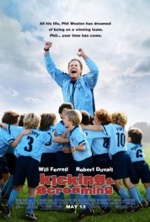
Starring: Will Farrell
May 2005
“It’s What You’ll Be Doing To Get Out of the Theater”
Call it the Bad News Bears of soccer, Kicking and Screaming is unsatisfactory as a sports movie and unsavory as a family movie. Just a few months ago, I saw a Woody Allen film entitled, Melinda and Melinda, which starred, among others, Will Ferrell. Ferrell was mesmerizing as a man estranged from his wife and falling in love with another woman. He showed promise as a dramatic actor and demonstrated a range previously unseen, and frankly, unimagined. Unfortunately, with Kicking and Screaming, Ferrell is back to his normal, comedic shtick and only displays an occasional flicker of his former brilliance.
Phil Weston (Ferrell) has spent his entire life in the shadow of his choleric, tough guy father, Buck (Robert Duvall), and has never lived up to Buck’s standard as a husband, father, businessman or human being. Phil was all elbows and knees when playing sports as a kid and held a permanent spot on his father’s bench. Now, when Phil learns that Buck traded his son, Sam, to a lower ranked team to give the boy more playing time, he spitefully accepts the vacant coaching position on Sam’s new team. Phil is out of his league as a coach, especially when taking on Buck, so he enlists the help of his father’s chief rival and next-door neighbor to be his assistant coach—Mike Ditka.
Ditka introduces Phil to coffee (the fuel of champions) and Phil is soon addicted, downing cup after cup at coffee shops and setting up an espresso machine on the bench during games. The team starts winning, thanks to Ditka’s expert guidance and the assistance of two Italian soccer prodigies—the boys can only play when all of their father’s meat orders are delivered (meat comes first). Phil’s newfound lust for winning, coupled with his strict coffee diet, sends him over the edge; he benches his son and the rest of the players are uneasy around the person he’s become. After his wife brings him back to reality, Phil destroys the coffee machine, apologizes to the team and reverts to his former, friendlier self. Throwing out the playbook and admonishing his kids to just have fun, Phil beats his father in the championship game and breaks the curse of his childhood.
If there’s a moral here, it’s murky, and Phil’s coaching tactics while under the influence of coffee (i.e. breaking opponent’s ribs) are reprehensible—the scene isn’t even remotely funny and certainly doesn’t belong in a family film. The movie tries to be a comedy, but isn’t—the coffee subplot is utterly ridiculous and Phil’s awkwardness around the lesbian couple might have been amusing ten years ago, but bombs here. The movie tries to be this year’s feel-good sports movie, but fails miserably. Kicking and Screaming tries to be entertaining, but sails far wide of its goal.
Rating: 2
The Hitchhiker’s Guide to the Galaxy (PG)
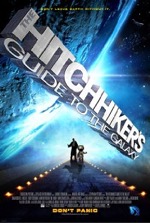
Starring: Martin Freeman
April 2005
“High Concept Fare With a Large Dose of the Bizarre”
What would you do if a fleet of bulldozers showed up on your front lawn and you were handed a legal document stating your house was to be demolished to make way for a new highway? Better yet, what would you do if you knew for certain that you only had two more minutes to live before the earth was wiped out by greedy aliens bent on destroying our planet to make way for a new intergalactic express route? If you choked on a popcorn kernel reading that last one, take this as your cue to run, not walk, out of any theater showing The Hitchhiker’s Guide to the Galaxy, the new sci-fi romp based on the best-selling book by Douglas Adams.
However, if you’re stout of heart and can stomach the vile behavior and hideous appearance of the sumo-sized bureaucrats named Vogons (or endure several minutes of their torturous poetry), you might just be in for an amusingly whimsical, albeit bizarre, journey through the warped and unpredictable reaches of outer space. In any event: “Don’t Panic!” And whatever you do, don’t forget to bring your towel.
Arthur Dent (Martin Freeman) is the hapless, witless soul who must sacrifice his house on the altar of progress, but fortunately, his good friend, Ford Perfect (Mos Def), is not from our world and beams himself and Arthur onto the Vogon mothership just before it makes meteorites out of the earth. Escaping the rusty, grimy Vogon ship is a death-defying task, but Arthur employs the wisdom of the wickedly satirical Hitchhiker’s Guide and he and Ford are soon floating free in space. Did you know that it’s possible to survive in space for a few seconds by holding your breath? Either did I.
Fortune, again, smiles upon Arthur and Ford as they’re beamed aboard a friendly vessel that just happens to be in the vicinity. The stolen, spherical ship belongs to the President of the Universe, Zaphod Beeblebrox (Sam Rockwell of Galaxy Quest fame), who has two heads/personas, a manic depressant robot named Marvin (voiced by another Galaxy Quest alum, Alan Rickman), and a girlfriend named Trillion (Zooey Deschanel), who had a brief fling with Arthur in the not too distant past. Beeblebrox is on a mission to visit mythical world, Magrathea, but along the way he runs into his campaign opponent, John Malkovich, who makes a brief appearance as the priest of a sneezing cult. Ultimately, Malkovich’s character is just a grace note in the zany script and his presence is utterly superfluous, as he never appears again in the film.
When the party finally reaches Magrathea, they discover the super-computing oracle, Deep Thought. In the distant past, Deep Thought cogitated that the answer to life, the universe and everything is 42. Now, after pondering for eons, Deep Thought will reveal the “ultimate question.”
If all of this is a bit difficult to follow (or swallow), it’s because Adams’ story is dense and shallow at the same time. The story’s aliens, customs, planets, etc. are all well thought-out and fully realized, but the character development is spare and many plot elements are bizarre, ludicrous or obnoxiously random. Here are just a few examples: Dolphins, the third most intelligent species on our planet, have been trying to warn us of our impending doom for years, but we’ve misinterpreted their attempts at communication as playful flips and tricks. On the Vogon homeworld, giant flyswatters pop up out of the desert sands and smack unsuspecting travelers in the face (the scene is actually pretty humorous). An omniscient being—who just happens to have a spare earth sitting around—tells Arthur that it’s mice, not men, who really rule our world. My favorite oddity, however, is the “Improbability Drive,” an obvious poke at Trek’s warp drive, which spews the ship out into alternate realities—the “yarn universe” sequence is nothing short of genius.
For all its inherent strangeness, The Hitchhiker’s Guide to the Galaxy has several saving graces—it’s witty, clever and wildly imaginative. This makes the movie viewable, if not instantly accessible. It will be interesting to see if Hitchhiker’s ticket sales will permit us to visit The Restaurant at the End of the Universe.
Rating: 2 1/2
Sahara (PG-13)

Starring: Matthew McConaughey
April 2005
“Savvy Adventure Film is a Trove of Wit and Whimsy”
Sahara opens with a pulse-pounding sequence: bombs exploding like fireworks in the night sky, Union and Confederate soldiers exchanging fire and the last ironclad ship running silent while evading cannon fire. The “Ship of Death” was rumored to carry a cargo of rare coins, but the vessel disappeared shortly after the conflict and has, for over a century, confounded historians and treasure hunters, such as...
Dirk Pitt (Matthew McConaughey) and Al Giordino (Steve Zahn), who have been searching for clues to the whereabouts of the mystery ship, receive a dubious tip that leads them to the Niger River where they encounter Eva Rojas (Penelope Cruz) and her World Health Organization entourage. Eva is in the region responding to a deadly outbreak that causes the eyes of its victims to mutate into something you’d see in a horror movie. As fate, and Clive Cussler (who wrote the novel Sahara’s screenplay is based on), would have it, Eva joins up with Dirk’s team under tumultuous circumstances—in an effort to avoid capture, Dirk and Al blow up a boat owned by their pragmatic boss, Admiral Sandecker (William H. Macy), and bloodletting rebels slaughter Eva’s team.
Any romantic potential between Dirk and Eva takes a backseat to the story’s unquenchable thirst for adventure and, in the end, it’s simply a foregone conclusion that the pair will hook up…and they do. As a character, Dirk Pitt is an enjoyable blend of Indiana Jones and James Bond—though failing to capture the appeal of either action icon—and McConaughey plays the character with the proper degree of boyish insouciance. Dirk’s sidekick, Al, fulfills his role as comic relief, but by the movie’s midpoint, his one-liners become as stale as outdated field rations…it’s a shame his character (or any other in the movie, for that matter) is never given the opportunity to become anything more than a cardboard stand-up.
As if a Civil War-era ship buried in the ubiquitous sands of West Africa isn’t far-fetched enough, Dirk and Al, in a scene that tries to be clever but isn’t, instantly throw together a ramshackle land yacht with spare parts from a crashed plane (Macgyver is green with envy). Or, how about the exhilarating, one-in-a-trillion cannon shot that takes out an enemy helicopter (granted, the movie pokes fun at itself here when Dirk and Al exclaim, “There’s no way that should’ve worked!”). And what about the ensuing flirtation with deus ex machina when natives lining the cliff scare off the bad guys—a tableau reminiscent of the one seen in Quigley Down Under? Perhaps the worst rip-off, however, is the action sequence at the recycling plant, which plays like an insipid James Bond riff…French “heavy,” Yves Massarde (Lambert Wilson), is a flaccid foil for Pitt.
Despite its many contrivances, Sahara is wildly entertaining and features a rousing climax (the cannon shot, not the beach scene). With several other Cussler novels to excavate, it’s very likely we’ll be seeing Mr. Pitt exploring the past again in the near future.
Rating: 2 1/2
Millions (PG-13)
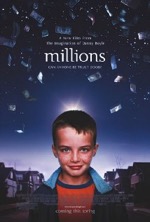
Starring: Alex Etel
April 2005
“Smart and Stylish: The Next Generation of Family Film”
Damian (cherubic Alex Etel) and Anthony (Lewis McGibbon) are seven and nine year old British boys, respectively, who have recently lost their mother—and to add insult to injury, their father moves them to a new neighborhood and school. Damian is a dreamer with a truly beautiful and innocent mind; a young man who can rattle off statistics about Catholic saints faster than any priest this side of the papacy, and who is oft visited by such venerated figures in his fertile and impressionable imagination. Damian builds an elaborate cardboard fort near some train tracks and fancies himself an astronaut when the train rumbles past—the raucous rumble of boxcars, the strident sound of wheels on steel and jostling vibrations that threaten to topple the makeshift shelter all simulate a lift-off sequence, and in his mind, Damian is launching into space.
On one fateful day, a duffel bag flies free from the train and flattens a section of Damian’s ramshackle fortress: curious, Damian opens the overstuffed bag to discover bundles of cash. Damian confides in Anthony and the two are soon building towers out of money stacks in their room. Replacing the cash and hiding the bag under their bed, they vow not to tell their father.
Damian consults his imaginary companions for guidance on how best to use the money: the saints suggest giving a portion to the poor, which he does without a moment’s hesitation. Whereas Damian’s motives are honorable, Anthony uses the money for personal gain—he hires bodyguards to protect him at school and buys friends by handing out bills.
Inevitably, word gets out that the boys are wealthy and they attract unwanted attention; a problem not aided by Damian’s impulsive acts of altruism, i.e.: dropping cash down the mail slot of a poor man’s door and tossing a bundle into the collection bucket for a school charity. The boys’ delirium over finding the cash is quickly replaced by guilt, fear and paranoia, especially when the money’s rightful owner shows up—a creepy drifter whose attempts at manipulating Damian amps up the thriller section of the movie. Another effective story device that adds tension to the more intimate and pedestrian moments in the movie is the conversion of currency to the Euro. With the deadline drawing closer and the shady man scheming for the money, Damian and Anthony turn to the only person they can trust…their father.
Millions is worth every penny of its namesake and has affectively ushered in a new era of family-friendly films—sophisticated and stylish, the movie embraces the Nickelodeon bunch without alienating the adult set. It’s ironic that this vanguard in family pictures comes from such and unlikely director, Danny Boyle (Trainspotting), but the auteur has crafted an exquisite film both in character and creativity. The time-lapse sequence at the beginning of the movie—an entire sub-division springs to life before our very eyes—is absolutely brilliant. The cell phone scene is also wildly imaginative: the brothers, sitting side-by-side on top of a hill, carry on a conversation with each other and two red, vertical lines reaching toward the sky represent the satellite link between them.
As young Damian, Etel is a revelation in pure, unadulterated innocence—his childlike wonder is truly the highlight of the film. Damian asks every imaginary saint he meets if they’ve heard of a new arrival named Saint Maureen, but none of them have. The movie’s emotional payoff comes near the end, when Damian is reunited with his departed mother (the saint he’s been inquiring about) in a tender vision—the moment of poignant closure allows the young boy to finally move past his mother’s untimely death.
The only scene I could have done without is the controversial depiction of St. Peter. Here, the disciple is a swearing, smoking, heresy-espousing figure with a tilted halo and a humanistic account of Jesus’ miracle of feeding the 5,000. Unfortunately, this brief exchange stands out as an unseemly tear in an otherwise beautiful tapestry woven by skilled screenwriter, Frank Cottrell Boyle.
Destined to become an annual favorite at Christmas time (the movie’s climax takes place during the Holiday season), as well as a chart-topper on family film lists for years to come, Millions is a rare breed—entertaining on many levels and salient for every generation, the movie is truly one in a million.
Rating: 3 1/2
Guess Who (PG-13)
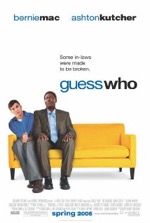
Starring: Ashton Kutcher
March 2005
“A Mediocre Meet the Parents Rehash”
The movie’s title asks a question anyone who’s seen the trailer knows the answer to. Unfortunately, like most movies these days, the best scenes from Guess Who were spoiled in the trailer, which promised a light-hearted romantic comedy dedicated to watching a young white man squirm as he meets the parents of his black girlfriend.
Guess Who is the latest in a long line of feeble attempts at “modernizing” classic movies—in this case, Spencer Tracey’s 1967 melodrama, Guess Who’s Coming to Dinner. Here, races are reversed and Simon Green (Ashton Kutcher) must stare down his girlfriend’s watchdog father, self-styled bank loan officer, Percy Jones (Bernie Mac). At first, Percy can’t stand Simon and does everything in his power to make Simon’s life miserable, including sleeping with him on a hide-a-bed in the basement and padlocking the basement door. Over time, Percy begins warming up to the idea of Simon and his daughter, Theresa (Zoe Saldana), being together, but not before the stubborn pair become embroiled in spats, accidents and a lonely night apart from their sweethearts.
A movie of this kind, clearly, had more social relevance in the turbulent 60’s than it does in present-day America—the racial tension the script seeks to employ has marginal effectiveness in our world of increasing tolerance. As a result, the movie is an insipid comedy that tries to be funny, receiving meager support from its middlebrow premise and anemic screenplay. Granted, there are a few chuckles to be had, but other than Mac and Kutcher’s on-screen chemistry (which is better than Kutcher’s chemistry with Saldana), the film is a ponderous dirge of maudlin moments and slapstick situations—I found myself forcing an occasional laugh just to help the movie along.
Besides borrowing thematically from the aforementioned Guess Who’s Coming to Dinner, Guess Who also bears a striking resemblance to two other modern films from the same genre: Father of the Bride and Meet the Parents (even the poor sequels to those movies are better than Guess Who). Sad to say, if it wasn’t for Bernie Mac’s pitch-perfect portrayal of the disgruntled, overprotective father, Guess Who wouldn’t even be worth the stock it was filmed on.
With its countless contrivances, predictable plotline and knee-slapping one-liners, Guess Who is a middling comedy that fools audiences into thinking they’ve had a good time, while failing to service them in any significant way. If the producers think they’ve created a feel-good, crowd-pleasing romantic comedy, they should guess again.
Rating: 2
Melinda and Melinda (PG-13)
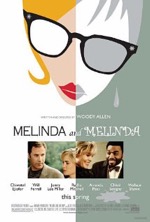
Starring: Will Ferrell
March 2005
“A Tale of Two Fillies”
The seminal master of cinematic high art, Woody Allen, is back, and his unequalled prowess at helming both drama and comedy has come to bear upon the ingenious dramedy, Melinda and Melinda.
The movie opens in a New York café, where two playwright friends are discussing the various virtues of their work…one is adept at crafting comedic scripts, the other excels at plumbing the depths of the human condition in dramatic vignettes. The drama playwright begins telling a story about a young couple hosting a dinner party in their New York flat; as the husband schmoozes a potential employer, a high school friend of the wife’s shows up unannounced. The storyteller’s scene-setting words soon transform into a voice-over as we’re drawn into the actual events of the drama. After that scene plays out, we’re back in the café and the comedic writer spins his own yarn involving similar situations with different people. The one commonality between both narratives is nubile debutante Melinda (Radha Mitchell), a thirty-something free spirit who disrupts the marriages in both stories.
Once both sets of characters are introduced and both plots are established, the remainder of the movie plays out like a vigorous match at Wimbledon—bouncing back and forth between the two stories with no discernable segues and no apologies to those who can’t keep up, the movie could have degenerated into a jumbled mass of faces and places in the hands of a mere mortal, but Allen’s deft direction, along with an engaging storyline and actualized characters, prevents the film from faulting. With Melinda and Melinda, Allen has pioneered a new movie format; it will be interesting to see if this innovative split story technique will inaugurate a new movement in Hollywood or if the complexity of such a plot construct will scare off all but the most daring producers.
There’s no question that Melinda and Melinda boasts superlative directing, but the A-list ensemble of actors is equally impressive. Performances by Chloe Sevigny, Amanda Peet, Jonny Lee Miller and Chiwetel Ejiofor bolster the twin tales, but it’s really Mitchell and Will Ferrell who steal the show. Ferrell demonstrates considerable dramatic range here and has Allen’s vocal cadence and comedic timing down to a science—some scenes are downright frightening when it comes to Ferrell’s ability to emulate the director’s vocal and physical characteristics.
Melinda and Melinda is a fresh approach to filmmaking and is thoroughly entertaining despite its various ménage a trios and sordid trysts. Sustaining interest with focused narrative, crisp dialogue and believable characters, Melinda and Melinda is a refreshing piece of filmic art.
Rating: 3
Robots (PG)
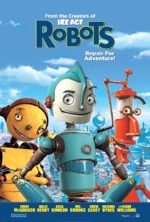
Starring: Ewan McGregor
March 2005
“Serviceable Story That Makes A Lot Out of Junk”
Robots is an astonishing clinic in computer-generated animation, the sleek vision of a fully realized synthetic world. This newest—and seemingly inevitable—iteration in CGI is crisper in its clarity and more vibrant in its palette than anything previously seen in the genre and has, effectively, risen the bar that much higher for Shrek 3 and other future movies of the same ilk. It’s evident that director, Chris Wedge (Ice Age), and crew were on a creative high assembling the nuts and bolts of the story, and though the flick is chock-full of dizzying action sequences, narrow escapes and drops and turns that make you feel like you’re on a roller coaster, the plot consistently lags behind the movie’s runaway pacing.
Rodney Copperbottom (voice of Ewan McGregor) heeds the call of the big city, leaving his parents and rural Rivet City behind to pursue his dreams of becoming an inventor in Robot City. Rodney immediately encounters Fender (Robin Williams, whose repertoire is getting repetitious), a vociferous misfit who falls to pieces any time the story calls for a laugh. Rodney’s first attempt at showing his invention to his boyhood hero, altruistic uber-inventor, Big Weld (Mel Brooks), is nearly disastrous as he narrowly escapes the clutches of greedy egotist, Ratchet (Greg Kinnear). Rodney learns, almost too late, that Ratchet supplanted Big Weld in a recent coup and has launched a campaign to beautify all of robotkind (and make millions in the process). Rodney’s ability to fix broken down robots transforms the small town droid into an urban legend, however, Rodney’s newfound fame poses a serious threat to Ratchet, who plans to destroy every spare part in the city, thereby forcing older models to get an upgrade. The climax pits Rodney and his army of rickety robots against Ratchet and his newer, larger, more powerful battle ‘bots. The ending ceremony is an emotional flourish—warm fuzzies soar like ticker tape—but the ensuing celebration is reminiscent of the one seen in Star Wars: Episode I—The Phantom Menace.
I mention Star Wars, because there are countless tips of the hat to (or blatant rip offs of) Lucas’ space saga, which surface at various times throughout the movie—the downtrodden underdogs marching against the evil overlords brings to mind Episode I and VI’s Gungans and Ewoks, respectively, and even Ratchet’s new robot sweepers look virtually identical to Episode I’s Trade Federation MTTs (battle droid carriers). Aside from Star Wars, Robots owes its metallurgical existence to The Wizard of Oz; motifs and archetypes from the perennial classic run rampant though the picture.
If there’s a rusty side to the seemingly chrome-plated screenplay, it’s the gimmicky manner in which the tale is told—much of the story is programmed with standard gags and slapstick silliness, especially Fender’s shtick. Robots, however, does have a salient moral: the conflict between the outmodes and the upgrades is a new spin on the old topic of intolerance—the devaluing of anyone or anything that doesn’t measure up to an imposed standard. In our nip-tuck, Botox-injected society, Robots reveals an insightful—even insidious—look at our own vanity and a sneak peek at where that brand of narcissism can take us. What a bold statement from an animated movie made in Hollywood!
Robots isn’t as funny as billed, but it’s a diverting romp with memorable characters and a positive message. Now we’ll have to see if there are enough spare parts to make a sequel.
Rating: 2 1/2
Because of Winn Dixie (PG)
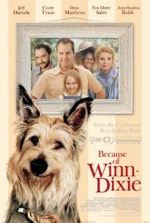
Starring: AnnaSophia Robb
February 2005
“Simple, but Touching Family Film”
A star is born! If you were to look up the word “adorable” in the dictionary, next to the definition would be a picture of AnnaSophia Robb in all of her angelic innocence. As indicated in the title, the movie (based on a Newbery award-winning kid’s book by Kate DiCamillo) is about Winn Dixie, the smiling mutt that exhibits more personality than the average canine, but it’s really Robb’s winsome purity that steals the show.
Robb’s character, India “Opal” Buloni (name change, please!) is introduced to the stray in—of all places—a Winn Dixie market, where the shaggy dog is demolishing end caps while evading capture. Amused by the comical pursuit, Opal, in a snap decision, claims ownership of the dog when it’s finally cornered. Opal’s father, Pastor Buloni (whose sermons are full of it), is less than thrilled when Opal brings the mangy mutt into their trailer. “The Preacher” (Jeff Daniels) ultimately gives in to Opal’s pouting—besides making a face no one could refuse, she plays the, “But I have no friends!” card and wins.
The Buloni’s are new to fictitious Naomi, FL, a sleepy Southern burg complete with a rustic library, a closed-down candy factory and nary a stop light—the preacher’s congregation meets in an old convenience store. Father and daughter tote around sacks filled with sorrow—Opal’s mother left them when she was only three—but Winn Dixie is the catalyst for open communication between the two (the “ten things about mom” scene is endearing and deeply moving).
As Opal explores the new town, she makes friends with the spinster librarian, Miss Franny (played by the ever-charming Eva Marie Saint), who regales glorious stories of the past, and Gloria Dump (Cicily Tyson), a near-blind, recovering alcoholic who teaches Opal how to see others with her heart. She also encounters the stubble-faced drifter, Otis (Dave Matthews, in his big screen debut), the interim manager of a pet shop, who offers Opal a part-time job and plays his guitar to soothe the animals.
There are plenty of funny scenes in the film, like when Winn Dixie recklessly pursues a church mouse, providing the parishioners with more entertainment and joy than any sermon in recent history. However, it’s the subtler moments that have more lasting impact; like the Litmus Lozenge tale or Mrs. Dump’s explanation of the “failure tree” and her admonition to “hold on to love while you have it.” Embedded in the movie’s overarching silliness are themes of forgiveness, hope and the need for community.
What easily could have degenerated into another Beethoven cheese-fest, is actually a funny, feel-good, family film…and it’s all because of Winn Dixie! By the way, isn’t it poor form to start a title with “because”? Woof!
Rating: 2 1/2
Hitch (PG-13)
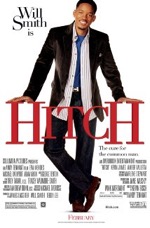
Starring: Will Smith
February 2005
“Educational Love Tale Wastes It’s Time on Silliness”
Alex “Hitch” Hitchens (Will Smith) is a smooth operator—perhaps too smooth for his own good. He has all the insights into the female psyche that elude the common man and knows just what buttons to push to gain a desired response from the fairer gender. Fittingly, his occupation is romance counselor and the movie opens with Hitch accepting a tough assignment—a very stiff suit named Albert Brennaman (Kevin James), who is head-over-heels for affluent and radiant socialite, Allegra Cole (Amber Valletta). To say that Allegra is way out of Albert’s league would be the understatement of the year, but Hitch is equal to the task and immediately begins training the stocky, soft-spoken klutz, who seems to have a perpetual dollop of mustard on his shirt.
All goes according to script until Hitch encounters steamy Sara Melas (Eva Mendes), a gossip columnist who plays hard to get, but ultimately gives in to Hitch’s charms. Sara is a bit of a challenge, though; Hitch’s normal repertoire of flattering phrases and clever lines has little effect when he tries to crack her icy exterior. Their first date is a disaster—Hitch accidentally kicks Sara in the head, unwittingly dredges up an unwanted reminder of her family’s shady past and looses his top shirt when it gets caught in a cab door.
All of a sudden, Allegra is warming up to Albert (despite some minor missteps) and the Date Doctor is struggling just to keep his foot in Sara’s door. This is when the fun begins…the novice is rounding first base, while the master is royally botching what should be an easy conquest. Hitch is faced with the fact that he has no long game and realizes he’s the expert on something he really doesn’t understand. The resolution is a bit standard for a romance film, but humorous situations and solid acting sustain the light-hearted story.
Some of the humor works well (the vehement vegetable toss in Hitch’s apartment and when Albert tosses his inhaler and plants one on Allegra), but some of it is so unrealistic that it belongs in a slapstick comedy (the food allergy sequence is sophomoric and brings to mind a swollen-faced Martin Short in Pure Luck). Smith and James have great screen chemistry and play the “dancing” and “kissing” role-playing vignettes extremely well. Mendes’ character comes close to being fully realized, but her screen boss (Adam Arkin) is little more than set dressing.
In the end, Albert does everything wrong and still wins over Allegra and Hitch learns that there are no clear-cut rules when it comes to relationships. One wonders if there will be a sequel, and if so, will Sara and Alex get Hitched?
Rating: 2 1/2
In Good Company (PG-13)

Starring: Dennis Quaid
January 2005
“Lighthearted Dramedy is Good, But Not Great”
The changing face of corporate America! That pretty much sums up the plot to In Good Company. Oh, and never date the daughter of a man you just demoted.
Neither an all-out comedy, nor a full-on drama, In Good Company won’t be mistaken as a barnburner, but it certainly isn’t a bad way to spend two hours. Dennis Quaid plays Dan Foreman, veteran ad man at Sports America magazine; husband to Ann (Marg Helgenberger) and father to Alex (Scarlett Johansson). The company that owns the periodical is sold to a rival corporation and callow upstart, Carter Duryea (Topher Grace) is sent to head up the advertising department where he promptly supplants Dan and fires half the staff.
Carter relies heavily upon Dan, his “wing man,” for marketing advice, because he’s way out of his depth: the only thing Carter knows how to do is talk—his improvised motivational speeches and ad hoc solutions get him out of one jam after the next. Being a quick thinker and fast talker has always gotten him by in the past, but Carter quickly realizes he’s a sham; his recent divorce from his wife (Selma Blair) makes that painfully obvious (now he sleeps on a couch at work). After his promotion, Carter buys Porsche, but gets in an accident the moment he drives it off the lot (he doesn’t even know how to use a stick shift), presenting the image of a man so driven by the need to succeed that he’s never taken the time to learn anything on the way up.
A word that pops up a lot in the movie is “synergy,” and while the film’s pacing often lacks it, the incisive commentary on the capricious nature of the business world is amusing and didactic. Revered financial maven, Teddy K. (Malcolm McDowell), delivers a sermon on synergy at a staff meeting and uses an array of high-sounding words to mesmerize a pack of “yes men” at the office, but Dan isn’t bamboozled and stands up to the blathering businessman. This risky move results in Dan getting his old job back and Carter and his cronies getting fired. Though his failed relationship with Alex provides him with some clarity, it’s Dan’s firm hand (and right cross) of guidance that brings Carter to a place of self-discovery. In the end, poetic justice is served—the young man so bent on getting ahead in life, ends up with nothing.
Morality lesson aside, the movie has some great character moments—like when Dan and Carter first meet and compare ages, or when Carter invites himself over for dinner. However, for some inexplicable reason, In Good Company never fully realizes its potential, despite excellent performances and a decent storyline. Like it claims in the title, the movie isn’t great, nor is it poor—it’s simply “good.”
Rating: 2 1/2
Meet the Fockers (PG-13)
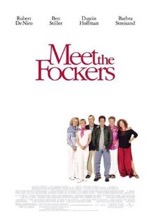
Starring: Ben Stiller
December 2004
“Great Performances Fail to Save Unoriginal Sequel”
The movie opens with a sequence of fortunate events for Greg Focker (Ben Stiller) and Pam Byrnes (Teri Polo)—someone gives up their cab for the couple, all the stoplights turn green for them on their way to the airport, and Greg’s oversized carry-on is taken to the captain’s personal storage locker. Of course, we all know this streak of good luck won’t last for long…and it doesn’t.
Meet the Fockers, the sequel to the popular one-disaster-after-the-next flick, Meet the Parents, is a nothing more than a retelling of the original—the only new element is the addition of Greg’s parents into the dysfunctional mix. Bernie Focker (Dustin Hoffman) is a semi-retired lawyer who sports a dark tan and an array of Hawaiian shirts and his wife, Roz (Barbara Streisand), is a sex therapist for the geriatric set.
Robert DeNiro is back as the stiff and ever-paranoid former C.I.A. agent, Jack Byrnes, and his screen wife, Dina (Blythe Danner) remains the only voice of reason in the midst of calamitous family get-togethers. Greg and the Byrnes’ pile into Jack’s new, state-of-the-art R.V., which is tantamount to a fine motel room on wheels (complete with hidden spy suite), and head to the Focker house in sweltering gator territory. Jack’s grandson from his other daughter joins them on the road trip, and it quickly becomes clear that the only purpose the child serves is to provide a cute face and some comic relief.
If there is a part of the movie that plays well, it’s the friction between Jack and Bernie; from the moment Bernie hugs Jack and pecks him on the cheek, you know it’s going to be a long visit. These fathers—and families—are diametrically opposed when it comes to lifestyles and worldviews and the sparks fly high and often during “family times.” As if things aren’t going rough already, the startling revelation that Pam is pregnant sends both families reeling. Of course, issues are worked out and relationships are mended or built by movie’s end and a humorous wedding wraps up the zany storyline. Owen Wilson reprises his role as Pam’s former fiancé and is the priest that marries the happy couple (Wilson singing in Hebrew is a hoot).
To its own detriment, Meet the Fockers returns to the same well that spawned its predecessor—the Murphy’s Law sequences feel forced and their predictability really detracts from the movie’s intended impact. The film is loaded with crude humor and some scenes are just plain wrong. It’s truly unfortunate that this amazing array of talent was wasted on such pedestrian fare. I guess the most fitting reaction to the movie is right on the poster.
Rating: 2
Wimbledon (PG-13)

Starring: Kirsten Dunst
September 2004
“Surprisingly Fresh Sports/Romance Story”
At first glance, a movie with an identity crisis between a sports flick and a love story is a pretty bad thing. On the one hand, you run the risk of loosing male interest to some sappy romance and on the other hand, females not interested in sports will spend their movie money elsewhere. Wimbledon is a balancing act that, somehow, manages to pull off the difficult feat of becoming a successful sports/romance movie.
There are several contributing factors to this winning formula. First, the leads are attractive, intelligent and have great chemistry together. Paul Bettany (Master and Commander) plays Peter Colt, a thirty-something, nearly washed-up tennis player who’s taking his last shot at winning Wimbledon. Bettany imbues Colt with a brand of charisma that’s believable and endearing—his voice-overs, containing his innermost thoughts, really serve to humanize the character and provide an honest and refreshing portrayal of a struggling sports star.
Dunst (Spider-Man) plays Lizzie Bradbury, a serious newcomer to tennis who has a track record of being distracted by men during big tournaments. She falls fast and hard for Colt (the whole tennis connection), and a torrid romance ensues, much to the disapproval of Lizzie’s overprotective father, Dennis (Sam Neill).
The movie’s climax is predictable, yet uplifting; Colt wins Wimbledon, and, after weathering a series of relational storms, wins Lizzie’s heart. Colt retires, but Lizzie will continue pursuing her dream of becoming a champion at Wimbledon. And, as would be required of such a tale, they live happily ever after.
The star’s contribution to the movie cannot be overstated, but several supporting characters aid and abet Bettany in making Wimbledon a crowd pleaser. The aforementioned Dennis Bradbury (Neill) is solid, as is Peter Colt’s fanatical father, Edward (Bernard Hill of The Return of the King), and the young heartthrob Jake Hammond (Austin Nichols), who serves as fellow tennis competitor and underdeveloped antagonist. Also making cameo appearances are John McEnroe and Chris Evert, who provide some additional celebrity and credibility.
As an independent film, Wimbledon is a small release and will most likely not receive the attention its due. It’s a shame, because Wimbledon is a feel-good flick that reaffirms the notion that it’s never too late to achieve in life.
Rating: 2 1/2
The Terminal (PG-13)
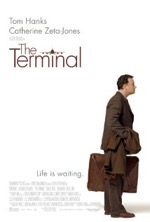
Starring: Tom Hanks
June 2004
“Soars, Despite Being Grounded”
Tom Hanks and Steven Speilberg have become an unstoppable duo at the box office, and every time they collaborate on a film, their mastery of craft and vision increases exponentially (and let's not leave multiple Academy award-winning composer, John Williams, out of the equation; Williams turned in a wonderful, Baltic-flavored score for The Terminal).
Though the premise of the film is quite simple—Krakozhian citizen, Viktor Novorski, is trapped in J.F.K. because his country is at war and the U.S. won't recognize his passport—but it's Viktor's spirit of determination and decency, and the friendships he makes at the terminal, that really gives the movie wings. Viktor is a survivor, he creates a makeshift bedroom in an old, unused airline gate, learns how to speak passable English, learns how to make a living so that he can eat and helps out a lot of people along the way, who, in turn, help him.
One of these friends is Enrique (Diego Luna), a love struck errand boy who agrees to feed Viktor in exchange for information about the beautiful, vibrant immigration agent Viktor sees every day. Viktor is a go-between and, after some time, delivers a ring to the young woman with instructions to join the man of her dreams at the Sbarro pizza joint in the terminal. She meets her secret admirer and the couple is soon married—in the terminal, of course.
Admittedly, this is a little far-fetched—and if there’s an Achilles Heel to this wonderfully endearing tale it's that, despite the veneer of fully realized characters and events, the entire script is fictitious. Everything in the film is well crafted and well acted, but the underlying lack of authenticity makes the story, as a whole, hard to buy.
Take the failed romance between Viktor and "cheating" stewardess, Amelia (Catherine Zeta-Jones), for instance. The writers employ the old apple on a string routine by building up a potential relationship between Viktor and Amelia, but in the end, they yank back the string, and all you're left with is a mediocre, under-developed subplot to close out the movie. Granted, the end of the movie is uplifting—Viktor finally gets out of the airport, and the twit-in-a-suit, head of airport security (Stanley Tucci) fails in his attempt to contain Viktor—but Viktor’s victory in securing the final autograph of a jazz musician for his deceased father is hardly the expected or desired payoff for the film.
Despite its slow pace and utter lack of action, The Terminal is a feel-good drama recommended for anyone who doesn't get claustrophobic.
Rating: 3
Shrek 2 (PG)

Starring: Mike Myers
May 2004
“Not as Original as the Original”
Shrek 2 picks up where the first movie left off, more or less. The video portion of the 3-D ride at Universal Studios (which has now been released on DVD, complete with 3-D glasses) serves as an unofficial Shrek 1.5.
All the regulars are back from the original movie; Mike Myers as the abrasive ogre, Shrek, Eddie Murphy as the vociferous Donkey and Cameron Diaz as the model turned ogrette, Princess Fiona. Some new faces—and accompanying voice talents—also grace the jolly green sequel, like Antonio Banderas as Puss In Boots, Jennifer Saunders as the Fairy Godmother, Rupert Everett as Prince Charming, comedian John Cleese as Fiona’s father and the incomparable Julie Andrews as Fiona’s mother.
The movie opens with the long, exhausting journey to the land Far, Far Away, which turns out to be a fairy tale version of Hollywood (wait a minute, Hollywood is a fairy tale!). The king and queen, along with the rest of the kingdom, go into collective shock when the ogre couple jumps out of the onion carriage. One of the highlights of the movie is the ensuing dinner at the royal table, where insults and belches abound in one of the most unique “meet the parents” sequences ever committed to film. Later that night, the king plots to have Shrek assassinated by Puss In Boots. His evil scheme expands when he arranges a wedding between the reverted Fiona (a potion belonging to the Fairy Godmother changes her back to a beautiful princess) and Prince Charming. Of course, the King’s plans are foiled and they all live happily ever after, but some hilarious misadventures take place before the storybook closes.
The double entendres have been toned down from the first picture, but inside gags and tips of the hat to other movies or TV shows are ubiquitous…in fact, you can make a game out of who can find the most references. Here are just a few: as they ride into Far, Far, Away, you can see a sign that reads “Farbucks Coffee.” Rolling up the hill, Donkey says, “Swimming pools and movie stars” (Beverly Hillbillies). Later still, Puss In Boots pops out of a guard’s breastplate (Alien).
But even with new characters, situations and gags, Shrek 2 still doesn’t live up to the quality of its predecessor. There’s something missing from the movie, but it isn’t easy to determine what that absent something is. Maybe it’s that the newness has worn off or that Shrek 2 doesn’t have the same “movie magic” that the original had in spades. Either way, Shrek 2 is a winner, as sequels go, but is still inferior to the original. Oh, and one more thing, make sure you sit through the end credits…there are some additional scenes that are hilarious, but just plain wrong.
Rating: 2 1/2
The Whole Ten Yards (PG-13)
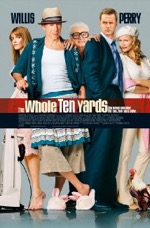
Starring: Bruce Willis
April 2004
“A Dud by Any Measurement”
I have two confessions to make regarding The Whole Ten Yards. I never saw the original The Whole Nine Yards, although I got the gist of the plot from the trailer. Secondly, I was bored with the movie even while the opening credits were still rolling. The movie failed to engage me on any level, and to call it entertainment would be a gross overstatement.
Part of the movie’s problem is its identity crisis—is it a comedy (it’s not all that funny), is it an action flick (there are only a few, short action sequences), or is it a family film (certainly not—discussions of shooting someone in the head or killing bums for sport are all too common). Since The Whole Ten Yards can’t be categorized by genre, it comes off as a particularly strange slice of Americana, complete with a highly-paranoid, tightly-wound dentist (Matthew Perry), a reformed hit man, Jimmy the Tulip (Bruce Willis), who now spends his time refining his culinary skills and tending to chickens, and his girlfriend (Amanda Peet), who desperately seeks to become the caliber of assassin Jimmy was in the past.
Add to that eccentric line-up Jimmy’s conniving ex-wife (Natasha Henstridge) and a larger-than-life mob boss (Kevin Pollack) who is revealed as Jimmy’s father in the movie’s climax (as if anyone didn’t see that coming), and you have a pretty bizarre cast of characters. The vast majority of acting in the movie is over-the-top, tongue-in-cheek and zany for the sake of being zany.
In fact, “zany” is really the most appropriate word to describe The Whole Ten Yards. It’s almost as if the producer/director/writer decided to push the envelope to absurd limits just because they could. The only scene I found remotely amusing was actually a recycled gag from Weekend at Bernie’s, where lifeless limbs of the Hungarian boss’ son are manipulated to give him the appearance of being alive. But even that was a shallow laugh.
It’s hard to find any redeeming qualities in the movie and its inane and mind-numbing storyline affixes a big minus sign to this B movie. The Whole Ten Yards may be one yard greater than the original, but it’s still a mile short of being entertaining.
Rating: 1 1/2
Starsky & Hutch (PG-13)
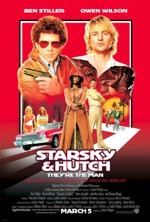
Starring: Ben Stiller
March 2004
“Groovy, But Not Great”
Acting:
This movie is Ben Stiller and Owen Wilson. Without the chemistry between these two comedic actors—who have collaborated on seven films now—Starsky and Hutch would be a fro-sized disappointment. Vince Vaughn (Psycho) does a serviceable job as the movie’s cookie-cutter seventies villain (who comes complete with a Fu Manchu mustache), and his pet, played by Juliette Lewis, is the stereotypical airhead (pothead?), flower chick whose no brains and no initiative character serves no other purpose than to massage her honey’s shoulders and deliver inane dialogue. The most colorful character in the movie is the glitzy Huggy Bear, played by Snoop Dogg, a shady figure who walks a dangerous tightrope between both sides of the law. His scenes as the golf caddie are absolutely hilarious. Carmen Electra adds a pretty face to the movie, but little more.
Director:
Starsky and Hutch—the movie—is nothing more than a glorified seventies television show, which seems to be the intent of director Todd Phillips (Road Trip). Besides hair and clothing styles and accompanying faves from groups like The Carpenters, Phillips utilizes old-style camera moves to capture the flavor of the original show. And, if you’re going to have a movie based on a seventies TV show, you’d better have the requisite fistfight and prolonged car chase, which, of course, this modern version also features.
Screenplay/Story:
Like the rest of the movie, the plot is typical of the seventies TV show, but the story elements, such as drugs, free love and violence have been updated, modernized and pushed to the extreme. In comparison to this new flick, the original TV show seems sanitary: what was a cutting-edge cop drama in the seventies would now be considered a family show. Social commentary aside, the movie never goes anywhere; there are no curveballs, no cliffhangers and no creative flourishes in most respects. Complete with the iconic, cherry-red Gran Torino with white lightning bolt along the side and a sea of Afros and bell-bottoms, the story is nothing more than nostalgic drivel.
Final Analysis:
Matinee all the way, dude!
Rating: 2
Welcome to Mooseport (PG-13)
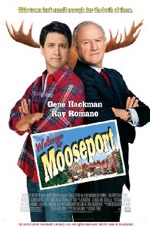
Starring: Gene Hackman
February 2004
“Welcome to Mediocre Entertainment”
Acting:
I don’t know what’s more amazing, the fact that this movie has a stellar cast or that a stellar cast would agree to do this movie. And stellar is no understatement. Movie stalwarts Gene Hackman (Runaway Jury) and Marcia Gay Harden (Mystic River) add their talents to the film, but seem out of place amid such pedestrian fare. Television hacks, Ray Romano (Everyone Loves Raymond), Maura Tierney (ER), Christine Baranski (Cybil) and Fred Savage (The Wonder Years) round out the cast, but there’s no stand out performance—here is a solid group of actors who desperately try to give weight to their roles but can’t because of the poorly written…
Screenplay/Story:
The scenario of a newly retired president of the United States running for mayor against the local plumber in a sleepy burg in Maine is just about as far-fetched as they come. Did the writers stop to answer the “Who cares?” question before they attacked their keyboards? Of course not! The only story element that gives Welcome to Mooseport any spice is the jealousy factor. Ex-president, Monroe “Eagle” Cole (Hackman) asks out Sally Mannis (Tierney) who is dating Handy Harrison (Romano). Sally is waiting for Handy to get the gumption to ask her to marry him, so she spites Handy and accepts the dinner invitation with Monroe. Now Monroe and Handy are fighting for the same office and the same woman. The date between Monroe and Sally also elicits jealousy from Monroe’s assistant (Harden), who has secretly admired the ex-pres. for years. In the end, Handy proposes to Sally and Monroe and his assistant hook up. And, with the exception of a thinly veiled election twist, that’s the extent of the plot.
Final Analysis:
Welcome to Mooseport tries to be funny, but isn’t. This is Ray Romano’s big screen debut and with a performance like this, he should stick to the small screen where he has great comedic success. The movie screams “low budget”…there are very few sets and the characters never leave the stifling confines of Mooseport. It’s too bad the story couldn’t support the caliber of actors it features and that its writers couldn’t come up with something more original and engaging.
Rating: 2
The Haunted Mansion (PG)
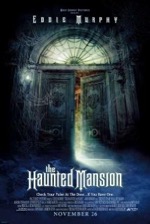
Starring: Eddie Murphy
November 2003
“Too Scary, Not Very Funny”
Based on the classic ride at Disneyland, The Haunted Mansion is a scare-fest that feels more like a glorified attraction than a movie. The scenes, symbols and inside gags from the ride are all here, but The Haunted Mansion seems more like a caricature of itself than a living, breathing entity.
The movie opens with overachieving real estate agent, Jim Evers (Eddie Murphy) visiting a mansion with his wife and two kids. They are met at the front door by a creepy butler named Ramsley, who promptly and unceremoniously escorts the family through the dusty, cobweb-ridden halls to meet his master. Master Gracey is a tortured soul, a shadowy figure who pines over the loss of his wife, Elizabeth, a woman who had a striking resemblance to Evers’ wife.
Things go south when Evers discovers Ramsley’s plot to unite Gracey and Evers’ wife in matrimony in order to break an age-old curse. Evers must brave flying instruments, a haunted graveyard and many other frightening things before he can attempt to thwart the butler’s sinister plan.
The Haunted Mansion is the third movie based on a Disneyland attraction, and is arguably the biggest disappointment of the lot. The trailer promises a light and comical joyride, but the actual movie is much darker in tone and isn’t all that funny. When it comes to jokes and humorous dialogue, there’s nothing fresh in Murphy’s repertoire; in fact, his one-liners come off like the donkey gags in Shrek.
The acting is appropriate in The Haunted Mansion, especially the ubiquitous and nefarious Ramsley (Terence Stamp), and the pathos-inducing Master Gracey (Nathaniel Parker). The face in the crystal ball, Madame Leota (Jennifer Tilly), offers some much needed comic relief and she and Murphy’s character play off of each other quite well.
The special effects are top-notch—as would be expected from Disney—but they overshadow the story, stifle character development and suppress any human element in the story, save for the Beauty and the Beast style storybook ending. In the final analysis, The Haunted Mansion is nothing more than a two-hour, live-action version of the Disneyland ride. In fact, the movie resembles the attraction so closely that after you leave the theater, you realize the thrills, chills and spills have been grossly artificial and that you’ve been taken for a ride.
Rating: 2
Intolerable Cruelty (PG-13)

Starring: George Clooney
October 2003
“Undeniable Stupidity”
Intolerable Cruelty truly is the best phrase to describe this film, because, after fifteen minutes of watching this mind-numbing display of unbridled avarice and over-the-top acting, you’re ready to sign your life away just to get out of the theater. George Clooney plays shifty divorce lawyer, Miles Massey, who never looses a case until he looses his heart to his kindred spirit, Marilyn Rexroth, an alluring divorcee portrayed by Catherine Zeta-Jones.
As the movie progresses, it gets zanier by the minute as Rexroth leaves behind a trail of affluent, but easy-to-dupe husbands who make her filthy rich with prenups. As kismet would have it, Massey marries Rexroth, and, in a display of undying love, he rips up the prenup. on their honeymoon night. Rexroth betrays Massey, of course, and leaves him lovelorn and homicidal; but in the end, she comes to her senses and decides to return to Massey. And they live happily ever after…or something like that.
Intolerable Cruelty leaves you searching for a meaning behind its quirky and murky plot. It flirts with a message (love’s supremacy over the lust for money), but the story is so muddied by ambition, deception and shady morality that anything virtuous is undetectable when looking back on the film as a whole.
There’s a ton of foul language in the movie and the dialogue, when clean, is excessively stilted, employing quotes from Shakespeare and other literary giants in order to convey basic concepts. This renders the movie verbose, trite and unreachable. The movie tries to be funny, but it fails miserably—like the “sitting before the judge before” scene with Edward Herman as the cornball, Mr. Rexroth.
The major problem with the film is its lack of a protagonist—Massey’s exploits are hardly laudable and Marilyn Rexroth is a manipulative minx. And we’re supposed to cheer when they finally get together? What were Clooney and Zeta-Jones thinking when they accepted this script? Intolerable Cruelty is a terrible waste of star power and an egregious waste of time.
Rating: 1 1/2
Under the Tuscan Sun (PG-13)

Starring: Diane Lane
September 2003
“Average Romance Shot in Timeless Tuscany”
Under the Tuscan Sun is a heartwarming romance that, mercifully, balances out the love story with artistic and dramatic panache, along with touching moments of genuine humanity. The movie’s success can be attributed to Diane Lane’s wonderfully organic performance and to the awe-inspiring Tuscany countryside which serves as breathtaking backdrop and nonhuman star in the film. Audrey Wells directed the movie and also wrote the screenplay, which is based on the memoirs of Frances Mayes.
Recently divorced, Frances (Lane) gets a wild hair and decides to relocate to Italy. Purchasing a modest home in a Tuscany villa, Frances finds the time for artistic pursuits as well as hosting parties when not renovating and maintaining her casa. After her heart has had the proper time to heal, Frances visits the coast and finds the man of her dreams—but even the perfect man, Frances learns, has his share of sordid secrets.
The movie’s pacing can make an insomniac drowsy, but Lane skillfully chews enough scenery to hold the audiences’ attention; the unconventional love story further aids in sustaining viewer interest. Under the Tuscan Sun is made memorable by the stunningly scintillating location work, but also by the uplifting story about a courageous young woman who ends one chapter of her life and boldly begins a new chapter on a different continent. Hope springs eternal…especially in idyllic Tuscany.
Rating: 2
Secondhand Lions (PG)
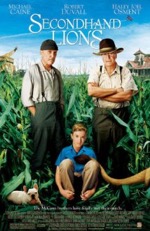
Starring: Haley Joel Osment
September 2003
“Come See This Comely Coming-of-Age Tale Firsthand”
Secondhand Lions, a lighthearted tale of self-discovery, focuses on prepubescent Walter (Haley Joel Osment) and his two eccentric uncles, Garth (Michael Caine) and Hub (Robert Duvall).
The movie opens with Walter’s promiscuous mom (Kyra Sedgewick) dumping him off at his uncles’ farm for the summer while she goes off to “get a job” (translation: have a wild time) in Vegas. Garth and Hub’s daily routine involves sitting on a porch swing with rifles and taking potshots at any salesperson bold or foolish enough to approach their farmhouse. Appalled by their declared open season on salesmen, Walter challenges his uncles to find out what the peddlers are selling before filling their britches with buckshot and to spend some of their rusting fortune on items of interest.
Taking Walter’s advice, Garth and Hub purchase a secondhand lion, which they intend to hunt in a nearby cornfield. When the lion arrives, however, they discover that this king of beasts is docile and has one paw in the grave. Dispirited, the aging men feel even more obsolete than before; hunting a lion would have transported them back to the glories of their youth when they fought in wars and lived life on the edge. By summer’s end, Walter’s uncles teach him how to become a man and Walter teaches his uncles how to enjoy life again by being more spontaneous.
Caine and Duvall deliver superlative performances and Osment continues to amaze with the depth and maturity of his craft for one so young. Though Josh Lucas, as the adult Walter, looks nothing like Osment, the movie’s wrap-up is heartwarming and has an excellent payoff. Secondhand Lions is a family-friendly drama that deals with coming-of-age and old age in a meaningful, yet whimsical, manner. It’ll probably fly under the radar, but this is one film that shouldn’t be missed.
Rating: 2 1/2
The Fighting Temptations (PG-13)
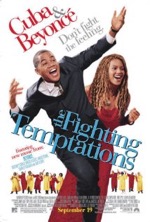
Starring: Cuba Gooding, Jr.
September 2003
“A Class Act, But No Sister Act”
Darrin Fox (Cuba Gooding, Jr.) is a fast talker who manages to work his way up the ladder to an enviable position at a marketing firm in New York City. Just when things are going great in his life, Darrin receives news that his beloved aunt has passed away. Returning to his hometown of Montecarlo, GA—the quintessential southern burg—Darrin is reunited with friends and family, whose speech, clothing and habits throw him into immediate culture shock; his roots have come back to haunt him.
Darrin stands to gain a great deal of money from his aunt’s will, but her dying wish contains one condition—Darrin must conduct the Baptist choir and win the annual music contest in order to receive his inheritance. Darrin, who knows next to nothing about music (but can fake his way through anything), is dealt a bad hand from the start; the choir contains half a dozen average vocalists, a wizened organ player and a controlling pastor’s wife who resists him at every turn.
Darrin enlists the help of his childhood sweetheart, Lilly (Beyonce Knowles), who has the voice of an angel, but according to the pastor’s wife, sings the devil’s music in the local bar. This is just the first of many obstacles Darrin must hurdle in order to build a choir and get it ready for the competition. When circumstances go from bad to worse, Darrin tucks tail and heads back to his comfortable life in the Big Apple. But he soon realizes it’s not about the money anymore; it’s about the relationships he’s built with his choir and the commitment he made to them and his departed aunt. Darrin returns with a newfound passion and leads his group in a rousing number at the competition. If you’ve seen Sister Act, you can guess the end from here.
And speaking of Sister Act, there are more than just a few similarities between that breakout blockbuster and The Fighting Temptations, but this new version of the “average church choir wins the big music competition” plot doesn’t hold a hymnal to the Whoopi Goldberg comedy classic. Cuba Gooding Jr. is believable in the way he gradually comes around, leaving behind his big city attitude and reverting to the caring and honest person he was in his youth. Beyonce Knowles hits her marks and says her lines, but it’s clear that her incredible voice is the only reason she’s in the movie.
There are some wonderful cameos in the film: Steve Harvey’s radio D.J. provides several moments of hilarity and the Rev. Shirley Caesar and rapper T-Bone lend their talents to the final show-stopping number. And let’s not forget the men in the orange jumpsuits—the inmates that Darrin recruits for his makeshift choir. Some of the movie’s funniest moments involve these upstanding (though cuffed) choir members.
The Fighting Temptations isn’t the greatest movie of its kind, but it is inspiring and features some toe tapping, head-bobbing and smile-raising Gospel music.
Rating: 2 1/2
Freaky Friday (PG)

Starring: Jamie Lee Curtis
August 2003
“Modern Remake Lacks Heart”
As far as remakes go, this was an entertaining, if uninspired, effort. The main question that preoccupies the film isn’t whether or not Freaky Friday is better than the original, but why it was necessary to update it at all. The first Freaky Friday, with Barbara Harris and Jodi Foster was wildly entertaining and deserved the right to become a stand-alone classic. Music/hair/clothing styles have all changed over the years, but other than modern trappings, this new movie is virtually identical to its “groovy” predecessor.
The movie opens with the classic mother vs. daughter battle, which escalates at a Chinese restaurant. The Asian proprietor slips the arguing pair two fortune cookies, which magically switches the mother’s soul into the daughter’s body, and vice versa.
A lot of gags ensue the next day as the two women try to switch back (by running and slamming into each other), and when Annabel’s mother, Ellen, goes to school while Annabel embarks on a shopping spree with her mother’s credit cards. These fish-out-of-water scenes (like when Ellen dresses like her daughter and hitches a ride on a motorcycle, or when Annabel destroys the psyches of her mom’s mental patients), become the meat of the story, but it’s not until the two women make peace and show respect to each other that the farcial curse is finally broken and the film comes to a heart-warming climax.
There’s a lovely scene at the end of the film where Annabel thinks of Ellen’s happiness before her own, and gives her blessing to her mother’s union to her new stepfather (Mark Harmon). It’s the only point in the film that I emotionally connected with the characters and thought that, just perhaps, there really was a story amid the flowing fountain of fluff.
The acting in the movie was solid enough; Jamie Lee Curtis was convincing as the uptight, killjoy, Ellen, and Lindsey Lohan (The Parent Trap) was pitch-perfect in her portrayal of a modern teenage girl who wages an emotional tug-of-war with her overbearing mother.
There’s no doubting that this new Freaky Friday is a load of good, clean fun, which will introduce a new generation to this “trading places” tale. But, in the final analysis, the original had more charm than this modern update.
Rating: 2 1/2
Hollywood Homicide (PG-13)
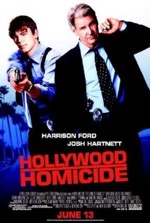
Starring: Harrison Ford
June 2003
“Glorified Cop Show Misses the Target”
Hollywood Homicide feels like a big-screen version of the new Dragnet TV series. Both are based in L.A., both feature cops working the homicide beat and both have a seasoned veteran and a young-buck sidekick. All of these similarities to Dragnet and other cop shows hamstring the picture, and any new and fresh ideas the writers hope to achieve seem trite by comparison.
The story begins with a murder at a dance club and the plot slowly unravels, linking the first murder to another double murder. As they investigate the case, Detective Joe Gavilan (Harrison Ford), who sells real estate on the side, tries to foist a lemon on anyone who will buy it, while his partner, K. C. Calden (Josh Hartnett), teaches a yoga class and schmoozes with every woman in sight. Joe engages in some unorthodox methods of investigation (one of his informants is a cross-dresser) and K.C. begins to consider a career in acting. The murders lead back to a local record producer, who evades the two detectives until he meets an untimely demise. An accomplice to the murders proves to be the man who killed K.C.’s father, and rather than taking revenge, K.C. records the man’s confession on a hidden cassette recorder. In the end, Joe sells the house and K.C. makes his acting debut. And they all live happily ever after—if that’s possible to do as a cop in L.A.
Hollywood Homicide takes an eternity to get going, and when it finally does, it doesn’t deliver all that big of a punch. Even by the second act, it’s pretty obvious who the killer is, and as a villain, the record producer is severely underdeveloped, and doesn’t really evoke the feelings of loathing or fear that a good antagonist should convey.
The last quarter of the movie is one big car chase and is embarrassingly reminiscent of an 80’s cop show. At first, it’s nice to finally see some action, but as the chase sequence drags on and on, the urge to look for stray Skittles on the floor becomes a viable alternative to the mind-numbing action on the screen.
The only novel idea in the movie is a cop selling real estate as a part-time job, an idea that gets worn out from overuse. And as for Ford, why did he select this role? His last few script choices have been average at best (Air Force One was his last big screen triumph). Here, he tries to be an action star, but doesn’t quite pull it off. He tries to be funny, but only lands about half of his jokes. And his cell phone in the movie is just downright annoying (beating the first few bars of the Temptation’s “My Girl” into the ground). Unlike some naysayers, I believe there’s still gas in the old Ford, but he needs to choose better films to act in (like the forthcoming Indiana Jones IV).
Hollywood Homicide is like a falling star in Tinseltown; it shows for two hours, but is gone in sixty seconds.
Rating: 2
Finding Nemo (G)
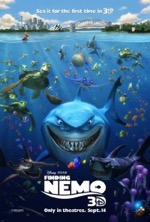
Starring: Albert Brooks
May 2003
“Disney/Pixar Goes ‘Down Under’ the Sea”
Disney’s stalwart animation studio, Pixar, is back in Finding Nemo, and this time they venture under the sea (sorry, no Sebastian this time). As would be expected, the computer-generated effects are jaw dropping and the detail and movement of the underwater creatures is really quite astonishing. The most striking element of Finding Nemo is the vibrant, almost three-dimensional colors that explode from every corner of the screen, like an underwater kaleidoscope.
Finding Nemo begins with a prologue section, which serves as a back-story and sets up the look and theme of the movie. Nemo (Alexander Gould) was the only surviving child of a barracuda raid, which took the life of his mother and turned his father, Marlin (Albert Brooks), into a paranoid and overprotective parent. Flash forward: Nemo, now in his formative, fish years, has none of his father’s hyper-cautious hang-ups and one day strays out too far from the reef. He is immediately captured by a diver and is later set free inside a dentist’s aquarium in Sydney.
Meanwhile, Marlin meets Dory (Ellen Degeneres), who suffers from an insufferable case of short-term memory, and the pair set out on a ponderous, arduous and dangerous journey to find Nemo. Back in the aquarium, Nemo makes some new friends and meets Gill (Willem Dafoe), who’s nearly died several times trying to escape the tank. Nemo is much smaller, however; and manages to stop up the water purifier and affect his escape (through a toilet bowl, of course). By now, the whole ocean knows of Marlin’s plight, and as soon as Nemo hits the open water, it’s only a matter of time before father and son are reunited.
The story is pretty standard fare for Disney, but what distinguishes Finding Nemo is its imagination; like the Sharks Anonymous club, or the minefield of jellyfish, or the copasetic turtles surfing along the East Australian Current. In Finding Nemo, the fish are humanized and the humans are drawn in bland hues with very little detail—there’s no doubting who the stars of the movie are.
Finding Nemo ends a bit abruptly and doesn’t deliver the big climax you would expect (imagine this: a school of barracudas show up right after the reunion and things look hopeless until the three sharks arrive and save the day), but it does leave you with the warm fuzzies. Though it flounders at times, Finding Nemo is a good family picture and should take a bite out of its competition (Sinbad) this summer.
Rating: 2 1/2
Bruce Almighty (PG-13)
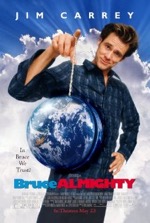
Starring: Jim Carrey
May 2003
“A Comedy That’s Heaven Sent”
What would you do if you were God for a week? This is the lofty question posed by the mildly irreverent, wildly entertaining Bruce Almighty. Bruce Nolan (Jim Carrey) is a disgruntled news reporter (the one who gets all of the boring human interest beats) who suffers one personal tragedy after the next. In one ill-fated day, Bruce looses his job, is beat up by a street gang, has a major fight with his girlfriend and wraps the front end of his car around a light post.
In an animated tantrum right out of the Carrey vault, Bruce takes out his frustrations on the Almighty, yelling at the sky such aspersions as, “the only one around here not doing his job is you.” Next day, Bruce is summoned to an abandoned factory and encounters God (Morgan Freeman), who gives Bruce His job. Bruce can do whatever he wants, but there is one catch: he can’t affect free will.
At first, Bruce takes devilish delight in paying back his enemies and using his newfound powers for personal gain, but he soon discovers that being God—even over a small section of Buffalo, New York—is a much bigger responsibility than he had previously imagined. In the end, Bruce surrenders to God’s will for his life and hands over the reins. Everything returns to normal; he gets his job and girlfriend back, but Bruce has gained a new perspective on life.
Though over-the-top in some instances, Carrey’s performance strikes an emotional chord in this film; he balances comedic silliness with some moments of genuine compassion and sympathy. Morgan Freeman is convincing in his portrayal of God (if not a little laissez faire), and Jennifer Aniston’s performance as Bruce’s girlfriend, Grace, serves as an anchor to the zany protagonist.
Bruce Almighty is a twist on It’s a Wonderful Life (a small clip of the classic movie even appears here), and presents a “what if” scenario that is quite engaging. What could have been a sacrilegious debacle is actually a faith-friendly flick in most respects and actually supports, rather than slams, a Judeo-Christian worldview. Bruce Almighty is a positive and entertaining movie experience; fun and faith affirming is a heavenly combo.
Rating: 2 1/2
Holes (PG)

Starring: Shia LaBeouf
April 2003
“Disney Digs up a Gem”
Every once in a while, Disney produces an entertaining, clean, live-action film that makes a hole in one. Though dissimilar in theme, last year’s, The Rookie, would certainly fit into this traditional, inspiration movie mold. This year’s model, Holes, is definitely something new under the sun; and in a summer swarming with sequels, it’s nice to see something fresh and innovative.
Based on the teen novel by Louis Sachar, Holes features an array of new talent, most notably, Shia LaBeouf as Stanley Yelnats and Khleo Thomas as Zero. There are also some other, more recognizable names here, like Sigourney Weaver as the camp warden and Jon Voight as the trigger-happy, sunflower seed gulping, Mr. Sir. The film is also bolstered by a solid screenplay and deft direction by Andrew Davis (The Fugitive).
Men in the Yelnats (Stanley spelled backwards) family have endured a curse for several generations. Young Stanley is in the wrong place at the wrong time and ends up a Camp Greenlake, a juvenile detention facility. To build character, these young men must dig holes all day in the oppressive desert heat, while avoiding snakes, scorpions and the deadly yellow-spotted lizard.
While digging, Stanley discovers an artifact that has an intricate and sordid past—a past that is fleshed out in several historical vignettes that occur at irregular intervals during the middle of the story and serve as an intriguing subplot. Stanley must unravel the mysteries of the past in order to break the familial curse and clear his name.
Holes doesn’t take itself too seriously, and yet, you don’t have to suspend your disbelief to dizzying heights in order for the fictional elements to make sense or feel like they fit in with the overall plot. The movie has a surprisingly solid storyline, and for a movie geared for teens, has far fewer plot holes than most adult movies.
Holes is as refreshing as a rain shower on a hot summer afternoon—an image not lost on the movie—and is a feel-good family flick that anyone can easily dig.
Rating: 3
Anger Management (PG-13)
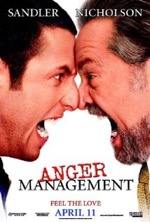
Starring: Jack Nicholson
April 2003
“Somebody Call the Script Doctor…This Film Needs Therapy”
Whenever I watch this brand of movie, I always have to stop and ask myself, “Do people like this really exist?” I suppose they do; archetypes this clearly defined aren’t created in a vacuum…or a test tube. And yet, I’ve never known anyone as easily enraged as Dave Buznik (Adam Sandler) or as certifiable as Dr. Buddy Rydell (Jack Nicholson). The movie’s casting was a no-brainer: Sandler excels at playing selfish, mad-at-the-world types and nobody does psychotic better than Nicholson; together, they’re a disturbing riff on The Odd Couple.
Dave is a mild-mannered businessman who bottles up everything inside and avoids conflict at all costs. In an uncharacteristic act, Dave looses his temper on a jet and later faces charges for his outburst—in order to avoid jail time, he must attend counseling sessions. Buddy, an anger management expert, is assigned the task of rehabilitating Dave, who, of course, claims he doesn’t have an anger problem…that all changes when Buddy’s unorthodox methods start to grate on Dave’s nerves. After finding Dave to be an “extreme” case, the court grants Buddy’s request to move in with Dave so that the psychologist can keep a closer eye on his patient. This doesn’t sit well with Dave or his girlfriend Linda (Marrisa Tomei), and that’s when, as they say, the defecation hits the rotary oscillator.
You’ve seen this movie before…it’s called What About Bob? and stars Bill Murray as a needy patient who stalks his vacationing psychiatrist, Richard Dreyfuss. The roles have been reversed and Buddy’s counseling strategies actually have some merit, but the two plots, at their core, share more than just a passing resemblance. Unfortunately, the same virus that afflicted What About Bob? has also infected Anger Management; namely the unrelenting torrent of screwball humor, melodramatic performances and a plot that borders on the absurd. Dave and Buddy are so dysfunctional that the majority of “normal” audience members will find it hard to identify with the deranged duo, much less sympathize with them. And just who exactly is supposed to be the protagonist here?
Director Peter Segal and writer David Dorfman have offered up a soulless story that flirts with salience but fails to deliver the smallest morsel of meaning. An even larger disappointment is that the movie—a supposed comedy—isn’t even all the funny. The best exchange in the film comes when Dave and Buddy are lying side by side in bed. Buddy offers, “In Europe, it’s not considered unusual for three or more men to share a bed,” to which Dave replies, “That’s why I’m proud to be an American.”
For the updated Miracle on 34th Street (1994), 20th Century Fox, confident they had produced a hit, offered a money back guarantee to disappointed attendees. Why can’t they ever make that kind of offer for a movie like this? After sitting through two hours of Anger Management, I was definitely mad enough to ask for my money back!
Rating: 2
Shanghai Knights (PG-13)
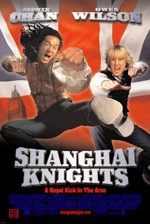
Starring: Jackie Chan
February 2003
Shanghai Knights begins a bit slowly, but picks up the pace when Roy and Chon reach London. There are many amusing twists on historical figures in the film, but too many of the fight sequences are like baby's bottoms. It will be interesting to see which continent the duo lands on in Shanghai Dawn.
Rating: 2 1/2
Catch Me if You Can (PG-13)

Starring: Leonardo DiCaprio
December 2002
The opening sequence is absolutely brilliant—a throwback to a sixties spy flick. Catch Me if You Can is highly entertaining and Hanks and DiCaprio are spot-on. Catch Me if You Can is so unbelievable at times, that occasionally you have to stop and remind yourself that this actually happened.
Rating: 3
Sweet Home Alabama (PG-13)
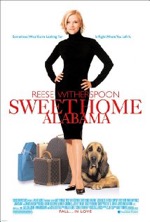
Starring: Reese Witherspoon
September 2002
There are a lot of things about this movie that are charming, and it’s nice to see a separated couple get back together, but some crass speech, foul language and crude humor really keep me from giving Sweet Home Alabama my full recommendation.
Rating: 2 1/2
Men in Black II (PG-13)

Starring: Tommy Lee Jones
July 2002
The animated short about the Chub Chubs was much more entertaining than the M.I.B. sequel, which suffered from an anemic plot and scant, if not non-existent, character development. I’d already seen the best scenes in the trailer. This one is mediocre at best.
Rating: 1 1/2
Lilo & Stitch (PG)
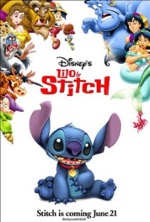
Starring: Daveigh Chase
June 2002
Lilo & Stitch is at its best when dealing with friendship and family and at its worst when it tries to be funny and when it tries parodying Men in Black. Lilo & Stitch isn’t Disney's finest, but it’s entertaining just the same.
Rating: 2 1/2
Ice Age (PG)
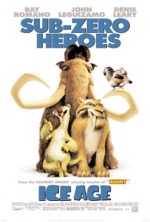
Starring: Ray Romano
March 2002
Once again proving that computer-generated tales are consistently the best movies out there (Final Fantasy excluded), Ice Age has mammoth-sized gags, a touching story and a theme of redemption that brings a tear to the eye.
Rating: 3
Ocean’s Eleven (PG-13)
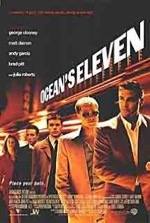
Starring: George Clooney
December 2001
Once Ocean's Eleven gets going, it’s an amusing, star-studded romp that depicts a daring heist in a major Vegas casino. The plot never tips its hand fully until the end, and the final series of twists is quite good.
Rating: 3
Serendipity (PG-13)
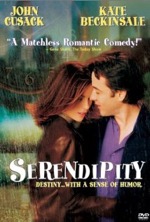
Starring: John Cusack
October 2001
A slightly better than average love story, Serendipity works because the romantic leads have great chemistry and because of the fateful book that reunites them. John Cusack and Kate Beckinsale are supported by some great performances by Jeremy Piven, Molly Shannon and Bridget Moynahan. The snow angel on ice scene stands out as one of the most memorable in the movie.
Rating: 2 1/2
Cats & Dogs (PG)

Starring: Jeff Goldblum
July 2001
After suspending my disbelief, I found this to be a rather humorous look at the age-old battle for supremacy between felines and canines; kicked up a notch. A talking animal picture that entertains and bolsters family values is okay by me.
Rating: 2
Evolution (PG-13)
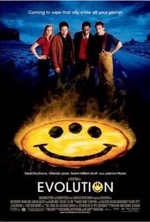
Starring: David Duchovny
June 2001
Phil Tippet’s unique creatures and solid acting performances by David Duchovny and Julianne Moore couldn’t bring Evolution past a primordial stage. You might even be disappointed paying the matinee price for this one.
Rating: 1 1/2
Crocodile Dundee in Los Angeles (PG)
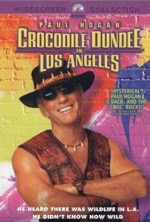
Starring: Paul Hogan
April 2001
This, third, Crocodile Dundee movie is one sequel that should not have been made—it’s a terrible waste, mate. Paul Hogan’s jokes land like anvils and the story is as pedestrian as heck. This is the prime example of returning to a dry well. The Mike Tyson scene is silly as is the skunk rescue sequence. The only remotely funny moment in the film is at the posh Hollywood party where Dundee regales humorous episodes with his good friend “Mal” Gibson.
Rating: 2
Meet the Parents (PG-13)

Starring: Robert DeNiro
October 2000
A far less controversial and far more whimsical riff on Guess Who’s Coming to Dinner (1967), Meet the Parents is really just an elaborate Murphy’s Law scenario where events exponentially worsen each time Gaylord “Greg” Focker (Ben Stiller) attempts to impress his future in-laws. Greg’s fiancée, Pam (Teri Polo), tries running interference for him with her prim and proper mom, Dina (Blythe Danner) and eagle-eyed dad, Jack (Robert DeNiro), but Pam’s peacekeeping efforts are no match for Greg’s uncanny ability to stumble into misfortune. It’s normal for fathers to view prospective son-in-laws with apprehension or distrust, but Jack takes that paternal instinct to new extremes; as an ex-C.I.A. operative, Jack uses high-tech equipment to spy on Greg and later, interrogate him.
There’s no shortage of amusing scenes in the movie; like when Greg accidentally topples an urn containing the ashes of Jack’s mom, or the “Puff the Magic Dragon” conversation between Jack and Greg, or when Greg accidentally ignites the wedding gazebo, handcrafted by Pam’s ex-, Kevin (Owen Wilson), or when Greg, thinking he’s killed the family cat, Jinx, tries to pass off a painted stray for the genuine article—the faux Jinx demolishes the house while the family is at dinner. After an hour or so, however; these escalating incidents, though useful in generating sympathy for Greg, start to challenge the boundaries of believability—by the end, feelings of exhaustion set in and you just wish the guy would either escape the vicious circle of gaffes and mishaps or just be put out of his misery.
Director Jay Roach (Austin Powers) does a good job of utilizing the considerable talent at his disposal. Ben Stiller, son of legendary comedian Jerry Stiller, is known for his slapstick sense of humor so his performance, to some degree, is predictable. The real surprise here is DeNiro, whose deadpan delivery almost seems incongruous with his typical “tough guy” persona. No one will ever confuse DeNiro with a comedian, but he’s quite humorous as the paranoid, overprotective father who uses Greg’s last name as an expletive and repeatedly cudgels Greg over the head with his familial “circle of trust” philosophy. “I’m watching you,” Jack warns Greg, and you can’t help but feel sorry for the guy. What a nightmare!
Meet the Parents is the worst case scenario of a young man desperately trying, yet repeatedly failing, to please his fiancée’s family. Here’s hoping none of us will ever have to experience the embarrassment, humiliation and mental angst endured by that poor, misunderstood and tortured soul…Gaylord Focker.
Rating: 2 1/2
The Kid (PG)
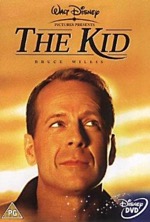
Starring: Bruce Willis
July 2000
A modern twist on Dickens' A Christmas Carol, the movie introduces egotistical image consultant, Russ (Bruce Willis) to a 10 year-old version of himself. Dealing with the obnoxious nature of his younger, chunkier self brings Russ to a place of discovery and goads him into making positive choices for the future. A bit saccharine in spots, Disney’s The Kid is heart-warming and features a fine performance by Willis.
Rating: 2 1/2
Snow Day (PG)
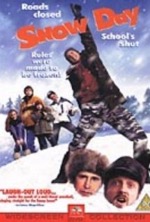
Starring: Chris Elliott
February 2000
What I thought was going to be a Chevy Chase vehicle picture turned out to be a slogging B movie—Chase’s presence, as the zany weatherman, is barely felt in the snowbound comedy. About the only thing that works in the movie (other than Chris Elliot’s annoying snowplow) is the refreshingly romantic subplot. I say refreshing because it’s not the typical “guy overcomes hardships to get the girl” scenario. Here, Hal (Mark Webber) is desperately in love with high school hottie, Claire (Emanuelle Chriqui), but after constant rejection by Claire, Hal realizes that his gal pal, Lane (Schuyler Fisk), is the better choice and a budding romance ensues. Cheesy? You bet, but Snow Day is a harmless shovel-full of slapstick fun that’s an appropriate diversion if you’re snowed in and have nothing else to do.
Rating: 2
Galaxy Quest (PG)
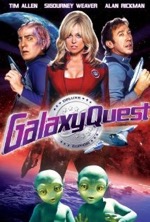
Starring: Tim Allen
December 1999
This good-natured spoof of Star Trek (specifically) and other sci-fi shows (generally) is a laugh-a-minute thrill ride that avoids ruffling the feathers of hard-core fans by never taking itself seriously. Tim Allen is flawless as Commander Taggart…he has Shatner’s strut and swagger down to a tee. In a memorable turn, Sigourney Weaver plays Lt. Tawny Madison, the communications officer who relays orders to the crew by repeating, verbatim, everything Taggart says…it’s her one job and she does it well. Tony Shaloub is absolutely hilarious as the incompetent engineer, Tech Sergeant Chen, and Sam Rockwell’s character, a no-name security officer who was killed off in Episode #81, is an obvious poke at Star Trek’s predilection for hurling red-shirted crewmen into harm’s way. Alan Rickman, as the Spock-like alien, Dr. Lazarus, paints the perfect picture of a once-serious actor who’s been typecast by legions of fans who clamor for him to recite his famous line: “By Gramthar’s Hammer…You Shall Be Avenged!” An exaggerated look at fandom and sci-fi conventions, Galaxy Quest features colorful characters, witty dialogue and excellent special effects: this is one exciting romp through outer space.
Rating: 3